- United Kingdom
- Curated Stays
- Wine Travel
- About Isabelle
- Work with Us

28 Essential Tips: A Complete Guide to Visiting Naples, Italy
- Isabelle Hoyne
- May 6, 2024
** Disclosure: some of the links on this site are affiliate links and should you make a purchase through these, I may receive a small commission at no extra cost to you. Thank you for your support!**
Whether you’re visiting Naples for its world-famous pizza, ancient streets, or the historic ruins of Pompeii, this essential Naples travel guide offers expert tips and insights that promise a richer, more engaging experience.
Naples is a well-known city in southern Italy, but it is also one that is gravely misunderstood. Many travellers skip through its airport on their way to the Amalfi Coast and don’t give this diverse, historic city a look-in. That, in my opinion, is a grave error.
Those who know a little about Naples might allocate half a day to head into city centre and sample from the source the city’s most delectable dish – pizza. Others may tack on a night in Naples so they can use it as a base to go and explore nearby Vesuvius or the ancient city of Pompeii.
While these visitors are on to something, they’re still a bit wide off the mark as to just what this city is all about.
Rough around the edges, the historical centre of Naples is a hodge-podge of narrow, cobbled streets. Apartment buildings are strung with a festoon of sheets and unruly scooters play cat and mouse with pedestrians, beeping with indignity when the crowds fail to part in prompt fashion.
Thought that was a pedestrian zone?
Well think again, for here they march to the beat of their own drum and shopping, walking, driving, eating and living all mesh together as one with all activities often taking place within a few square metres of each other.
With a fascinating history that stretches back to the ancient Greeks, the city of Naples followed a slightly different path to other places in Italy.
You’ll notice it when you get there, especially if you’re a regular visitor to Italy – the food is different, the architecture is in a class of its own and the people, as a generalisation, have much more time for tourists when compared to other large cities in Italy.
Crafted from numerous personal visits and extensive research, this Naples travel guide is your portal beyond the typical tourist paths.
Whether you’re planning a quick visit or a longer sojourn, this guide aims to show you why Naples deserves more than a mere stopover.
Discover why I think you should prioritize a visit to the serene Catacombs of San Gennaro over the more chaotic Naples Underground, and learn essential safety tips that will help you explore confidently.
In this guide, I hope to uncover some of Naples’s many layers, from its world-renowned pizza to its millennia-old thoroughfares. Prepare to have your eyes opened, and to discover the often unexpected delights involved in visiting Naples, Italy.
Cultured Voyages’ Best of Naples Guide
Favourite tours & things to do
⭑ Naples Pizza Making
⭑ Catacombs of San Gennaro
⭑ Amalfi Coast Full-Day Trip
⭑ Pompeii & Mount Vesuvius Tour
Favourite places to stay in Naples
➡ La Casa Sul Nilo ( old world luxury on a budget ) ➡ B&B Ruffo di Bagnara Monumental Palace ( a recent, central stay that I loved ) ➡ Decumani Hotel De Charme ( central hotel with old school charm )
Favourite places to eat
⭑ Pizzeria da Attilio
⭑ La Locanda Gesu Vecchio
⭑ Palazzo Petrucci Pizzeria
⭑ Mimi alla Ferrovia
Watch/read before going
➡ Elena Ferrante’s ‘ My Brilliant Friend ‘ (HBO) ➡ Roberto Saviano’s ‘ Gomorrah ‘ (Sky Atlantic)
Table of Contents Hide
Why visit naples, top things to do & see in naples, where to stay in naples, food, dining and nightlife in naples, practical naples tips in regards to safety, getting around & transportation tips, day trips & excursions from naples, naples travel guide – planning your visit, where to go next – more naples posts, naples has a gritty, charismatic charm.
One arrives in Naples and is met by an assault of the senses.
The first thing that hits you is a sheer cacophony of sound. A barrage of lilting Italian voices fight to be heard over the sound of revving engines, beeping horns and the rattle of tyres over worn cobblestones. It’s all one big great, beautiful chaos.
Grandiose buildings erected in wealthier times now have faded, peeling facades and many today carry graffiti (although efforts are being made to renovate some of these). Sheets are strung from balconies, as well as across narrow, winding alleyways to dry and neighbours shout across the narrow voids to each other.
Naples is a densely populated city, with many living in the confined spaces of apartment lodgings and life, naturally enough, spills over into the streets sometimes.
With that comes a bit of a rubbish problem – Naples is by no means the cleanest city you’ll ever visit – and you will have to be prepared to see quite a bit of rubbish in the streets, piled up around bins.
From the 1990’s to 2010’s, the Camorra (Campania’s branch of the Mafia) infiltrated the waste business, which led to a rubbish crisis in Naples . Local government has since taken back control and there has been a vast improvement, but do expect to see some rubbish about.
It’s a city unlike any other in Italy
Naples simply bursts with attitude.
Unlike the – dare I say it – more sterile cities further north in Italy, the hubbub and helter-skelter aspects of the city are more akin to major urban centres in Southeast Asia. At a push, I’d draw parallels between it and Palermo , the quirky capital of the island of Sicily.
The root as to why Naples is so different from the rest of the country lies in its history and the fact that it’s operated rather independently for centuries; millenia even.
The city dates back some 4,000 years and is one of the oldest cities in the world. Having first been established by Greek settlers, by the 6th century BC the ancient city of Neapolis had been erected and with it, the Neapolitan culture that Naples is famous for – even the Romans couldn’t shake it when they conquered the area.
Following the Romans, Naples was ruled by a succession of Goths, Byzantines, Lombards and Normans, before it became part of Kingdom of Sicily, of which it became the capital in 1266.
After a few more power shifts, Naples played a major role in the Italian Renaissance of the 15th century and subsequently nurtured some of the greatest artists the world has ever known, including Renaissance bad-boy Caravaggio and master of sculpture, Bernini.
The Neapolitans tried to go it alone in the 17th and 18th centuries, but both its attempts to establish a republic failed. It unified with the rest of Italy in 1861 (although from conversations I had with locals while there, still feels a little cut off from the north of the country today).
Continuing on the theme of independence – you can’t keep a Neapolitan down – in 1943 they were the first Italian city to rise up against Nazi occupation. When Allied forces arrived in town, Naples, they discovered, was already free.
With a past that differs to Italian cities further north, Naples presents a unique tapestry.
This city layers its distinct aspects one upon another. Its cuisine, the life it had under the grip of the Mafia, and its obsession with Maradona – footballing legend and Naples’ Argentinian born, adopted son – all contribute to its character.
Additionally, there’s an underlying gritty, yet bohemian edge. You’ll come to see that Naples really is different to anywhere else you’ll visit in Italy.
RELATED READING | Where to stay in Naples, Italy
Football is a religion, and Maradona is a God
In the pulsating heart of Naples, football transcends mere sport; it’s a fervent religion, and Diego Maradona, its undying deity.
The city’s passion for its beloved team, Napoli, is palpable in every corner, every chant, and in the sea of azure that floods the streets. This fervour reached a crescendo in early 2023, when Napoli clinched their first Italian Serie A title in 33 years .
Wander through Naples, and you’ll find the streets festooned with football banners and flags, a vivid tapestry of blue and white that flutters in the Mediterranean breeze.
Souvenir shops overflow with Napoli memorabilia, each item a sacred relic to the local faithful.
But it’s the reverence for Maradona that truly encapsulates the city’s love affair with football. The Argentine legend, who led Napoli to its previous Serie A titles in 1987 and 1990, is not just remembered; he is venerated.
In the labyrinthine alleys of the Spanish Quarters, Maradona’s legacy is immortalised in a huge, vibrant mural and the subsequent shrine of sorts that’s built up around it.
Maradona’s story is inextricably linked to Naples – his extraordinary talent mirrored in the city’s own gritty resilience and flamboyant flair.
So, is Naples worth visiting?
If you’re on the fence about visiting Naples, I’ve explored this topic thoroughly in this dedicated post .
In short, however, Naples is a city like no other and one that I feel is absolutely worth visiting. It’s full of history, bursting with culture and is home to a charmingly chaotic atmosphere.
While it can be said that the majority of cities in Italy offer the same three factors – history, culture and atmosphere – Naples has had a somewhat alternative history as part of different kingdoms throughout the centuries.
The result is a city that offers a completely different experience to other major cities in Italy, particularly in the north of the country.
Explore its ancient underground system of caverns and catacombs
The city of Naples and the area surrounding it sits on a fantastic natural resource, and that is the marvellously durable material of tuff rock.
Inhabitants of the area have been wise to this fact for many years and when building their city of Neapolis in the 4th century BC, the Greeks extracted this tuff rock in large quantities , using it to build the city walls, temples and underground tombs.
The rock extraction process left great underground caverns and later, the Romans came along and applied their engineering prowess to repurpose these into aqueducts, which supplied water to the city of Naples.
Over time, these grew into a vast network stretching to some 450km under Naples.
A new aqueduct was built in the early 1600’s but this eventually fell out of use by the early 1900’s, when a more efficient water system was created.
These underground caverns and passages were abandoned, until they found great purpose as bomb shelters during the Second World War – at 40 metres below the surface, it is estimated that the tunnels saved some 200,000 lives.
It is now possible to visit Naples Underground , to explore some of the water cisterns, bomb shelters and ancient caverns.
In addition to this, is the much younger in comparison Bourbon Tunnel. The masterplan of Ferdinand II, who was a Bourbon king of Naples and Sicily in the 19th century, the tunnels were constructed as an escape route by an increasingly paranoid Ferdinand. They stretched from his palace to the army barracks.
Never used by Ferdinand, they found purpose during WWII as bomb shelters, but not before Mussolini dumped many wrecked vehicles, which can still be viewed today, eerie and dust-covered, during a guided visit to the Bourbon Tunnel.
Finally, are the spectacular catacombs in Naples, of which there are three. The largest are the Catacombs of San Genaro , who is Naples’ patron saint.
Stretching to some 60,278 square feet, they contain around 2,000 burial recesses, 500 sarcophogi held within wall niches and some remarkable 5th-6th century frescoes.
The catacombs were recovered through a local initiative and they are managed by “ La Paranza, ” a group formed by local youths.
Their renovation and opening to tourists has led to a regeneration of the area and provides an opportunity for you to contribute to and support a very worthy social initiative.
Discover Naples’ historical and cultural attractions
On the basis of the city’s long history already outlined in this post, history buffs are guaranteed to fall in love with Naples. Having passed through so many hands throughout the millenia, most ruling entities left a mark on the city that can still be viewed today.
Much of these can be viewed today when visiting Naples. I’ve already mentioned Naples’ underground attractions in the section above, and will discuss its proximity to Vesuvius and the archaeological sites of Pomeii and Herculaneum in the section below.
However, there’s plenty more to see as well as these sights.
The National Archaeological Museum of Naples is world famous and holds within its walls a vast collection of artefacts, including many of the frescoes and some tiled mosaics, from the destroyed cities of Pompeii and Herculaneum.
It is possibly the Bourbons who left the most visual impact on what we see of Naples today in terms of its architecture in the historic centre.
You can learn more about them in the Royal Palace of Naples located in Piazza del Plebiscito and their impressive art collection, which contains masterpieces by artists from every Italian school of painting, is housed in the Capodimonte Museum , a grand palazzo that overlooks the city centre from on high.
Naples is also home to one of the most famous important sculptures in the world; The Veiled Christ . Completed by Giuseppe Sanmartino in 1753, the veil and its folds on this masterpiece are carved with exquisite delicacy and tickets to see it book out well in advance, so make sure to purchase yours a few weeks before you head to Naples city.
Climb the ever-looming presence that is Vesuvius
There’s no getting away from this one – Naples sits in the shadow of a humdinger of a volcano, the infamous Mount Vesuvius. Astonishingly, more than two million people live in its vicinity.
Vesuvius is highly monitored and has been studied intensely due to its eruptive past. At the moment, the volcano is in a period of ‘active rest’, and visitors can today hike the paths of Vesuvius National Park , even walking to the top of the crater if they so desire.
At its highest point, Vesuvius is 1,127 metres tall, with a crater that measures 450 metres in circumference and reaches a depth of 300 metres.
Thought to be around 400,000 years old, Vesuvius in its present form is actually the union of two cones – the older Mount Somma cone, which sits on the outside, and the younger internal cone that is Vesuvius.
The soils in the area of Vesuvius are rich in minerals and the area has become synonymous with food production as a result – more on that later in this post.
The slopes of Vesuvius are planted with orchards and vineyards and wine produced there is called Lacrima Christi , which is Latin for “Tears of Christ “.
READ NEXT | Top 14 Naples Wine Tours [2024] + Tips To Choose The Right One
Get lost in the archaeological sites at Pompeii and Herculaneum
Vesuvius is most famous for its most fatal eruption of 79AD , which today has left us with the preserved Roman towns of Pompeii and Herculaneum. Both these towns had a different eruption experience, which has led to two different types of remains today.
In the first phase of Vesuvius’ eruption, a huge column of volcanic ash, gas and rock shot into the air and rained down on nearby Pompeii.
It trapped inhabitants in the town under falling buildings, which led to a far higher human cost than in nearby Herculaneum, where many inhabitants had the chance to escape.
The second phase of the eruption became horrifically fatalistic. Pyroclastic flows seeped from the crater with intense speed and ferocity. Pompeii was covered under ash 4-6 metres deep, while Herculaneum was buried under an astonishing 25 metres of ash.
Today, visitors can walk the streets the ancient Romans once did and marvel at fast-food outlets, sporting arenas, public baths, brothels, places of worship and gathering and private homes, some with vivid frescos and mosaic floors. Archaeologists remain at work and there are regular discoveries still to this day.
The best of these you will find in Herculaneum.
Under its 25 metre covering of ash it found better protection against the march of time, along with the fact that the upper floors of Pompeii’s buildings did not survive the barrage of volcanic rock in phase one of the eruption, so more of Herculaneum remains intact.
| Plan a visit: See all visiting options for Pompeii and Herculaneum here
Take in the ever-evolving street art scene
Naples’ streets are an open-air gallery, where the walls narrate stories and give a peek into its soul, through vibrant street art.
One cannot miss the iconic “ Madonna with a Pistol ” by Banksy, a piece rich in irony, juxtaposing religious imagery with a symbol of organised crime. It’s a striking commentary on the complex interplay of faith and societal issues in Naples.
In East Naples, the Murales Park , birthed from a collaboration between “INWARD” and Arteteca, is more than art; it’s a social project.
Here, Jorit Agoch’s “Ael. Tutt’egual song’ e criature” portrays a Romany child, symbolising integration and hope. Similarly, his hyper-realistic “Gennaro” at Forcella intertwines the familiar with the divine, merging the face of a friend with that of San Gennaro, the city’s patron saint.
As you meander through Naples, the works of Exit Enter, with their whimsical stickmen, and Alice Pasquini’s mysterious women, add layers of intrigue and strength to the cityscape. Blu’s large-scale mural at the Ex-OPG Je so’ Pazzo, depicting the horrors of imprisonment, is a powerful, unsettling presence.
In the Quartieri Spagnoli, the immense Maradona mural by Jorit , a tribute to the football legend, is one of the most visited pieces of street art in the city.
RELATED READING | Best Things to do in Naples Italy
One thing that always stands out to me when searching for accommodation and wandering through the streets is how few hotels there are in Naples Centro Statico.
I don’t see any problem with that whatsoever, though.
What it does mean is that much of the accommodation in this atmospheric part of town comes in the form of unique guesthouses in beautifully tall, historic buildings that have been renovated recently to make the most of their charms ( like this fabulous one ).
If you do prefer hotels, you’ll find a handful of lovely ones in the vicinity of the port and Piazza del Plebiscito.
Some of these offer sweeping views of the shimmering waters of the Bay of Naples, where you’ll be able to pick out the islands of Capri, Ischia and Procida and gaze on the hulking presence of Mount Vesuvius on the horizon.
Here are some of my favourite accommodation picks in Naples:
➡ B&B Ruffo di Bagnara Monumental Palace ( a recent, central stay that I loved ) ➡ Quatrum Napoli ( plush guesthouse with rave reviews ) ➡ Grand Hotel Santa Lucia ( waterside luxury with sea views ) ➡ Decumani Hotel De Charme ( central hotel with old school charm ) ➡ Artemisia Domus ( extremely well-located luxe-for-less pad ) ➡ La Casa Sul Nilo ( old world luxury on a budget )
A note on locations
While you might come across some hotels offering good value around Garibaldi (which is located in the wider San Giovanni a Teduccio area), I would shy away from those.
It’s one of the dodgier areas of the city as it’s close to the train station and you would do better to stick to the centro storico areas around Via Tribunali, Via Toledo and Plebicito.
Search all Naples accommodation using the map below, or read my dedicated post of where to stay in Naples . It goes through each of the best neighbourhoods to visit one by one, with recommendations of where to stay for each.
Naples is the home of the pizza
And so we get to the pizza.
There’s a difference to actual Neapolitan pizza and the ‘Neapolitan-style’ pizza you may have been hoodwinked into ordering at home.
There are very strict guidelines in place for what constitutes a true Neopolitan pizza and these have been put in place by the Associazione Verace Pizza Napoletana (AVPN).
This organisation provides strict guidelines, together with a certification that deems a pizzeria to be an official provider of Neapolitan pizza.
So what constitutes a Neapolitan pizza?
First, is a wood-burning oven, heated to around 900F (485C). Pizzas are cooked for around 90 – 120 seconds.
They must be 30-35 cm in diameter with a raised outer crust but its with the ingredients where the wheat really gets sorted from the chaff, for in order to be designated as Neapolitan pizza, all ingredients must come from Naples own region of Campania.
This might not sound like much, but here I must remind you of Mt. Vesuvius and those rich, fertile soils in its radius. Until you’ve actually tasted tomatoes grown in the region, or mozzarella made from cows who have been reared near to Naples, then you may just be missing a trick.
When you get to Naples, you’ll discover some of the best and most famous pizzerias in the world.
The headline act here is L’Antica Pizzeria Da Michele (tip – go really early if you want a table here, or order a takeaway pizza instead, the earlier the better too), which found immortal fame after Julia Roberts featured in a scene from the movie Eat, Pray, Love here.
Then you have Sorbillo , another guidebook favourite on the Neapolitan pizza scene.
A place I keep going back to, as I enjoyed a rather fabulous pizza there on my first visit (as well as subsequently) is the more upscale Palazzo Petruchi Pizzeria .
However, the pizza I’m always pine after the most is the star-shaped, ricotta-stuffed delight from Pizzeria Da Attilio . Don’t miss out on this no-fuss, no-frills neighbourhood pizzeria. It truly is outstanding.
There’s more to eat than just pizza!
So what do you eat in Naples if you’re not a pizza lover, or want to sample something else? The answer is lots!
Naples is home to some rather delicious food aside from pizza and much of this is focussed on the local produce from sea and land that they have available.
Pasta lovers should ensure that they try three dishes; any form of pasta alla Genovese , Neapolitan ragu and spaghetti alla Vongole, a relatively light pasta dish made with fresh local clams, garlic, olive oil and parsley.
There may be a dash of white wine and some tomatoes thrown in from time to time too.
The Genovese and ragu options are similar – both include a hearty, slow-cooked base of meat and onions. The ragu has the additional element of tomatoes in the recipe.
Both are truly delicious – the Genovese has a comforting, gloopy, caramelised sauce, whereas the ragu comes with large chunks of meat and a richer sauce.
Two establishments I can recommend for each are Tandem Ragu for, naturally enough, the ragu and L a Locanda Gesu Vecchio for a mouthwatering pasta alla Genovese. You will need to book both in advance.
Also, while you are in Naples, make sure you eat a truck load of their deliciously creamy mozzarella and incredibly flavoursome homegrown tomatoes – there is beauty in simplicity sometimes and Campanian produced tomatoes and mozzarella are truly exquisite.
Finally, for those with a sweet tooth the local sugary snack is the clam shaped sfogliatella, a flaky pastry with many folds that give it a somewhat mermaid-like quality.
Some are even filled with creamy ricotta and dusted with sugar. They are perfect to grab with a quick espresso while on the move.
There’s a hip edge to Naples
While Naples is very much a city steeped in history and tradition, I definitely feel that there’s a distinctly hip undercurrent at play.
I felt this to be particularly apparent on my most recent visit to Naples at the end of 2023, even compared to the same time a year earlier. The city, always vibrant, thrums with a new, youthful energy – a testament to its evolving character.
On my recent visit, sipping a cocktail in a bar nestled between Piazza Bellini and Piazza Dante, I was struck by the scene around me. The crowd, a mix of stylishly dressed young locals, exuded an air of effortless cool.
The areas around Piazza Bellini, Spaccanapoli, and Via Tribunali seem to be the epicentres of this up-and-coming vibe.
Here, the narrow, cobbled streets, once just historical pathways, are now pulsating with the lifeblood of a new generation. Students and young creatives appear to flock to these quarters, infusing them with an infectious, hip energy.
Amidst the ancient facades, a new scene is emerging.
Bars selling craft beers and artisanal cocktails dot the landscape, each with its own unique flair yet unmistakably Neapolitan. Artisanal shops and boutique clothing stores line the streets, offering a blend of contemporary style and traditional craftsmanship.
This is the new Naples – vibrant, edgy, and unmistakably cool.
Naples is safe for tourists…
When most people hear ‘Naples’, they immediately think ‘Mafia’. This, unfortunately, is a little unfair to Naples as there is a whole lot more to this life-filled city.
Naples is a safe city for tourists to visit. It is a city on the up and has made great strides in recent years to shake off its former associations to crime, poverty and corruption.
While the Camorra does still operate in the city (as they have done for around 400 years) you need to think about this a little more logically if that fact makes you nervous – basically, they have bigger fish to fry than your average tourist.
Cities in the US like Philadelphia and Chicago rank higher than Naples in terms of crime.
It is more in your line to worry about the more ‘regular’ mishaps that befall tourists when visiting any busy city – pickpockets and petty theft. This can be avoided by ensuring you don’t wear anything too flashy and by ensuring your belongings can’t be accessed easily.
Wear a secure, cross body bag that you can safely close and if you are wearing a backpack, to make sure you wear both straps properly over your shoulders.
Like most major cities, the area around the train station ( Garibaldi ) is a bit dodgy so pay attention around here. While the areas around the Archaeological Museum and the Spanish Quarter are fine during the day, exercise more caution at night and stick to well lit areas.
Naples is a place that is full of narrow, cobbled streets (i.e. great escape routes if you know these streets well), so to counteract this I would just stick to the main thoroughfares at night as you’re not familiar with the city.
All of the above being said, while according to Numbeo crime rates in Naples fall on the higher side, these tend not to be related to tourism.
…but you should avoid the train station at night
As dusk falls over Naples, the vibrant hum of the city takes on a different tone, especially around Napoli Centrale, the main train station. It’s wise to exercise caution here after dark, particularly if laden with luggage.
Thefts, often swift and non-violent, are not uncommon, even in the broad light of day. As it gets darker and quieter later in the day, the area becomes a fertile ground for opportunistic pickpockets and luggage snatchers, who are adept at exploiting a moment’s distraction.
This isn’t to paint a picture of pervasive danger but to advise vigilance.
In Naples, as in any major city’s central station, there’s a heightened risk of petty crime. The key is not paranoia, but preparedness. Keep your belongings close, your backpack in front and your valuables securely tucked away.
In crowded areas, maintain a firm grip on your luggage and stay alert to your surroundings.
Remember, these are mostly crimes of opportunity, not aggression. Naples’ rough-around-the-edges charm requires a street-smart approach.
Look confident, be aware, and you’ll navigate the city’s nuances with the savvy of an experienced traveller.
Is Naples safe at night, as a whole?
Like any city, you should take precautions when out at night, especially if you are not familiar with the place.
Stick to main, well-lit streets at night that have some foot fall on them, and don’t wander outside of the main areas.
Close to the city centre, there are a couple of areas that you’ll want to take extra care in at night (or just stay away from them if you don’t have to go there) – the Spanish Quarter, Piazza Garibaldi and the Museo area.
Locals are extremely welcoming, but there may be a language barrier
The citizens of Naples are incredibly proud of their city and of being ‘ Neapolitan ‘.
Despite what would appear to be an initially gruff demeanour, Neapolitans are exceptionally helpful, friendly and interested in where you’re going, what you’re up to and if you’re enjoying your time in their city.
I’d actually go as far as saying that out of all of the larger cities and touristic destinations in Italy that I’ve been to (which would encompass the likes of Rome, Florence, Milan, Venice, Tuscany, the Amalfi Coast, to name but a few).
I really felt like Neapolitans have time for you and actually want to engage in conversation and share their opinions (side note – the same can be said for the residents of nearby Ischia ).
It’s definitely useful to have a few Italian phrases prepared – while many Neapolitans speak English, there are also a lot that don’t.
While some of these are happy to gesticulate, nod and smile enthusiastically in the face of any language barrier, do both yourself and the lovely people you will meet a favour and learn some simple and commonly used phrases.
Many of Naples’ most authentic restaurants won’t have menus in English – nor should they, for that matter as we’re the ones visiting their country!
To get around this, however, there is a simple solution if you don’t speak Italian and that is to download the Google Translate app. From there, you can use the camera icon in the translate box to hover over menus and voila – instant translation to English.
RELATED READING | The Perfect Rome, Naples & Amalfi Coast itinerary
Traffic is nuts and their own rules of the road apply
When it comes to the traffic in Naples, you’re going to have to cast to one side the motoring rules with which you are familiar and adopt to the horn beeping, reckless melee.
Simply put, the traffic situation will seem positively bonkers to someone who comes from a place where people generally follow the rules of the road. That’s not to say that the Neapolitans don’t have their own system – for all the mania that ensues, it all somehow, someway, seems to work.
Whatever about cars, what you will need to be most careful of are the scooters, on which people bulldoze up pedestrian-filled streets with a cursory beep here and there – you will quite literally need to watch your back.
A lot of people don’t seem to wear helmets and of those who do, some of these bizarrely choose not fasten the chin strap!
If you need to cross a road, don’t expect anyone to stop unless you’ve actually made the commitment and are on the zebra crossing. Even at that, expect cars on the lane that you haven’t reached yet to keep driving, and don’t be surprised if a scooter keeps coming and simply drives around you.
Naples travel tips for getting to and around the city
One fabulous bonus point that Naples can lay claim to is how well connected it is and how relatively easy it is to get there from many places in Europe.
Getting to Naples by train
The train system within Italy is great, and Naples is extremely well connected to other main urban centres in Italy via the fast train network. It’s also very well connected to France via Milan, as it is to the likes of Zurich and certain cities in Germany via the same route.
Munich, cities in Austria and Prague are easily connected too, via Rome and Bologna. This is just a small example of other cities in Europe that you can reach Naples from should you wish to travel by train.
| Search & book : Check train routes and purchase tickets in advance here (you may have to wait until closer to your journey to book your train tickets.
Flying into Naples Airport
Naples Airport is extremely accessible from the city and without traffic, is only around a 15-20 minute drive from city centre, and vice versa.
The airport is serviced by approximately 20 airlines , including European budget favourites like Ryanair and easyJet, meaning that you’ll be able to get to Naples by air from a lot of cities in Europe.
Naples also services some international airlines, but you may have to travel through larger airport networks like Rome, Frankfurt, Dubai etc if you’re coming from further afield.
| Search & book : Search for flights here .
Getting from Naples Airport to city centre
One thing that makes Naples an excellent city to visit is how relatively short and easy it is to get to city centre from the airport, which is only around 6km from city centre.
While there is no train running from Naples train station to Naples Airport, the Naples Alibus Airport Shuttle schedules plenty of buses that run throughout the day.
Tickets cost €5 and the bus stop is located in close proximity to the entrance of the airport. It has two stops in the city; Central Train Station and Molo Beverello Port. You can find more information here .
Alternatively, you’ll find that there are plenty of taxis available outside the airport. Again, they are right outside the door.
It can be a little overwhelming when you come out the door of arrivals at Naples Airport, and you’ll likely be approached once or twice with the offer of a transfer as you make your way outside.
Ignore these, as they are likely unlicensed drivers, and just keep going and you’ll spot the rank across the road right outside of the arrivals hall.
Rates are pre-determined and your driver can give you an indication of what this will be when you get into the car – they usually have a printed off sheet in the car. There may also be some surcharges if you are travelling with luggage and several people.
| Find a driver : If you’d like to schedule a transfer in advance, you can search for and book drivers here.
How to get around Naples
Naples is extremely walkable, and you may find that you won’t need to use public transport much, if at all during your visit, with the exception of getting to and from the airport (and perhaps taking the funicular up to Sant’Elmo – there’s no way I’d be walking that!).
While you can also take buses, here are three main ways you can get around Naples, besides from on foot:
Metro | There are two lines (line 1 and 2). On line 1 (which lays claim to Naples’ famous ‘art stations’) tickets cost €1.10 for a single journey, but you can also purchase daily and weekly passes, at €3.50 and €12.50 respectively. I find the metro extremely easy and reliable to use – especially when feet get tired.
Tram | There are three tram lines in operation. Those you’ll likely use are Line 1 from Piazza Garibaldi to Piazza Vittoria and Line 4 from San Giovanni to Piazza Vittoria. Tickets cost €1.50 onboard from the driver, or €1.10 when purchased in advance from a newspaper stand.
Funicular | Naples is a very hilly city and there are four funiculars in operation to take locals up the steep hills of certain neighbourhoods.
The one you are most likely to take as a tourist is the Funicolare di Montesanto from Montesanto to Castel Sant’Elmo. Tickets cost €1.20 each way and can be purchased at the station. It’s a rather fun mode of transport, and you get some nice views on the way up too.
If you need to use a mixture of public transport options, you can purchase a TIC (Ticket Integrato Campani) which will cover you for metro, bus and funicular services. There are a mixture of single tickets, one-day and weekly passes, starting at €1.60 for a 90-minute period.
The Amalfi Coast is at your fingertips
Naples is a gateway to the Amalfi Coast and many people choose to combine their time in Naples with some time on one of the most famous stretches of coastline in the world.
Depending on where you are going along the Amalfi Coast, getting to your final destination can prove to be a little tricky. In general terms, it’s easiest to first get yourself to either Sorrento or Salerno by train and then make your way to your town of choice. Search schedules and book train tickets here .
If you can, always opt for the ferry to get you as close as possible to your accommodation – that way, you’ll be able to better avoid the infamous traffic that clogs the tiny road that snakes its way along the sea.
In high season, I would strongly recommend booking ferry tickets online in advance for peace of mind. Search ferry routes and book tickets here .
If you’re tight on time in Naples but still want to see some of the Amalfi Coast, then your best bet is to take an organised tour – that way, you’ll be rid of the complications that logistics would otherwise cause.
This well-reviewed Amalfi Coast full-day tour takes in Sorrento, Positano, Amalfi and Ravello and offers the add-on of an optional boat trip while in Amalfi too.
READ NEXT | Best Sorrento Wine Tours To Take When Visiting the Amalfi Coast
It’s the perfect base for island hopping
Naples sits within the Bay of Naples, which is home to three islands; Capri , Ischia and Procida .
Contrary to popular opinion, Capri doesn’t actually form part of the Amalfi Coast (which sits within the district of Salerno), but gets included in many Amalfi Coast itineraries due to its close proximity to both Positano and Sorrento (which, as a side note, is also not part of the ‘official’ Amalfi Coast, although it is very popular as a base for exploring same).
Capri is the most famous of these islands of the Bay of Naples. It has been drawing in the rich and famous for many a century and is home to the sprawling clifftop ruins of Villa Jovis, where the infamous Roman Emperor Tiberius holed himself up in the 1st century AD.
Many others flocked to Capri in subsequent centuries, drawn by the astonishing natural beauty and seclusion that the island offered.
Seclusion today, however, is relatively hard to come by as Capri is heavily visited. Home to a host of luxury hotels and boutiques, it is an upscale destination with prices to match and receives many day-trippers, amongst those others who chose to stay a little bit longer.
RELATED READING | Escape to Paradise: The Insider’s Guide to Visiting Capri
Ischia is a real underrated gem on this part of the Italian coast. This volcanic island is a special one, in that it boasts healing thermal waters which you can visit and bathe in if you so wish.
A relatively small island of six separate communes, there is also much else to be discovered on this more slow-paced island. Its most famous attraction is the unique Castello Aragonese, built on a small separate islet and today home to a hotel and large museum complex.
RELATED READING | Capri or Ischia: Which Island Paradise Should You Choose?
Procida is the smallest of the islands of the bay, but it does it is oh-so charming and perfect for a day trip, during which you’ll be able to see much of the island.
Completely under the radar until recently, when it was voted as Italy’s Capital of Culture for 2022, this tiny island is home to charming pastel houses and some beautiful beaches. It’s also less than an hour from Naples by ferry.
How much time to spend in Naples
While you can easily visit Naples as a two-day weekend city break , I think you need three full days to explore Naples properly ( see my 3-day Naples itinerary ). This is especially true if you want to visit Pompeii or Mount Vesuvius.
If you’re a history buff, a day in itself could be spent exploring the National Museum, which doesn’t leave a whole lot of time for eating pizza or discovering peculiarities of Naples, like the Christmas-decoration-filled Via San Gregorio Armano.
If you’d like to visit some of the islands or the Amalfi Coast as day trips, and use Naples as a base, then I would add on an extra day for each additional destination you would like to visit.
If you’re just passing through Naples on a cruise, then read my one-day Naples itinerary to discover how to get the most from the city in 24 hours.
RELATED READING | How Many Days in Naples are Enough? Essential Tips & Itineraries
When is the best time to visit Naples
Naples is pretty pleasant all year round, although I’d try to avoid its hottest months, July and August. March and October see the most rain, so by elimination, the shoulder months of April/May/June and September are the best times to visit.
I always seem to end up visiting Naples and the nearby Amalfi Coast in late September/ early October. I find it to be the perfect sightseeing temperature, with warm, sunny weather on most days.
I have experienced heavy rain once during this time, however, when we were staying nearby on the island of Ischia. It’s worth bearing in mind, however that this was one day during a 10 day. On all other days, the weather was a consistent 24 degrees celcius and very sunny.
- One day in Naples | Best of Naples in One Day – What to See, Eat & Do
- Two days in Naples | A Perfect 2 Days in Naples Itinerary for Culture & History Buffs
- Three days in Naples | How to See Naples in 3 Days – Where to Go, Eat & Stay
- How many days in naples italy | How Many Days in Naples are Enough? Essential Tips & Itineraries
- Naples wine tours | Top 14 Naples Wine Tours [2024] + Tips To Choose The Right One
- Things to do in Naples | 40 Captivating Things to Do in Naples, Italy
- Naples accommodation guide | Secret Naples: Where to Stay in Naples Italy – Best Areas & Accom modations
- Is Naples worth visiting | Is Naples Worth Visiting? 17 Pros + 5 Cons to Help You Decide
- 10 days in Amalfi Coast | The Perfect 10 Day Amalfi Coast Itinerary For A Luxurious But Authentic Trip
- 4 days on Amalfi Coast | A Blissful 4 Day Amalfi Coast Itinerary – Sun, Sea & Scenery
- Rome, Naples & Amalfi Coast | A Rome, Naples, Amalfi Coast Itinerary for Culture, Food & Scenery
Amalfi Coast
- 10 days on Amalfi Coast | The Perfect 10 Day Amalfi Coast Itinerary For A Luxurious But Authentic Trip
- 4 days on Amalfi Coast | A Blissful 4 Day Amalfi Coast Itinerary – Sun, Sea & Scenery
- Ravello travel guide | Best things to do in Ravello – a complete Ravello Travel Guide
- Sorrento wine tours | 10 Best Sorrento Wine Tasting Tours & Experiences
- Capri travel guide | Escape to Paradise: The Insider’s Guide to Visiting Capri
- Capri or Ischia | Which Island Paradise Should You Choose?
- Ischia travel guide | Ischia Travel Guide: 27+ Essential Things to Know in 2024
- Is Ischia worth visiting | Is Ischia worth visiting? 17 Pros + 4 Challenges To Help You Decide
Enjoy this Naples travel blog? Please share and save for later
Related topics.
- Destination Guides
Hi there! I'm Isabelle, aficionado of immersive travel experiences and unique, luxurious hotels. You'll most likely find me camera in hand, or nerding out on research in advance of my next trip. A major foodie, history and scenery lover, nothing makes me happier than soaking in the atmosphere and culture of the destination I'm visiting.
You May Also Like
17 things to do in florence: a curated guide to the renaissance city.
- August 22, 2024
3 Days in Florence: Itinerary, Map + Insider Tips
- July 24, 2024
Florence Travel Guide: 28 Unmissable Tips for the First-Time Visitor
Input your search keywords and press Enter.

One Day in Naples Itinerary – How to Spend a Perfect Day in Naples, Italy
Both chaotic and artistic, the largest city in southern Italy offers a little something for everyone. With its world-class monuments, archaeological treasures, Italy’s best pizza and electrifying street life, Naples is all but dull. There is, however, something indescribable that makes this place so very mesmerizing, something that needs to be experienced in person to get a real sense of the Neapolitans and why they love their city so much. And while one day in Naples may not seem like enough time to explore everything, it’s just enough to fall under its spell. Follow this itinerary and prepare for something truly special!

Plan your trip
1. What’s the best time to visit Naples? 2. A few facts about Naples 3. One Day in Naples Itinerary 3.1. Start your day with a coffee and sfogliatella 3.2. Stroll around the historic centre 3.3. Visit Il Duomo (The Cathedral) 3.4. Discover the hidden world of Napoli Sotterranea (Naples Underground) 3.5. Stop at Sorbillo’s to eat the original Napoli pizza 3.6. Check out the Gesù Nuovo church unique facade 3.7. Explore the Ancient Art at the Museo Archeologico Nazionale 3.8. Stroll Via Toledo and visit Toledo Metro station 3.9. Visit Galleria Umberto I and Piazza del Plebiscito 3.9.1. Visit the Castles 3.9.2. Spend a night at Piazza Bellini 4. Where to stay in Naples? 5. Day trips from Naples 6. Extra tips for visiting Naples
What’s the best time to visit Naples?
TIP: Need a transport from/to an airport? Pre-book your transfer with Welcomepickups . They offer the cheapest prices and most comfortable ride along with the possibility to pre-order essential travel products.
Even though Italy’s always been one of the w orld’s best summer destinations , Naples is a brilliant winter break destination, too. It enjoys a mild, southern climate, which makes winters pretty enjoyable. If you want to enjoy sunny weather and still avoid tourist crowds, however, the best time to visit Naples would be May or late September.
As for the events, know that religion plays a fairly significant role in the city’s life, so holidays like Christmas or Easter offer plenty to see and experience. Festa di San Gennaro is dedicated to the city’s patron saint and falls on September 19, so count yourself lucky if you’re in town on that day. Maggio dei Monumenti is a spring festival dedicated to the city’s art, and Napoli Film Festival is also worth checking out in the fall.

A few facts about Naples
Italy’s third-largest city, capital of the Campania region and one of the oldest cities in the country is also one of the oldest continuously inhabited cities in the world. Its historic centre , listed by UNESCO as a World Heritage Site, is the largest in Europe.
Over the centuries, especially during the Renaissance and Enlightenment eras, Naples was a major cultural centre and its rich historic architecture shows that vividly. It’s often called an open-air museum, due to many historic monuments and archaeological sites, including the Roman ruins of Pompeii in the immediate vicinity.
You may be surprised to know that Naples’ funicular was opened in 1928 and is today one of the largest in the world. Do try and hitch a ride on it if you can!

One Day in Naples Itinerary
Welcome to the heart of the Mediterranean! This quintessentially Italian city will delight you with food, art, architecture and a very special vibe that makes you feel so alive no matter if you’re a native or not. Through this itinerary, you will see which things you have to see and do during your one day in Naples, and once you’re done, you will be very much aware that you’ve witnessed something special.
TIP: If you are looking for organized sightseeing, food or day trip tours in/from Naples check GetYourGuide .
Start your day with a coffee and sfogliatella
Before you even start your one day in Naples, treat yourself to a shot of a strong espresso . Even though all of Italy is known for its great coffee, the best one is still served in Naples. Find a patisserie that serves sfogliatella and try this shell-shaped filled Italian pastry, originally from the region of Campania.
Stroll around the historic centre
Try to explore the Old Town as early as possible in order to avoid all the crowds that come later in the day. A great way to do that is by booking a room at Santa Chiara Boutique Hotel . Follow the Spaccanapoli (Via San Biagio dei Librai) – the narrow, straight street that splits the historic centre in two. The street offers plenty of patisseries and souvenir shops you can browse, as well as many historical buildings and churches.
Visit Il Duomo (The Cathedral)
Follow Via Duomo all the way to the Cathedral of Naples dedicated to Our Lady of the Assumption. The church was originally built in Gothic style, but was reconstructed and renovated in other architectural styles over the centuries. The church keeps the blood of Naples’ patron saint, San Gennaro. It’s kept in a little flask that’s supposed to liquefy twice a year in front of the crowd. The spectacle is called the Miracle of Saint Gennaro.

Discover the hidden world of Napoli Sotterranea (Naples Underground)
Many Italian cities are actually built on previously existing underground cities. Napoli is not an exception. Napoli Sotterranea includes the ruins of underground structures built by ancient Greeks and later developed by the Romans. From Roman forums to Roman markets, you can witness the centuries of civilisation, all under the existing city of Naples. Prepare yourself for a 90-minute exploration full of imagination and mystery.

Stop at Sorbillo’s for lunch to eat the original Napoli pizza
Pizza, the most famous Italian dish, originated in Napoli. You can still taste the original pizza taste in one of many Naples’ pizzerias. The best one, Sorbillo , offers several types of pizzas for a really fair price. Be prepared for long lines if visiting during peak season, but once you get seated, you won’t wait more than 5 minutes to get your pizza. Try the basic one with basil, tomato and mozzarella. In case you want to skip the long lines and still taste an amazing pizza, visit Solo Pizza.

Check out the Gesù Nuovo church unique facade
Chiesa del Gesù Nuovo was first built as Palazzo Sanseverino in the 15th century and was later converted into a 16th-century church. Giuseppe Valeriani designed its unique facade, covered in pyramid shapes that create a unique visual experience. It’s a great place to snap a few photos, too.
Explore the Ancient Art at the Museo Archeologico Nazionale
Out of many museums and galleries in Naples, Museo Archeologico Nazionale is the most impressive one. It houses the world’s finest collection of ancient Greco-Roman arts and artifacts , including the most impressive Roman finds of Pompeii and Herculaneum. Colorful Pompei frescos and mosaics, early Greek sculptures, Herculaneum bronze finds – it’s all there. Don’t skip the secret room – a collection of saucy ancient erotica. You can skip waiting in line by getting your ticket now.

Stroll Via Toledo and visit the Toledo metro station
Via Toledo is the most famous shopping street and the best place to indulge in the city’s vivid atmosphere. Stroll the Toledo street, visit some of the Italian brand shops and finally, don’t miss checking out the Toledo metro station .

This station won the LEAF Award ‘2013 as “Public building of the year” and according to CNN is the most beautiful metro stop in Europe. Check it out to see why.

Visit Galleria Umberto I and Piazza del Plebiscito
Via Toledo actually offers more surprises. Galleria Umberto I offers exclusive shopping experience in a high and spacious cross-shaped structure with a glass dome, the luxurious building that resembles the one in Milan. Even if you’re not into shopping, passing trough this arcade gallery is a must.
Finally, visit Piazza del Plebiscito , one of the most iconic public places in Naples embraced by the impressive facades of the Palazzo Salerno, Royal Palace & Church of San Francesco di Paolo. Grandeur of historical architecture makes this Piazza an interesting place to see and a great photo opportunity.

Visit the Castles
Naples is home to many forts and castles, and two of them are really worth a visit even if spending only one day in Naples. The Castel dell’Ovo , located at the end of the lungomare, is the oldest one, dating from the 12th century. The name of the castle can be translated as “Castle of the egg”, and this is because, according to a legend, there is a magical egg hidden somewhere in the castle. The egg’s powers protect the castle and the city of Naples.

The second one, Castel Nuovo, overlooks the port and was built at the end of the 13th century. If you’re not up for an inside tour, checking the seaside area and the beautiful promenade is still a great thing to do in Naples. The area is especially beautiful at sunset, so make sure to plan your one day in Naples right so you don’t miss it.

Spend a night at Piazza Bellini
Naples is famous for its lively piazzas (squares) where both locals and tourists gather until the early hours. Piazza Bellini is a great choice not just because of the nice bars and restaurants, but because you also meet a lot of interesting locals and musicians who hang around the mini park in the centre. If you’re looking for a place for dinner, Azzuppa , Etto and Un Sorriso Integrale Amico Bio (vegetarian) are all excellent choices.
There are many nice beer shops, so even if you’re travelling on a budget you can have quality Italian beers for a fairly low price. Il Birraiuolo is a fantastic place for beer-lovers, and Bellini 9 is an awesome pub. There are plenty of other awesome places nearby, though, so do go and explore if beer is not your thing. And once you’re done, just head to Hotel Piazza Bellini for some well-deserved rest.
Where to stay in Naples?
To make the most of your one day in Naples, it’s always a good idea to invest some time into finding the right accommodation. On short trips like this, every minute counts, so it would be really handy to have a hotel that saves you a lot of time. That being said, you may need to book a hotel near Naples International Airport if you have an early flight. However, if that’s not the case, book one in the city, preferably near a major attraction. We’ve compiled a list of some truly fantastic hotels, and booking a room with one of them will add a lot to your Naples experience.
TIP: Click here to find the best accommodation deals in Naples.

Hotel NapoliMia
Via Toledo 323 Scala A – 2° Piano, Plebiscito, 80132
Hotel NapoliMia should be a great pick since it’s located in one of the busiest and most interesting streets in Naples – Via Toledo . The hotel is pretty close to the Toledo station and many other city attractions, plus they serve an amazing breakfast in the morning.
BOOK A ROOM HERE

The Santa Chiara Boutique Hotel
Via Benedetto Croce 23, Naples Historic Center, 80134 Naples, Italy
The Santa Chiara Boutique Hotel is even more central, located in the heart of the historic centre. Antique furniture, tasteful interior, interesting art is what describes this boutique hotel best. Not to mention their amazing breakfast. You shouldn’t miss the fantastic views from the roof terrace either.

Caruso Place Boutique & Wellness Suites
Via Toledo 256, Plebiscito, 80100 Naples, Italy
Caruso Place Boutique & Wellness Suites is a new stylish boutique hotel that combines modern designs with antique details and furniture. It’s centrally located, literally on Via Toledo, right across Galeria Umberto I. The spacious rooms provide unique and comfortable stay.

Hotel Piazza Bellini
Via S.M. Di Costantinopoli 101, Naples Historic Center, 80134 Naples, Italy
Located on Piazza Bellini, Hotel Piazza Bellini is perfect for city exploration and sightseeing. Set in a 16th-century building, hotel combines modern design with artistic elements. Uniquely decorated rooms bring extra comfort.

NAP Hostel Spaccanapoli
Via Pasquale Scura 26/E, 80134 Naples, Italy
Backpackers (and all other travellers looking for affordable accommodation in Naples) rejoice! NAP Hostel Spaccanapoli is a wonderful place to stay, with a garden, a balcony for each room, and an excellent breakfast served every day. The location is also extremely good for sightseeing, so there will be nothing stopping you from exploring the city thoroughly.
Day trips from Naples
Naples is a beautiful and interesting city and spending one day there is truly a blessing, no doubt about that. However, there are many things to be seen outside of it. Setting off on a day trip from Naples is a great idea no matter what kind of tourist you are, and some of these locations really are a must.
Obviously, Pompeii has to be number one on your list. This ancient Roman city was completely destroyed when the nearby volcano erupted, but this calamity has also preserved it in an incredible state and you can clearly see how ancient Romans lived. The volcano, Mount Vesuvius , can also be seen up close – climb all the way up for a spectacular view. Don’t worry, it’s perfectly safe.
Amalfi Coast
Amalfi Coast is an absolutely beautiful strip of land, full of picturesque villages and serene little towns . If you really want to get away from it all, head over here and enjoy the scenery. Of course, you can also enjoy the beaches in the area, and the locals will always be friendly. Lunch in a place on this coast seems like a perfect idea, but just grabbing a snack and strolling down a street of a small Italian town should be more than enough to help you recharge your batteries.
Islands in the Bay of Napoli
If you fancy a trip across the Bay of Napoli, you won’t be disappointed. You can head to the island of Capri, for example, and visit the famous Blue Grotto and enjoy more scenery characteristic for southern Italy – beautiful little villages and deep blue sea. Ischia is also a great choice, though. The largest island of the bay is full of thermal waters , so relaxation is the name of the game here. Pamper yourself a bit and come back to the city completely rejuvenated.
Visiting Sorrento is another excellent way to enjoy yourself in an absolutely mesmerizing surroundings. Cobbled roads, lovely shops, great food loads of beaches will provide you with absolutely everything you need. And yet, you will be able to relax because you will be far from a big city. This destination offers a little bit of everything that makes this part of Italy so unique and attractive. You simply can’t go wrong!
Caserta Royal Palace
Travel back in time with a visit to this magnificent palace from the 18th century . Caserta belonged to Bourbon rulers and has 1200 rooms, incredible gardens and everything else you’d expect from a place like this. Take a peek into the royal suites, check out the huge ballroom and see firsthand how nobles used to live. Known also as Italian Versailles , this magnificent piece of architecture is also a UNESCO World Heritage Site.
Extra tips for visiting Naples
-Here at One Day Itinerary, we always take all possible precautions when making a trip. We did so for this one too, since we know that while this is a very safe destination, there are always things that can go wrong and ruin your holiday. World Nomads helped us out a whole lot in this respect because we were able to buy travel insurance from them quickly and pretty much effortlessly. So if you too are looking for someone to provide you with peace of mind when traveling, we highly recommend getting it from this website .
-The traffic can get crazy in Naples. Whether you’re just crossing the street, even on the marked place, you need to watch out for the cars. Sometimes they just don’t care for the pedestrians at all.
-If visiting Napoli Sotterranea, bring a long-sleeve shirt. It can get cold down there.
-Watch your wallet! Pickpocketing , especially around tourist attractions, is very common so you better keep your cash, credit cards, phone and other valuables concealed.
-Unlike many European cities, there’s no strict dress code when visiting religious sites, so you can enter even if wearing short clothes.
DISCLAIMER : Through our articles we link out to recommended hotels/tours/products/services. If you happen to purchase anything through these links, we will receive a commission. It won’t cost you anything extra, but it will help us running the site in the best possible way. Thank you!
Pin for later!
If you have any other propositions for this One Day in Naples Itinerary feel free to share it in the comments below!
Make sure you have everything you need
What to pack for your next trip.
Make your next trip as simple and as enjoyable as possible by packing smart. It’s amazing how much stress top travel items can save you, so choose carefully. Things like lightweight travel backpacks, for example, are ideal for short trips and allow you to move around with ease, and a passport holder will make sure you keep your documents safe at all times. Check our travel checklist guide for 2021 to make sure you haven’t missed anything, and travel to your next destination in style and with maximum comfort.
Related posts:

Anca is a travel writer and the founder of One Day Itinerary - the biggest collection of travel itineraries for those who are time-limited or just want to maximize their time while traveling. Although she easily becomes homesick for Croatia, she thinks travel is essential to her happiness. She has traveled to more countries than she is years old and doesn’t plan on changing that fact. In her travel guides she aims to inspire people to travel whenever they have a spare day (or two).
I also only had a day in Naples. It is amazing how much you can pack into a day if you are determined. I love the sfogliatella! I would have stayed longer just to have more of those :-). Reading this brought back fond memories of my visit.
I will be staying at the Santa Chiara Boutique Hotel next summer for 2 nights. What are you favorite places close to the hotel? Restaurants, stores, etc?
Really helpful site
I am visiting Naples next week, and your post will be very helpful! I hope to have a chance to see most of the city’s sights. Naples looks really wonderful! Thanks for sharing!
Leave a Reply Cancel reply
Your email address will not be published. Required fields are marked *
Save my name, email, and website in this browser for the next time I comment.
Notify me of follow-up comments by email.
Notify me of new posts by email.

Naples Travel Guide
Last Updated: September 1, 2024
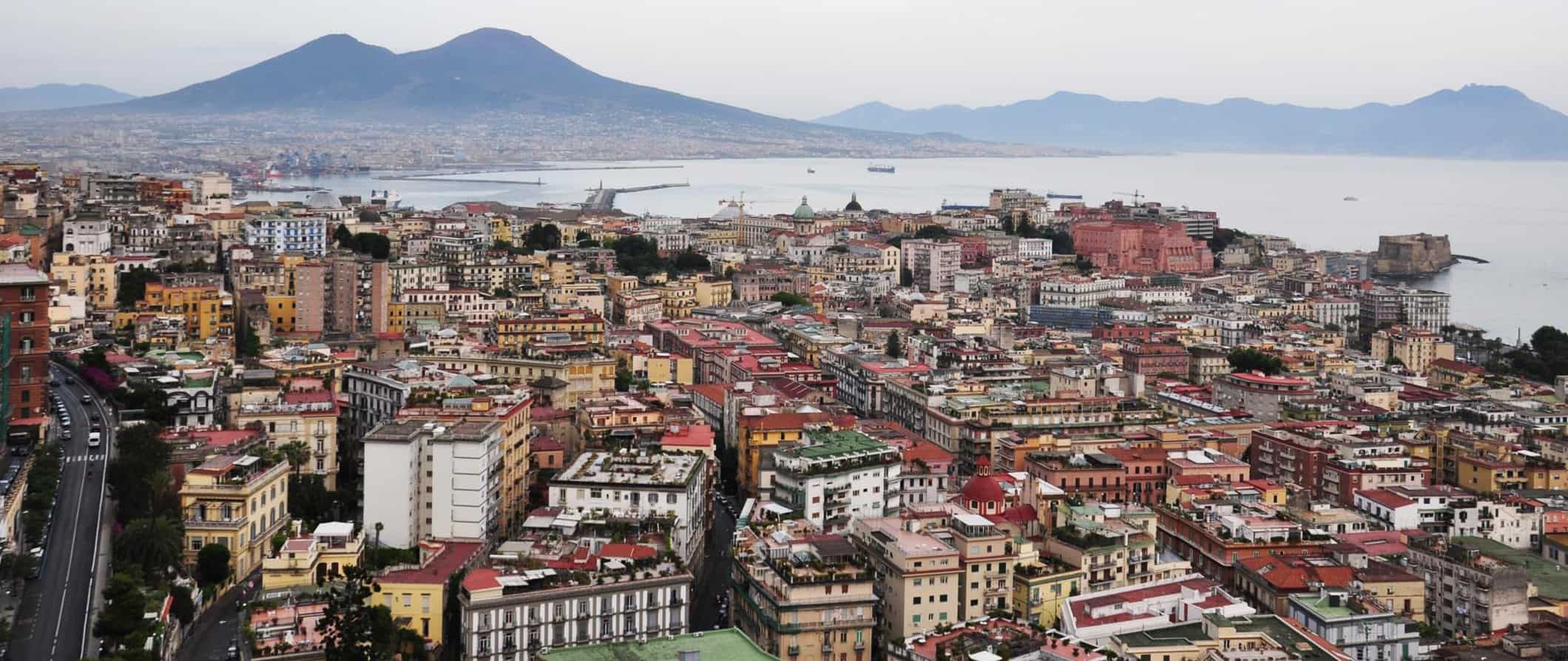
Naples, made famous as the birthplace of pizza, is a gritty city home to a wealth of historical treasures. The medieval Naples Cathedral, the 18th-century Villa Comunale park, and nearby Pompeii make Naples a must-see destination for history buffs and foodies alike.
Naples is the gateway to the south of Italy so you’re very likely to come here if you’re crisscrossing the country. Its location near Pompeii, Capri, and Sorrento makes it the perfect starting point for exploring the region.
Best of all, it’s a foodie city like no other; I ate my weight in pizza during my visit!
This Naples travel guide can help you plan your trip, save money, and make the most of your time in this iconic Italian city!
Table of Contents
- Things to See and Do
- How to Stay Safe
- Where to Stay
- Typical Costs
- Suggested Budget
- Money-Saving Tips
- How to Get Around
- Best Places to Book Your Trip
- Related Blogs on Naples
Click Here for City Guides
Top 5 things to see and do in naples.
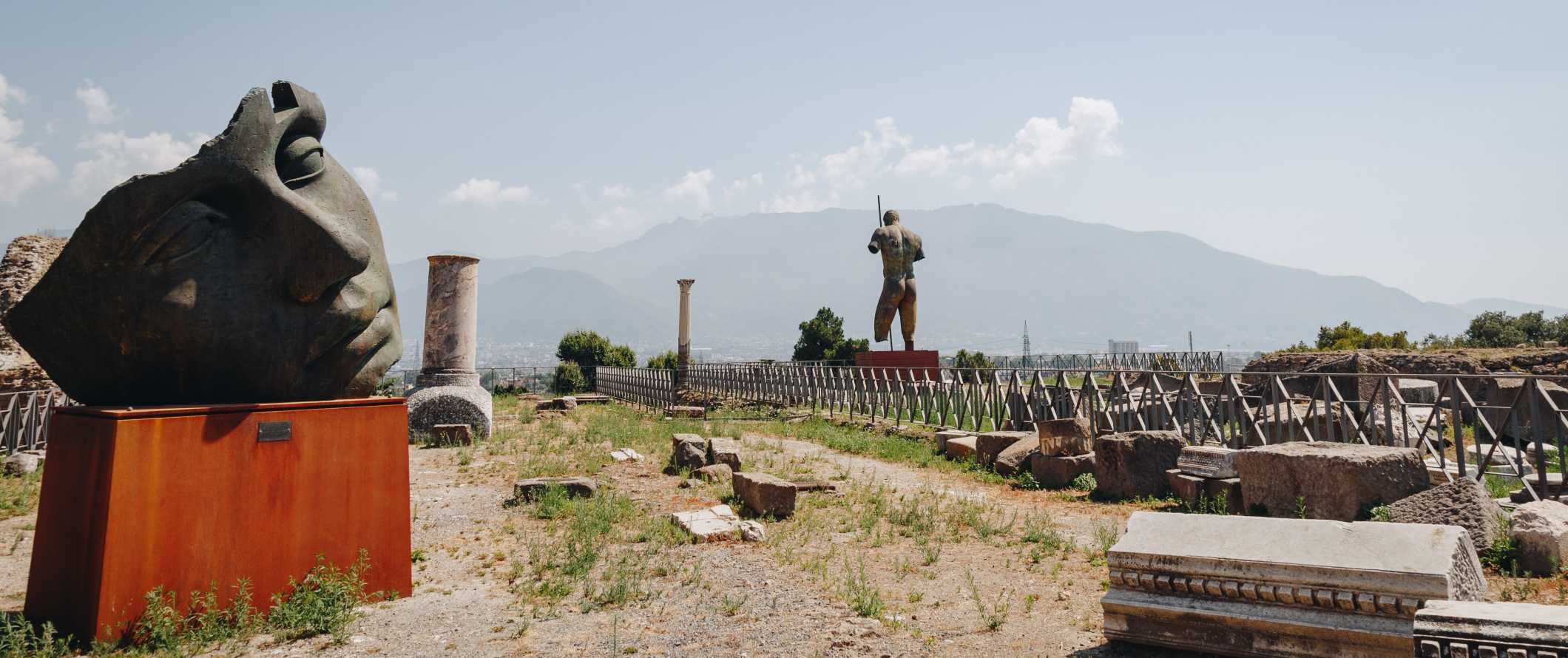
1. Visit the Archaeological Museum of Naples
This museum has one of the world’s best collections of Greek and Roman artifacts from both the city of Naples and nearby Pompeii. There’s ancient jewelry, mosaics, bronzes, sculptures, and a cast of a girl who perished in the eruption of Mount Vesuvius in 79 CE. The museum also contains a room that is referred to as the “Secret Cabinet,” a collection of 1st-century Roman erotic art from Pompeii and Herculaneum. Be prepared to spend a few hours here. It’s really detailed. Admission is 22 EUR.
2. Check out Villa Comunale
King Ferdinand IV designed this strip of seaside land as a park for Bourbon royalty in the 1780s. Except for special events, it was closed to the public until 1869 after the unification of Italy. In addition to beautiful walkways and gardens, there is a vintage aquarium and several ornate fountains lining the 1-kilometer (0.62 miles) promenade. I really enjoyed the gardens here. They were some of the best in Naples. The wide pedestrian walkways have benches around so you can find a spot to relax under one of the many palm trees. There’s also a lovely gazebo made of stained glass, along with sculptures and busts throughout the gardens.
3. Hike Mount Vesuvius
Mount Vesuvius is the volcano that wiped out Pompeii and Herculaneum in 79 CE, killing thousands of people in the process. Now, it’s dormant and you can hike up it. The hike is a fairly steep climb, but a short one (it’s just 30-60 minutes). At the top, you’ll be able to look into the depths of the volcano’s crater. It’s one of the few active volcanoes on the continent, and it’s really fascinating to look into the mountain that demolished Pompeii. You can also see out across the Bay of Naples. You’ll get breathtaking views of the area. The entry fee is 10 EUR and must be purchased online in advance. It’s easy to get here from Naples by taking the train and then transferring to a shuttle bus.
4. Explore Pompeii
The archaeological site of Pompeii lives up to the hype. Buried under 4-6 meters (13-20 feet) of volcanic ash when Mount Vesuvius erupted, the ancient Roman city was preserved as a snapshot in time. Today, you can wander the expansive, 160-acre UNESCO World Heritage Site with its excavated villas, baths, amphitheater, mosaics, frescoes, and gruesome casts of victims in their final moments. It’s a fascinating place and I spent a whole day here wandering around. You can visit the site on your own for 22 EUR, but the best way to make the most of your time is to take a guided tour to get the context of all the buildings and remains. Bring sunscreen as the site is pretty exposed and it can get really hot wandering around, especially in the summer.
5. See the Duomo
The Duomo is a 13th-century Gothic cathedral dedicated to the city’s patron saint, San Gennaro. The church is decorated with frescoes, reliefs, and mosaics from across the centuries. You can also descend into the crypt to see the archaeological remains of the ancient paleo-Christian church that the cathedral was built on top of. Every year, the Duomo hosts the Festival of San Gennaro, where a vial of the saint’s dried blood is taken out of storage in hopes that it will liquefy. Legend states that if the blood does not liquefy, tragedy will befall Naples. Entrance to the cathedral is free.
Other Things to See and Do in Naples
1. take a free walking tour.
One of the first things I do in a new destination is to take a free walking tour. It’s the best way to see the main highlights and learn about the city from a local guide who can answer all your questions. Free Walking Tour Napoli offers a solid free tour that covers all the main sights and lasts a few hours. (Be sure to tip your guide at the end!)
2. Shop at Piazza del Mercato
This market has been Naples’ main market square since the 13th century. It’s located only a couple blocks from the waterfront, only a short walk from the train station. There are four churches surrounding the square and it’s where the local revolt of Naples against the rule of Spain happened in the 1600s. It sells everything from household goods to fresh produce and handmade souvenirs. During the Christmas season, this place is jam-packed with even more stalls selling festive goods.
3. Watch a show at Teatro San Carlo
Opened in 1737, this is the world’s oldest opera house, having survived wars, fires, and revolutions. The inside, with blue upholstery, gold décor, sparkling chandeliers, and almost 1,400 seats gives off a lavish and ornate atmosphere. Operas and other performances are happening regularly through most of the year with a break in August. Tickets start around 15 EUR. If you can’t catch a show here, at least do a guided tour for 9 EUR.
4. Explore Herculaneum
Herculaneum is the lesser-known cousin of Pompeii. It used to be a fishing village of about 4,000 inhabitants who all befell the same fate as the citizens of Pompeii. The site is also very well preserved and usually has fewer tourists. The city was founded in the 7th century BC and some of the structures, like the Samnite House date back to the 2nd century BC. You can see an ancient Roman bath house and the hall where the devotees of Emperor Augustus met. There are even frescos still intact in The Hall of Augustals. While I wouldn’t skip Pompeii, you should also try to work in a visit here too. Tickets are 11 EUR. If you want to do a guided tour with an archeologist , tours are 54 EUR.
6. Visit Villa Floridiana
Originally built in 1816 as a gift from King Ferdinand I to his second wife Duchess Lucia Migliaccio, this estate has beautifully manicured gardens, expansive views over Naples Bay, and an ornate fountain filled with turtles. It also houses the National Museum of Ceramics. The exterior is beautiful white stonework with tall, shuttered windows. There are incredible views of the sea from the villa. With over 6,000 pieces in the collection, you’ll see everything from Japanese Edo ceramics to European pieces. It’s 4 EUR to visit the museum.
7. Tour the Anfiteatro Flavio
This was once the third-largest amphitheater in all of Italy, dating back to 1 CE (only the Roman Colosseum and the amphitheater in Capua are larger). Started under Emperor Vespasian and completed by his son, over 40,000 people used to gather here to watch gladiator matches and other entertainment. Today, you can tour the various fallen columns and learn more about the history of the stadium and its events. Admission is 4 EUR.
8. Visit Museo Nazionale di Capodimonte
This is the Neapolitan National Gallery, a museum featuring work by Baroque and Renaissance artists. The museum is set inside the grounds of the Real Bosco di Capodimonte Park and the pink-toned building, which originally a palace for the Bourbons, is surrounded by palm trees. Some of the big names here include Giordano, Caravaggio, Bellini, Botticelli, El Greco, and Titian. Works date from the 13th to 18th century. In addition to the artwork, some of the rooms are partially furnished with artifacts, furniture, and fashion. Admission is 14 EUR.
9. Wander through Castel Nuovo
Castel Nuovo is a large medieval castle that stands out along the coastline near the Port Naples waterfront. It was built in 1266 and was a center of culture for artists of the time. It later became a fortress for the military. Now people come to visit the art museum, which houses a gallery of 17th-19th century Italian paintings, including works from Luigi Crisconio and Carlo Vanvitelli. You can also visit various rooms in the castle like the Hall of the Barons and the Hall of the Armory where ruins from the Roman period have been found. It’s 6 EUR to visit and you will get some great views over Naples and the coast too.
10. Take the Underground Tour
This was my favorite activity in Naples. Located in the city center, you can take an underground tour to explore some of the historic ruins of the city, including ancient reservoirs and the remains of a Roman-era theater. The underground was originally excavated by the Greeks in the 3rd century BC for materials to build their temples. Later, the Romans built aqueducts. The tunnels were even used as air-raid shelters during WWII. You’ll learn more about how the city has been built upon and changed over its 2,400-year history. Guided tours start around 17 EUR and are well worth it.
How to Stay Safe in Naples
Naples is a very safe place to backpack and travel but often gets a bad rap for being a bit grittier than other places in Italy. Pickpocketing is the most common crime you’ll encounter here so you need to stay vigilant in crowded areas (especially on public transportation). Always keep your valuables secure and out of reach.
When taking a taxi, always make sure they use the meter so you don’t get ripped off.
Solo female travelers should generally feel safe here. However, the standard safety precautions apply (never leave your drink unattended at the bar, never walk around alone at night intoxicated, etc.). There are a ton of incredible solo female travel blogs on the web that can give you specific information about a place. They’ll give you tips and advice that I can’t.
While scams here are rare, you can read about common travel scams to avoid here.
The Spanish Quarter is a little sketchy at night, so avoid that area after dark or if you’re alone.
If you’re walking everywhere, stay alert! The traffic in Naples is crazy and drivers do not respond to traffic lights very well. Be careful when crossing the street.
If you experience an emergency, dial 113 for assistance.
Always trust your gut instinct. Make copies of your personal documents, including your passport and ID.
The most important piece of advice I can offer is to purchase good travel insurance. Travel insurance will protect you against illness, injury, theft, and cancellations. It’s comprehensive protection in case anything goes wrong. I never go on a trip without it as I’ve had to use it many times in the past. You can use the widget below to find the policy right for you:
Where to Stay in Naples
Looking for an affordable place to stay when you visit? Here are some of my recommended places to stay in Naples:
- Hostel Mancini
- Hostel of the Sun
- La Controra Hostel
- Villa Margherita
- B&B Hotel Napoli
- Best Western Hotel dei Mille
Naples Travel Costs
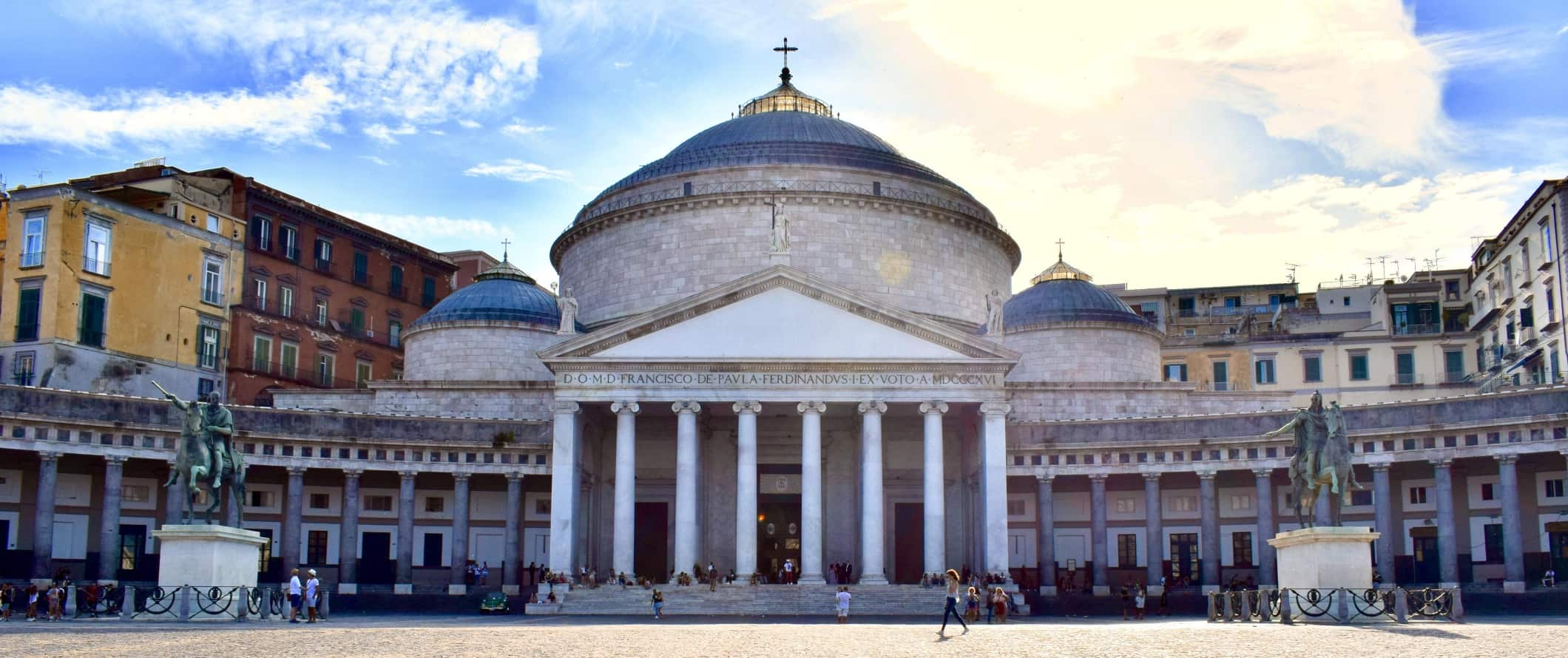
Accommodation
- Hostel dorms – 20-46 EUR per night
- Hostel private rooms – 80-100 EUR per night
- Budget hotels – 65-100 EUR per night
- Airbnb private rooms – 45-60 EUR per night
- Airbnb apartments – 60 EUR (expect double if you don’t book early)
- Campsite – 11 EUR per night
- Street food – 6-12 EUR
- Sit-down restaurants – 30 EUR
- Casual take-out places – 5-10 EUR
- Fast food (think McDonald’s) – 8 EUR
- Beer – 4-5 EUR
- Cappuccino/latte- 2 EUR
- Bottled water – 1-2 EUR
- Groceries for a week – 50-60 EUR
Naples Suggested Budgets
Backpacker – 70 eur per day.
On a backpacking budget, you can stay in a hostel dorm, cook all your meals, and take public transportation to get around. You’ll need to limit your drinking and do mostly free activities like strolling the parks and taking free walking tours. If you plan on drinking, add 5-10 EUR to your daily budget.
Midrange – 135 EUR Per Day
On a mid-range budget, you can stay in a private Airbnb or budget hotel. You’ll be able to eat out for most meals, enjoy a few drinks, take the occasional taxi to get around, and do more paid activities like visiting the museums and taking a day trip to Pompeii.
Upscale – 230 EUR Per Day
On a “luxury” budget, you can stay in a hotel, eat out for all your meals, drink more, rent a car or take more taxis, and do whatever tours and activities you want. This is just the ground floor for luxury though. The sky is the limit!
Naples Travel Guide: Money-Saving Tips
Naples isn’t as expensive as northern Italian cities like Rome or Florence but it’s still easy to blow your budget if you eat out a lot and do lots of activities. Fortunately, there are lots of ways to save here. Here’s how you can save money when traveling in Naples:
- Eat on the cheap – Have a pizza or take a sandwich to go for just a few dollars to help manage your spending. Pizza is the best food in Naples and won’t break the bank.
- Get the Visitalia Tourist Card Napoli – If you are going to do lots of sightseeing, this tourist card provides discounts on the top museums, tours, and attractions. It’s priced to save you money compared to buying separate tickets and includes free public transportation. A one-day pass costs 14.50 EUR, a two-day pass costs 19 EUR, and a three-day pass costs 23.50 EUR. There’s even a week-long pass for just 26.80 EUR.
- Buy wine instead of going to a bar – You can buy a great bottle of wine for around 5 EUR at the store. It’s a lot cheaper than drinking at the bar.
- Redeem hotel points – When you sign up for hotel credit cards, you can use those points to pay for accommodations when you travel. Most cards come with at least 1-2 nights free when you sign up. Here’s an article to learn the basics . That way you can start earning points now and have plenty for your next trip.
- Get a public transit pass The Ticket Integrato Campania (TIC) pass gives you unlimited access to the bus, trams, trolleys, and metro system in Naples and the surrounding area. You can get a 24-hour pass for 5.40 EUR or a one-week pass for 16.20 EUR. If you’re going to be visiting a lot of places around Naples, this can save you quite a bit over paying 1.30 EUR for a single ride.
- Stay with a local – Use Couchsurfing to stay with locals who have extra beds and couches for free. It’s a great way to save money and connect with locals who can share their tips and advice. Just make sure to send your requests early.
- Go on a free walking tour – This is a great way to learn the history behind the places you are seeing and to avoid missing any must-see stops. Free Walking Tour Napoli runs regular tours to help you get your bearings and see the main highlights. Just don’t forget to tip your tour guide!
- Bring a water bottle – The tap water here is safe to drink so bring a reusable water bottle to save money and reduce your plastic use. LifeStraw is my go-to brand as their bottles have built-in filters to ensure your water is always clean and safe.
How to Get Around in Naples
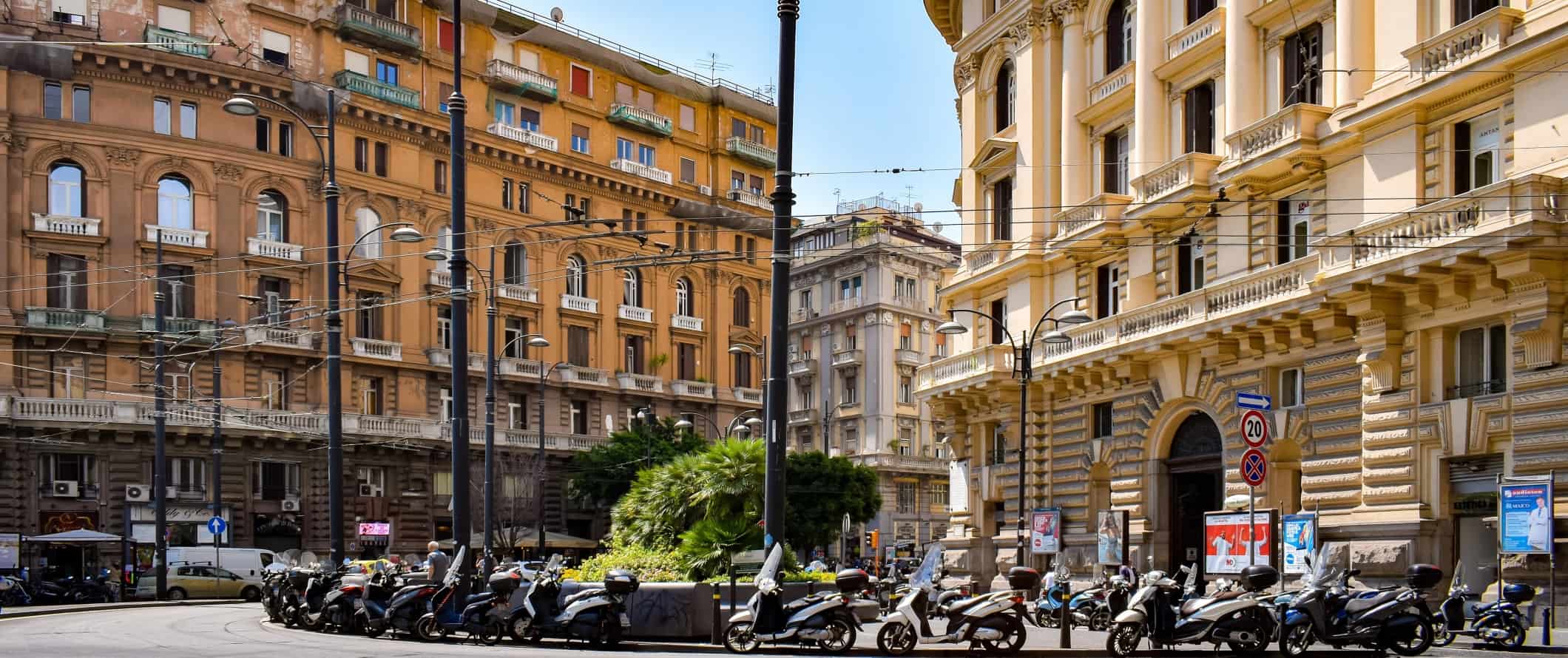
Public transportation – When it comes to public transportation in Naples, it’s best to get a TIC (Ticket Integrato Campani) ticket, which works on all city metro, bus, and funicular services. A single ticket costs 1.30 EUR and is good for 90 minutes. A one-day pass is 5.40 EUR and a weekly ticket is 16 EUR.
The bus isn’t the most efficient way to get around Naples, but it’s useful for navigating Corso Umberto (the long main commercial street) since there is a designated bus lane.
Naples has a metro, but it doesn’t have an extensive network so the bus is usually a better idea.
Train – The Circumvesuviana trains from Napoli Centrale runs to Sorrento for 3.60 EUR. Herculaneum and Pompeii costs just 2.60 EUR. The Ferrovia Cumana trains run to Pozzuoli for about 3 EUR.
Taxis – Taxis are not cheap here. Meter rates start from 5 EUR and cost 2 EUR per kilometer. Skip the taxis if you can as they add up fast. If you do need a taxi, make sure the driver uses the meter so you don’t get ripped off.
Bike rental – Naples is a bike-friendly city and rentals can be found for as little as 5 EUR per day.
Car rental – Cars can be rented for around 30-40 EUR per day for a multi-day rental. However, traffic in Naples is terrible so I’d only rent a car if you’re heading out to do some day trips. Additionally, drivers here are on the aggressive side, so I’d only rent a car if you’re an experienced driver. For the best rental car deals, use Discover Cars .
When to Go to Naples
Thanks to its location on the Mediterranean, Naples is warm year-round. The summer months (June-August) are the most popular time to visit but they are also scorching, with temperatures usually above 31°C (88°F). July is also the driest month of the year. Many Italians take their vacations in August, so it gets particularly crowded here then. Expect accommodation to be booked well in advance (and to be more expensive) during this time. If you decide to visit during this time of year, you can catch the Pizza Village in June which is ten whole days celebrating pizza in the city where the famous dish was created.
Personally, I think the shoulder seasons are the best time to visit Naples (April-May and September-October). You’ll avoid peak tourism season and you’ll still have nice weather. Temperatures average around 22°C (72°F) which is much more tolerable.
This is especially a good time to visit Naples if your priority is going to Pompeii or Herculaneum. There will be fewer crowds and you will be a lot more comfortable exploring the ruins in cooler temperatures. There isn’t much shade at these sites and very few places to sit and take breaks. There are a lot of festivals during these seasons that you might enjoy. The Feast of San Gennaro, the city’s patron saint is one of the largest and takes place on September 19th with plenty of festivities happening around that time. In the spring you, can check out the Maggio dei Monumenti in May that’s a celebration of the local architecture and monuments.
December to February are the coldest months, with daily highs around 8°C (46°F). This isn’t the best time to visit, but prices will be a little lower and the crowds are gone. There are Christmas markets in the city, if you visit during December and the city is filled with colorful light displays. There are also thermal spas around the area, like the Termi di Agnano and Stufe di Nerone that will keep you warm, if you choose to visit during this time.
Naples Travel Guide: The Best Booking Resources
These are my favorite companies to use when I travel. They consistently have the best deals, offer world-class customer service and great value, and overall, are better than their competitors. They are the companies I use the most and are always the starting point in my search for travel deals.
- Skyscanner – Skyscanner is my favorite flight search engine. They search small websites and budget airlines that larger search sites tend to miss. They are hands down the number one place to start.
- Hostelworld – This is the best hostel accommodation site out there with the largest inventory, best search interface, and widest availability.
- Booking.com – The best all around booking site that constantly provides the cheapest and lowest rates. They have the widest selection of budget accommodation. In all my tests, they’ve always had the cheapest rates out of all the booking websites.
- HostelPass – This new card gives you up to 20% off hostels throughout Europe. It’s a great way to save money. They’re constantly adding new hostels too. I’ve always wanted something like this and glad it finallt exists.
- Get Your Guide – Get Your Guide is a huge online marketplace for tours and excursions. They have tons of tour options available in cities all around the world, including everything from cooking classes, walking tours, street art lessons, and more!
- The Man in Seat 61 – This website is the ultimate guide to train travel anywhere in the world. They have the most comprehensive information on routes, times, prices, and train conditions. If you are planning a long train journey or some epic train trip, consult this site.
- Rome2Rio – This website allows you to see how to get from point A to point B the best and cheapest way possible. It will give you all the bus, train, plane, or boat routes that can get you there as well as how much they cost.
- FlixBus – Flixbus has routes between 20 European countries with prices starting as low 5 EUR! Their buses include WiFi, electrical outlets, a free checked bag.
- SafetyWing – Safety Wing offers convenient and affordable plans tailored to digital nomads and long-term travelers. They have cheap monthly plans, great customer service, and an easy-to-use claims process that makes it perfect for those on the road.
- LifeStraw – My go-to company for reusable water bottles with built-in filters so you can ensure your drinking water is always clean and safe.
- Unbound Merino – They make lightweight, durable, easy-to-clean travel clothing.
- Top Travel Credit Cards – Points are the best way to cut down travel expenses. Here’s my favorite point earning credit cards so you can get free travel!
- BlaBlaCar – BlaBlaCar is a ridesharing website that lets you share rides with vetted local drivers by pitching in for gas. You simply request a seat, they approve, and off you go! It’s a cheaper and more interesting way to travel than by bus or train!
GO DEEPER: Nomadic Matt’s In-Depth Budget Guide to Europe!

There’s a lot of free information online but do you want to spend days searching for information? Prob not! That’s why guidebooks exist.
While I have a lot of free tips on Europe, I also wrote an entire book that goes into great detail on everything you need to plan a trip here on a budget! You’ll get suggested itineraries, budgets, even more ways to save money, my favorite restaurants, prices, practical information (i.e. phone numbers, websites, prices, safety advice, etc etc), and cultural tips.
I’ll give the insider view of Europe that I got from years of traveling and living here! The downloadable guide can be used on your Kindle, iPad, phone, or computer so you can have it with you when you go. Click here to learn more about my book on Europe!
Naples Travel Guide: Related Articles
Want more tips for your trip? Check out all the articles I’ve written on Italy travel and continue planning your trip:
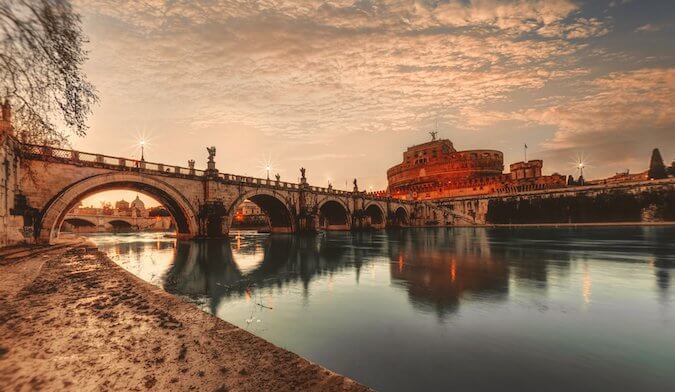
The Best Tour Companies in Italy
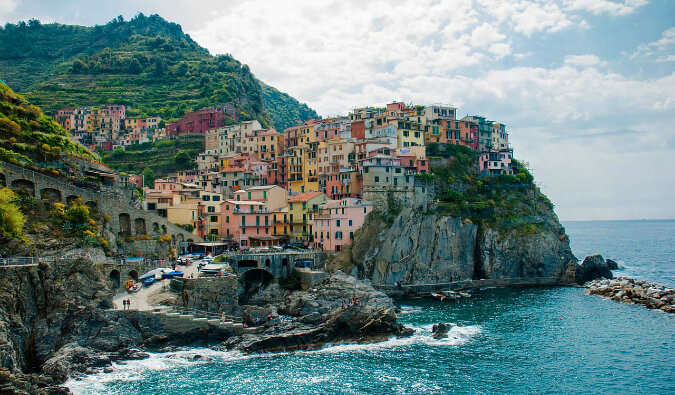
Rediscovering the Beauty of Italy
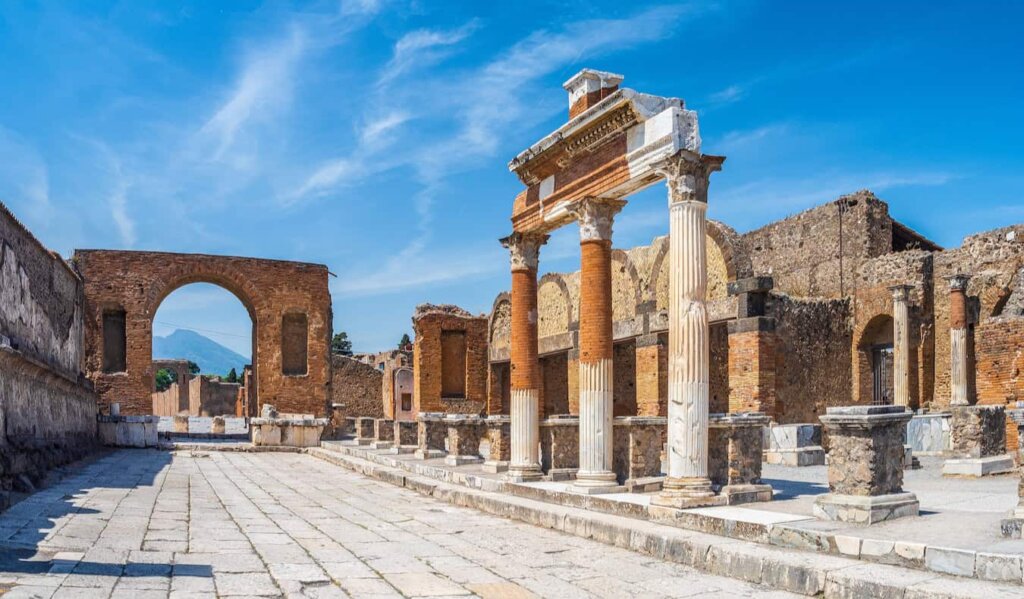
The Ultimate Guide to Visiting Pompeii
Get your free travel starter kit.
Enter your email and get planning cheatsheets including a step by step checklist, packing list, tips cheat sheet, and more so you can plan like a pro!

- Where To Stay
- Transportation
- Booking Resources
- Related Blogs

©Mariia Golovianko/Shutterstock
Naples is raw, high-octane energy, a place of soul-stirring art and panoramas, spontaneous conversations and unexpected, inimitable elegance – welcome to Italy's most unlikely masterpiece.
Best Time to Visit
Best things to do, attractions, must-see attractions.
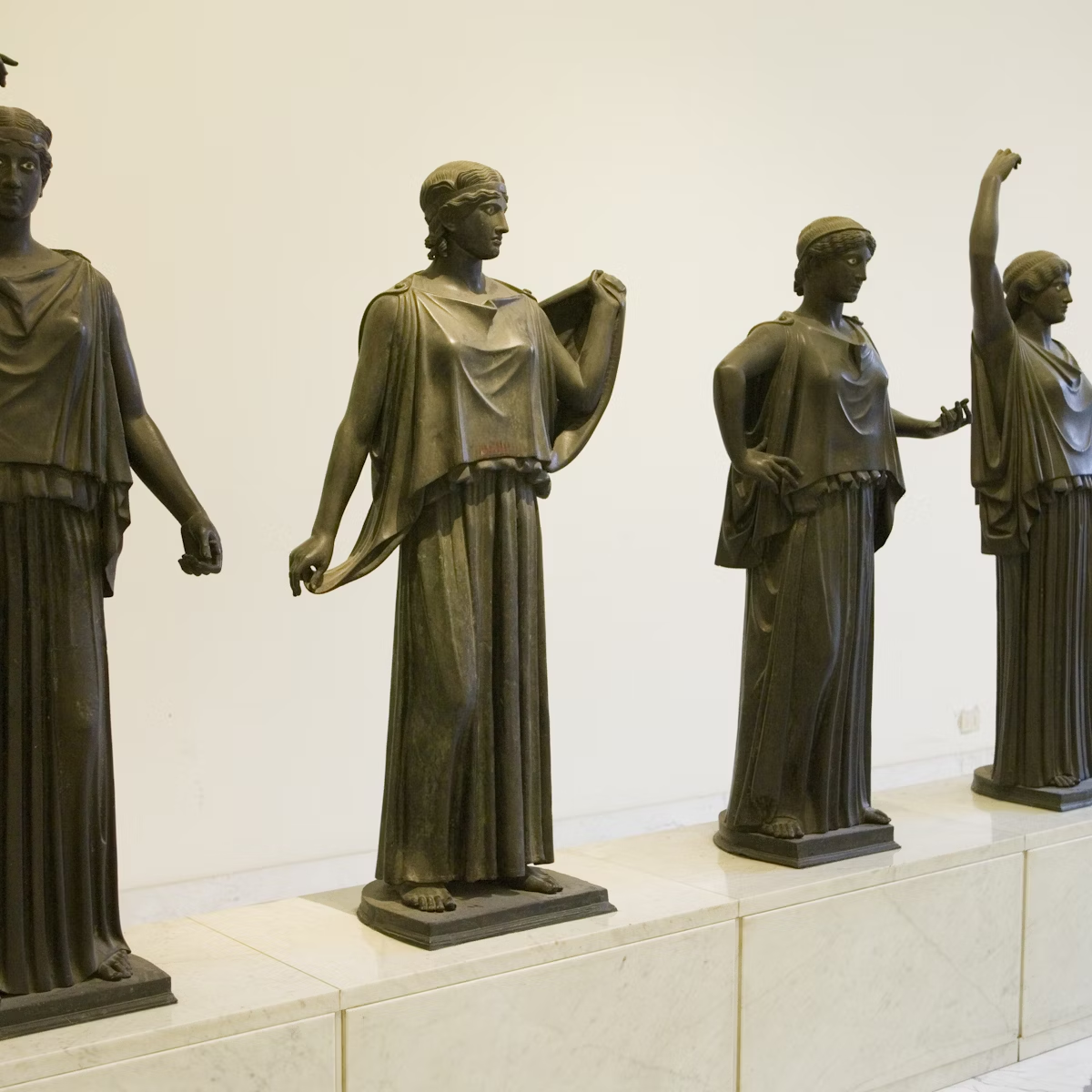
Museo Archeologico Nazionale
Naples' National Archaeological Museum serves up one of the world’s finest collections of Graeco-Roman artefacts. Originally a cavalry barracks and later…

Museo di Capodimonte
Originally designed as a hunting lodge for Charles VII of Bourbon, the monumental Palazzo di Capodimonte was begun in 1738 and took more than a century to…
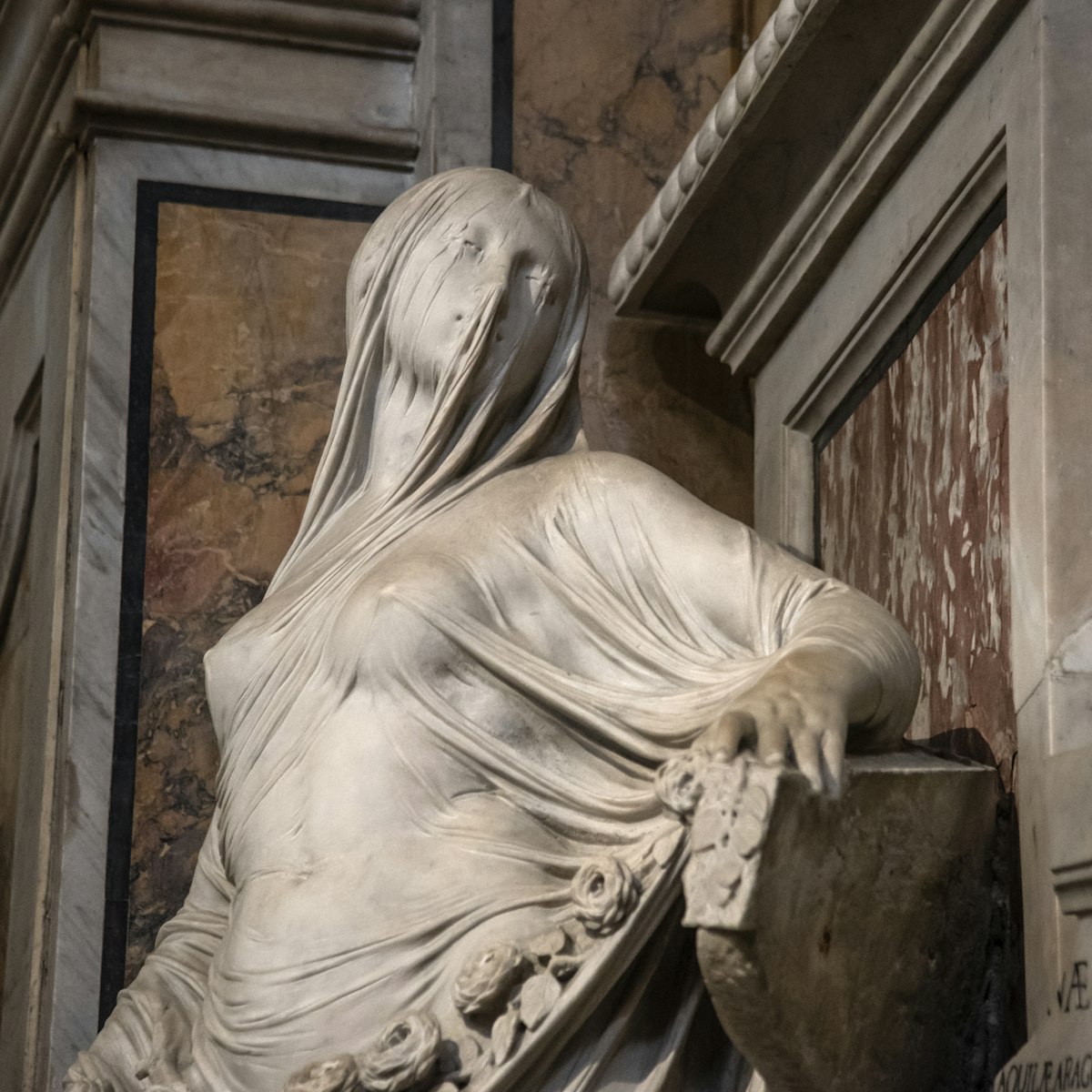
Cappella Sansevero
It's in this Masonic-inspired baroque chapel that you'll find Giuseppe Sanmartino's incredible sculpture, Cristo velato (Veiled Christ), its marble veil…

Certosa e Museo di San Martino
The high point (quite literally) of the Neapolitan baroque, this charterhouse-turned-museum was built as a Carthusian monastery between 1325 and 1368…

Catacombe di San Gennaro
Naples' oldest and most sacred catacombs became a Christian pilgrimage site when San Gennaro's body was interred here in the 5th century. The carefully…

Whether you go for Giovanni Lanfranco's fresco in the Cappella di San Gennaro (Chapel of St Janarius), the 4th-century mosaics in the baptistry, or the…

Complesso Monumentale di Santa Chiara
Vast, Gothic and cleverly deceptive, the mighty Basilica di Santa Chiara stands at the heart of this tranquil monastery complex. The church was severely…

Gallerie d'Italia
Built for a Spanish merchant in the 17th century and reconfigured in belle-époque style by architect Luigi Platania in the early 20th century, Palazzo…
Planning Tools
Expert guidance to help you plan your trip.
Things to Know
Naples, with its captivating architecture, rich history, and mouth-watering food, is not to be missed. Here's everything you need to know before you go.
Best Neighborhoods
A variety of sights and activities are packed into each Neapolitan neighborhood, so you can craft your own experience – ethereal, elegant or edgy.
Naples cooks up plenty of things to see and do, but the pace of life is full-throttle – take one of these day trips from Naples for a breath of fresh air.
Money and Costs
Discover how to shop for picnics, find a volunteer experience, select just the right short-term rental and more ways to enjoy Naples on a budget.
Transportation
Though you're usually better off walking to get around Naples, the city does offer a comprehensive network of public transportation.
Free Things to Do
Many of the best things to see and do in Naples are found in its historic center. Here are 10 don't-miss Naples' experiences that cost next to nothing.
Naples is the home of many unique stores. Here's our pick of the best.
Plan with a local
Experience the real Italy
Let a local expert craft your dream trip.

Latest stories from Naples

Jul 1, 2024 • 4 min read

Dec 14, 2023 • 7 min read

Dec 7, 2023 • 7 min read

Feb 17, 2022 • 3 min read

Feb 16, 2022 • 6 min read

Feb 9, 2022 • 11 min read

Feb 4, 2022 • 5 min read

Jan 26, 2022 • 4 min read

Jan 25, 2022 • 8 min read

Jan 22, 2022 • 5 min read
in partnership with getyourguide
Book popular activities in Naples
- Best Time to Visit
- Weather & Climate
- Naples International Airport Guide
- Public Transportation
- Neighborhoods to Know
- 48-Hour Itinerary
- Day Trips From Naples
- Top Things to Do
- Best Museums
- Historic Attractions to Visit
- Food to Try
- Best Restaurants
- Search Please fill out this field.
- Newsletters
- Destinations
22 Things to Do in Central Naples, Italy
:max_bytes(150000):strip_icc():format(webp)/ElizabethHeath-Headshot-horiz-e7525e97616245958bf3d94e8db7f119.png)
TripSavvy / Christopher Larson
As gritty and chaotic as it is beautiful and vibrant, Naples, or Napoli in Italian, is a city of many contradictions. Located in Southern Italy, or the Mezzogiorno (land of the midday sun), its bustling seaport sits on the edge of the Bay of Naples, in the shadow of Mount Vesuvius, the volcano that destroyed nearby Pompeii.
The celebrated historical center of Naples is brimming with architecturally stunning churches, fascinating museums, elegant palaces, and lively piazzas, all orbiting around a few major streets. The density of tourist attractions means you can easily get in touch with the cultural essence of Naples while still having time to enjoy its fine wines and delicious foods, such as... wait for it... pizza!
Here's a list of some of our favorite things to do and see in the historical center of Naples, Italy.
Visit the Cathedral of Naples (Duomo)
Dedicated to Naples' patron saint, San Gennaro, this 13th-century Gothic cathedral features Baroque frescoes and artwork, but most importantly holds the saint's relics, including two vials of his coagulated blood. Be sure to visit the archaeological area under the cathedral, with ruins from ancient Greece to the Middle Ages. Don't forget to check out the 5th-century baptistery, adorned with Byzantine-style mosaics. Each year on September 19th, thousands gather here on the Feast Day of San Gennaro to watch the miracle of the saint's blood liquefying. Processions and celebrations go on for eight days.
See Frescoes & Tilework at the Santa Chiara Complex
Erected on this site in the 14th century, Santa Chiara Church is part of a religious complex consisting of a monastery, tombs, and an archeological museum. In the 17th and 18th centuries it was remodeled with a Baroque facade, but after being destroyed by bombs in World War II, it was reconstructed to its original Provencal-Gothic style. The tombs of the Angevin monarchs lie here, as well as relics of Saint Louis of Toulouse, including his brain. Next to the church is the nun's choir with fragments of frescoes attributed to Giotto. The adjacent cloisters, designed by Vaccaro in 1742, contain intricate majolica-tiled columns and benches, and the courtyard walls feature 17th-century frescoes depicting saints, allegories, and scenes from the Old Testament. In the museum, you'll find a Roman bathhouse dating back to the 1st-century C.E.
Explore the Piazza San Domenico Maggiore & Sansevero Chapel
TripSavvy / Taylor McIntyre
One of the most important squares in Naples, Piazza San Domenico Maggiore features an obelisk built by monks as a gesture of gratitude for having survived the deadly plague of 1656. On the square is the 15th-century Palazzo Petrucci, with its original entry and courtyard intact. Towards the back of the piazza sits the Church of San Domenico Maggiore, where you can see the remnants of an original 10th-century Romanesque basilica, and early Renaissance art—such as frescoes by Pietro Cavallini—as well as copies of works by Caravaggio and Titian (originals are in the Capodimonte Museum). Inside the church are the tombs of various members of the Anjou dynasty, as well as the 13th-century cross that was said to have spoken to St. Thomas Aquinas. Don't miss a visit to the Sansevero Chapel with marble sculptures and paintings of the 18th century, including the extraordinary and haunting Veiled Christ by Sanmartino.
See Roman Ruins at the Basilica of San Lorenzo Maggiore
A rare Gothic edifice, the Basilica of San Lorenzo Maggiore has the excavated remains (scavi) of a Greco-Roman city underneath it, including a Roman forum. Several recreations have been set up to show what the city might have looked in Roman times. The museum exhibits works from the Greek and Roman periods through the 19th century, notably the frescoed ceilings in the Capitolare and Sisto V rooms.
Explore the Naples Underground
Underneath the city lies a hidden labyrinth of ancient tunnels, aqueducts, cisterns, catacombs, and a Greco-Roman theatre where Emperor Nero had his dressing room. Naples Underground takes visitors on a captivating tour of the vast subterranean network of chambers and pathways buried below this modern city.
Go Back in Time at the National Archaeological Museum of Naples
World-renowned for having an outstanding collection of Greek and Roman antiquities, including mosaics, sculptures, gems, glass, and silver, it also displays an impressive collection of finds from Pompeii. Allow at least half a day here, and don't forget to book ahead for the Secret Cabinet tour, where you can view erotic works from Pompeii.
Imagine Life in the Palazzo Reale (Royal Palace)
Begun by Spanish Viceroys in 1600, Palazzo Reale was eventually expanded to become Naples' royal palace. Behind the handsome exterior are great halls and royal apartments filled with furnishings, tapestries, paintings, and porcelains. Visit the roof garden where the sweeping views of the bay remind you that it's good to be a king.
Walk Around the Piazza del Plebiscito
It was after the Unification of Italy in 1860 that Piazza del Plebiscito was named. Located right in the middle of Naples, the once disheveled square has been spruced up in recent years to reflect the grandeur of its important neighbors: Palazzo Reale (Royal Palace), and San Francesco di Paola, featuring a 19th-century dome modeled after the Pantheon in Rome. The piazza is further enhanced by Palazzo Salerno and Palazzo della Prefettura, along with several equestrian statues of King Carlo III and King Ferdinando I by master sculptor Antonio Canova. From the Piazza del Plebiscito, continue on Via Toledo (also called Via Roma): a pedestrian area that's one of the old town's main business and shopping streets.
See Body Parts at the Anatomy Museum
If catacombs and crypts are not macabre enough for you, in the Anatomy Museum of the University of Campania Luigi Vanvitelli, part of the MUSA museum of science and art, you can see the preserved remains of actual human beings. For some, the exhibits are the stuff of nightmares, but for others, it's just another day at the museum.
Peer through formaldehyde-filled jars at an array of strange medical defects, or skip ahead to the more sedate anatomical section of the museum to marvel at the work of Efisio Marini and Giuseppe Albini, who created unique pieces of art using pickled or calcified body parts.
Walk Spaccanapoli in the Heart of the City
Spaccanapoli (Naples splitter) is the main street bisecting the historic and noisy heart of the city. Running east to west, it provides easy access to Naples' most popular sights. Teeming with people day and night, the boulevard is home to classical churches and old palazzi (stately buildings). Part of what was a Greek, and later a Roman city, the Spaccanapoli district has a network of narrow, winding streets — many pedestrian-only zones. Along the way, keep an eye out for small shops selling traditional Neapolitan street fare, like pizza a portafoglio (folded pizza) and deep-fried "balls of rice" (palle ‘e riso).
Shop on Via San Gregorio Armeno
TripSavvy / Taylor McIntyre
Even if you're not into religious manger scenes, Via San Gregorio Armeno is definitely worth experiencing. Lined with a string of artisan workshops that make statuettes and scenery for traditional Neapolitan nativity scenes or presepi , the figurines and souvenirs spill out onto the street. About halfway up the Via San Gregorio Armeno is the church of the same name. On Tuesdays at the 9:30 am service, witness the miracle of Saint Patricia's liquefying blood.
Explore Ancient Arcades on Via dei Tribunali
Also known as Decumano Maggiore, Via dei Tribunali is another old street that ran through the ancient Greek city of Neapolis founded in the 5th century BCE. Along the way, visit splendid Gothic, Renaissance, and Baroque churches that preserve numerous masterpieces, including a painting by Caravaggio in the Church of Pio Monte della Misericordia. The shady arcades (porticos) date back more than 1,000 years.
Eat All of the Pizza Napolitana
There isn't a dish more deeply linked to the city's cultural identity than pizza. First introduced to the world by the ancient Greeks sometime around the end of the 18th century, the round flatbread found its way to Southern Italy. A popular working-class staple primarily sold by street vendors, it gained worldwide attention at the turn of the 20th century, when Queen Margherita of Savoy developed a liking for the peasant delicacy. She summoned Chef Raffaele Esposito to the royal palace and pizza Margherita was born. In 2017, the craft of pizza making (pizzaiuolo) was officially recognized as a culinary art when it was added to UNESCO's Intangible Cultural Heritage of Humanity list.
Indulge at Scaturchio Pastry Shop
Nico De Pasquale Photography/Getty Images
Don't miss the gastronomical delight that is Naples' desserts. Taste traditional pastries such as babà (rum-soaked dough) and Sfogliatella (flaky pastry filled with ricotta and candied citrus). The best of the best can be found at Scaturchio, Naples' oldest pastry shop.
Take in the View From the Castel dell'Ovo
Sitting in a prominent position on the harbor, Castel dell'Ovo is the oldest fortification in Naples. Built in 1154, the fortification occupies a small island facing the Santa Lucia district. Once the site for the city's shellfish trade, it later became the royal residence under the Normans and the Hohenstaufen. Today, the castle is primarily used for exhibitions and concerts.
See the Castel Nuovo
Erected for Charles of Anjou in 1279-1282, this massive Castle Nuovo today houses the Civic Museum (Museo Civico). Containing 14th- and 15th-century frescoes, paintings, and bronze sculptures from the Middle Ages to present, the castle is also known as Maschio Angioino. Built in Aragonese style (apart from the towers and the Cappella Palatina), it boasts a triumphal arch at the entrance built in 1454. The original bronze doors are now in the Palazzo Reale.
Test the Acoustics at Teatro di San Carlo
Italy's largest and oldest opera house, the Teatro di San Carlo is recognized for its perfect acoustics. Built for Charles of Bourdon in 1737, it was rebuilt in 1816, after a fire.
See the Masters at Capodimonte Museum and Park
Among Italy's richest museums, the Capodimonte Museum started out as a hunting lodge for King Charles III. It prides itself in its outstanding picture gallery containing works by Titian, Botticelli, Raphael, and Perugino, as well as having an immense collection of majolica and porcelain pottery. You can wander around the royal apartments and the surrounding park, too.
Get a View From the National Museum and Monastery of San Martino
Offering magnificent views above Santa Lucia from Vomero Hill, the Certosa di San Martino was founded as a Carthusian monastery in the 1300s. The museum offers an impressive display of traditional presepi (nativity scenes) and splendid cloisters designed in 1623-1629 by Cosimo Fanzago, the father of Neapolitan Baroque.
Get Lost at the The Botanical Gardens of Naples
Considered one of the best botanical gardens in Italy, the 170-acre plot of land opened in 1810. It's a public park, as well as a research facility of the University of Naples Federico II, and among the oldest in Europe. The Orto Botanico is dedicated to the preservation of endangered species and the study of how plants can be used for medicinal purposes. On the premises is a restored 5,400 square foot greenhouse comprised of lecture halls, display rooms, and the Museum of Paleobotany and Ethnobotany.
Ride the Funiculars
The first funicolare (a form of railway transportation using a cable to move passengers up steep inclines) was built on the slopes of Mount Vesuvius in the late 1800s. It was abandoned in 1944, after a volcanic eruption severely damaged it. Today there are four funicular lines carrying Neapolitans up and down. One goes to the top of the Vomero district where fabulous views can be had from the Castle Sant'Elmo and the Certosa and Museum of San Martino. Funicolare Centrale, one of the longest in the world, leaves from Via Toledo by Galleria Umberto. The other two are Funicolare di Chiaia and Funicolare di Montesanto. Together they ferry nearly 4 million passengers up and down the inclines of Naples every year.
Related Articles
More related articles.
Naples, Italy Travel Guide
Courtesy of Francesco Riccardo Iacomino | Getty Images

9 Best Things To Do in Naples, Italy
Updated Apr. 14, 2021
Naples is a sprawling city, but most of its best things to do are tucked in the pedestrian-friendly historic center. This UNESCO World Heritage site and its surroundings are home to churches like the Museo Cappella Sansevero , which doubles as an art
- All Things To Do

Via Caracciolo e Lungomare di Napoli Via Caracciolo e Lungomare di Napoli free
For a nice seaside promenade, look no further than the Via Caracciolo e Lungomare di Napoli. Flanked by cafes and restaurants on one side and the Gulf of Naples on the other, this walkway serves as a relaxing place to stretch your legs and breathe in the fresh sea air. The views of nearby Mount Vesuvius and the island of Capri add an almost magical element to this pedestrian walkway.
Although recent visitors say a walk on Via Caracciolo e Lungomare di Napoli is a definite must-do, they recommend steering clear during the weekends when it gets "extremely crowded." Some also cautioned that vendors trying to hawk their goods can be a bit pushy, so be prepared to say a kind but firm " no, grazie " a time or two.

Museo Cappella Sansevero (Sansevero Chapel Museum) Museo Cappella Sansevero (Sansevero Chapel Museum)
The highlight of the Museo Cappella Sansevero is the "Veiled Christ," a statue created by the Neapolitan artist Giuseppe Sanmartino in 1753. The famously realistic statue rests at the center of the chapel, but there are other works of art on display here, too, including the Statues of the Virtues, which portray themes like "Decorum," "Modesty" and "Sincerity." The chapel itself, in both its 18th-century architecture and design, is also a sight to behold. Once you've toured the chapel, head downstairs to the crypt, where the "Anatomical Machines" exhibit is housed. Not for the faint of heart, the exhibit features two glass cases with the skeletons of a man and woman that have their artery and vein systems exposed. It's believed these skeletons date back to 1763.
Recent visitors reported that the "Veiled Christ" is worth the long queues. Others highly recommend reading up on the chapel's artists and history before you go to get the most out of your visit, though purchasing the audio guide is another way to do the same. Audio guides are available in a variety of languages, including English.

Certosa e Museo di San Martino Certosa e Museo di San Martino
Founded in the 14th century as a Carthusian monastery, the Certosa e Museo di San Martino sits high above the city on Vomero hill, leaving visitors in awe of its intricate exteriors, immaculately-designed cloisters and sweeping skyline views. The interior has undergone many alterations over its centuries of existence, including contributions by famous Italian masters Giovanni Antonio Dosio and Cosimo Fanzago. Visitors will also find 17th-century works by such famed artists as Francesco Solimena, Massimo Stanzione, Jusepe de Ribera and Battista Caracciolo. What's more, the Certosa e Museo di San Martino is home to an impressive collection of antique presepi (nativity scenes).
Recent travelers raved about the church's elaborate frescoes and its unbeatable views of the bay, the city and Mount Vesuvius. However, reviewers warned others not to make the same mistake they did by trying to walk to the monastery. After all, it's much easier (and inexpensive) to pay 1 euro ($1) to ride the funicular up the cliff and walk the rest of the way.

Popular Tours

Sorrento, Positano, and Amalfi Day Trip from Naples with Pick Up
(4172 reviews)
from $ 135.12

Day Trip to Capri and Blue Grotto From Naples & Sorrento
(607 reviews)
from $ 185.79

Full-day Sorrento, Amalfi Coast, and Pompeii Day Tour from Naples
(915 reviews)
from $ 146.95

Catacombe di San Gennaro Catacombe di San Gennaro
The Catacombe di San Gennaro date back to the second century, but they became a pilgrimage site in the fifth century when San Gennaro – the patron saint who lends his name to the catacombs – was laid to rest here. Along with the underground graves, visitors will view art, including fifth-century mosaics and a third century, Pompeian-style room adorned with early Christian-themed paintings.
One recent traveler called the tour of the catacombs the "highlight" of his trip to Naples, citing the knowledgeable (English-speaking) travel guide who retells the fascinating history of the catacombs. But this reviewer isn't alone: Most visitors agreed that the guided tour makes this attraction really come alive. Along with comfortable shoes, you'll want to bring a light sweater (even during a summer visit), as the temperature underground can vary quite a bit from the street-level climate.

Museo Archeologico Nazionale di Napoli (Naples National Archeological Museum) Museo Archeologico Nazionale di Napoli (Naples National Archeological Museum)
The Museo Archeologico Nazionale di Napoli is where you'll find artifacts rescued from Pompeii and Herculaneum. The collection includes everything from Greek and Roman sculptures to intricate mosaics. The building itself is also a sight to behold, as it once served as military barracks before it became the city's main university. It didn't become a museum until Charles VII declared it so in the late 18th century.
If you only have time for one museum on your Naples getaway, many recent travelers (and travel experts) recommend making the Museo Archeologico Nazionale di Napoli your pick. Still, more than one visitor lamented the lack of a museum cafe or other on-site refreshments (a valid complaint considering the size of the museum). Others complained about the signage, which is mostly in Italian. Though there is an audio guide available, reviewers said it only provides information on the museum highlights.

Galleria Borbonica (Bourbon Tunnel) Galleria Borbonica (Bourbon Tunnel)
The Galleria Borbonica – or Bourbon Tunnel – is an unfinished underground passageway commissioned by King Ferdinand II and carved back in the 19th century as an escape route that would link the Royal Palace of Naples to military barracks in Via della Pace (now Via Morelli). Though the tunnel was never finished, it was used in World War II as an air raid shelter and military hospital. Along your tour of the tunnel, you'll spot debris and period relics, including vintage cars.
According to recent visitors, the passionate (English-speaking) tour guides make a visit to the Bourbon Tunnel extraordinary. Reviewers say that although the entrances are narrow and may leave some feeling slightly claustrophobic, the tunnel widens inside.

Pompeii and Mount Vesuvius Pompeii and Mount Vesuvius
Two of the area's most iconic locales – Mount Vesuvius and Pompeii – can be found roughly 15 miles away from central Naples. Mount Vesuvius is the only active volcano left on Europe's mainland, while Pompeii, which fell victim to one of Mount Vesuvius' eruptions in A.D. 79, is a UNESCO World Heritage city that was preserved by the volcano's ash. It was not rediscovered until 1748.
According to many travelers, the best way to view both of these sites is to see them together on a guided tour; consult our list of the best Italy tours to view traveler-approved companies. During the tour, visitors will get to hike up Mount Vesuvius and wander around Pompeii. Tours offer more background about the locales than can be learned if exploring without a guide, but keep in mind that the hike up the volcano can be a bit strenuous.

Museo di Capodimonte Museo di Capodimonte
Originally commissioned in 1738 as a hunting lodge for Charles VII, king of Naples and Sicily, this grand palace took more than a century to construct. These days, it serves as a museum, hanging works by names like Titian, Sandro Botticelli and Michelangelo da Caravaggio, among other well-known Italian and Neapolitan artists, as well as Andy Warhol.
Some travelers say the works housed here can feel monotonous, and one visitor notes that the placards describing the works of art are only in Italian. Still, most say that the view from the palazzo is magnificent, as is the surrounding park.

Day Trip to Pompeii Ruins & Mt. Vesuvius from Naples
(341 reviews)
from $ 129.49

Pompeii Vesuvius day trip from Naples + Italian light lunch
(1723 reviews)
from $ 157.64

Positano, Amalfi and Ravello Group Tour from Naples
(1207 reviews)
from $ 86.14

Via San Gregorio Armeno (Christmas Alley) Via San Gregorio Armeno (Christmas Alley) free
Nicknamed "Christmas Alley," Via San Gregorio Armeno bustles year-round with artisans hawking goods, such as nativity and celebrity statuettes, as well as the famous terracotta figurines created by Giuseppe Ferrigno. Visitors will find ornaments resembling everyone from the pope to popular football players to baby Jesus. Curiously, Elvis shows up here, too.
Some travelers call the shops that flank Christmas Alley cute and kitschy but say Via San Gregorio Armeno is worth a stroll. Even if you're not in the market to purchase any souvenirs, visitors say the area's architecture and overall ambience are perfect for a coffee, a gelato and an interesting glimpse into Naples culture.

Explore More of Naples, Italy

Best Hotels

When To Visit
If you make a purchase from our site, we may earn a commission. This does not affect the quality or independence of our editorial content.
Recommended
30 Fun Fall Weekend Getaways for 2024
Holly Johnson August 29, 2024

The 19 Best Fall Family Vacations for 2024
Amanda Norcross August 27, 2024

The 28 Best Water Parks in the U.S. for 2024
Holly Johnson|Timothy J. Forster May 8, 2024

The 18 Best Napa Valley Wineries to Visit in 2024
Lyn Mettler|Sharael Kolberg April 23, 2024

The 25 Best Beaches on the East Coast for 2024
Timothy J. Forster|Sharael Kolberg April 19, 2024

The 50 Best Hotels in the USA 2024
Christina Maggitas February 6, 2024

The 32 Most Famous Landmarks in the World
Gwen Pratesi|Timothy J. Forster February 1, 2024

9 Top All-Inclusive Resorts in Florida for 2024
Gwen Pratesi|Amanda Norcross January 5, 2024

24 Top All-Inclusive Resorts in the U.S. for 2024
Erin Evans January 4, 2024

26 Top Adults-Only All-Inclusive Resorts for 2024
Zach Watson December 28, 2023


One Day in Naples Itinerary: Best of Naples in 1-Day (+Map)
Are you wondering how to spend one day in Naples Italy ? Use this easy but busy detailed 1 day Naples itinerary as a guide for planning your visit to the most controversial and charismatic city in Italy.
Tucked between the port and Mount Vesuvius, the ages-old city of many layers, Naples , will take your breath away, literally and metaphorically.
Naples is a shock to the system. It is intense! Its smells, sounds, and dirty overwhelmingly chaotic streets will instantly disturb your senses. Naples is an energetic raw city, with so much movement that it is hard to keep up. But once you get into its rhythm, you don’t want to leave. And when you do leave, you want to come back. For pizza, at least.
There are more than enough great things to do in Naples for a day visit. Therefore, trying to squeeze a fraction of the most interesting places to visit in Naples in just under 24 hours is a bit of a task.

Based on my experience of visiting Napoli several times, I set out quite intense just as a city itself, yet unforgettable and rewarding Naples in 1 day itinerary . It is packed with the best attractions in Naples and sights not to be missed (including places where to eat the best pizza in Napoli ).
To make the most of the city, I included indications of the time needed for visiting each of the recommended sights in Naples. Moreover, practical advice on how to get around, when to visit, and where to stay in Naples as well as a map highlighting the main points of interest in Naples for one day visit are included at the end of this post.
Thus, waking up early and staying late-you are bound to see the best of Naples in one day ! If you have more than a day in Naples, check out how you can spend 2 days in Naples .
Disclosure : This Pizzo Calabro Travel Guide contains affiliate links to our trusted partners. It means that we may make a small commission at no extra cost to you if you purchase by clicking a link. It helps us grow the blog and create more of free useful travel advice for you.
Quick links to plan your one day in Naples itinerary
- Rent a car: get the best rates at Discovercars.
- Trains & Buses: use Omio to check schedules and book tickets .
- Ferry: use Ferryhopper to check schedules and book tickets (ferries and hydrofoils to and from Naples, Ischia, and Sorrento).
Recommended places to stay in Naples, Italy
- Amadomus Luxury Suites -prime location, tasteful luxury, super comfy beds, and fantastic breakfast.
- La Casa sul Nilo – a complex of gorgeous apartments of different sizes. Accommodation is located at the very heart of Naples.
- Sotto Le Stelle ai Decumani -a budget B&B located at the very heart of Naples old town features bright cozy rooms. A superb complimentary buffet breakfast is included.
Top-rated recommended tours for 1-day in Naples
- La Napoli Sotterranea underground tour – my top pick
- Catacombs of San Gennaro (alternative top pick for Naples underground)
- 2.5-hour Naples tour with a local guide : origins, cults, and legends.
- Naples downtown tour and Veiled Christ entry
Naples 1- Day Itinerary Overview
To understand and get the vibes of the culturally and historically rich city of Napoli in just a day, one must experience different sides of it. In my suggested 1 day Naples sightseeing route, I have included a variety of sights, attractions, and activities that serve as a great introduction to what Naples is about.
From historic and cultural places to wandering the chaotic streets, appreciating street art while soaking up the atmosphere of the city and taking in lofty views, to the best pizzerias, I got you covered. Also, you will find an interactive map of places to see in Naples in a day at the end of this post.
By following this Naples 1 day itinerary you will be visiting places and attractions located in the below-mentioned areas:
- Royal Naples – for the most prominent plaza and royal quarters.
- Underground Naples – for the hidden Naples.
- Spanish Quarter (Quarteri Spanignoli) – the most cinematic neighborhood with tiny characterful streets.
- Via Toledo – the pumping vein of commerce.
- The historical center of Naples (Centro Storico)- the churches, monuments and artworks, and lively piazzas.
- Scappanopoli-Via Tribunali – iconic vibrant streets lined with some of the best pizzerias, restaurants, and small shops.
- A slice of the Vomero neighborhood (San’Elmo castle) –for the best views over Naples.
Do you have more time in Naples, or would like to check what else you can you during your day in Naples? Make sure to also check the 2 days in Naples itinerary: how to see the best of Naples in two days. More things to do in Napoli are listed that might also spark your interest.
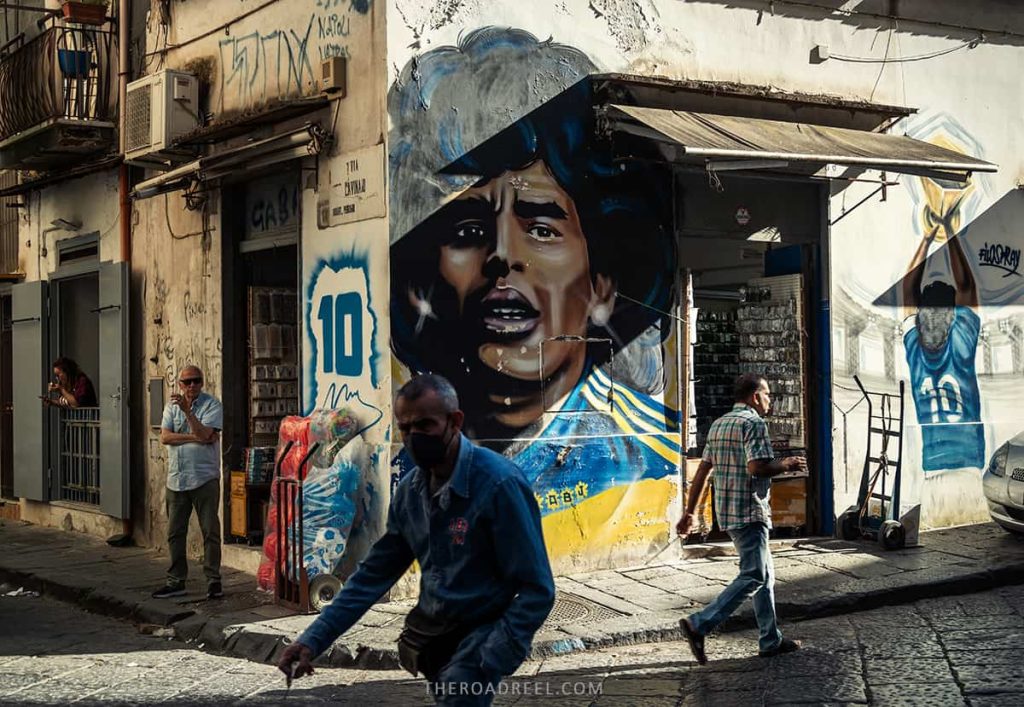
- Related article: Where to stay in Naples Italy: 10 best areas and hotels – an overview of the best Napoli neighborhoods and those to avoid, as well as accommodation suggestions.
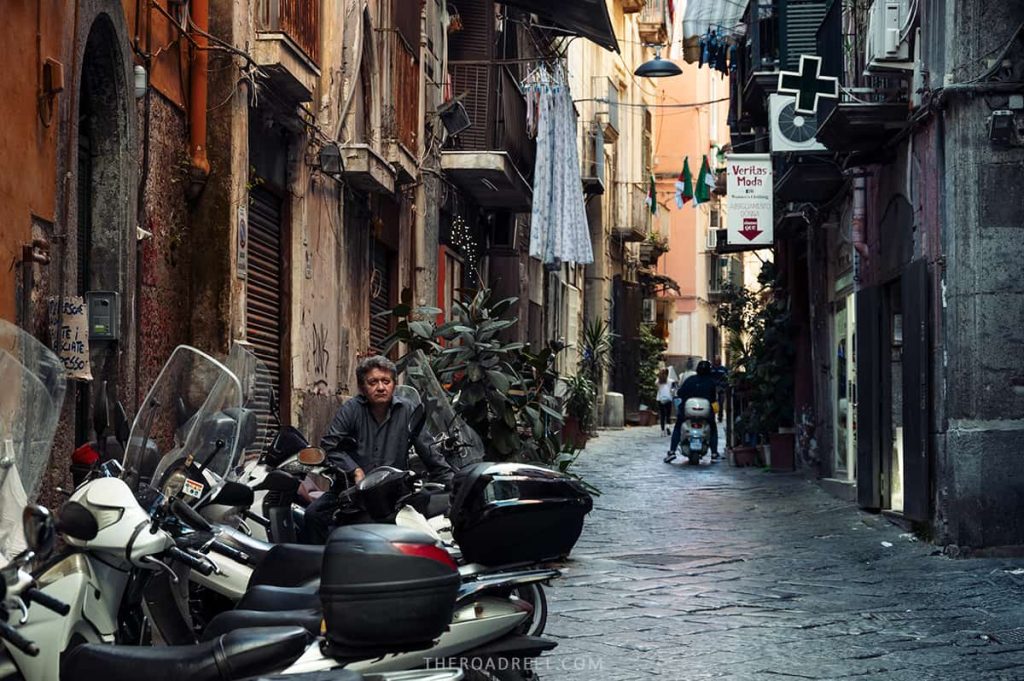
What to see in Naples in 1 day : A perfect Naples itinerary
1. coffee and breakfast at gran café gambrinus.
- Why it is special: serves the most delicious “scrambled” coffee “Caffé Gegé.
- Opening times: daily from 7 AM- 12 AM (Saturdays until 1 AM).
- Time required: 15-30 minutes, depending on how busy it is.
Every great day in Italy starts with an espresso or cappuccino accompanied by mouth-watering fresh pastry (Italian breakfast is always sweet). To kickstart your perfect one day in Naples, head to the iconic and one of the oldest cafes in town- Gran Café Gambrinus .
Once a popular meeting point for intellectuals and artists, including Oscar Wilde and Ernest Hemingway, this elegant historic 19th-century café will amaze with its Belle Epoque interior. But even more special is its artisan coffee, arguably the best coffee in all of the city .
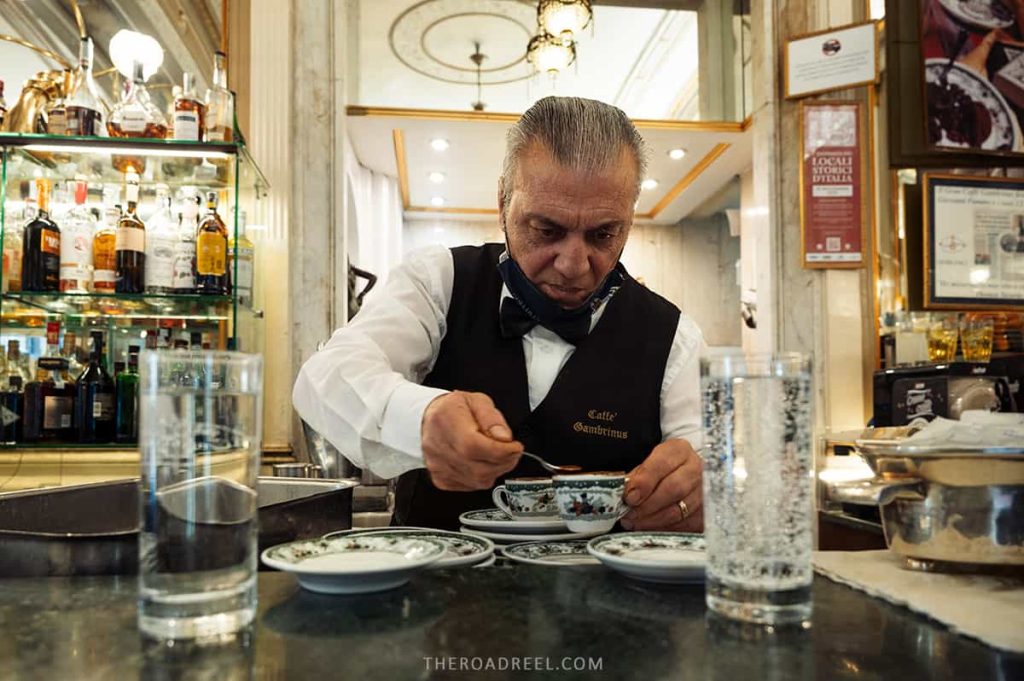
The opulent legendary café went through a turbulent life of its own. After being a pulling point for Europe’s brightest minds for many years, Café Gambrinus was shut during Mussolini’s dictatorship for promoting anti-fascist ideas. Luckily the Naci regime came to the end, café re-opened and remained one of the most popular yet authentic places in Naples .
Gran Café Gambrinus due to its international fame is a bit pricier than others. Even more, if you choose to sit at a table, it will double the bill. However, it is worth the experience.
Which coffee to order: Caffé Gegé – an espresso shot “scrambled” with cocoa and sugar. A special technique is used to prepare this sweet nutty espresso shot. Thus better have it at a bar so you can see the process. It is one of the best coffees I have ever had in my life !
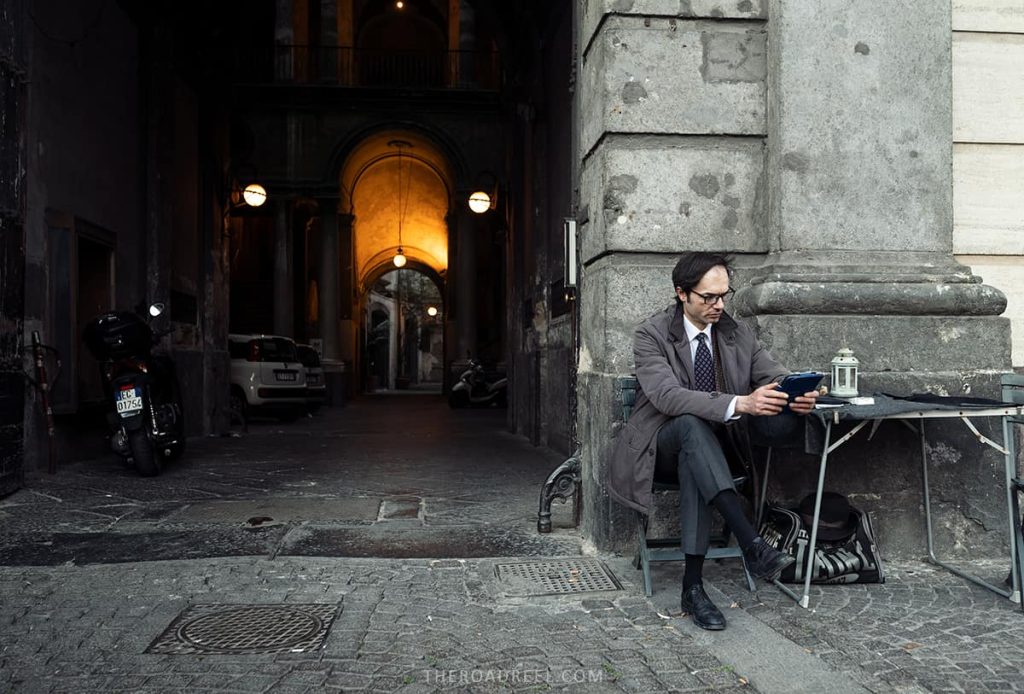
Make sure to try sfogliatella
When it comes to pastries, specific for Naples and Campania region is sfogliatella – a layered dough shell-shaped pastry filled with soft ricotta cheese- an absolute must-try.
You can either have it in Gran Café Gambrinus (will pay a bit more than elsewhere), or pick one from the stalls next to Galleria Umberto I (a few steps away).
Other notable places to taste sfogliatella are located in the historical center (which you will visit later today). Namely, Sfogliate e Sfogliatelle and Scaturchio . Nonetheless, there are countless pasticcerias in town, and you can easily be lucky to find great sfogliatellas all around Naples.
2. Piazza del Plebiscito & Basilica of San Francesco di Paolla
- Why it is special: beautiful iconic plaza and impressive basilica.
- Cost: free.
- Opening times of the Basilica: Mon – Fri 8:30 AM – 12:00 PM, 4:00 PM – 7:00 PM, Sun 8:30 AM to 12 PM.
- Time required: 15-20 minutes to look around, 30 minutes if visiting the church.
The largest and most impressive traffic-free square in Naples Piazza del Plebiscito is home to city’s most emblematic buildings. Just steps away from Gran Café Gambrinus, the main square of the city, Piazza del Plebiscito is one of the most important points of interest in Naples, and a great spot to start your sightseeing.
The impressive piazza is framed by the grandeur colonnade of San Francesco di Paolla , a 19th-century Basilica. The architecture of San Francesco di Paolla Church was inspired by Pantheon in Rome. Hence the façade looks similar, defined by a portico supported by six columns and two Ionic pillars, meanwhile, the 53-meter (173-foot) tall dome crowns a circular nave.
Today Piazza del Plebiscito and the front steps of the 34 Corinthian columns surrounding the Basicila are popular hangout spots for youngsters and street artists. Various cultural events are often taking place on the square as well.
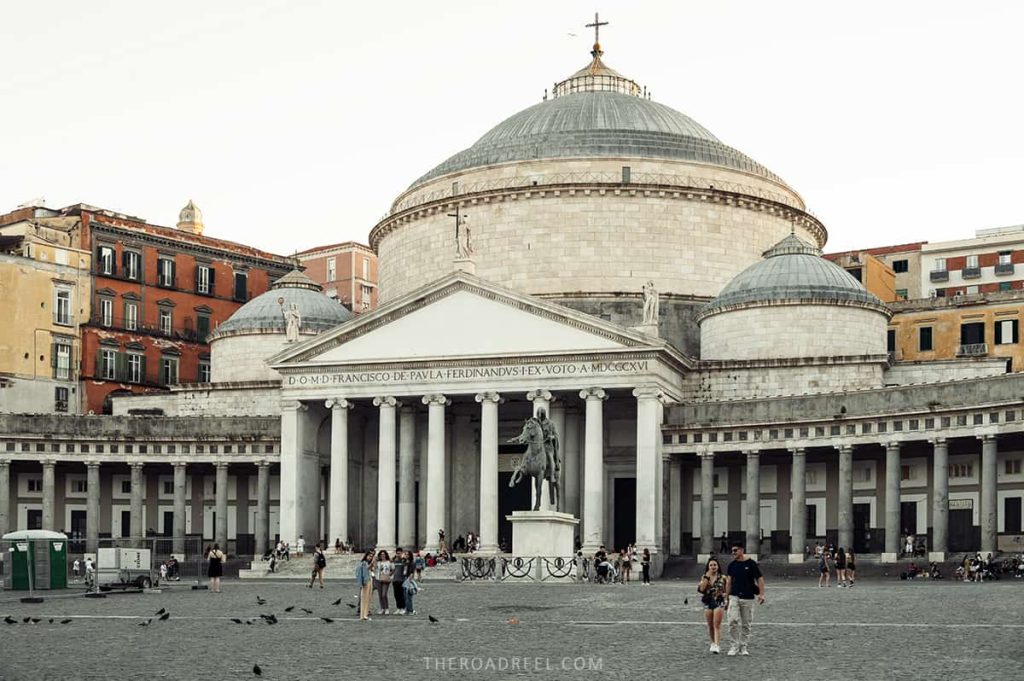
Did you know? The Piazza del Plebiscito was built from the volcanic rock of Vesuvius- the dominating natural landmark, the infamous volcano which destroyed Pompei. Also, Piazza del Plebiscito was once turned into a parking lot. This bizarre misuse of such a beautiful place lasted for over 30 years from 1960 to 1994, until it got restored to its original purpose.
Tip: If you get a chance, revisit Piazza del Plebiscito at dusk when the Basilica is illuminated – a truly magnificent sight and a completely different mood to experience.
Optional: Royal Palace of Naples
- Why it is special: historically important royal establishment with lavish interiors.
- Entrance fee: 10 EUR.
- Opening times: 9 AM- 8 PM, closed on Wednesdays.
- Time required: 1.5-2 hours.
Located opposite Piazza del Plebiscito, The Royal Palace of Naples is a symbol of royalty. It was built during the Spanish rule in the 17 th century to host King Phillip III of Spain during his visit to Naples and later continued to be used by Bourbon dynasty Kings.
Not as attractive from the outside, the Palace is splendor from the inside with all the pomposity and lavish décor expected from such an institution. It hosts over 30 immaculately preserved luxurious royal rooms representing the extravagant lifestyle of the Neapolitan royalties back in the 17th-19th century. The Palace is also a ground for Teatrino di Corte, National Library, and Teatro di San Carlo.
Since you only have 1 day in Naples, The Royal Palace might not fit into your schedule. However, if it strikes your interest, then you might have to make your visit to the palace a quick one.
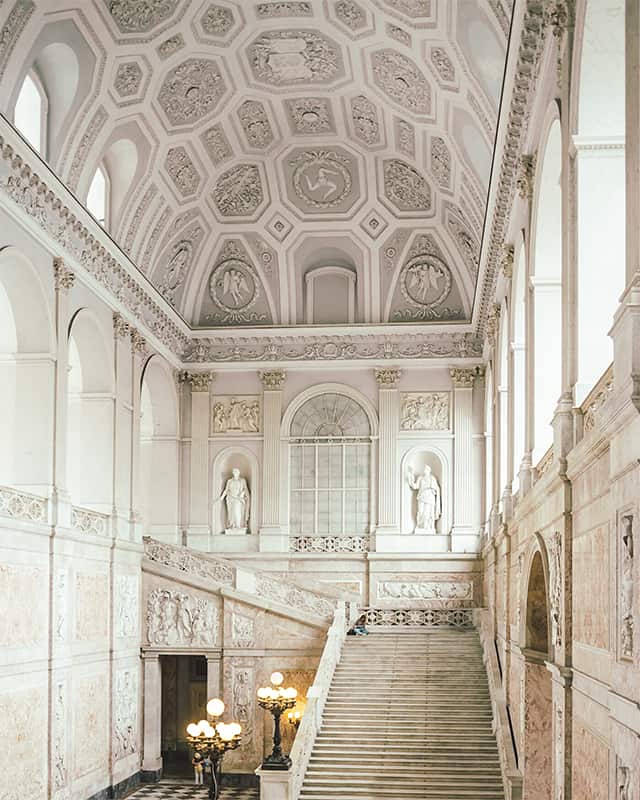
Optional: Teatro di San Carlo
- Why it is special: the oldest working theatre in the world.
- Cost: 9 EUR.
- Opening times: 10:30 to 16:30 Monday to Sunday.
- Time required: 30 minutes.
Opened in 1737, Teatro di San Carlo is the oldest working Opera venue in the world and one of the most impressive I have ever seen! It is located on the same grounds as the Royal Palace of Naples, however, it is a separate attraction that can be only visited as part of the guided tour.
A set time frame for a tour is 30 minutes only which makes it an attractive add-on to your Naples 1 day schedule.
You can book the tour in advance HERE . Tours are either in English or Italian. Note that the tour schedule revolves around the schedule of the theatre and might change if the performance or rehearsals are taking place.
3. Galleria Umberto I
- Why it is special: beautiful UNESCO-protected centuries-old shopping arcade
- Opening times: 24/7 (except for the shops)
- Time required: 10 minutes (unless you go shopping)
Before continuing to your next activity in Naples, make sure to pop into Galleria Umberto I, located just a few minutes walk from Piazza del Plebiscito.
Part of the UNESCO listing, Galleria Umberto I is one of the most beautiful shopping arcades in Europe . The grandeur of the space feels almost like stepping into a cathedral dedicated to shoppers.
Galleria Umberto I was built at the end of the 19th century, following a similar architectural style as the famous Galleria Vittorio Emanuele II in Milan (the architect of Emirates Mall in Dubai also took inspiration from these Italian shopping centers). A spacious cross-shaped passage is symmetrically framed by a Neoclassical facade and covered by a glass dome braced by iron ribs.

Named after the King of Italy at the time of construction, Galleria Umberto I has four entrances, 2 of them connecting to key areas of Napoli (Via Toledo, San Carlo Theatre). The shopping gallery used to be a lively social space and a cornerstone during risanamento – the rebuilding of Naples during Italy’s unification that lasted until WWI.
Take a peek into the Galleria Umberto I not for shopping (although you might as well) but rather for admiring absolutely gorgeous space and architecture.
4. Castel Nuovo
- Why it is special: the storybook-like castle is one of the most important landmarks in Naples.
- Entrance fee: 6 EUR.
- Opening times: Mon-Sat 8:30 AM-6 PM, Sun 10 AM- 1 PM.
- Time required: 15 minutes (longer for visiting inside).
Hard to miss is the towering Castel Nuovo (locally known as Maschio Angioino), located at the seafront in close proximity to Galleria Umberto I. This 13th-century castle, built in the Medieval Renaissance style is one of the most prominent landmarks in Naples. The five imposing towers characterize the fortress. An interesting architectural element is an ornate white marble triumphal arch connecting the western towers.
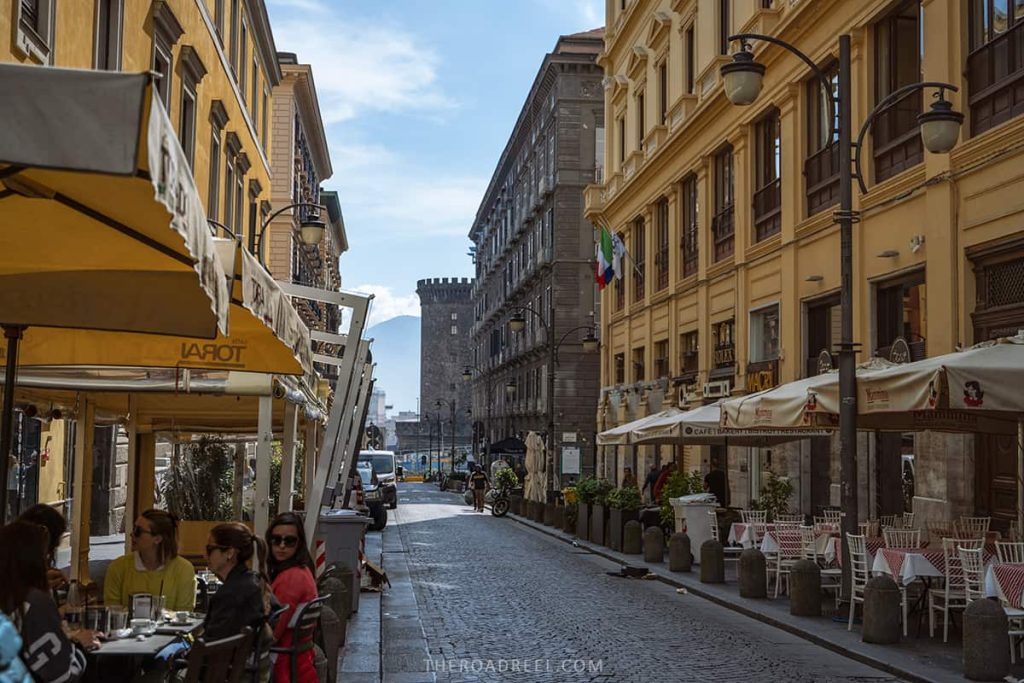
With only one day in Naples and many more exciting activities ahead, you will probably choose to admire the fortress from the distance or just stroll around its impassable walls.
Nonetheless, if curiosity brings you to explore the interior of the castle, it hosts a museum of a rich collection of paintings by Neapolitan artists, a chapel ornated with historic frescoes painted by Giotto, archaeological excavations of Roman ruins, and a hall of Barons, castle’s Throne Room which today is a space for occasional council meetings and cultural events.
5. Napoli Sotteranea- unravel secrets of underground Naples
- Why it is special: wander the tunnels and learn the shocking history of life under the ground.
- Cost: 12 EUR.
- Opening times: tours take place daily in English Monday to Friday 10 AM, 12 PM, and 4:30 PM, Saturday also has a 6 PM slot, and Sundays have additional 11 AM and 6 PM slots.
- Time required: 1.5 hours.
Some of the best places to see in Naples lay underground. I was instantly intrigued once I got to know that under the chaotic streets of Naples, there is a hidden underground city. Naples Underground was my favorite guided attraction in Naples, thus I strongly recommend you to do it!
A network of streets, tunnels, catacombs, caverns, and chambers buried 40 meters (120 feet) below the earth hold the most fascinating and unbelievable secrets and stories of life in Naples from its very beginnings from the 4 th century BC all the way to WWII.
Greeks dug underground tunnels extracting the tuff rock to build the ancient city of Neapolis. Some centuries later, Romans overtook, expanded, and utilized existing tunnels as aqueducts to supply the city with water. Two and a half millennia later the total subterranean network of streets and tunnels covers some 450 kilometers (280 miles). Rediscovered during WWII when heavily bombed Naples’ underground became a shelter to over 200000 citizens.
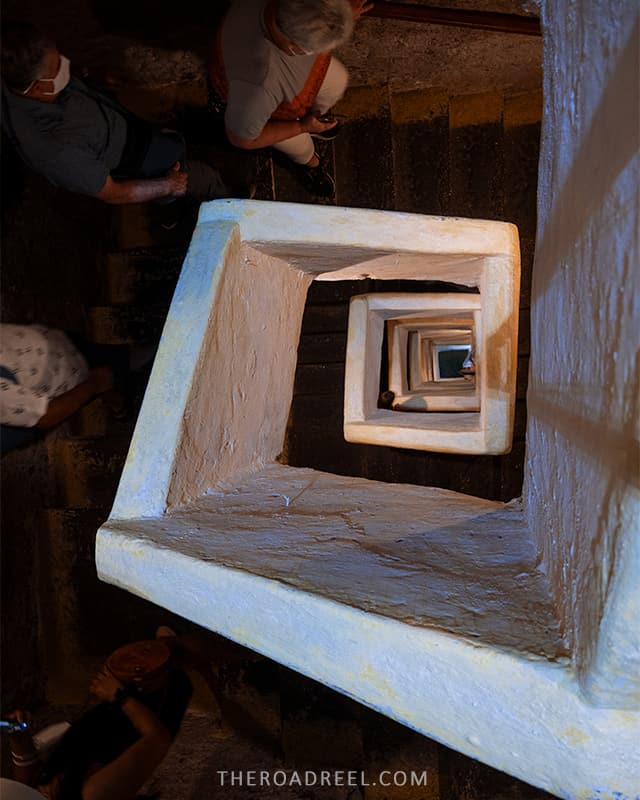
Good to know: there are several different guided underground tours in Naples that include tunnels, galleries, catacombs, and burial grounds. A couple of the tours share the same name, thus may be confusing. Those are:
- Napoli Sotterannea which starts next to Via dei Tribunali calls itself the main one but has massive groups.
- La Napoli Sotterannea starting near Piazza del Plebiscito (or Piazza Trieste e Trento to be more specific) is just as interesting and has small groups.
Other tours include visiting The Bourbon Tunnel, the Catacombs of San Gennaro, and San Gaudioso. Each of the tours is different and interesting in its own way.
If it is your first-time visiting Naples , I would suggest joining La Napoli Sotterannea tour starting near Piazza del Plebiscito which is convenient as you have already started your day in Naples here.
La Napoli Sotterannea is a captivating experience and will give you a deeper insight into the city. Also, La Napoli Sotterannea tour has much smaller groups than the “main” one that starts near Via dei Tribunali.
More about La Napoli Sotterannea tour
By descending over 100 steps into the belly of Naples, and wandering through dark tunnels lit with just a dim torch and candles, our guide was telling the most unbelievable things about how people survived living underground. It was difficult to wrap my head around what it was like to live without natural light 40 meters under the ground for at least a couple of years.
The guide told us stories of people living full lives just as above the ground- going about their daily routines, getting married, delivering babies, and dying.
Important: visiting Naples’s underground involves walking through some really narrow and dark tunnels. Although there are alternative ways to access certain areas if you are uncomfortable with tight spaces. Note also that there are a lot of steps descending to the underground and then ascending back above ground.
IMPORTANT! Naples Underground tours are one of the most popular activities in Naples, thus get the ticket in advance for the time you prefer to visit.
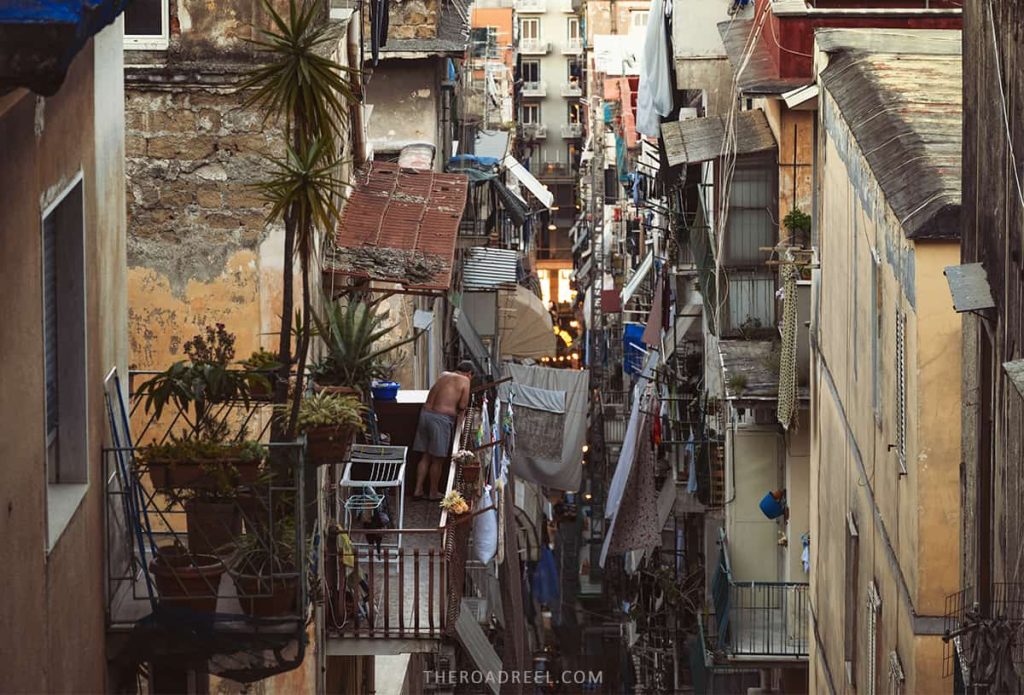
6. Quartieri Spagnioli neighborhood and Maradona Mural
- Why it is special: cinematic Napoli atmosphere, artistic murals including one for Maradona.
- Opening times: 24/7
- Time required: 30 minutes, or as much as you want to explore the streets.
You will finish Naples’s underground tour within walking distance to Quartieri Spagnoli (Spanish Quarters). Quartieri Spagnoli is one of the most photogenic atmospheric districts in Naples not to be missed.
A place where the sun struggles to squeeze between narrow streets that cut through the tall buildings interconnected by lanes of laundry fluttering in the breeze. You have most likely seen street photography of what is known as typical Naples- Quartieri Spangoli is where you find this ugly beauty and more.
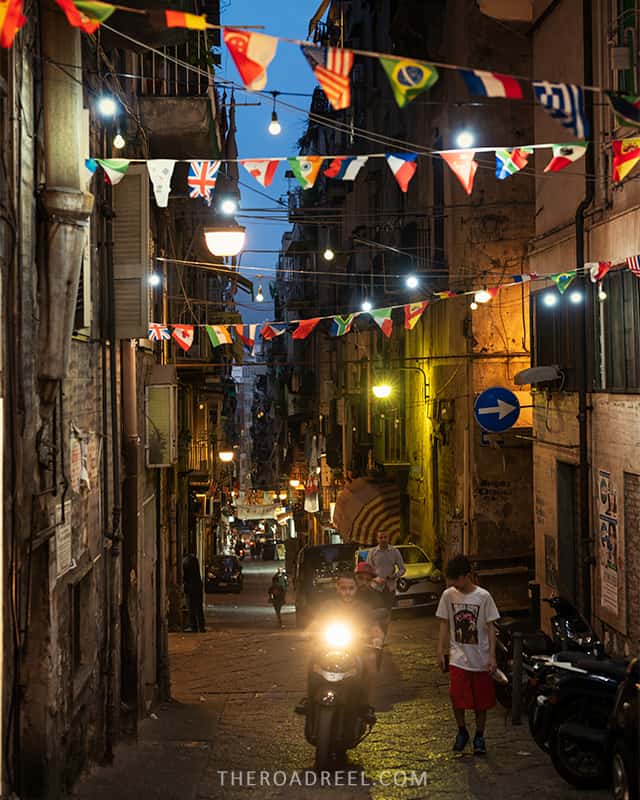
Noisy and full of life, extra chaotic in a chaotic city Spanish Quarters represents the darkest corners of the soul of Naples. It used to be an area to avoid but today it is relatively safe to wander for the outside visitors (avoid walking there after midnight).
The history of the Quartieri Spagnoli stretches back to the Spanish occupation in the 16th century. The quarter used to be a base for Spanish soldiers who lead an unorthodox way of life. Naturally, the area eventually gained a reputation as a hub of prostitution, crime, and drugs.
Today, Spanish Quarters is the most densely populated area where working-class Neapolitans live. You can sense that it is a place of struggle. Unsavory activities are still taking place but not at the scale they used to.
The Quartieri Spagnoli is being re-evaluated and adopted as a trendy spot to go out for a drink and dinner.
The street artists use the crumbling walls of the Spanish Quarter as a canvas for expressive murals. The most notable and must-visit in Naples on your one-day trip is Armando Diego Maradona mural located in Via Emanuele de Deo.
- Related article: Is Naples safe?
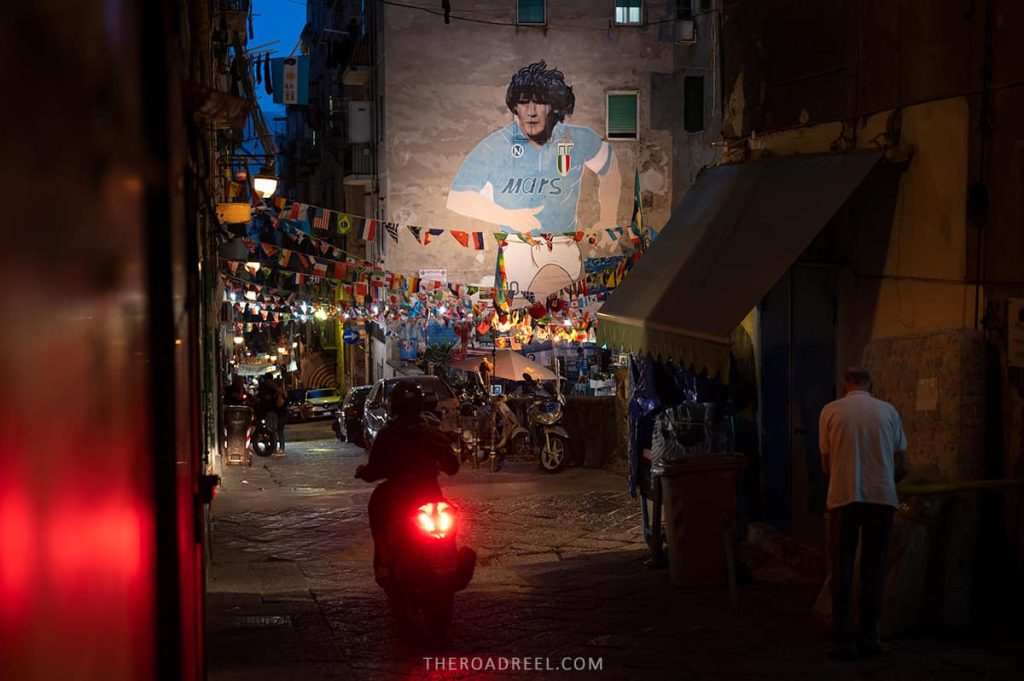
Under the enormous painting occupying the whole wall of the building, you will also find a “shrine” dedicated to the legendary player, a souvenir stall selling Maradona and football-related artifacts (t-shirts, mugs, scarfs, etc.), and a bar to sit down and have a drink.
Moreover, keep an eye out for surrealistic grotesque murals by Cyop&Kaf- my favorite streets arts to hunt while walking around the Quartieri Spagnoli. The mind-bending paintings decorate forgotten gates, balconies & windows, and other unexpected corners of the Spanish Quarter.
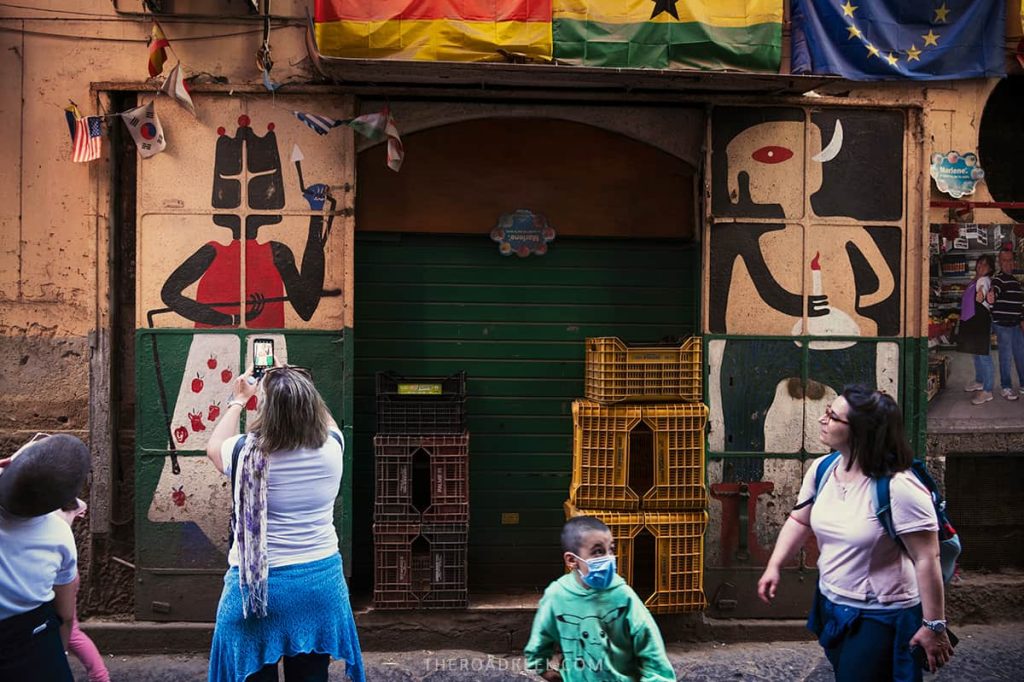
Centro Storico (Historical Center)
During your second part of the day in Naples, you will head for lunch to the oldest pizzeria in Naples and then continue to explore Centro Storico – the historical center of Naples.
Did you know? The whole Naples historical center is included in UNESCO’s World Heritage Site list. In Centro Storico, you will find some of the most important piazzas, and buildings, including the most beautiful churches, historical monuments, palaces, and also iconic street of Via Tribunali as well as a so-called Naples “splitter” Spacanopoli.
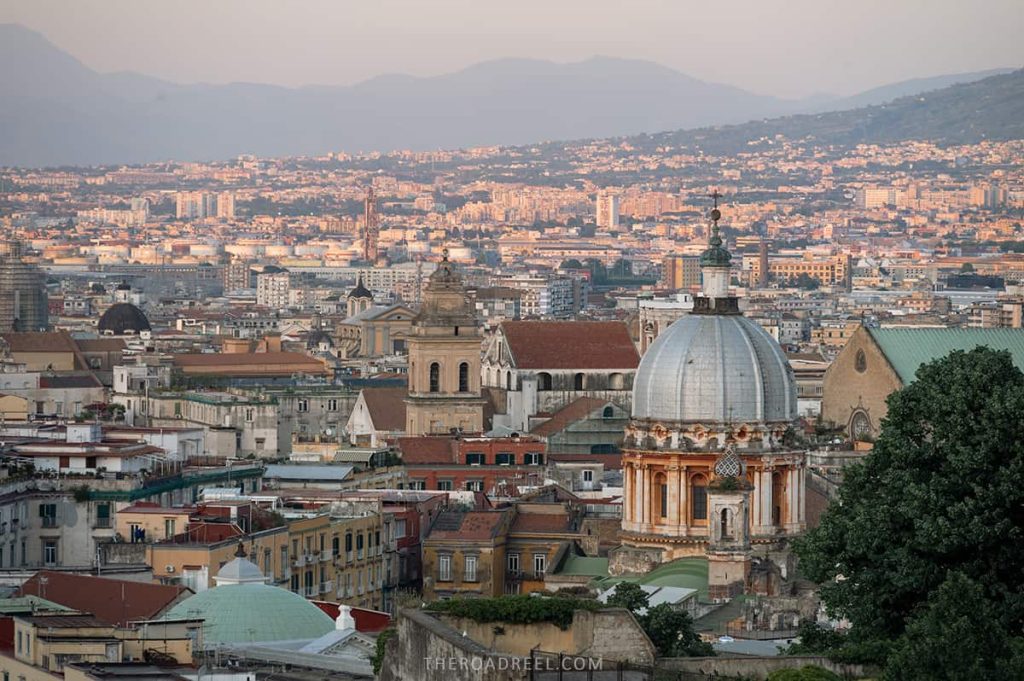
7. Via Toledo
- Why it is special: main commercial street, beautiful Toledo metro station.
- Opening times: 24/7.
- Time required: 10 minutes or longer if you are strolling all length.
From Quartieri Spagnioli head towards Via Toledo- one of the main arteries and the principal commercial street in Naples. You cannot avoid it and must pass on your way to the historic center. It is a street of madness always crowded with people rushing in all directions.
On via Todelo continue walking north towards Dante square which is around 15 minutes away from Spanish Quarter. Or, if you are keen to see one of the most beautiful metro stations in Europe, go down to Toledo metro station which looks like an underwater world. In order to see it, you must purchase a ticket (1.1 EUR). Ride for 1 stop from Toledo to Dante metro station.
Good to know: whilst Google maps currently show the street as Via Toledo to locals it is known as Via Roma.
8. Lunch at the oldest Pizzeria in Naples
- Why it is special: one of the best pizzas in Naples at the oldest pizzeria.
- Cost: pizzas are priced at 10-12 euros on average.
- Opening times: daily 12–4:30 PM, 6:30 PM–12 AM.
- Time required: 1 hour if there is no queue for the table (you can also do a takeaway).
From Piazza Dante , which is one of the significant plazas in Naples, symbolizing the former grandeur of the city and holding a large monument for Italy’s greatest writer and philosopher Dante Alighieri, continue towards Port’ Alba archway . You will pass an atmospheric street of Via Port’Alba known for its many old bookstores.

Antica Pizzeria Port Alba , which is widely believed to be the oldest pizzeria not only in Naples but also in the world , will be on your right with some outdoor sitting places on the left, just right under the arch. This pizzeria started as a stand for peddlers in 1738. A century later, in 1830, the pizzeria finally moved under the roof and until today is in operation under the name of Antica Pizzeria Port Alba.
Fun fact: pizzeria used to have a payment system pizza a otto which allowed customers to pay for their order within 8 days- something like an installment plan but without the interest rate. It was not because pizza was expensive back in the day. Quite the opposite, it was one of the cheapest and simplest meals. However, the main customers were students and artists who, as cliché as it sounds, never had enough money.
Opinion: Out of 5 different pizzerias we tried (all were famous names, highly recommended online and by locals), Antica Pizzeria Port Alba pizzeria was our favorite one.
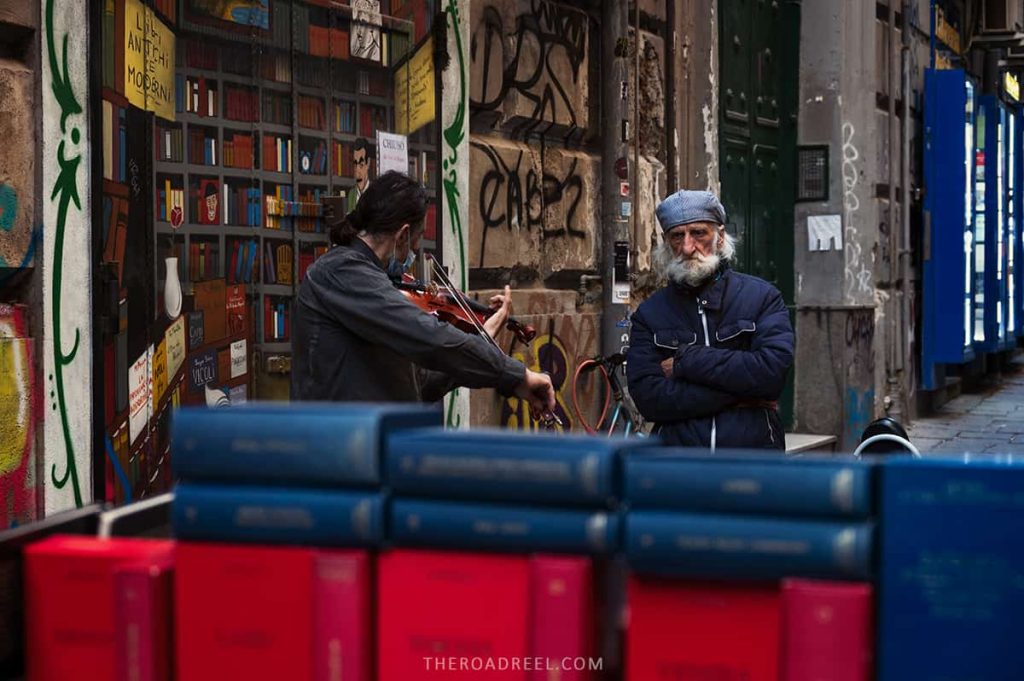
9. Chiesa Ges ù Nuov o
- Why it is special: one of the most beautiful churches in Naples.
- Entrance: free.
- Opening times: daily 8 AM- 1 PM, 4 PM- 7:30 PM.
- Time required: 15-20 minutes.
Once you have your stomach satisfied with one of the best pizzas in Naples, be ready to discover more wonderful sights on your one day in Naples. The first one on the afternoon list, Chiesa Ges ù Nuovo church is located only one minute’s walk from the Antica Pizzeria Port Alba.
Chiesa Ges ù Nuovo (New Jesus Church) is one of the best places to visit in Naples. Chiesa Ges ù Nuovo is located in Piazza Ges ù Nuovo- a pretty Baroque square in the heart of Naples.
The facade of Chiesa Ges ù Nuovo clearly lacks the opulence common to many Italian churches. Interestingly, if you have ever been to Portugal , the walls dotted with small stone pyramids are reminiscing of the Casa dos Bicos building in Lisbon .
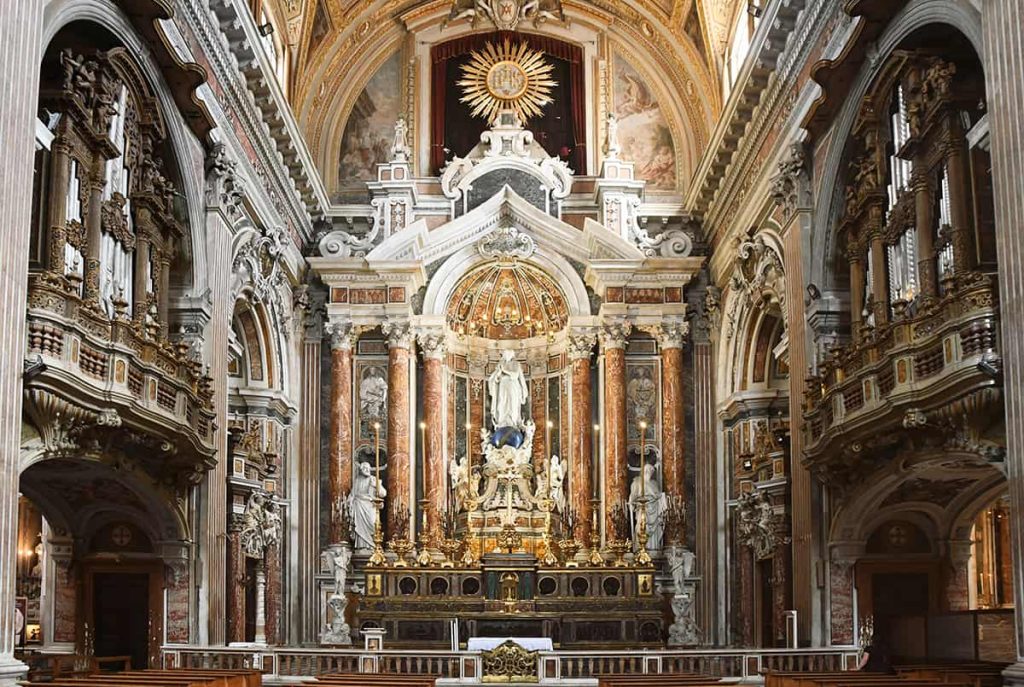
However, what it lacks from the outside, Chiesa Gesù Nuovo church generously compensates with its interiors. The church is known to have some of the largest concentrations of Baroque paintings and sculptures. As expected from the ornate and opulent Baroque style- the detailing of the interiors is taken to the extreme. What makes me fascinated the most is that the overwhelming amount of décor seems absolutely harmonious- all the smallest details here have a dedicated place and nothing is redundant.
Tip: In your Naples 1 day itinerary, you must visit at least one church. From all of the hundreds of churches in Naples, make sure to take a peek inside this one.
10. Santa Chiara Monastery Complex
- Why it is special: famous majolica tiles, frescoes, and shaded escape from the street chaos.
- Entrance fee: 6 EUR, discounted to 4.5 EUR for students and seniors 65+.
- Opening times: Mon-Sat 9:30 AM-5:30 PM, Sun 10 AM-2:30 PM.
- Time required: 30-60 minutes.
Just a few steps away across the street you will continue to Santa Chiara, one of the top things to see in Naples Italy in one day. Santa Chiara religious complex built in the 14th century features a Gothic-style church (in contrast to the predominant Baroque architecture seen all around Naples).
However, what is the most attractive about the monastery complex is the impressive cloisters decorated with beautiful 17th-century frescoes depicting scenes from the Old Testament, and the colorful majolica tiles.
The inner garden filled with lemon trees is photo perfect shaded escape from the noisy Naples streets. Note though, that if you are visiting in the afternoon, the complex might be busy with visitors. Santa Chiara once a hidden gem now is a popular attraction.
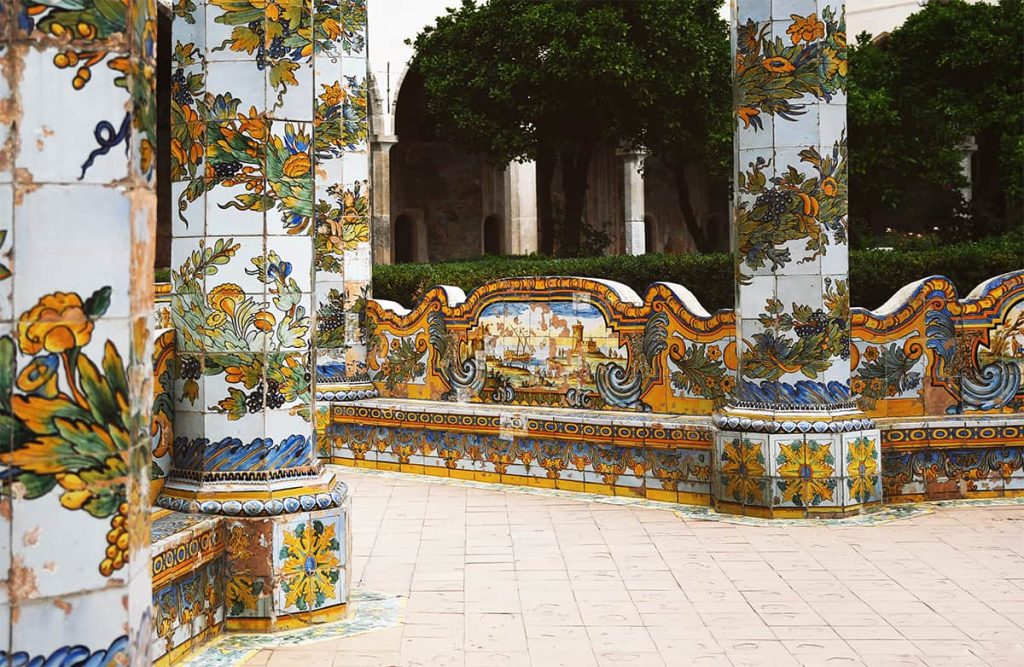
Optional: The Veiled Christ at Sansevero Chapel
- Why it is special: sculpture masterpieces displayed inside an intimate chapel
- Cost: 8 euros (+ 2 euros booking fee).
- Opening times: daily, except Tuesdays, 9 AM- 7 PM.
If you are an appreciator of art and sculpture, then on your day in Naples you should add a visit to Sansevero Chapel Museum- home to the famous masterpiece of The Veiled Christ sculpted by Giuseppe Sanmartino in 1753.
Depicting the deceased figure of Jesus Chris covered in a transparent death veil, the sculpture is an example of the finest craftsmanship. The delicate fabric carved out of one piece of marble looks hyper-realistic. The folds and creases are so precise, combined with the mysterious lighting make The Veil of Christ a sight to behold.
The museum is located in a converted space of a petite chapel. Note that Sansevero Chapel is one of the most visited attractions in Naples and can host a limited number of people a day. Thus, pre-booking tickets even a few weeks in advance is strongly recommended.
There is also a highly rated guided tour which is a great opportunity to learn more about the historical center of Naples along with a visit to see The Veiled Christ.
11. Spaccanopoli- the Naples splitter
- Why it is special: a set of streets “splitting” Naples downtown into half.
- Time required: around 15 minutes, but really as much or as little as you wish.
Spaccanopoli is one the city’s most famous thoroughfares not to be missed during your one day in Naples. Spaccanopoli is a combination of several narrow streets seamlessly flowing into one another while cutting through the historical center and “splitting” the city of Naples into two. Hence, the name “Naples’s splitter”.
The total length of Spaccanopoli is about 2 kilometers. Starting from Piazza Gesù Nuovo it stretches as a dead-straight line all the way east until it crosses Via Duomo and continues for a little bit beyond Centro Storico.
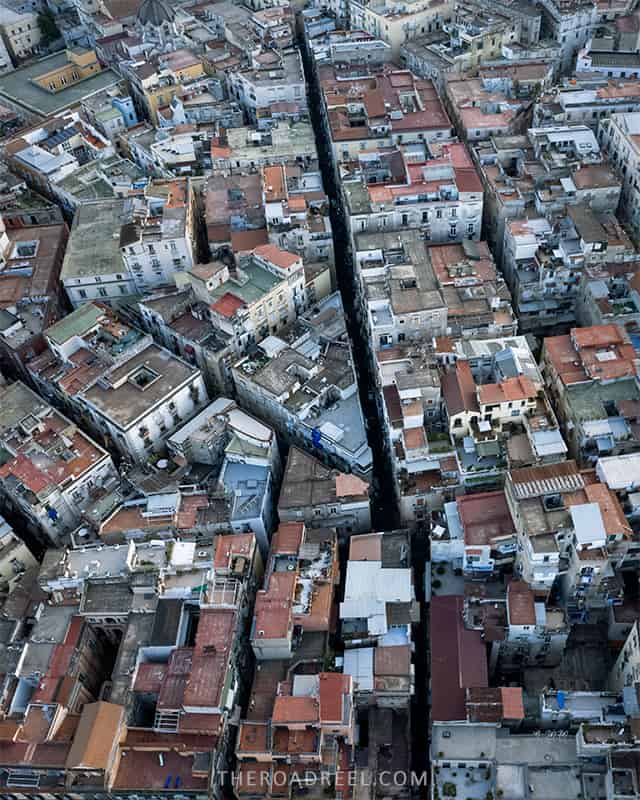
Good to know: you won’t find Spaccanopoli as a street name on Google Maps (try and see it yourself- it is just a pinpoint). To be precise, Piazza Ges ù Nuovo, Via Benedetto Croce, Via Pasquale Scura, Via Maddaloni, via Domenico Capitelli, Piazzetta Nilo, and Via San Biagio Dei Librai, are the “components” of Spaccanopoli.
Spaccanopoli’s roots date back to Roman-Greco times. It used to be one of the 3 decumani (one of the main east-west streets) on the ancient Neapolis city grid.
Today’s Spaccanopoli is the invisible vein of the city constantly pumping with life. Lined with countless cafes, tavernas, pizzerias, souvenir shops, boutiques, and a number of important historical monuments in between (Sansevero Chapel, Gesù Nuovo Church, and Santa Chiara complex), Spaccanopoli falls on, or better said, makes an ultra-busy tourist route in Naples.
Yet, it is a perfect place to soak in the chaotic Naples’ atmosphere and wander in and out of many connecting alleyways.
12. Via San Gregorio Armeno- the street of nativity scenes of Naples
- Why it is special: the most characteristic street in the historical center is known for nativity figurines.
- Opening times: 24/7 (except shops).
- Time required: 10-15 minutes.
Talking about alleyways and side streets branching in and out of Spaccanopoli, Via San Gregorio Armeno is one of the top places to visit in Naples. Also known as Christmass Street, this short quirky lane is dotted with quaint old shops the windows of which along with the street stalls are filled with various figurines of nativity scenes ( Presepe or presipio ).
The presipio decorations are taken seriously in Italy- it is a more important attribute of Christmas than any lavishly dressed Christmas tree. To understand the craze behind those displays, one must look back to thousands of years of history that lead to a strong Italian tradition.

Via San Gregorio Armenio once used to be home to a temple for Roman Goddess Ceres. As a sign of devotion, the worshipers of the Goddess used to bring small terracotta figurines crafted in local artisan workshops. Eventually, when Christianity came into play, the figurines adopted a Christian appearance and became an important tradition all across Italy, but even more so in Naples.
Did you know that? The best nativity scenes in Italy makers are, in fact, based in Naples. Neapolitans treat presipio as a form of art and are also taking it to another level. Usually, nativity scenes revolve around the Bethlehem theme. However, in Naples , presepe features many elements of daily life.
That being said, in Via San Gregorio Armeno, you will find many different scenes and even figurines of characters of the current era (including celebrities).

Tip: If you got hooked on the nativity scenes and want to dive deeper, take note of the Museo Nazionale di San Martino in Naples which hosts the staggering Cuciniello Nativity- one of the most famous presepi artworks . The museum is located on the grounds of Castel sant’Elmo which you will visit later today.
Sweet tip: one of the above-mentioned famous pastry shops Sfogliate e Sfogliatelle is located in Via San Gregorio Armenio. Thus, do not miss it if you have not tried sfogliatelle yet or want to sample another one while in Naples.
Optional: Cloister of San Gregorio Armeno (Chiostro di San Gregorio Armeno)
- Why it is special: off the beaten path serene and beautiful cloister.
- Entrance fee: 4 EUR, cash only.
- Opening times: 9:30 AM–1 PM, 4–6 PM Mon-Fri, 10 AM–1 PM, 3–7 PM Sat-Sun.
- Time required: 30-45 minutes.
I discovered this hidden gem in the middle of the chaos by a lucky coincidence. A smaller alternative to the famous Santa Chiara complex, the cloister of San Gregorio Armeno (Chiostro di San Gregorio Armeno) offers a tranquil escape from the madness of Naples streets.
The 16-th century richly ornamented monastic complex features a cloister of dazzling beauty, a lemon tree garden, and a medieval chapel. You can also visit the functional refectory of abbess Violante Pignatelli.
Tip: The entrance to San Gregorio Armeno cloister is not obvious-look for Vico Giuseppe Mattei street on the map.
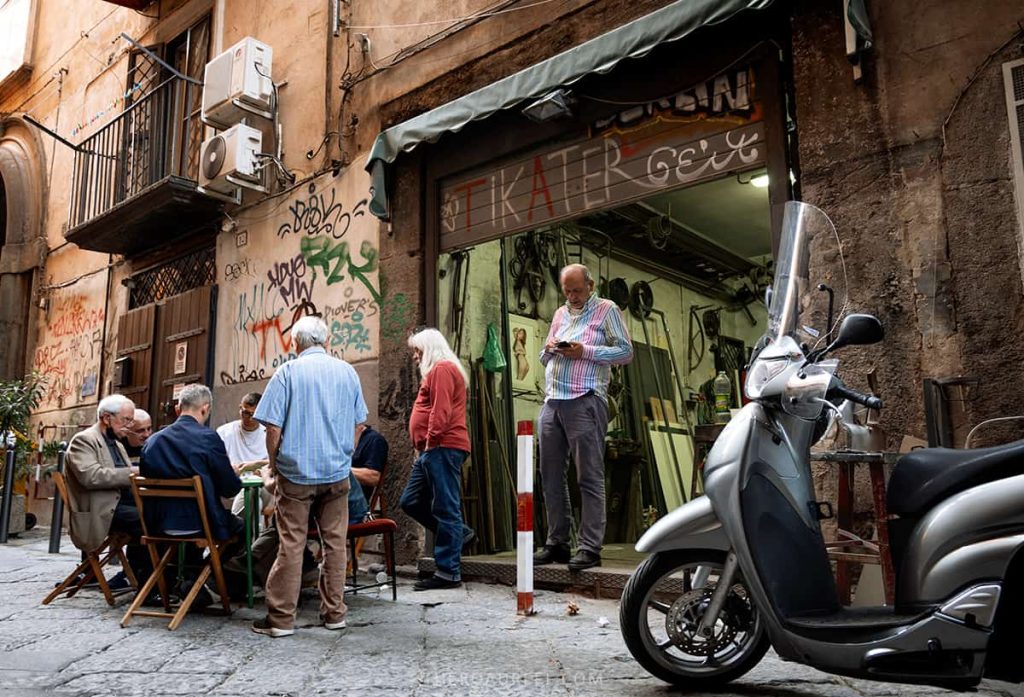
13. Via dei Tribunali
- Why it is special: iconic street known as pizza street is full of life.
- Time required: 30 minutes or longer if you stay for another pizza or a drink.
An unmissable on any Naples itinerary, Via dei Tribunali is a decumanus major (east-west oriented main road) following the ancient Greek-Roman axis. Also known as pizza street , Via dei Tribunali is one of the most important avenues in Naples.
It is lined with a number of historical monuments (Naples Cathedral and San Lorenzo Maggiore Basilica amongst them), crumbling houses that once used to be palaces, and a countless number of places to eat and drink.
Running parallel to Spaccanopoli, Via dei Tribunalli can be also reached from Via San Gregorio Armeno.
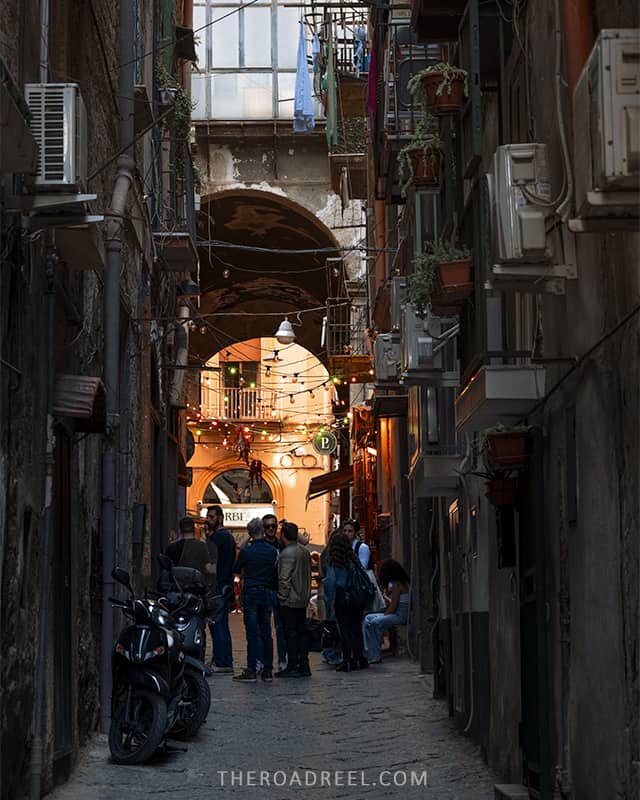
The lively and never sleeping ages old street, Via dei Tribunali, is where you can see the Napoli of Elena Ferrante (renowned Italian writer of bestselling Neapolitan novels). At a glance narrow-cobbled street handles more than its size has been made for: continuous chaotic movement of not only people but also scooters and even cars (watch out), also street vendors, coffee shops, and restaurants.

Busto di Pulcinella
Do not miss Busto di Pulcinella- a famous bronze sculpture depicting a classical Neapolitan puppetry character created in commedia dell’arte.
Pulcinella embodies the Neapolitan plebs- an ordinary man who belongs to the lowest social class, always struggling but manages to hustle and sort his problems with a smile.
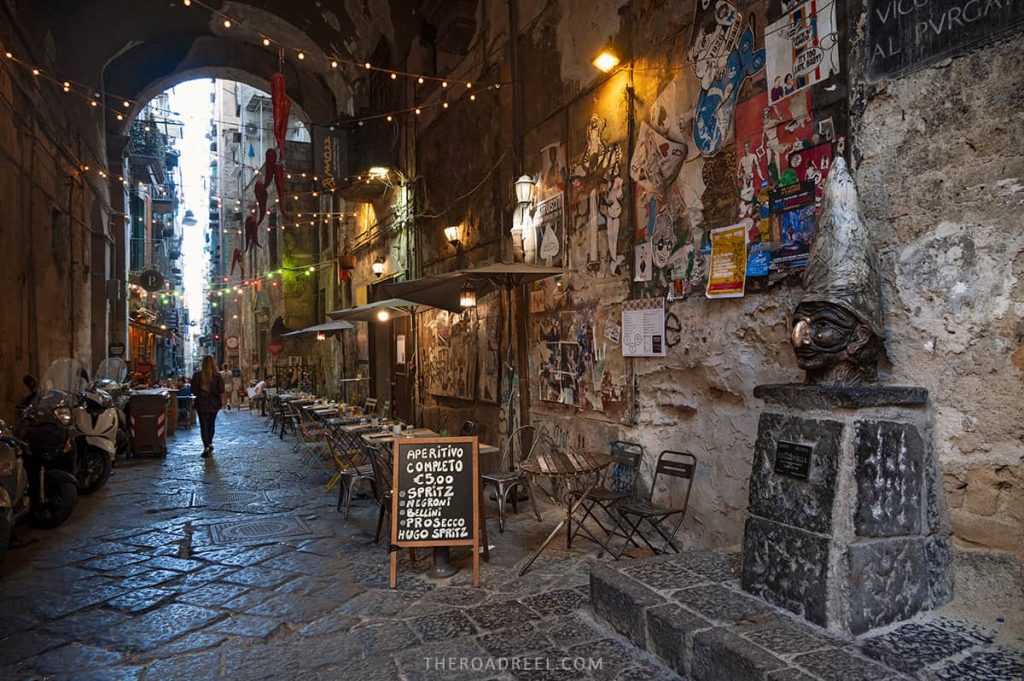
Placed at the corner of Vico del Fico al Purgatorio, the Busto di Pulcinella is locally believed to bring luck if you rub his nose. You can see that rarely anyone will miss their chance to get some extra luck. The nose of the sculpture has been rubbed quite a bit and acquired a golden shade compared to the rest of the face which has bronze patination.
14. Try another pizza at one of the famous pizzerias
In the birthplace of pizza, set your goal to try as many different pizzas as you can. And do not worry, the walking you do on your day in Naples is enough to burn all those carbs. We managed to try pizzas at 4 different pizzerias on the same day!
In Via dei Tribunali, you will find the famous Pizzeria Antonio e Gigi Sorbillo . The waiting time to get a seat can be around 1-1.5 hours. Thus, having only one day in Naples, you may not want to spend your precious time in a long queue and may consider getting a great pizza at another quite well-known Pizzeria dal Presidente (named after Bill Clinton’s visit). It is located just a couple of hundred meters down the same Via dei Tribunali street. During the time of our visit, we were lucky to ditch the queue and tried pizzas at both places. To me, Gigi Sorbillo’s pizza tasted better.
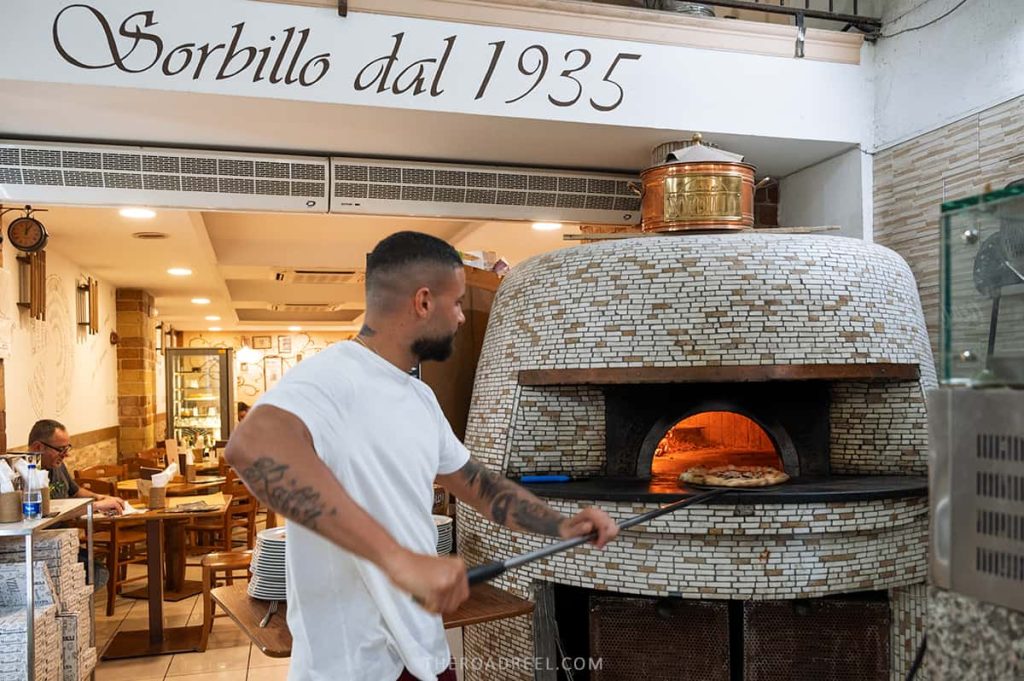
A must to mention is L’Antica Pizzeria da Michelle , which is 10-minute walk southeast of Via dei Tribunali. This is possibly THE MOST FAMOUS PIZZERIA in Naples because it was a set scene for Juliet Roberts movie “Eat, Pray, Love”. Regardless of the fame, prices in L’Antica Pizzeria da Michelle are some of the lowest (pizza costs around 5 euros).
Queues to get a seat inside the restaurant, however, are enormous. Expect to wait up to 2 hours. However, take away is a good time-saver. After waiting for less than 30 minutes, you will get to try one of the best pizzas in Naples. Note that only two types (marinara and margherita) of pizzas are served there, making it an easy choice. Make sure to try both (they are pretty small)!
Optional: Naples Cathedral (and Capella San Gennaro)
- Why it is special: the largest and most important church in Naples.
- Opening times: 8 AM–2:30 PM, 4:30–7:30 PM Mon-Fri, 8 AM–1:30 PM, 4:30–7:30 PM Sat-Sun
While strolling Via dei Tribunalli you may pop your head in Naples Cathedral ( Cattedrale di Santa Maria Assunta ), also known as Duomo- the largest church and the seat of the Archbishop. The Neo-Gothic exteriors of Naples Cathedral are elegant but rather minimalistic in comparison to more ornate Baroque facades seen around the city. Yet the interior is more awe-inspiring combining styles of three different eras- Gothic, Neo-Gothic, and Baroque.
Did you know? There is a mystery item secured inside the Chapel of San Gennaro- the vial of the blood of Saint Januarius (San Gennaro is the patron saint of Naples). It is said that the blood liquefies during specific festivities which take place 3 times a year. If the blood stays solid during the special day, it means a disastrous time is awaiting Naples.
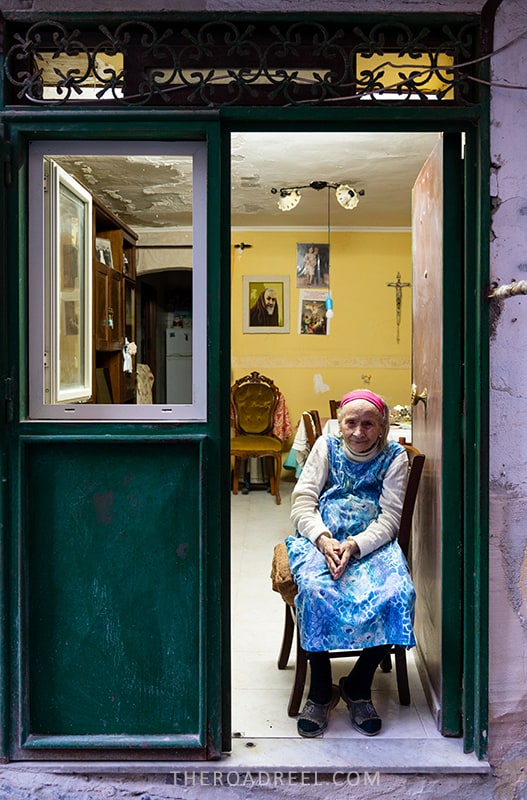
15. Catch the sunset and the panoramic views of Naples from Castel Sant’Elmo
- Why it is special: absolutely stunning panoramic views over Naples Bay and Centro Storico.
- Cost: 2.5 euros to enter the castle, but views can be seen free from the Belvedere San Martino viewpoint.
- Opening times: 8:30 AM-7:30 PM (last admission 6:30 PM).
- Time required: 1 hour to visit the castle and 15-30 minutes to come up (depending if you walk or take a funicular), and a similar time to come back down to the city center. Budget 2 hours for this attraction in Naples.
So far, you have explored two layers of Naples-the underground and the ground level. A highlight on your one-day in Naples itinerary that also makes it complete is observing the city from a high vantage point.
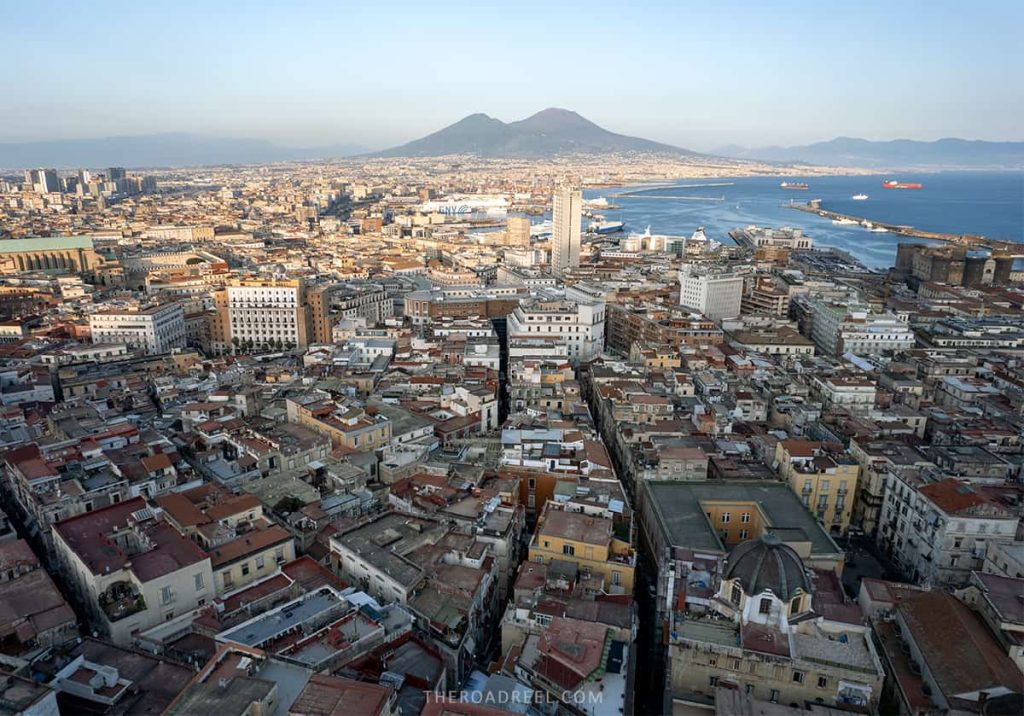
That being said, the best time to see the Naples skyline is during the golden hour following dusk. For that matter, the best place to watch the sunset with the golden light painting over the Napoli cityscape is from Castel Sant’Elmo, a medieval fortress located on top of the Vomero hill in Vomero district.
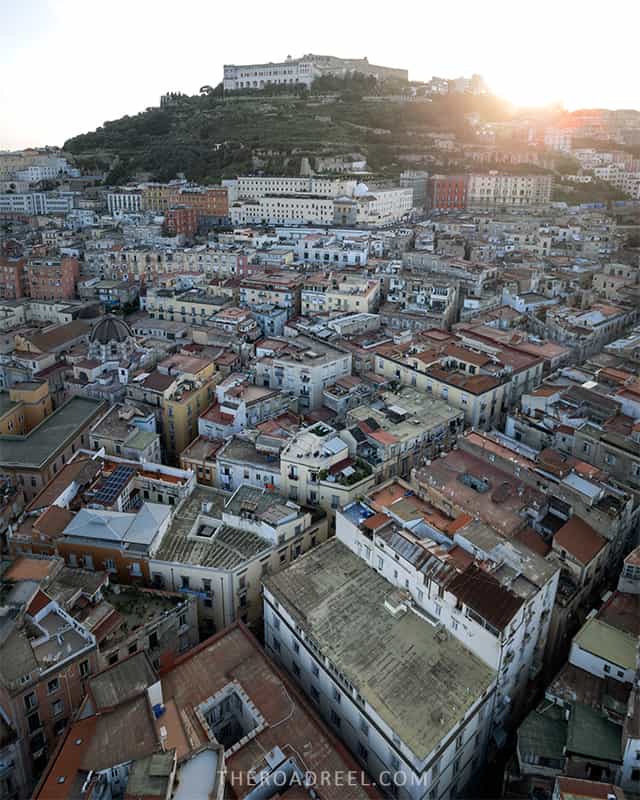
Holding the commanding position, Castel Sant’Elmo overlooks the Bay of Naples, including the historic center, also Sorrento Peninsula, and its majesty Mount Vesuvius. The utterly splendid 360-degree views over Naples can be observed from the walls of the fortress.
The hexagonal star in shape, Castel San’Elmo fortress is quite impressive due to its enormousness, and apart from being a popular tourist attraction in Naples, it also acts as the headquarters of the museum network of Campania.
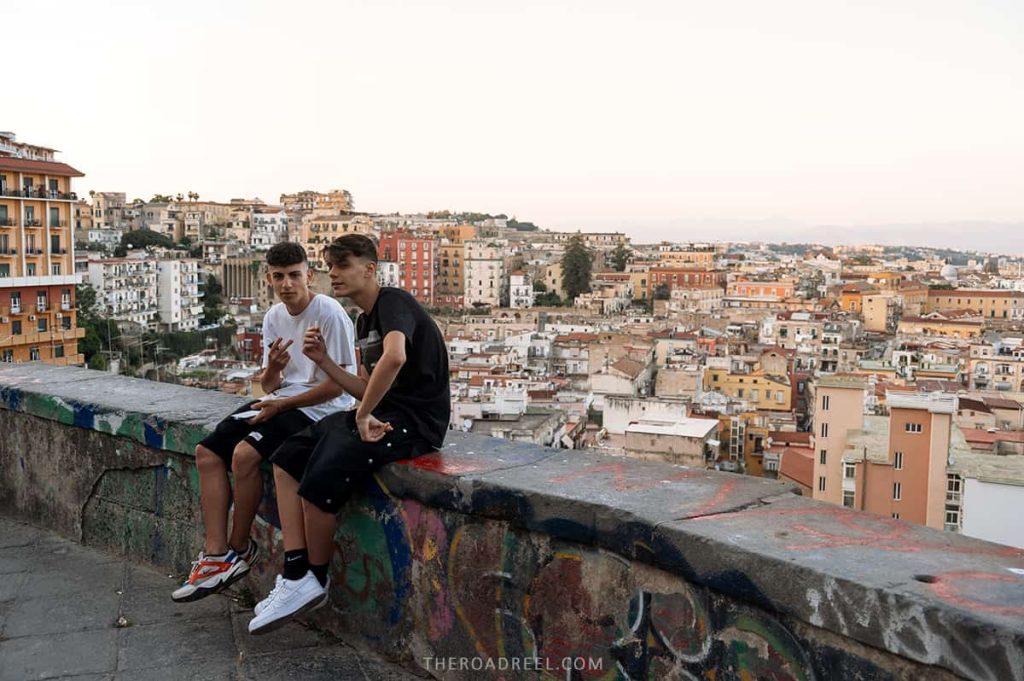
Don’t miss: located under the walls of the castle, the Belvedere San Martino viewpoint , although not the highest and not as expansive as the one from the castle, offers an equally impressive panoramic view of the entire Centro Storico and beyond.
How to get to Castelo Sant’Elmo
You have two options to get to Sant’Elmo castle in Naples:
- on foot – it is a tough yet rewarding climb from the old town. With every step up, you will see emerging panoramic views opening up. It takes around 20-30 minutes to come up, depending on where you are walking from;
- take a funicular from Montesanto station to Morghen station in the upmarket Vomero district. From Piazza Dante to Montesanto Funicular station it is only 6 minutes walk. The funicular ride is less than 10 minutes and once you come out, it is only a few minutes walk to the entrance of the castle.

Optional: San Martino Monastery Complex (only if time permits)
- Entry fee: 6 EUR, and 2 EUR reduced rate.
- Opening times: Thu – Tue 8:30 AM – 4 PM, closed on Wednesdays.
Adjacent to the castle Sant’Elmo (or just below it), San Martino Monastery Complex (Certosa di San Martino in Italian) is an amazing place to visit. Yet you should consider the time you have as the museum is huge and may require another hour in your already busy one day in Naples.
Apart from the museum which hosts numerous paintings and statues, as well earlier mentioned famous Cuciniello Nativity scene, the highlight of the complex are the courtyard gardens and cloister of “Il Chiosto Grande” as well as the beautiful chapel.
Good to know: if you have more time in Naples, the Vomero district is also worth exploring. Piazza Vanvitelli is where the action is happening- a center point of Vomero where many coffee shops, boutiques, and restaurants are located. It is an upscale trendy area perfect to chill out for a couple of hours.
16. Have late night dinner in Spanish Quarters
Some of the best pizzerias and trattorias can be found in Spanish Quarters along with many bars where you can sip Aperol spritz for as little as 2 euros.
Also, at night, Spanish Quarters have a completely different atmosphere. The dodgy side of the infamous quarters gets emphasized through dimmed street lights. Nonetheless, it is a popular hangout spot, and not like back in the day, is perfectly safe for tourists .
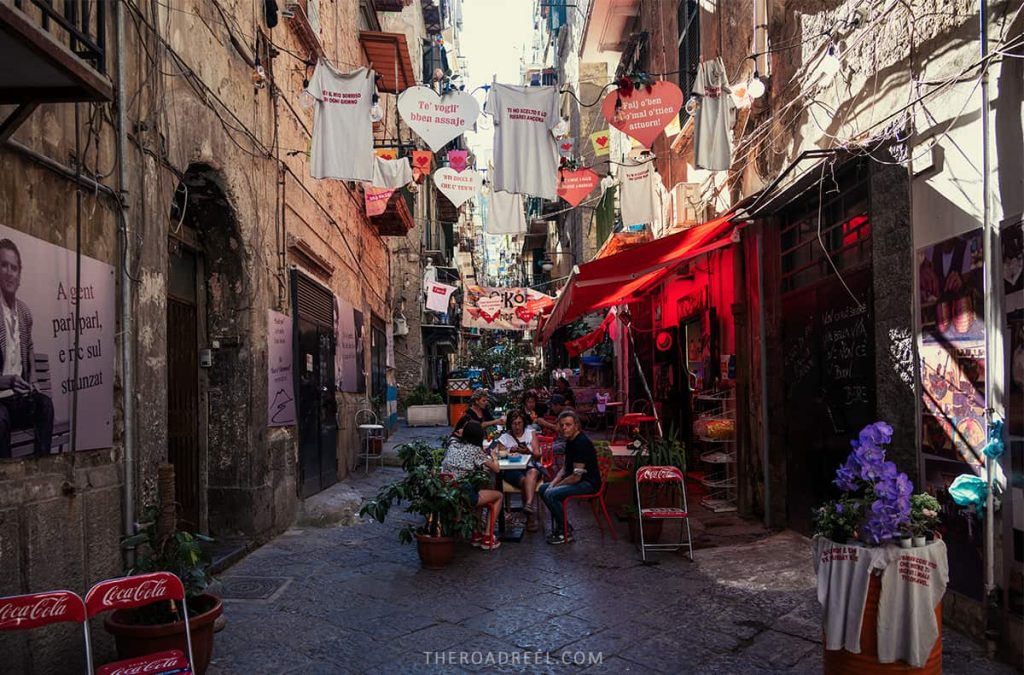
Below are my recommendations for dinner in Spanish Quarters:
- Pizzeria da Atillo , famed for its start shaped pizzas, is a family-run pizzeria that opened in 1938 and is known for its innovative approach to pizza making (hence the star pizzas). Make sure to try pizza Appennini, with ricotta, provolone, and zucchini (vegetarian), or try something meat based if veggies don’t count as food to you.
Note: you must put your name on the waiting list. Despite many hungry people waiting, the turnaround during our visit was pretty fast, and you will likely be seated pretty quickly.
- Opening times: 12-3:30 PM, 7 PM-11:30 PM, closed on Sundays.
- Address: Via Pignasecca, 17, Spanish Quarter, Naples.

- Trattoria da Nennella – authentic restaurant serving local Italian food made from fresh seasonal ingredients. Also, worth coming for a local experience. There is no reservation system, thus, just like in Pizzeria da Atillo, just show up, put your name on the list, and wait to be seated if there is a queue.
- Address: Vico Lungo Teatro Nuovo, 103/104/105, 80134 Napoli NA, Italy
- Opening times: 12-3 PM, 7-11 PM, closed on Sundays.
This wraps up your busy 1-day Naples itinerary. Below you will find the map of this one day in Naples itinerary with all points of interest and useful practical information about Naples , thus stick around.
If you have any questions or would like to share your experience seeing Naples in a day, feel free to comment at the end of this post.
1-Day Naples Itinerary Map
For your convenience, the best things to do in Napoli in 1 day and areas to explore are indicated on the Naples map below.
Following this Naples itinerary for one day, be prepared to walk for around 8 km. Most of the walk is leveled, except for the part that takes you to Vomero hill. I suggest taking a funicular for faster and easier commuting. Dedicate a full day in Naples to be able to slowly visit the attractions mentioned in this post.
Naples in one day- practical tips and information
Booking guided tours in naples, italy.
Some of the activities mentioned in this Naples itinerary require a reservation and get booked out quickly during the high season.
Also, the opening hours of different sights in Naples might differ. Therefore it is good to check beforehand if the sight you are planning to visit is open. That being said if some of the points of interest are closed on your day trip to Naples, I included enough activities so you will have an alternative attraction in Naples to visit.
I recommend reading all the details provided in this day in Naples guide to ensure you don’t miss a thing and make all necessary bookings.
How to get around Naples on a one-day visit
This one-day Naples itinerary is designed for walking (with an optional funicular and metro ride). Unless you have mobility restrictions, which would limit walking as the best option for sightseeing, you can get around Naples on foot.
If you start your day in Central Naples, which is compact, you can reach any of the attractions mentioned in this Naples travel guide within 5 to 30 minutes on foot. The time needed to walk between most of the attractions is around 10-15 minutes. The furthest point of interest from anywhere else in Naples on this itinerary is Sant’Elmo Castle. It takes around 30 minutes of walking from downtown Naples to the Castle.

Public and private transport options for getting around Naples in one day
- Metro line, which skips the infamous traffic of Naples, is the fastest way to get around different areas in the city. There are 3 metro lines in Naples (line 1, line 2, and line 6). The one of interest to you is line 1 (which also runs by the famous artsy Toledo station). A single journey costs 1.1 EUR at the time of writing.
- Funicular. A handy way to quickly tackle the steep parts of the city. Four funicular lines accommodate the hilly parts of the town. The one you will utilize during your 1 day in Naples is Montesanto to Morgen line for visiting Sant’ Elmo castle. This line is also adapted for people with mobility impairment.
- Bus. ANM bus system has a wide coverage of over 150 bus lines covering the city. However, to avoid getting stuck in traffic, I do not recommend using buses.
- Tram. Three tram lines serve the city. The ones that will bring you to central Naples are line 1 from Garibaldi station and line 4 from S. Giovanni. The ticket costs 1.10 euros when purchased from the newspaper kiosk, or 1.50 euros directly from the driver. Note tram runs on the streets of Naples, and is also prone to be stuck in traffic, thus not an ideal means of transport for you one day in Naples.
- Scooter. The agile mean of transport, super popular in Naples, but only for the brave. The horror of pedestrians and even car drivers, and scooters would only suit those with lots of experience on such crazy roads.
- Taxi. There are metered taxis available in Naples and can be an option if you prefer a private ride. However, due to heavy traffic, it may take longer than walking.
Unico tickets or TIC tickets provide daily and longer period passes that cover all public transport in Naples and suburban areas. This is useful if you are planning to use public transport more than once.
Do I need a car in Naples, Italy?
You definitely do not want to drive in Naples, Italy. Traffic is hectic and parking is difficult. Yet if you are planning on renting a car in Naples for your southern Italy road trip, I recommend reading my post 17 must-know Tips before hiring a car in Naples.
How to get from Naples airport to central Naples?
Naples International Airport (Capodichino Airport) is located 15 minutes away from the city center. Thus, visiting Naples even on a half-day layover is very much doable.
That being said below are your options to get from Naples Airport to the city:
- Alibus airport shuttle. The cheapest option is Alibus which brings you directly to Garibaldi central station (it is within walking distance of Centro Storico). The bus ticket can be purchased from the driver and costs 5 euros. The bus departs every 20 minutes, from early morning to almost midnight.
- Taxi. Metered taxis are available at the airport of Naples. The day rate is around 20 euros to central Naples. The exact rate depends on distance and drivers have rate cards inside the taxis.
- Private transfer. You can also prearrange a private transfer for hassle-free commuting from the airport to the hotel in Naples. -> BOOK IT HERE
Getting to Naples by train
Cities in Italy are very well connected through an expansive railway system. Thus, getting to Naples from nearby destinations, and even Rome is a straightforward task.
You can check routes and purchase tickets in advance on Omio .
Is it possible to visit Naples in one day from Rome?
As mentioned above, Italy’s railway network is very efficient. There are dozens of trains departing Rome to Naples every day with the fastest one connecting two cities in just under one hour. This makes visiting Naples as a day trip from Rome very doable.
You can depart as early as 5: 30 AM from Rome and return taking the latest train from Naples just before midnight. The train stops at Garibaldi Central station which is located within walking distance of the historic center of Naples. Check train schedules and book tickets here
Is one day enough to visit Naples?
One day in Naples is definitely too short to properly explore and experience all the best things this culturally rich city has to offer.
Naples is filled with head-spinning historical sights, panoramic views, never sleeping streets “decorated” with window-to-window rows of laundry. Let alone an overwhelming number of great pizza places to try (Napoli is known for being the birthplace and capital of pizza).
Nonetheless, if you only have one day to visit Naples, do not be discouraged. The city center is compact enough to get a good first impression of what the place is about as well as to tackle quite a few top highlights of Naples.
With careful planning and scarifying some sleep, you can make the most of it. That is why I strongly suggest starting your day early and staying till dark. This way you will get to experience Naples in 24 hours.
Have more than a day in Naples? Make sure to read my Naples in 2 days itinerary or Perfect 3 Days in Naples itinerary which also includes some fantastic day trips from Naples. (coming soon).
When is the best time to visit Naples?
Naples is a great place for a long city break. Blessed with pleasant temperatures for most of the year, Naples can be visited even in winter.
Nonetheless, the best time to visit Naples is shoulder season-early spring and late autumn. I visited at the beginning of May and Naples already seemed to be receiving quite a bit of visitors
Avoid: If you cannot handle the heat, do not visit Naples in summer as it gets pretty unbearable in the city. Let alone the crowds are bigger and prices are much higher.
Is Naples safe?
The most commonly asked question “is Naples safe to visit as a tourist?” Before making a decision whether to visit Naples or stay away, here are the realities and observations from my personal experience.
Naples is as safe as you choose it to be. It is definitely not the safest city in Italy. However, sticking around touristy areas and visiting historical centers and even the infamous Spanish Quarter is safe. Areas that are considered dangerous are far from the historic center and common tourist paths (the dangerous areas are namely Scampia and Secondigliano).
However, be warned that petty crime is common in Naples and distracted tourists are targeted. In general, you do have to take regular precautions when visiting a big city with thousands of people.
Yet there is no need to be overly paranoid or watch over your shoulder everywhere you go. Just keep your belongings in a safe place, don’t flash Rolex and gold chains for no reason, and be aware of your surroundings.
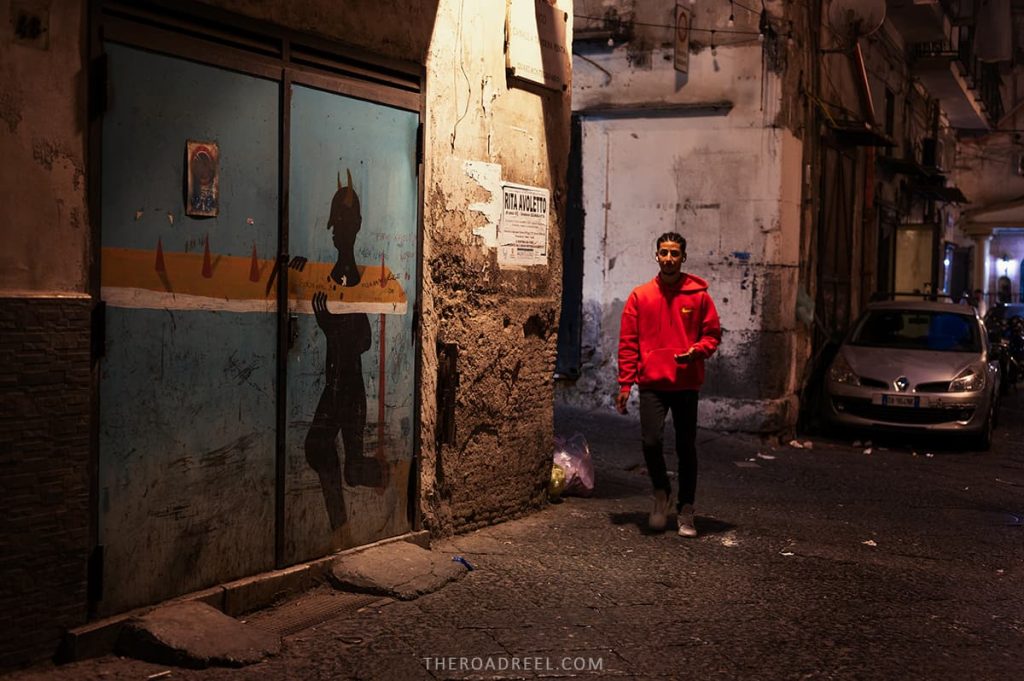
We strolled dark dodgy looking streets around Garibaldi metro station in Naples and had no issues whatsoever. But we did hear something that sounded like gunshots in Spanish Quarter (though we cannot say 100% whether or not it was a gun sound, we just assumed it to add some spice to our experience.
Though, we did receive suspicious looks when wandering around streets outside tourists’ radar. We have even been warned by a local boy not to take pictures in one particular street in that same Spanish Quarter.
In general, if you are traveling solo, stick to the more touristy areas with many people and do not wander around in dark narrow streets at night.
Naples final take aways-Top 5 tips for one day in Naples
- Book accommodation early. The best hotels in Naples get reserved fast. As an example, I traveled during the shoulder season in May and struggled to find great value vs quality. accommodation when trying to book even 3 weeks before the trip.
- Book your tickets. Some of the attractions in Naples are very popular and get booked out early. Thus, I recommended reserving your ticket as mentioned in my guide to make sure you do not miss the activity.
- Wear your most comfy shoes. This itinerary is designed for walking. Although Naples is not huge, there is enough ground to be covered for one day. Forget heels, sneakers are the way to go.
- Take a funicular . Since you are doing enough walking in one day in Naples, save some valuable time and yourself from the grueling climb uphill, and take a funicular to Sant’Elmo Castle.
- Dress code . Although you can wear whatever you like in Naples, note that you must cover your shoulders and knees when entering churches.
- You must try at least one pizza in Naples . Period.
Where to stay in Naples Italy
If you only have a day in Naples and have to spend a night or two, I strongly recommend staying in central Naples . Naples is a sprawling city when you look at the map, but most of the tourist attractions of Naples are naturally clustered around the historical center. With limited time in mind, Centro Storico would be the best choice to stay steps away from places to visit.
If you are planning to base yourself in Naples for longer so you can visit other places, like Pompei, Vesuvius, or islands near Naples as day trips then staying near Naples Central Station (Napoli Centrale) might be a convenient budget-friendly option. For a more upscale and unbeatable sea view, the Chiaia district is to keep an eye on.
IMPORTANT: I also strongly recommend booking accommodation in advance. Naples is an old city and hotels although plentiful, are quite pricey for the quality you get. Booking in advance will ensure you pick the best option for your budget.
Here are my top picks for the best accommodation in Naples for different budgets.

Grand Hotel Santa Lucia $$$$- overlooking the Bay of Naples, this luxury hotel is set in the early 20th-century property and offers a fusion of luxury and modern amenities. A rich breakfast buffet is included in the rate.

Relais della Porta $$-$$$- centrally located on Via Toledo street, this hotel is within walking distance of many main attractions in Naples. It features a beautiful frescoed ceiling, great breakfast is also included.

La Casa Sul Nilo $$- a complex of apartments of different sizes that can host up to 5 people. Accommodation is located at the very heart of Naples, 300 meters from San Gregorio Armeno street.
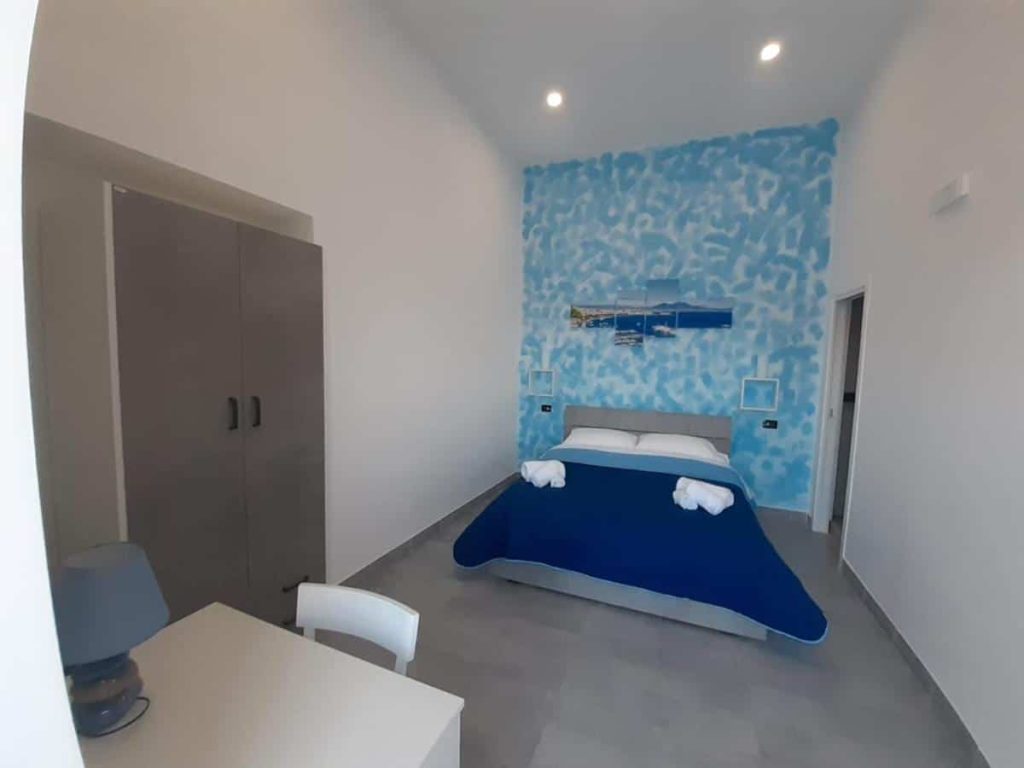
Heart of Naples $- a perfect budget option located close to Garibaldi Central station and just a 10-minute walk from central Naples, this minimalistic, newly renovated hotel offers a comfy stay with Netflix, Amazon prime, and delicious Italian breakfast in the nearby café.
Italy Travel Essentials & Useful Links
Here are links to essential travel resources and services I always use when organizing my trips.
- HIRE A CAR : Rent a car at the best rates at Discover Cars .
- CHEAP FLIGHTS: find the cheapest and the best flight combinations with Skyscanner .
- ACCOMMODATION: find your perfect stay on Booking.com .
- VISA: apply for a Schengen visa easily at iVisa . Use OneWayFly to reserve dummy flight tickets/hotels if required for your visa application.
- TRAVEL INSURANCE: get 5% off your insurance by using my link on Heymondo , a travel insurance provider. For the cheapest travel insurance on the market check SafetyWing .
- eSIM CARD: Stay connected before you land. Airlo offers an eSIM card with up to 20 GB (7 to 30 days) data packages for Italy and Europe for reasonable rates.
- GUIDED TOURS: Find the best day tours in Italy on GetYourGuide .
- PRIVATE TRANSFER: Book a private transfer to any location in Italy with GetTransfer .
- FLIGHT GOT CANCELLED OR DELAYED? You may receive compensation of up to 600 EUR. Consult and get support from AirHelp or Skycop .
- Learn Italian: take a fun interactive online course Rocket Italian , which will help you quickly learn spoken and written Italian. Study at your own pace either on a desktop or using a mobile app, lifetime access, and a free trial available upon signing up.
More Italy travel guides
- Browse all my blog posts about Italy HERE .
- Find out more about the Best areas to stay in Naples, Italy .
- If you have more time in Naples, check the 2 days in Naples itinerary .
- Thinking of renting a car in Naples? Use my Must-Know Tips for Renting a Car in Naples and Driving in Southern Italy .
- Is Naples worth visiting? 23 reasons to love Napoli, Italy.
- Looking for romantic road trip ideas in Italy? Check my list of 15 Most Romantic Road Trips in Italy.
- Discover Castelmezzano and Pietrapertossa- the most beautiful towns in Basilicata , south Italy
- Thinking of extending your journey to Sicily? Plan an amazing trip with my 2-week Sicily road trip Itinerary .
- Get some inspiration for Sicily and check out 15 of the most beautiful small coastal towns in fishing villages in Sicily .
- Love mountains more? Get inspired or pick to visit some or all of 17 charming mountain towns in Sicily .
Hi! I am a freelance photographer & videographer as well the creator of www.theroadreel.com. Born in Lithuania, and currently residing in the UAE, I have been traveling around the globe independently for over a decade. I created The Road Reel to share my passion for travel and photography through detailed road trips and city itineraries, and hiking guides, along with regular and drone photogragraphy tips.
Leave a Reply Cancel reply
Your email address will not be published. Required fields are marked *
Save my name, email, and website in this browser for the next time I comment.

Home » Travel Guides » Italy » 15 Best Things to Do in Naples (Italy)
15 Best Things to Do in Naples (Italy)
Naples is a vast city located on the western coast of Italy facing the Tyrrhenian Sea. This colossal metropolis is the third largest city in Italy behind Rome and Milan with a population of 975,000 and a greater metropolitan population of over 3.1 million. Naples and the surrounding region has been inhabited since the Neolithic period and it has seen some form of continuous human activity through ancient Greek times to the Roman Empire and further.
Throughout history Naples has been the sight of fierce battles and many civilisations have vied to gain power here. Naples port is one of the most important in the Mediterranean and the city has one of the largest economies in Italy. Due to the extensive history of this region, Naples is full of historical buildings, squares and churches plus a host of modern amenities and fantastic nightlife opportunities. Looming in the shadow of the legendary Mt. Vesuvius, this is a truly epic tourist destination.
Lets explore the best things to do in Naples :
1. Climb Mount Vesuvius

Classified as a Stratovolcano, Mount Vesuvius dominates the skyline and landscape surrounding Naples and is a legendary volcano that famously erupted in 79 AD and caused the destruction and burial of Pompeii and Herculaneum.
Vesuvius stands as the only volcano in mainland Europe that has erupted in the last 100 years – It is considered extremely dangerous due to the amount of human settlements that are situated in its danger zone.
Today you can take a bus tour from Naples to visit this magnificent natural phenomenon and climb up its slopes to peer into the crater.
A hike will take between 20-30 minutes and is considered not too challenging – The views from the top on a clear day are simply fantastic and the caldera and crater are hugely interesting too.
Suggested tour : Vesuvius 4-Hour Wine Tasting Tour and Lunch from Naples
2. Visit the ruins of Pompeii

Pompeii was an ancient city that sat in the shadow of the iconic Mount Vesuvius.
This settlement was highly advanced and extensive and was destroyed at its peak during the devastating eruption of the volcano in 79 AD. Despite the devastation cause and the amount of lava that poured over the city, Pompeii stands today in a fantastic condition – This is due to the huge layer of ash that was deposited over the partial ruins and thus acted as a preserver.
Today you can visit Pompeii and walk through the extensive ruins – Particularly interesting sights include the Amphitheatre, the case del Fauno, the Temple of Apollo and the Temple of Jupiter.
Furthermore you can find plaster casts of many of the unfortunate victims who were buried under the ash and remain locked in their death pose for an eternity.
Recommended tour : Pompeii Ruins & Mount Vesuvius Day Tour
3. Naples National Archaeological Museum

Housed in a fine ornate building that was created in the 1750’s, the museum used to operate as a military and cavalry barracks and was turned into a museum in later years.
The museum is located to the north of the Harbor but there is a Metro station right next to the building.
Inside you can find an extensive collection that includes a wide array of Roman and Greek artefacts plus a selection of works from both Pompeii and Herculaneum.
This collection includes a selection of marble statues depicting scenes from ancient mythology, beautiful mosaics from the ruins of Pompeii, and a huge collection of objects from ancient Egypt such as mummified remains and death masks.
Anyone interested in ancient history and archaeology will find this museum an infinitely interesting place to visit.
4. San Gennaro Catacombs

Have you ever wanted to explore a secret underground world that holds a huge amount of detail and passageways? This is exactly what the San Gennaro Catacombs provide and you can find the entrance to this otherworldly place near the Basilica dell’Incoronata in northern part of Naples.
Once underground, you will find a network of tunnels and passageways that are lined with graves and crypts dating back to ancient history.
Spread over two levels, the lower floor contains a staggering 3000+ burials and is dimly lit to retain the spooky underground feeling.
The top level is more spacious but just as interesting and contains many detailed frescos and artwork.
A guided tour of the catacombs will provide a memorable experience and a true insight into the history of Naples.
5. Visit the ruins of Herculaneum

Another city that was devastated after the 79 AD eruption of Vesuvius was Herculaneum – This city is the lesser known counterpart to Pompeii but is just as interesting and a fantastic sight to visit.
Although the city was located further away from Vesuvius than Pompeii, it was still completely destroyed.
Herculaneum is actually considered to be a better preserved example than Pompeii and still has some of its wooden structures, frames and roofing intact.
Interesting sights within the complex include the Villa of the Papyri and the House of Argus which both contain beautiful frescos and wall paintings.
Furthermore there is also a series of skeletal remains that show the demise of this unfortunate group of people.
If you visit Pompeii, ensure that you visit Herculaneum too for a detailed insight into an ancient period of time.
6. Castel Nuovo

The Castel Nuovo stands out as a main feature in the skyline of Naples and is one of the first sights that people entering via cruise ships will see.
Located in close proximity to the famous Piazza del Plebiscito the castle is easily accessible and is one of the main historical sites in Naples.
Created in 1282, the castle features 5 circular crenulated towers and a fantastic triumphal arch that was added at a later date.
Take a tour of the castle and admire the beautiful towers, stand inside the central courtyard, admire the painted ceiling of the Baron’s Hall and climb the castle ramparts for stunning views of Naples and the harbour.
7. Cappella Sansevero

There is many chapels and churches in the heart of Naples, and the Sansevero Chapel is a truly fine example.
Created in 1590, the chapel was once a private building for the Duke of Torremaggoire and then served as a family burial chapel from 1613. Located in the centre of Naples, the chapel is not far from the Harbor and the Castel Nuovo.
Although this chapel is quite plain and unassuming from the outside, it is the interior that is quite spectacular and is the true highlight.
The chapel contains a huge amount of artwork and several famous sculptures.
A detailed and magnificent fresco adorns the ceiling and many marble statues stand guard at each of the pillars.
Central to this fantastic display is the beautiful statue of the Veiled Christ created by Giuseppe Sanmartino.
8. Castel dell’Ovo

As you enter the port at Naples you will undoubtedly see this stunning sea bound castle.
Once an island, the land that the castle stands on is now connected to the mainland and is accessible by a footpath and road.
As the oldest remaining fortification in Naples, the Castel dell’Ovo was constructed in the early 6th century BC and some form of defensive structure has stood ever since.
The castle is open to the public and it is a fantastic structure to explore – Walk through the passageways and arches and look out into the Mediterranean sea.
You can also find several exhibits of art and displays about the history of the castle.
9. Naples Harbour

Naples is a hugely busy port and sea trade is the city’s main source of economy.
The network of ports is divided into separate docks and is a true hive of activity at any time of the day.
Stretching from the Castel Nuovo to the Piazza San Giovanni Battista you could easily spend hours walking through the docks and ports and watching the intriguing business that occurs here.
Furthermore, if you continue to the west you will find the Porto di Mergellina which is full of trendy restaurants and cafes and has a great vibrant atmosphere.
Come here to sample some local life and admire the different yachts that dock at the harbour.
10. Piazza del Plebiscito

Undoubtedly the main square in Naples, the Piazza del Plebiscito features the Royal Palace and the Basilica Royal and is a truly fantastic place to visit.
This vast open space is filled with important buildings and statues and aside from the aforementioned structures, it also contains the Palazzo Salerno, the Prefecture Palace and a statue dedicated to Charles III of Spain.
The semi-circular colonnades of the Basilica Royal stretch out and frame the square beautifully.
Use this place as a starting point for your tour of Naples and be sure to visit the fine historical buildings that sit here.
11. San Domenico Maggiore

Another of the beautifully decorated churches in Naples, the Sam Domenico Maggiore was founded by Dominican Friars and was constructed in 1324. The church is located in the centre of the old town of Naples near the university and the Dante Metro stop.
Whilst the exterior of the structure is not particularly impressive, the interior is the real treat.
Full of renaissance artwork, sculptures and decoration, the church is hugely opulent – The panelled ceiling is gilded with gold and the high altar is also a stunning masterpiece.
Furthermore, there is also a “treasure chamber” that contains a plethora of religious artefacts, clothing, accessories and other trinkets.
12. Naples Cathedral

Dating as far back as the 13th century, the Cathedral of Duomo is a magnificent structure and stands as the main church in Naples and indeed in southern Italy.
Located on the Via Duomo, the cathedral is accessible via the Museo metro stop but also has a regular bus service that passes the front façade.
This religious building combines a myriad of styles including Gothic, Renaissance and Baroque – This is due to the restorations and changes that have been made since its creation.
Outside, the front façade features a large central tower and many ornate sculptures and stone work.
Inside, the main knave is framed by a series of huge columns and the decoration is simply beautiful.
Don’t forget to visit the immaculately decorated chapel of San Gennaro that features a finely decorated altar and two vessels containing the saints blood.
13. Explore the district of Santa Lucia

To truly experience Naples from a local perspective and soak up some culture, head to the district of Santa Lucia.
Located to the west of the Piazza del Plebiscito, this district has a myriad of narrow cobbled streets that wind down to the sea and offer an array of craft shops, restaurants, cafes and shops.
Here you can experience Neapolitan life at its best – Locals will walk through the streets going about their daily business, clothes hang out on washing lines and children play without a care in the world.
14. Palazzo Reale

This stunning Royal Palace holds the centre of attention in the Piazza del Plebiscito and sits opposite the Basilica Reale.
The front facade of this building features a symmetrical series of black framing, brown render and many windows to create an official and imposing look.
Furthermore at the base of the palace stands 12 detailed statues of past Kings of Naples from Roger of Sicily to Frederick II the Holy Roman Emperor.
Inside this lavish building is a stunning array of preserved rooms that are full of ornate decorations – The initial hallway and staircase is unbelievably opulent and the throne room and the state theatre are just as fantastic.
A tour of the interior and rooms is a must and will complete your visit of this wonderful historic building.
15. Take a boat to explore the island of Capri

Capri is a small inhabited island that is known for its dramatic scenery, rugged coastline dotted with beautiful caves and its quaint and charming Italian villages.
A boat trip from Naples harbour takes just under two hours and there are regular ferries that travel between the island and mainland, and neighbouring Sorrento.
Walk through the wonderful Marina Grande, admire the boats in the harbour and then set off to explore the island.
Don’t forget to take a trip to see the famous Blue Grotto Sea Cave or the view from the top of Monte Solaro.
Available tour : Island of Capri: Full-Day Tour from Naples
15 Best Things to Do in Naples (Italy):
- Climb Mount Vesuvius
- Visit the ruins of Pompeii
- Naples National Archaeological Museum
- San Gennaro Catacombs
- Visit the ruins of Herculaneum
- Castel Nuovo
- Cappella Sansevero
- Castel dell'Ovo
- Naples Harbour
- Piazza del Plebiscito
- San Domenico Maggiore
- Naples Cathedral
- Explore the district of Santa Lucia
- Palazzo Reale
- Take a boat to explore the island of Capri

- Things to do in Naples
The Best Experieces All Around Naples
Typical products, Fashion, Souvenir...
Pizzerias, Restaurants, Street Food, Bakeries...
Museums, Castles, Archaeological Sites...
Visit the places of Naples for free
Discover the wonders of Naples
Wellness, Where to drink, Fun...
- Choose your accommodation
Best Bed & Breakfasts in Naples
Best hotels in Naples
Best vacation rentals in Naples
Best Hostels in Naples
Discounts at the best facilities in Naples
- Naples Pass

Discounts, museums and public transport in Naples
Tips for visiting naples.
Info, luggage storage, maps, useful numbers...
Visit Naples in autonomy
Travel for free throughout Campania
Where to park your car in Naples
- Visit Naples

Traveller guide for the city of Naples
- Attractions
- Napoletanity
Free access to the main attractions of Naples and get discounts in the best activities

- Free entrance to the main attractions of Naples
- Free public transport throughout Campania
- Discounts in the best Hotels, Restaurants and Shops
The city guide of Naples and Campania
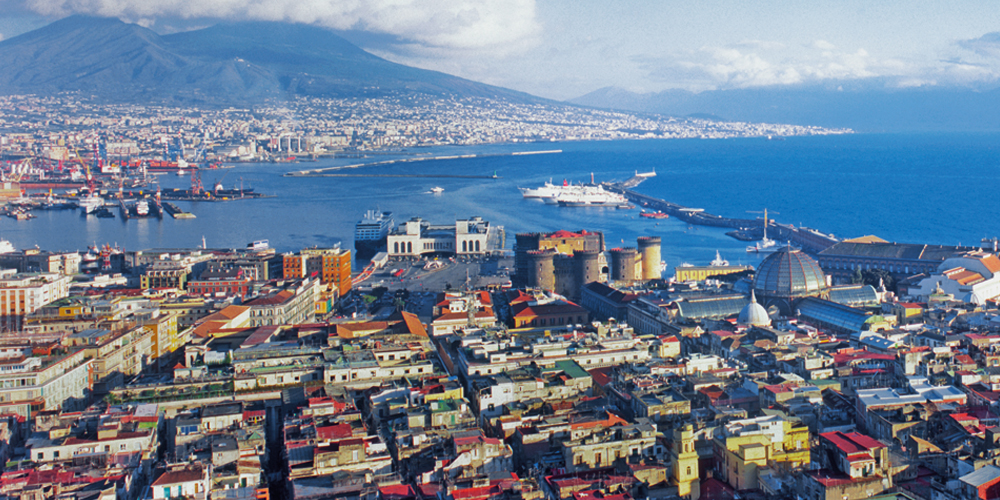
Info and useful tips to visit Naples
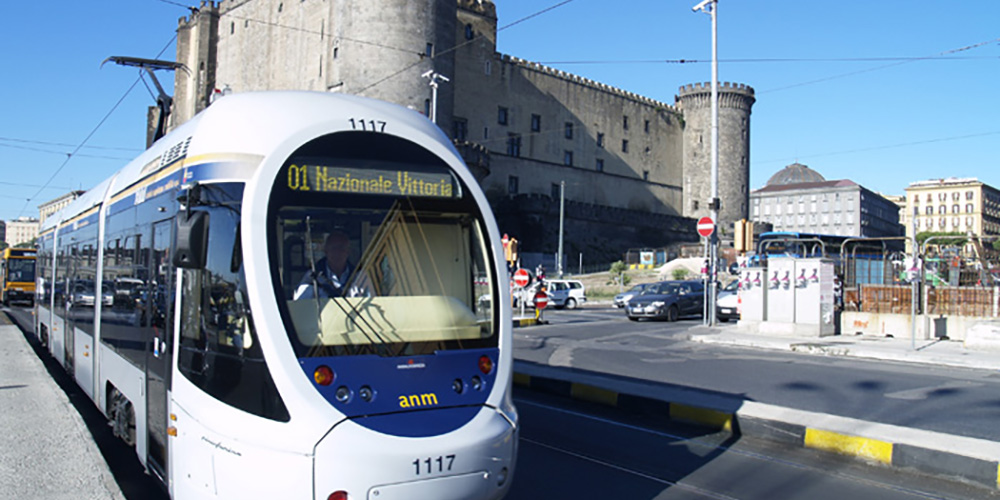
How to use Public transport in Naples while saving money
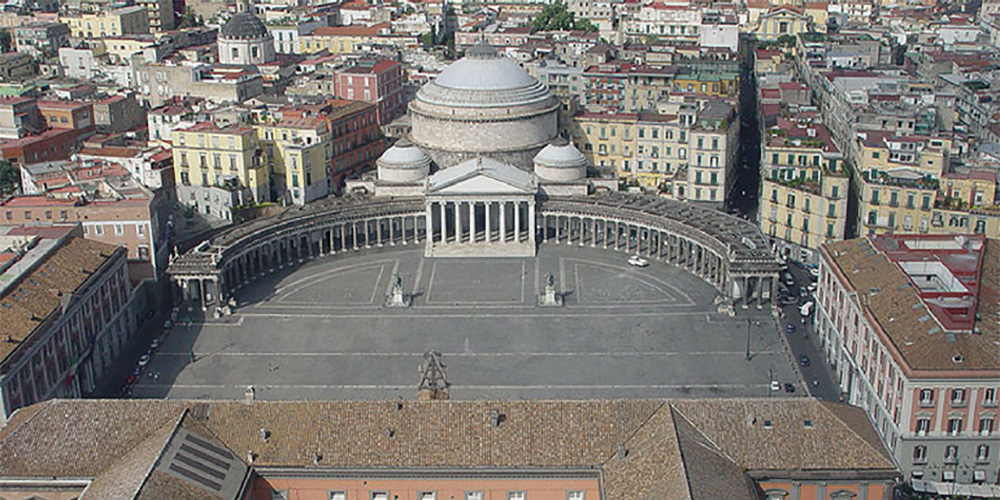
The 6 most important squares to discover
Near naples, museo archeologico dell'antica capua, abbazia di santa maria dell'olearia, certosa e museo di san martino, fondazione morra greco - palazzo caracciolo di avellino, museo cappella sansevero, madre - museo d'arte contemporanea donnaregina, cimitero delle fontanelle, grotte di pertosa-auletta, discover naples, the 10 unmissable markets in naples: between vintage and bargains to be discovered, 10 secret places to see in naples, what to do in naples in 5 days: the guide to visit the city, belvedere of pizzofalcone: the complete guide to reach the monte echia, 10 things to do around naples, diversamente. un'esistenza outsider: new documentary on franco battiato to be released, easter holidays in naples: what to do during the holy week, 10 romantic things to do in naples, "torre blu" project: the sustainable revolution of the gulf of torre del greco, flavours of naples, baccalàre returns to naples: six days of celebration for seafood lovers, street food in naples: the fried food of traditional neapolitan cuisine, zeppole di san giuseppe: a traditional neapolitan pastry creation, neapolitan migliaccio: a traditional carnival dessert from campania, 7 dishes to try to taste all the flavours of neapolitan cuisine, nougat: an authentic irpinian excellence, discover pompeii and its food and wine, the cuisine of a millenary city: the traditions of aversa, fava beans and ventresca: the spring aperitif on ischia's tables, videos of naples.
Naples is made of unique stories , stories you have to know , see and hear . We try to tell them, we try to enclose in our videos that Neapolitan essence in order to transmit it to as many people as possible.
We describe, the beauties , the colors , the sounds , the flavors of Naples , we condense them into short videos that can be a quick and fun way to learn something about this wonderful city and, why not, inform yourself before or during your trip to Naples.
Visit Naples and do it right. You won't regret it.
Walk Naples
Where to stay in naples: what are the best neighborhoods of the city, one of the dark sides of naples: the bourbon tunnel, discovering the locations of the film "the hand of god"., modern naples: buildings and structures of the neapolitan twentieth century architecture, walking trails: 5 hikes and routes around campania, the winding medieval streets and the peculiar grid shape of the city of naples, the regular grid of naples: castra, cardi and decumani, a day in nola with pro loco di nola città d'arte, the hidden naples: discovering the unknown alleys of the city, tales of naples, 3 contemporary artists from naples that you can meet in the historic centre, naples and diego armando maradona: 5 corners of the city linked to el pibe de oro, the procession of san gennaro in naples: what is the may miracle, futuro remoto 2022: what happened during the 36th edition of the scientific festival, ancient musical instruments of the music of the naples tradition, figure of the woman in naples among myth, legend and esotericism, the historical archives of the fondazione banco di napoli nominated for unesco heritage, the places of naples told in comics with the bastardi di pizzofalcone, five women who made the history of naples.
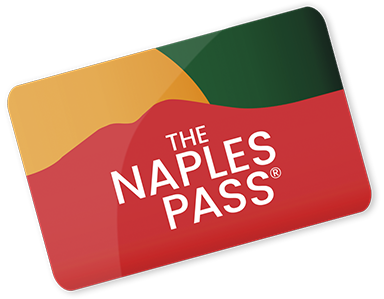

A 3 Day Naples Itinerary for first time visitors
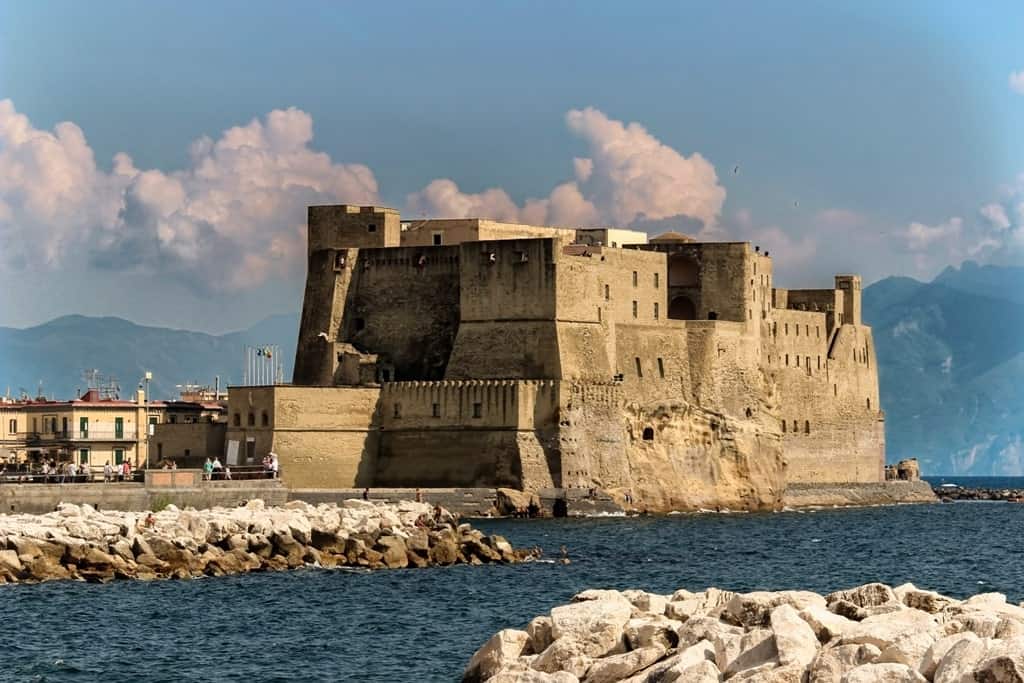
This post is also available in: French
Naples, on the southwestern coast of Italy, is one of Italy’s vibrant urban centres. Known for Pompeii and pizza, Naples gets overlooked by many who travel to Italy, but it – and its neighbouring islands and regions – is well worth a visit. 3 days in Naples is plenty of time to see the major attractions, take a day trip to an island, and eat as much Neapolitan pizza as possible!
Founded by the Greeks in the 2nd century BCE and now the third largest metropolitan area in Italy (after Rome and Milan), Naples has always been significant. It is one of the oldest continuously inhabited cities in the world, and has numerous sites that date back to both Greek and Roman times. My three-day Naples itinerary covers the most popular sights as well as some of the lesser known spots.
Disclaimer: This post contains affiliate links. This means that should you click on certain links, and then subsequently purchase a product, I will receive a small commission.
Table of Contents
3 Days in Naples Quick Guide
Planning a trip to Naples? Find here everything you need: Looking for transportation from/to the airport? Click here for more information and to book your private transfer. Top-Rated Tours and Day Trips to Do in Naples: – From Naples: Pompeii Ruins & Mount Vesuvius Day Tour – From Naples: Amalfi Coast Full-Day Trip – Naples Underground Entry Ticket and Guided Tour – Pompeii: Fast Track Entrance Ticket with Audio Guide – Catacombs of San Gennaro Where to stay in Naples: Renaissance Naples Hotel Mediterraneo (4-star hotel), Grand Hotel Europa (near the main station)
How to spend 3 days in Naples
3 days in naples: day 1.
Begin your three-day Naples itinerary by exploring a tangible historical timeline of the city, from Castel Nuovo (13th century) and the Royal Palace (17th century) to the 20th century subway system.
Visit the Art Stations of the Naples Metro
The Naples Metro lines 1 and 6 are what one might call open-air, underground art galleries. Featuring modern art, and all accessible for anyone travelling on the metro, each station is unique. There are over 180 different works of contemporary art across the two lines, and plans are in place to renovate several other stations into art stations.
Some of the most popular stations include Garibaldi, Museo, and Toledo.
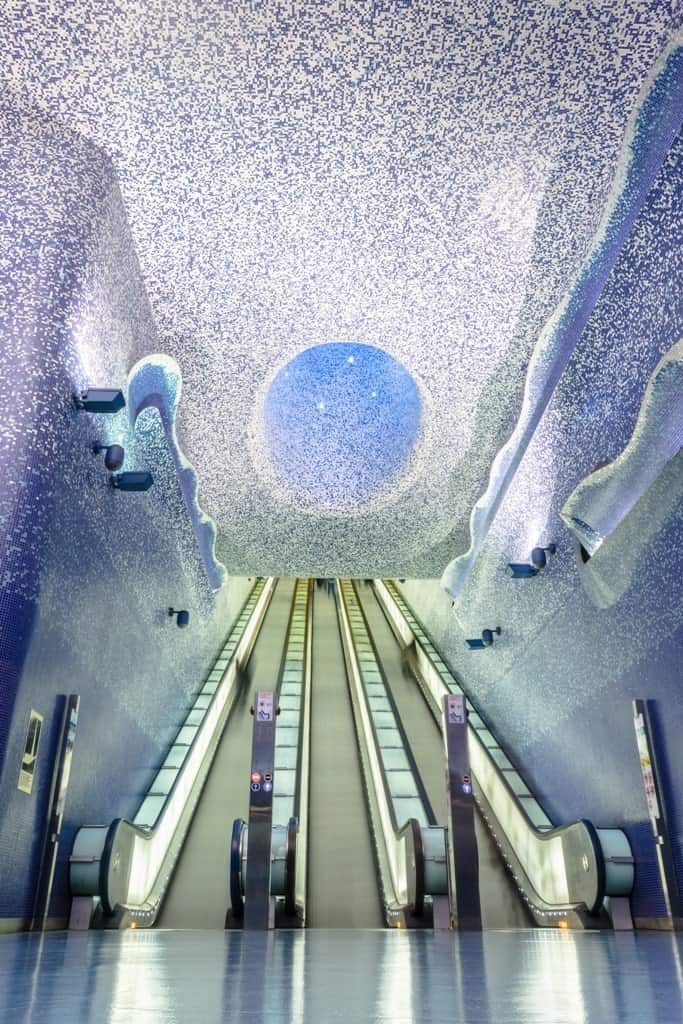
Via San Gregorio Armeno
San Gregorio Armeno, or Christmas Road, is a tiny street in Spaccanapoli where it’s Chrismas all year round. This is where to buy a crib, called a presepe , a nativity scene, which are so famous in Naples, or any other Christmas item to go along with your nativity scene. What is so cool about San Gregorio Armeno is that it’s not just the traditional nativity scenes, but any kind of scene you can think of … and some are rather creative. While exploring the old town, don’t miss this world famous spot.
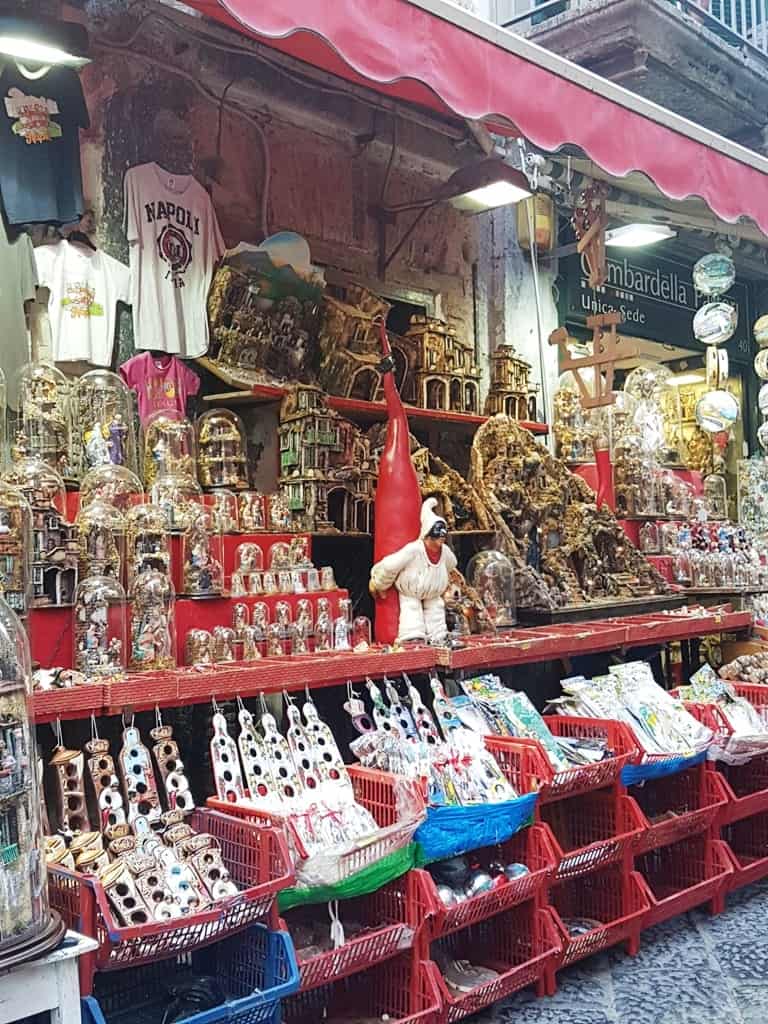

Sotterranea
The Napoli Sotterranea, or the Naples Underground, is a must visit on your three-day itinerary of Naples! A visit includes the Greek-Roman aqueducts, the Roman theatre, theWorld War II bunkers, the cisterns, and a glimpse at the foundations of the city. These underground tunnels are exceptionally interesting and a highlight of any trip to Naples.
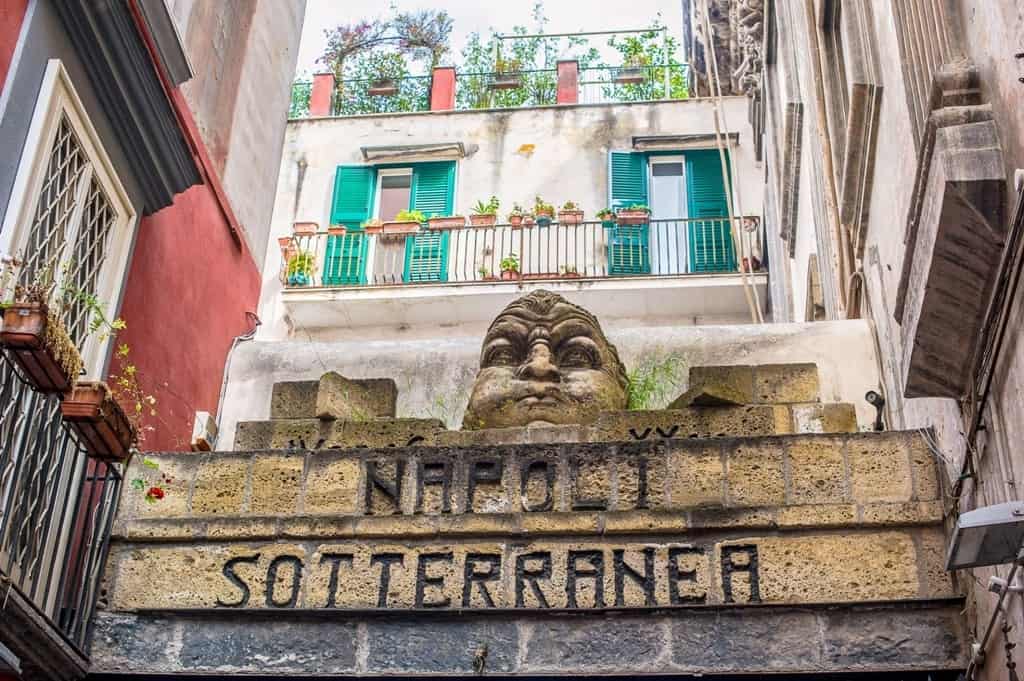
Naples Cathedral
The Naples Cathedral is the most important Roman Catholic church in the southern part of Italy and features outstanding frescoes that date back to the 14th century. Visitors can also see Greco-Roman ruins as well as two paleo-Christian churches that date to the 4th century. Much of the modern church is Gothic, with later Renaissance and Baroque additions/modifications. It too was damaged by bombs during the war and has since been restored.
Twice a year, the cathedral brings out a vial of Saint Januarius, or San Gennaro, patron saint of Naples. The blood usually liquifies, and if it doesn’t the legend says disaster will befall the city.
National Archaeological Museum, Naples
The National Archaeological Museum of Naples showcases the rich archaeological history of the southern Italian region. Located at Piazza Museo, the museum was opened in the late 18th century. It has one of the most complete collections of Greek and Roman antiquities, including an impressive collection of Roman erotica from Pompeii.
At the core of the antiquities collection is the Farnese Collection, an extensive array of engraved cups and bowls, sculptures, and the Farnese marbles, which were collected by the Medici brothers. Another important exhibition is the Herculaneum scripts, which are papyrus that were carbonised in the eruption of Pompeii and were found at the Villa of the Papyri in 1752.
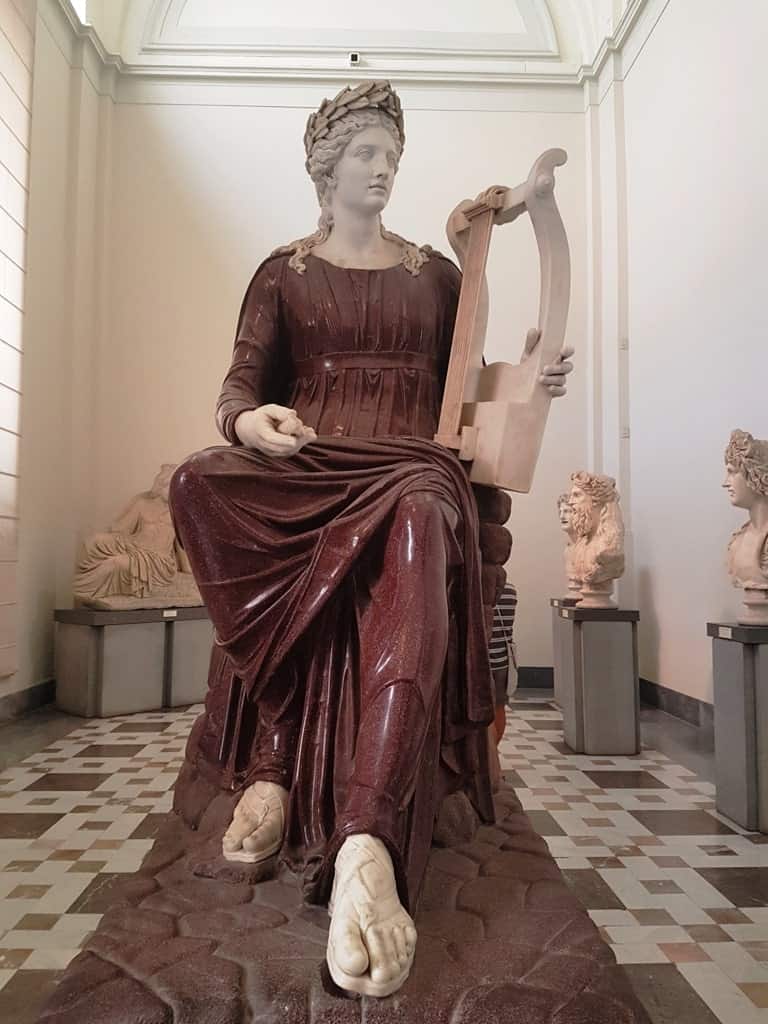
The Naples Archaeological Museum is open every day except Tuesday, and should be an early stop on your three-day Naples itinerary.
Piazza del Gesù Nuovo
Piazza del Gesù Nuovo is one of the main squares at the edge of the historical centre of Naples, created due to the expansion of the city in the 16th century. Some of the prominent landmarks in the square are the Church of Gesu Nuovo, which has incredible artwork, the gothic Church of Santa Chiara, and the spire of the Immaculate Virgin.
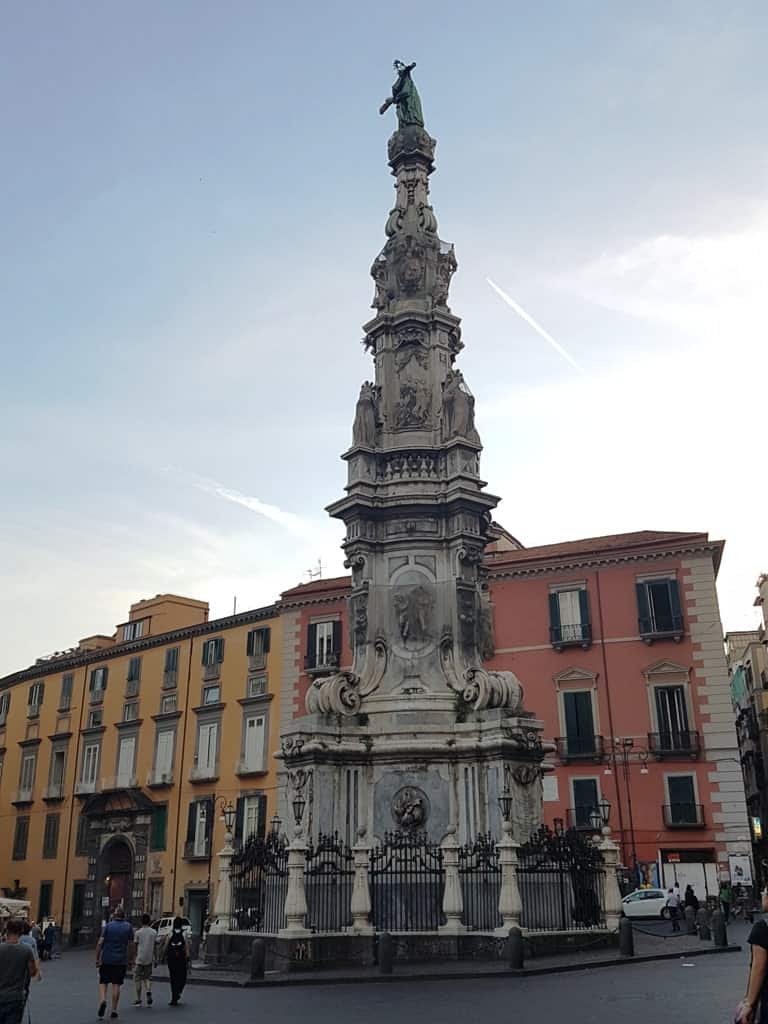
Castel Sant’Elmo
Castel Sant’Elmo is a medieval fortress on a high above Naples. Parts of the castle date back to the late 13th century, although it was expanded in the 14th-16th centuries. It was used mainly as a military outpost and was strategically placed for defense purposes. Today, it serves as a museum and exhibition hall as well as administrative offices.
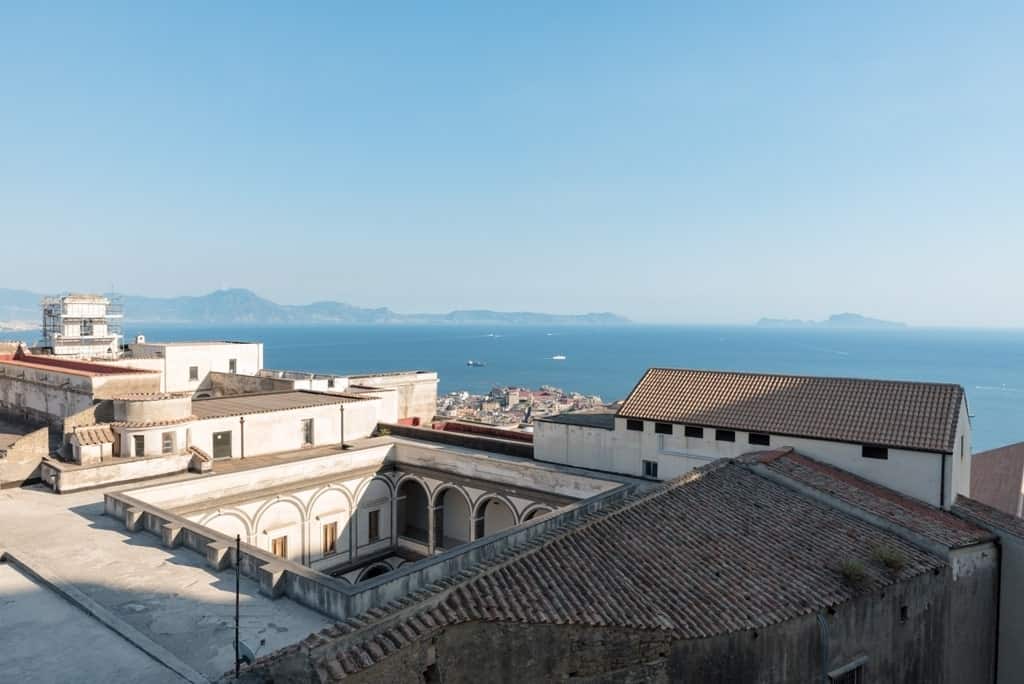
Piazza Bellini
Piazza Bellini is one of Naples’ historic squares, near the university and the 4th-century Greek city walls. Named for an operatic composer, and with several cafes and libraries here, it’s an intellectual meeting place. Piazza Bellini is buzzing with activity from morning until late in the night, when students and locals come out to relax, have a spritz, and enjoy the atmosphere. As one of Naples’ most popular bar hubs, you should definitely make time for an evening here at one of the pubs.
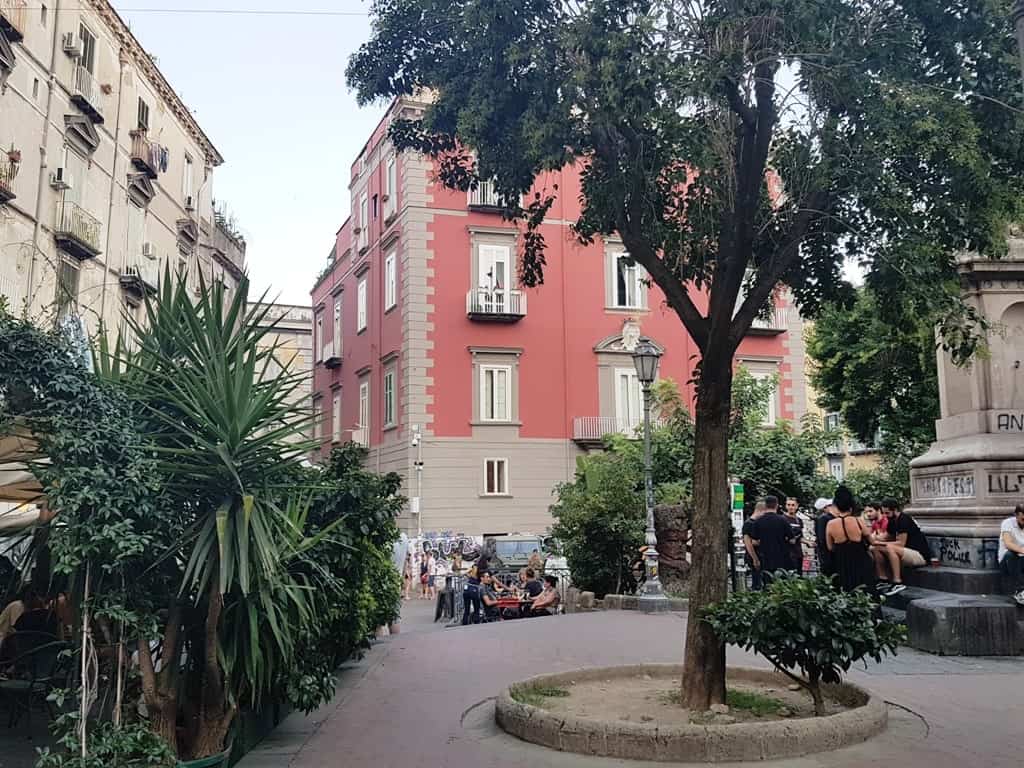
3 days in Naples: Day 2
Walk down spaccanapoli road.
Spaccanapoli Road is the main street of Naples’ historical core, and is lined with numerous historically important buildings. The street, which is very narrow, is actually the name given to several streets that continue through the city, breaking it into two halves (hence the name, which translates literally to “Naples Splitter”).
It is lined with churches, namely the Church of Gesu Nuovo and Santa Chiara, street vendors, bars, and shops. Always buzzing with locals as well as tourists, Spaccanapoli Road should definitely be on your three-day Naples itinerary.
If you are after Neapolitan pizza, this is the place to find it, but don’t miss the gelato shops, pastry shops, or the limoncello vendors.
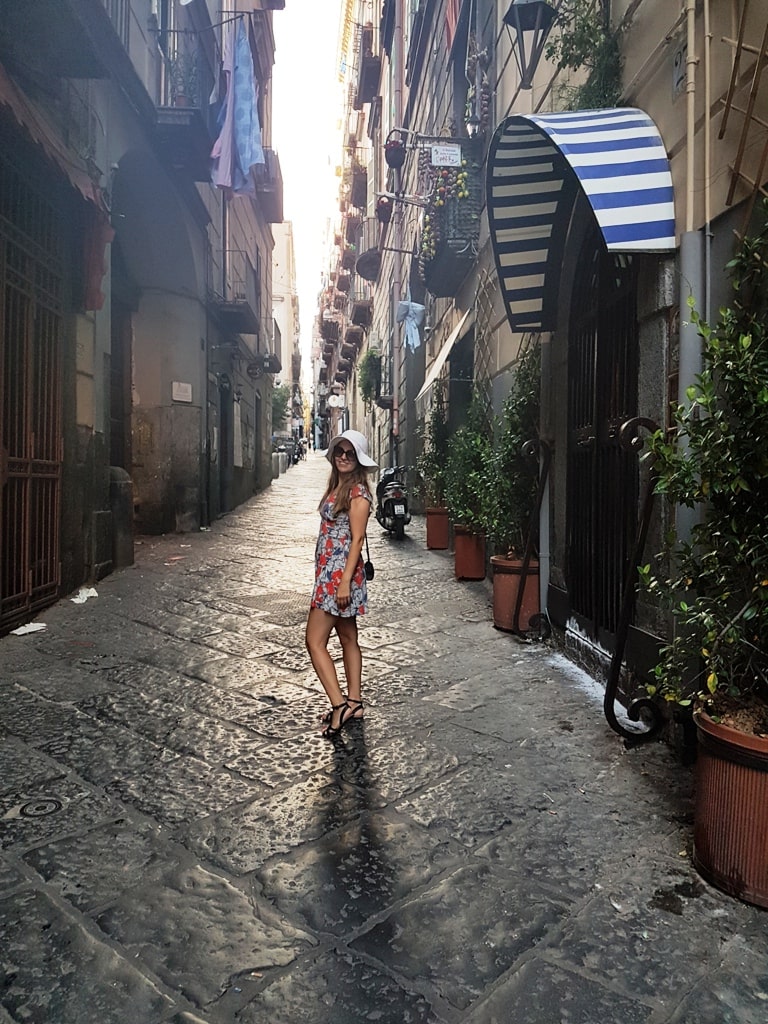
Piazza del Plebiscito
Piazza del Plebiscito is a large public square in central Naples. It is surrounded by the Royal Palace of Naples, the Church of San Francisco di Paola, Palazzo Salerno, and the Prefecture Palace. The square also houses several statues and is a popular meeting place for tourists and locals. It is also used for concerts, notably Elton John, Bruce Springsteen, and Maroon 5.
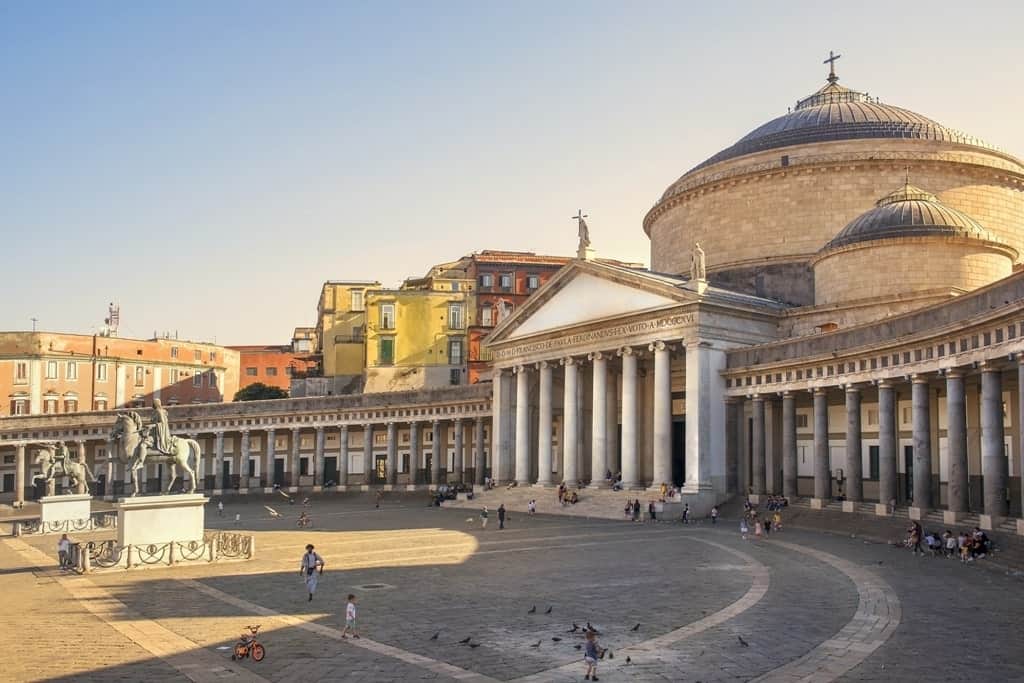
Royal Palace of Naples
The Royal Palace of Naples, located in the heart of the city in Piazza del Plebiscito, is one of the the former residences of the Bourbon kings. Like many of the important Bourbon-era buildings in Naples, it was designed and built by the Spanish court. The Royal Palace of Naples dates to the early 17th century, and was initially intended to house King Philip III of Spain.
In the mid 17th century, the palace was remodelled to house King Charles III of Spain, the first Bourbon king to reside here. Later, the palace was home to Marie Antoinette’s sister Maria Carolina, Queen of Naples from 1768 to 1806, and Napoleon Bonaparte’s sister Caroline, Queen from 1808-1815. Many of the rooms in the palace were either designed by or dedicated to the powerful Habsburg/Bourbon queens.
Over the years the palace has been renovated and restored, especially following World War II, when it was heavily damaged by bombing. It now houses the National Library of Vittorio Emanuele III, the Teatro San Carlo, and various administrative offices.
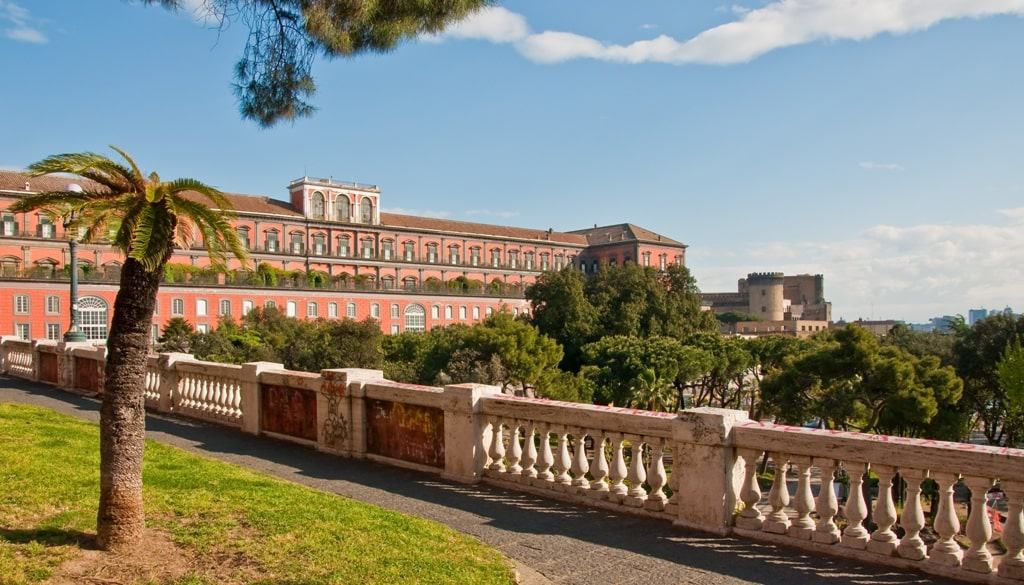
The palace is open for tours daily 9am – 8pm, except on Wednesdays when it is closed. Do not miss the opulent staircases, the impressive throne room, and the lavish royal apartments. Of course, the exterior is just as impressive; the facade of the palace is adorned with eight statues of Neapolitan rulers from the 12th to 19th centuries.
Castel dell’Ovo
Castel dell’Ovo, or Castle of the Egg, is the oldest fortification in Naples. Its seaside location is visible from most of the city. The castle is built on the foundations of a Roman villa, on a islet in the Napoli harbour. Called Megaride, this islet (now connected to the mainland by a causeway) is where legend says that the siren Parthenope came ashore after failing to lure Ulysses.
The name of the castle comes from Virgil, a Roman poet. Legend says that Virgil put an enchanted egg in the foundations of the castle as protection. If the egg breaks, it spells disaster for the city and its citizens.
Castel dell’Ovo was once a royal residence, but in later years used as a prison. In the 15th century, the fortress was heavily modified by the Aragons, and its current appearance dates from this era. Recent underwater archaeology discovered the original port of Naples as well as the original Greek settlement of Paleopolis.

Castel Nuovo
Castel Nuovo, or new castle, was so named to distinguish it from Castel dell’Ovo, which is only a few hundred years older than this fortress. It was modified from its original Franciscan convent by Charles I of Anjou, who ruled the Kingdom of Sicily in the 13th century.
The fortress, which locals call the Maschio Angioino, or Angevin Keep, is still in use today. Visitors can see the triumphal arch, the Cappella Palatina, the Hall of Barons, and the Roman ruins under the Armoury Hall. the Cappella Palatina is the only remaining part of the original building; like the Castel dell’Ovo, Castel Nuovo was modified by the Aragons. The nobility acted as patron of the arts, and hosted many important artists; frescoes by Giotto adorn much of the interior.
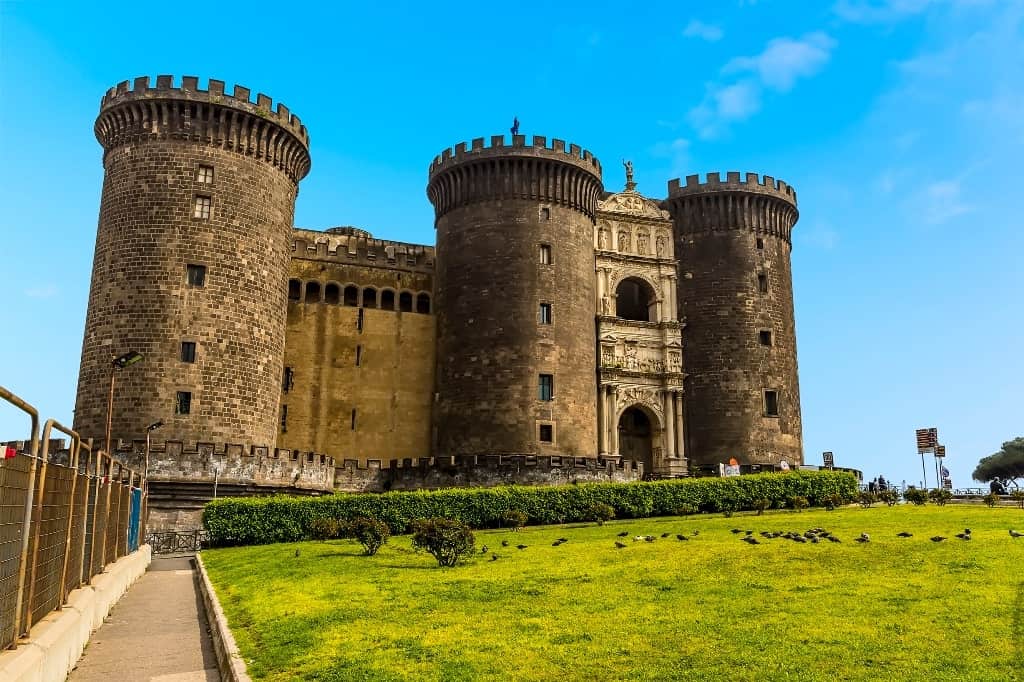
You cannot go to Naples without eating pizza, as its the birthplace of the world’s most recognisable food. The best place to get a piece of Neapolitan pizza is in Spaccanapoli, the historic core of the city, where you can watch the pizza being made the traditional way.

There are 2 places I recommend for Pizza in Naples:
- L’Antica Pizzeria da Michele – This is the pizzeria where Julia Roberts ate pizza in Eat Pray Love. It has cheap delicious pizza but long queues. Via Cesare Sersale 1
- Gino Sorbillo – Another popular place for pizza in Naples the queues here are very long we waited for more than 1 hour standing. You have to give your name at the entrance and wait to be called. Via dei Tribunali, 32
Personally, I didn’t think that was the best pizza of my life but it was delicious. For example, the pizza I had in Capri was equally delicious.
3 days in Naples: Day 3
One your third day in Naples, spend the morning at Pompeii, one of the most well-preserved archaeological ruins in the world, and the afternoon in Sorrento.
Pompeii is a vast archaeological site near Naples. Located at the foot of Mount Vesuvius, Pompeii was buried, along with many of the residents, in 79 AD when the volcano erupted, spewing ash and pyroclastic flow over a widespread area.
The city was founded in the 7th or 6th century BC, capture by the Etruscans and later the Greeks, before becoming a Roman colony in the 1st century BC. Because the entire city was buried in the ash, it’s remarkably well-preserved and gives a unique glimpse into 1st century life. Pompeii is the only ancient city whose ruins remain exactly as they were when founded or expanded, without any other later inhabited overlay.
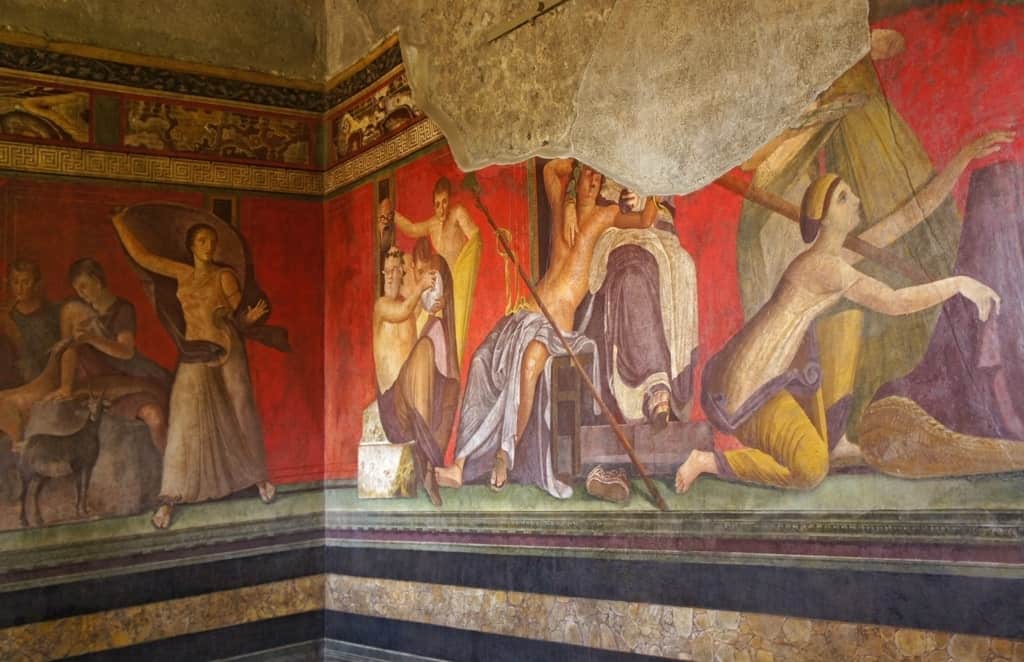
It was discovered in the 16th century and again in the 18th and is one of the premier visitor attractions in Southern Italy. Pompeii can be either a day trip from Naples, or a half day trip combined with another destination like Sorrento.
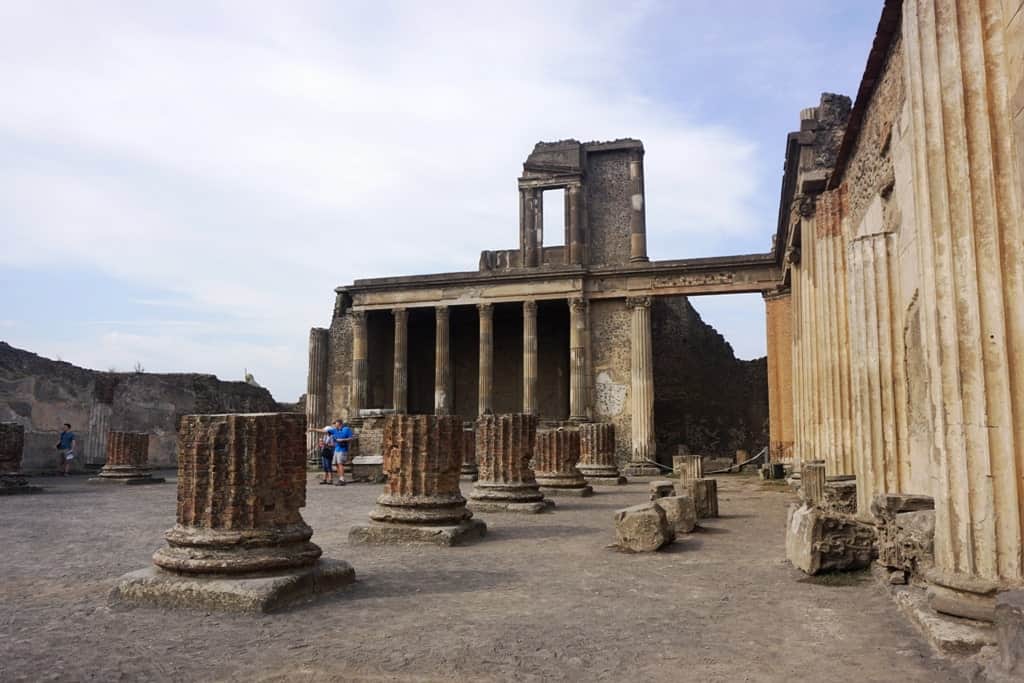
There will be queues in Pompeii so booking in advance allows you to get in quickly and not waste your time otherwise be there as soon as the archaeological site opens.
Here are a few options that I recommend:
- If you want just to skip the line and see the archaeological site on your own I suggest that you buy a fast track entrance ticket .
- If you would like to do a guided tour and also skip the lines I suggest this 2 hour skip the line guided tour .
- If you are looking for an organised skip the line guided tour starting from Naples I suggest this full day guided tour that combines a visit to the Pompeii ruins and the mount Vesuvious .
No matter how you choose to visit the site, know that it is very busy especially through May to October. Bring a hat and a sunscreen, wear comfortable shoes and drink plenty of water.
Sorrento is an Italian resort town, located very close to Naples and easily accessible for a day trip. It is also perfect for an addition to a half day at Pompeii, like we did on our three day itinerary to Naples, because of the proximity. As the gateway to the Amalfi Coast, Sorrento is a bustling small town with plenty of cafes, restaurants, and bars, as well as boutique shops and luxury hotels. Ferries from Sorrento go to both Capri and Ischia, two resort islands in the Bay of Naples. Sorrento is also known for limoncello, which is a must-taste while here. At some places, you can watch it being made.
Check out: A guide to Sorrento, Italy.
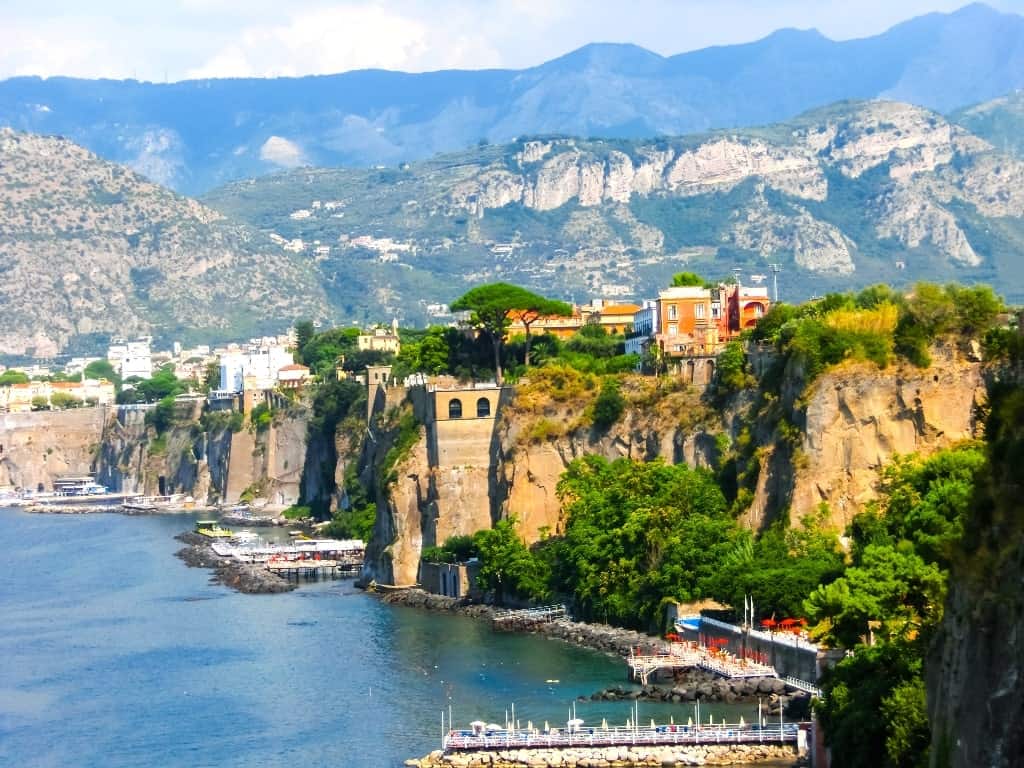
Other Day Trips from Naples
The Isle of Capri is well known for its resort vibe, luxury shops (think Rodeo Drive), and the Blue Grotto. Ferries run daily from Naples, Sorrento, Positano, Amalfi, or Ischia. There’s more to do on Capri than just eat, drink, and be merry; hike the circumference of the island (which very few people do) or rent a boat and circumnavigate the island.
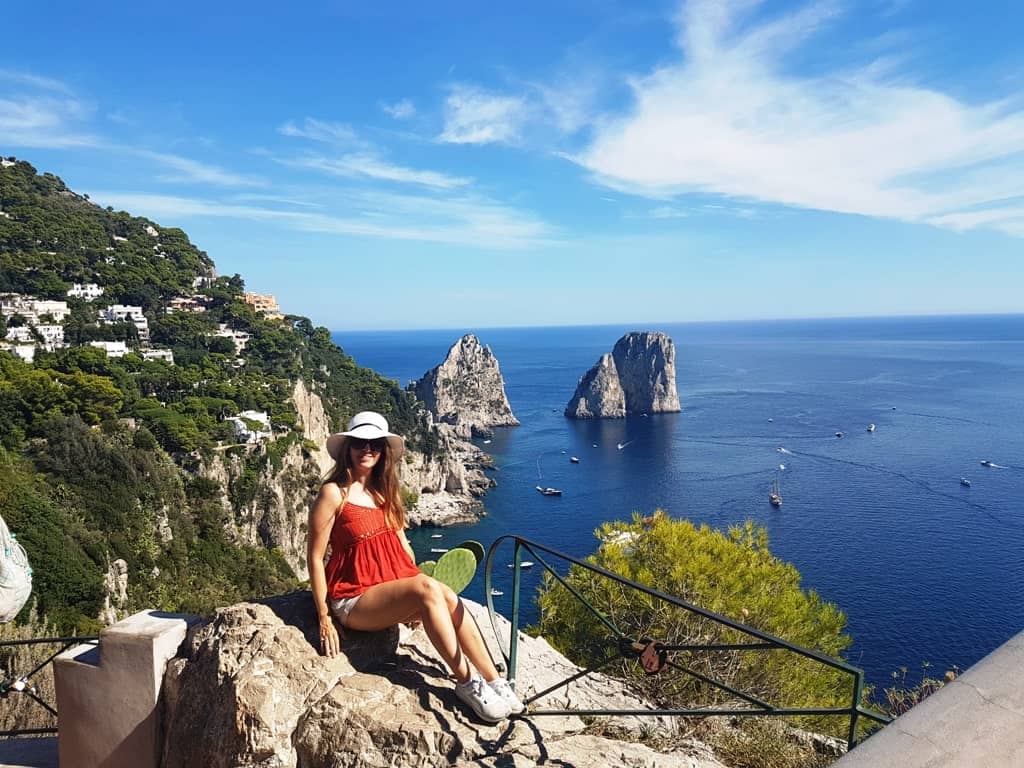
You might be interested in my post: The best things to do in Capri .
To get to Capri is very easy. You can get a ferry from Naples port or even Sorrento if you are based there. The fast ferry takes 50 minutes to Capri from Naples and tickets cost around 21,50 euros one way.
Alternatively, you can book a full day tour to Capri from Naples.
Ischia, the largest island in the Bay of Naples, is not as famous as Capri. Its well known for its thermal pools, healing waters, and beaches, but visitors should also make time for the gardens and villas on the island, many of which are open to the public.
Click here for more information and to book a day trip from Naples to Ischia.
Amalfi Coast
The mere words “Amalfi Coast” conjure up images of colourful towns barely hanging on to the sides of the cliff. Surrounded on three sides by the sea and one side by the lush forests of southern Italy, the coastal towns of the Amalfi coast are worth seeing at least once.
Click here for more information and to book a day trip from Naples to the Amalfi Coast.
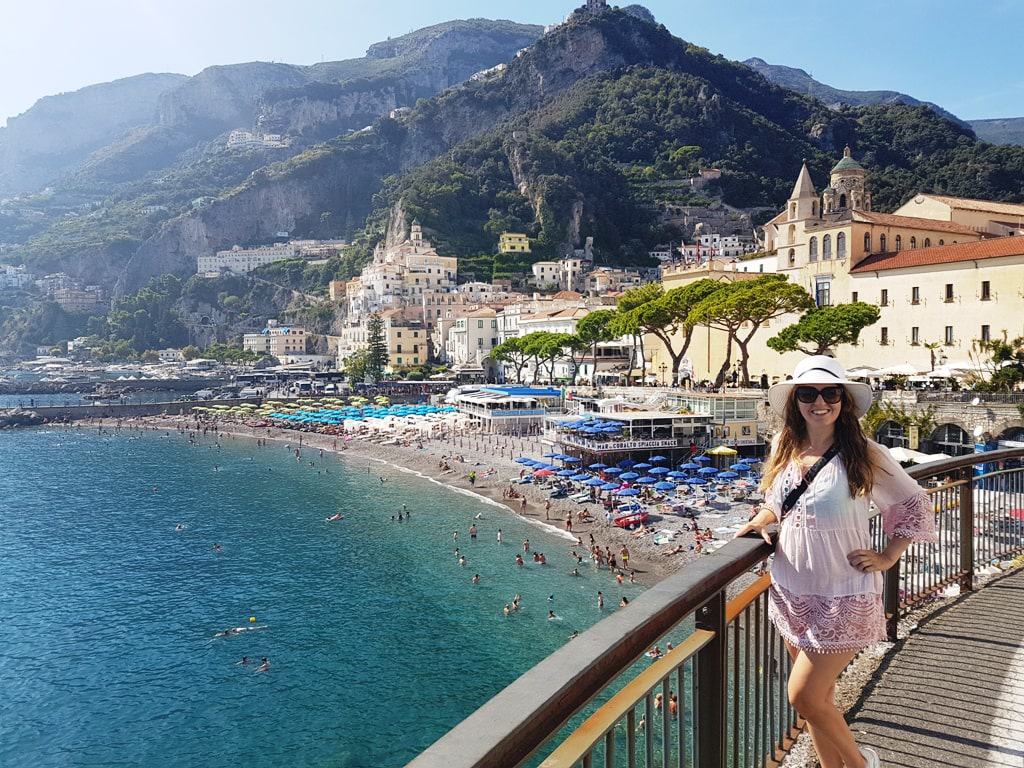
Alternatively, it is easy to do this day trip on your own as well. You just need to catch a train to Sorrento from Naples. There are about 3 trains per hour depending on the season and the journey is about an hour depending on the type of train. As soon as you exit the train station there is a kiosk where you can buy a bus ticket to either Positano or Amalfi.
The buses are in front of the station and tickets cost 2-3 euros one way. It takes around an hour to get to Positano by bus as the road is small and there is huge traffic especially during the summer and you need even more time to get to the Amalfi village because it is further away. Also, during the high season, the queues to take the bus are huge and you might have to ride standing. Also, the road is very curvy and a lot of people get sick.
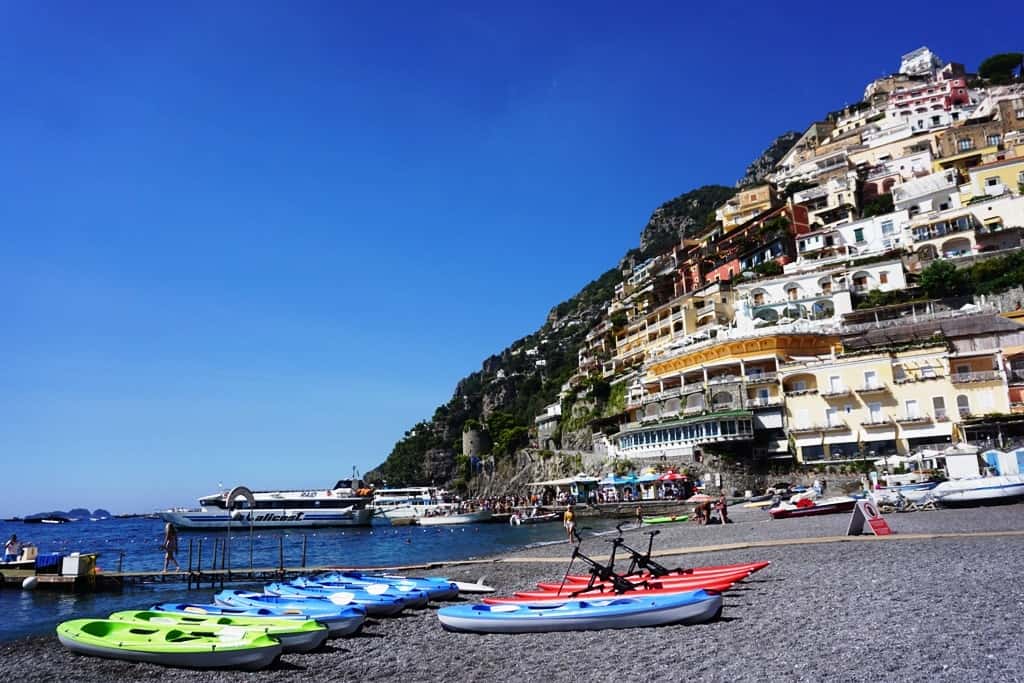
There is an alternative way to get to the villages, which is by ferry from Sorrento. You can get the ferry from the port. It is a 10- minute walk from the train station. From Sorrento to Amalfi it is one hour by ferry and the ticket was 16 euros in September that I visited. The ferry makes also a stop in Positano before arriving in Amalfi. There are many small boats connecting Positano with Amalfi and the other villages of the Amalfi Coast. Tickets can be bought at each port.
Check out my posts:
- Where to stay in the Amalfi Coast
- The best towns to visit in the Amalfi Coast
- A 5 to 7 day Amalfi Coast itinerary.
Herculaneum
Herculaneum lies near Pompeii, another town devastated by the pyroclastic flow of the lava and ash in 79 AD. By all accounts, Herculaneum was wealthier than Pompeii, evidenced by the richer colours and finer houses. This can be done as an independent day trip from Naples or as an addition to a half day at Pompeii.
Click here to book your skip the line tickets to the Herculaneum.
Where to stay in Naples
Renaissance Naples Hotel Mediterraneo
This 4-star hotel, a member of the Marriott Group, is located centrally close to the main attractions of Naples and the ferry terminal. Rooms are comfortable and modern while the rooftop where breakfast is served has lovely views of the Bay, Castel Nuovo, and Mount Vesuvius.
Click here for more information and to check the latest prices.
Grand Hotel Europa – Sea Hotels Group
Located near the main station, this hotel is an excellent choice for those thinking about visiting Pompeii or the Amalfi Coast. It provides excellent 3-star value with comfortable rooms including Wi-Fi, satellite TV, air-con and safe.
Click here for more information and to book the Grand Hotel Europa.
I absolutely loved exploring Naples! Naples, the pulsing heart of southern Italy, should definitely be in your list of places to visit while in Italy. Plan to spend at least three days in Naples to cover the many attractions listed in my three-day Naples itinerary, along with Pompeii, Herculaneum, or Sorrento, or stay longer to explore some of the surrounding area like the Amalfi Coast, Isle of Ischia, or Isle of Capri. Ciao!
Sharing is caring!
Leave a Comment Cancel reply
Save my name, email, and website in this browser for the next time I comment.

Ultimate Travel Guide for Naples, Italy
Are you planning a trip to naples – italy’s city of pizza, volcanoes, and nativity scenes.
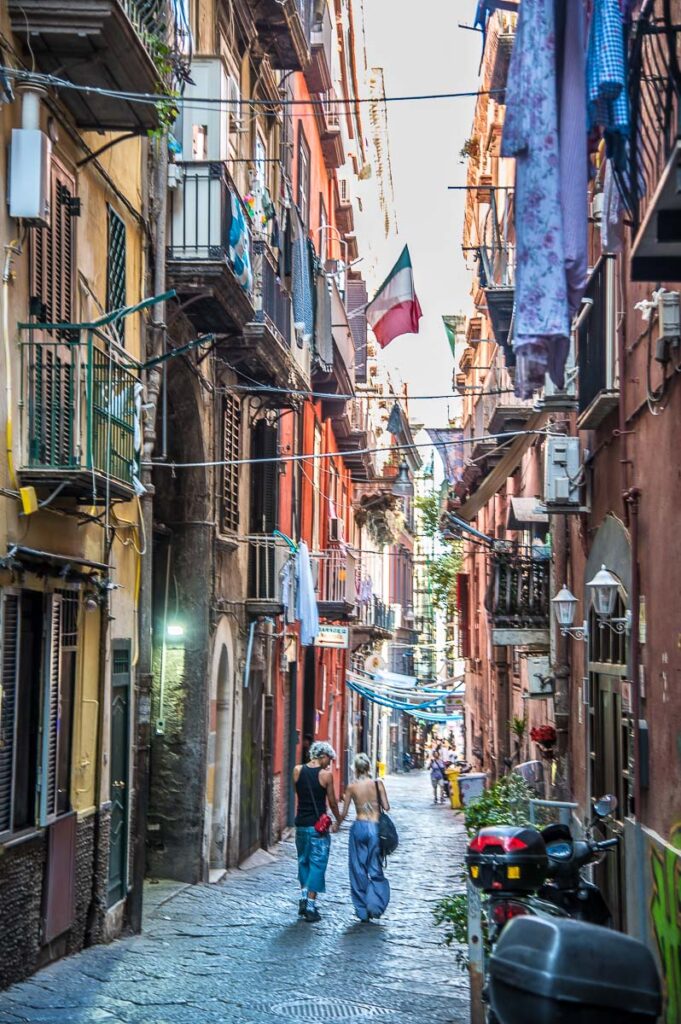
This is my ultimate travel guide for Naples or Napoli , as the city is called in Italian. It’s designed to make your travel planning easy, logical, and enjoyable. It will also help you experience the largest city in Southern Italy in the most authentic way.
Built on a caldera and with a heart as passionate as a volcano, Naples is a vibrant, stimulating place where you can rediscover the joy of life. Good food, strong coffee , excellent art, and quaint experiences are easy to come across here and even a simple thing like the abundance of vibrant colours and the buzzing hubbub of Neapolitan daily life can make you feel alive inside.
Yet, Naples is also one of the most polarising cities in the world. Travellers either sing its praises or don’t spare negative words. Densely built, Naples is a maze of streets many of which can trace their outlines to the city’s ancient Greek urban plan.
Exhilarating and overwhelming in equal measures and often at the same time, the city has been growing with an unstoppable verve for almost three millennia. The result is an immense metropolis that spans the picturesque Gulf of Naples, shoulders the iconic Mount Vesuvius and buzzes with the voices of the million people who call it home.
This is a place that over the centuries has accumulated a staggering collection of architecture and art. They reflect both ancient local traditions and a wide array of outside influences on account of the many foreign rulers that Naples has had. This makes it both Italy’s most international city and the Italian city with the strongest identity.
Naples’ churches, palaces, artisan workshops, and streets tell many captivating stories. You just need to have the ear to listen and the eye to perceive them beyond the graffiti-covered facades, the economic difficulties, and the rubbish bags that pile up on street corners every night.
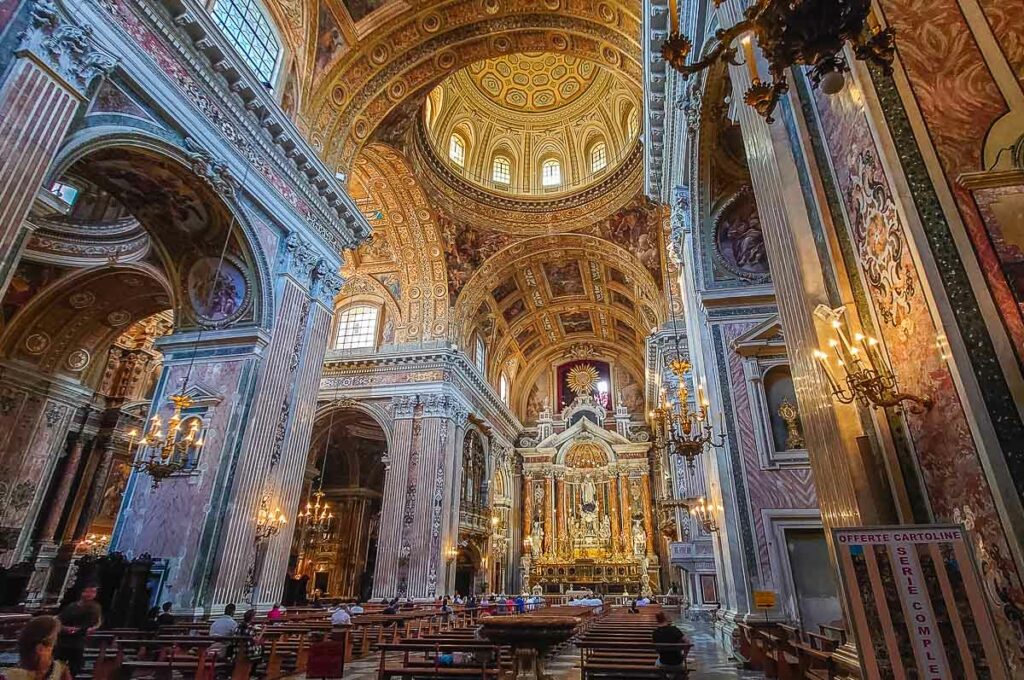
The financial distress that the city experiences obviously puts some travellers off Naples for life. That’s a real shame! For this is a raw and real place, far from the polished images that social media deals with, and yet full of energy and with hidden depths.
Take Naples at face value and you will see that while it’s not picture-perfect, it influences us on many levels. Over the last three millennia, the city has originated fables, movements, and trends time and time again. Its heritage speaks volumes. To see and experience everything that Naples has to offer – from ancient ruins and modern art to food and coffee rituals – would take a lifetime.
In other words, more than a city, more than a destination to visit as a tourist, Naples is a state of mind. As such, come here with an open heart and ready to discover things about history, art, beliefs, gastronomy, and yourself that may push your limitations beyond your comfort zone.
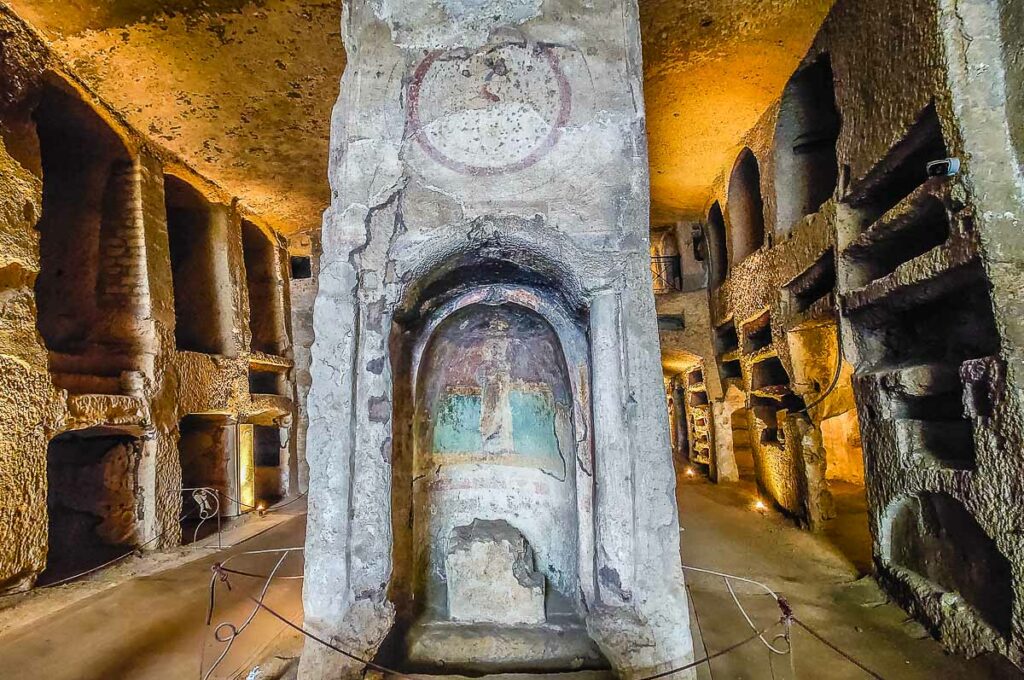
So, to help you plan your trip to Naples, I have researched, photographed, and written this ultimate travel guide. Scroll down and browse through its sections. All the usual topics like how to get to Naples, where to stay in Naples, what to eat in Naples, and what are the best things to do in Naples are covered.
In addition, you will find my answers to many more pertinent and curious questions. For example:
- Is Naples safe?
- Where to see the best presepi in Naples?
- How to explore Naples with kids?
- What are some hidden gems to discover in Naples and what day trips to take nearby?
I have included maps, lots of practical details, and numerous real-life photos to give you an idea of what to expect. You will also find the best times to visit Naples, tips for navigating this traffic-heavy city, and practical packing suggestions. These are followed by the best guidebooks and books for Naples, the best tours you can take here, as well as a list of the artisan Neapolitan products to shop for.
Scroll down to the end of this guide to see my top five tips for visiting this stimulating on so many levels city in Southern Italy. Finally, read the five things you should never do in Naples. They are always good to keep in mind!
Have a look and enjoy your Naples trip!
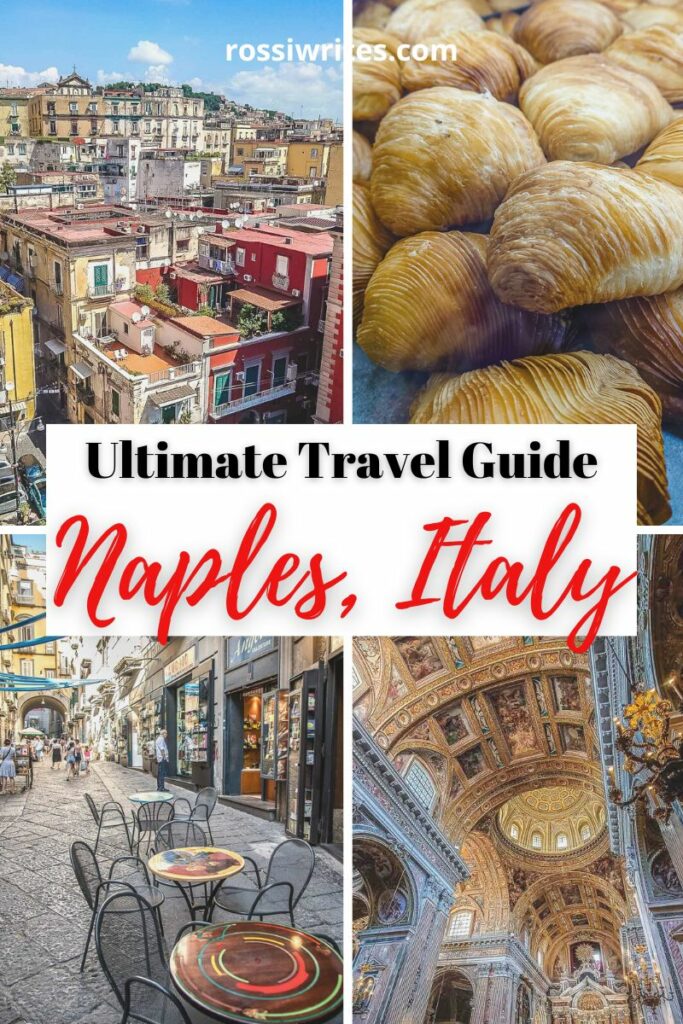
The information in this travel guide reflects my first-hand experience. It may contain affiliate links and if you click and make a purchase through them, I may receive a small commission at no cost to you. The ads on this page help me keep this blog free and produce new travel content for you to enjoy. Full details in my Disclosure .
WHERE IS NAPLES?
Naples is the largest city in Southern Italy and the capital of the Italian region of Campania. With just under a million people living here, it is the country’s third-largest city after Rome and Milan .
It lies along the Gulf of Naples – a 15-km wide bay along the southwestern coast of Italy. The densely built-up city sprawls from the supervolcanic area of the Phlegraean Fields ( Campi Flegrei ) to the iconic Mount Vesuvius.
The adjacent map shows you the city’s exact location in Southern Italy. You can click on it to zoom in and out in order to see further details.
Naples ranks among the ten most visited cities in Italy. It attracts just over a third of the number of tourists that head to the country’s most popular destination – Venice .
The city has an incredibly rich offering in terms of historic and artistic heritage. Its gastronomic traditions are at the basis of several worldwide famous and beloved dishes topped by pizza.
Naples is a must-see place in itself. It also offers quick and easy access by road, sea, and railway to several other popular destinations in Italy. From the historic ruins of Herculaneum, Pompei, Pozzuoli, Capua, and Paestum to the picturesque coastal towns of Amalfi, Positano, and Ravello, Naples is the starting point for many exciting and enriching trips in Italy. A ferry ride from Naples away, you can also visit the beautiful islands of Capri, Ischia, and Procida.
IS NAPLES WORTH A VISIT?
The short answer is yes, Naples is very much worth a visit. Almost three millennia old, the largest city in Southern Italy is a vibrant stimulating place dotted with iconic must-see sights and offering the best cuisine this side of Europe.
Hugging the curve of the Gulf of Naples and sprawling in the shadow of the infamous Mount Vesuvius, this city has a passionate character marked by sharp contrasts.
Built on several layers – from ancient catacombs to multi-storey Baroque palaces and modern-day skyscrapers, in Naples, the past, the present, and the future blend into an exciting synthesis.
This is a city where you can walk along streets which follow the outline of ancient Greek and Roman roads, where deeply entrenched superstitions and folk traditions mingle with the most heartfelt Catholic faith, and where dishes made of simple seasonal foodstuffs have been elevated to nourishment for the soul.
Naples is also a place where poverty exists right next to the most splendid pinnacles of European architecture and art; where people ride pillion with no helmets on (and sometimes have their dog on the scooter, too); where the crowds, the smells, the colours, the graffiti, and the constant play of shadows and light in large courtyards and narrow streets make you suddenly feel reenergised, full of purpose, and ready to live your most exciting life.
Yes, Naples is worth a visit as here you never know what to expect next. Around every corner, there is a new surprise. It could be the Immacolata Obelisk which, they say, at sunset reveals Death holding a sickle. Or it could be the Sanfelice Palace that seems plucked out of an Escher’s print.
In fact, Naples is worth numerous visits as there is always something new to see and experience here, a new wave of excitement to wash all over you. It is one of those precious places that make travelling an adventure that you’ll remember and recall with love and passion when the humdrum of daily life gets too much.
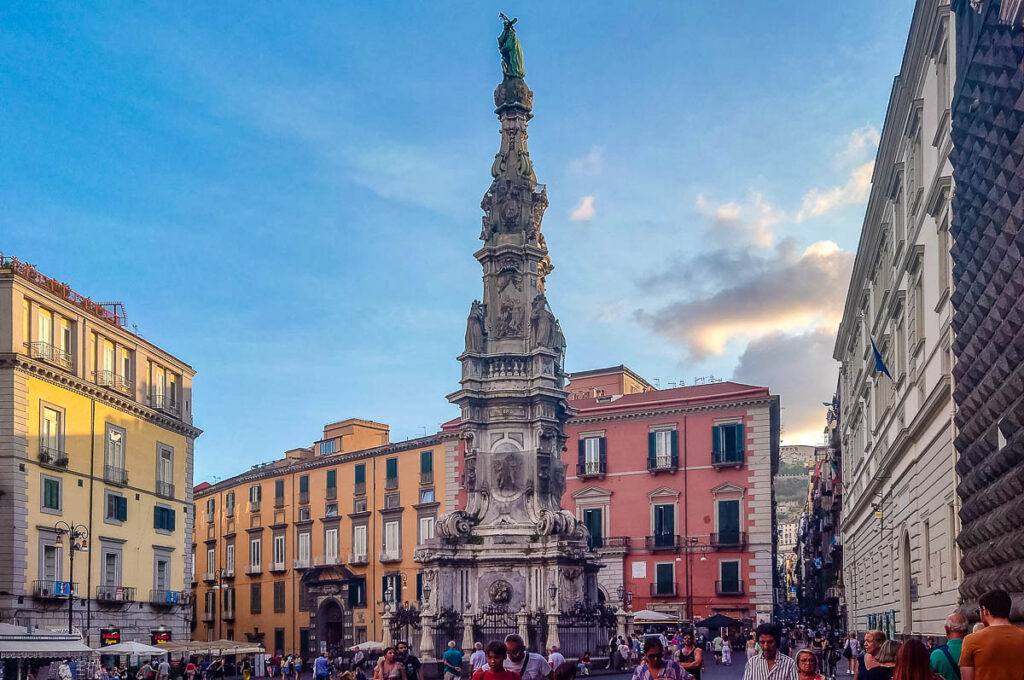
WHAT IS NAPLES CALLED IN ITALIAN?
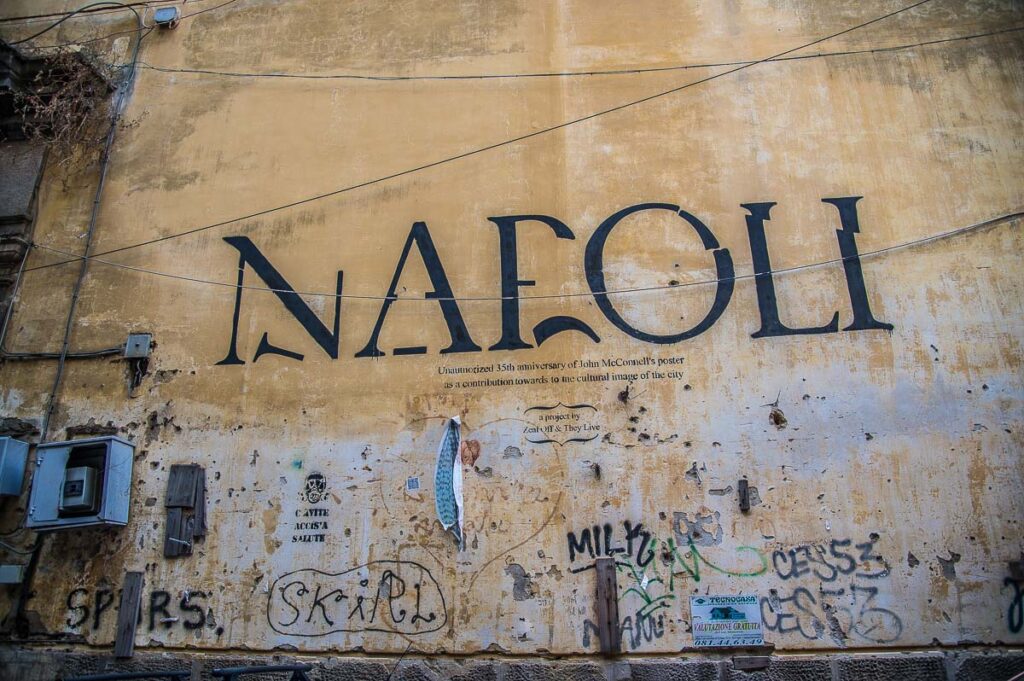
In Italian, Naples is known as Napoli . In the Neapolitan language , the city is called Napule . In both cases, the accent falls on the first syllable. Both Napoli and Napule have evolved from the Ancient Greek name of the city – Neapolis, meaning ‘New City’.
Naples is also sometimes referred to as the città dalle 500 cupole , or the City of 500 domes in English, on account of the large number of churches dotted along its streets. Another of Naples’ monikers – città dei sette castelli – is also linked to its architectural heritage. The locals claim that theirs is the only city with seven castles in the world.
La città obliqua is a poetic reference to Naples, too. It comes from a famous song by the singer-songwriter Edoardo Bennato who was inspired by the unique Neapolitan landscape – neither entirely horizontal nor fully hillside. And so he sings:
It’s not flat, it’s not vertical it is a line that goes up the hill it is a road that starts from the sea The path of the oblique city.
More often than not, however, you will hear napoletani refer to themselves as partenopei and to their city as the città partenopea or the Parthenopean City. This is based on the foundation myth of Naples which is linked to the siren Parthenope – a mythical creature with a bird’s body and woman’s head.
Parthenope had a beautiful voice. Sailors were so bewitched by her singing that they would forget to steer their ships which would then crash against the rocky shore of what nowadays is known as the Sorrento Peninsula.
To avoid a similar fate, the Greek hero Ulysses made his men plug their ears with wax and bind him to the mast of his ship. This way, he could enjoy the siren’s song without sacrificing his ship and his crew.
Unable to make Ulysses fall in love with her and thus lure him to his death, Parthenope threw herself off the rocks. Her body washed on the island of Megaride where the local people found it and buried it. A settlement carrying the siren’s name quickly grew around her burial site. It was also known as Palaepolis (Old City) as around 470 BC, Neapolis (New City) was founded right next to it by Greek settlers.
Nowadays, Naples has expanded significantly beyond the limits of the original Palaepolis and Neapolis. The island of Megaride, today is a peninsula in the Gulf of Naples and houses the city’s oldest fortress – Castel dell’Ovo .
Finally, as you saw at the start of this Naples travel guide, I called it the City of Pizza, Volcanoes, and Nativity Scenes. The first is self-explanatory as the pizza napoletana is famous all over the world (especially the Naples-born pizza Margherita prepared with tomato sauce, mozzarella cheese, and basil leaves). With the volcanoes of the Phlegraean Fields and Mount Vesuvius playing a major role in the geology and the history of the area, the second part of the moniker is also clear.
As for Nativity scenes, Naples is famous for its tradition of artisan presepi . These are intricate Christmas cribs representing the Holy Family in the stables in Bethlehem. Beloved all over Italy, the best ones are handmade in Naples. I mention them in more detail below under the headings Best Presepi in Naples and What to Buy in Naples .
NAPLES AND ITS QUARTERS
Naples is a large sprawling city divided into 30 quarters. Here are the main urban areas to visit in order to see the best that it has to offer:
Centro Storico – a UNESCO World Heritage Site , Naples’ historic centre is a vast area in the heart of the city where you will find the most famous landmarks – from the Veiled Christ in the Sansevero Chapel and the tiled cloister of the Monastery of Santa Chiara to Piazza del Plebescito and the Royal Palace. Follow Spaccanapoli – the long artery of straight streets that flow one into another and in the process splits the city in two. Look out for the large obelisks dotted along its route. Stuff yourself with pizza in all its Neapolitan varieties along Via dei Tribunali . Dodge the constant traffic of scooters and evade the persistent greeters trying to get you to enter their eateries. Find temporary peace and quiet in Naples’ former water cisterns .
Rione Sanità – a former no-go area, this authentic corner of Naples is where you can visit the striking Catacombs of San Gennaro – my absolutely favourite landmark in Naples. A short walk away don’t miss the macabre Catacombs of San Gaudioso underneath the resplendent Basilica of Santa Maria della Sanità. The Palazzo dello Spagnuolo and the Palazzo Sanfelice are a must for lovers of architecture.
Quartieri Spagnoli – with a name that is a throwback to when Naples was ruled by the Spanish Bourbons, this Neapolitan quarter epitomises the city. Expect narrow streets, laundry flapping above your head, and lots of graffiti. Don’t miss the Pignasecca market – a hub of activity that is quintessential Naples.
Vomero – hop on a funicular for an exhilarating ride to the top of the Vomero hill and enjoy the unparalleled panoramas of Naples flanked by Mount Vesuvius. Then visit the proud Castel Sant’Elmo and the former monastery of Certosa di San Martino .
Chiaia – this upmarket quarter of Naples is a great place to stay in if you want to be close to the sea, the luxury boutiques, and the Villa Comunale expansive lush park.
Santa Lucia – standing right where the original settlement of Parthenope (or Palaepolis) first grew, Santa Lucia is a historic quarter of Naples where you can visit the mysterious Castel dell’Ovo , marvel at the imposing Fontana dei Giganti , and indulge in fresh seafood in the fishermen’s Borgo Marinari .
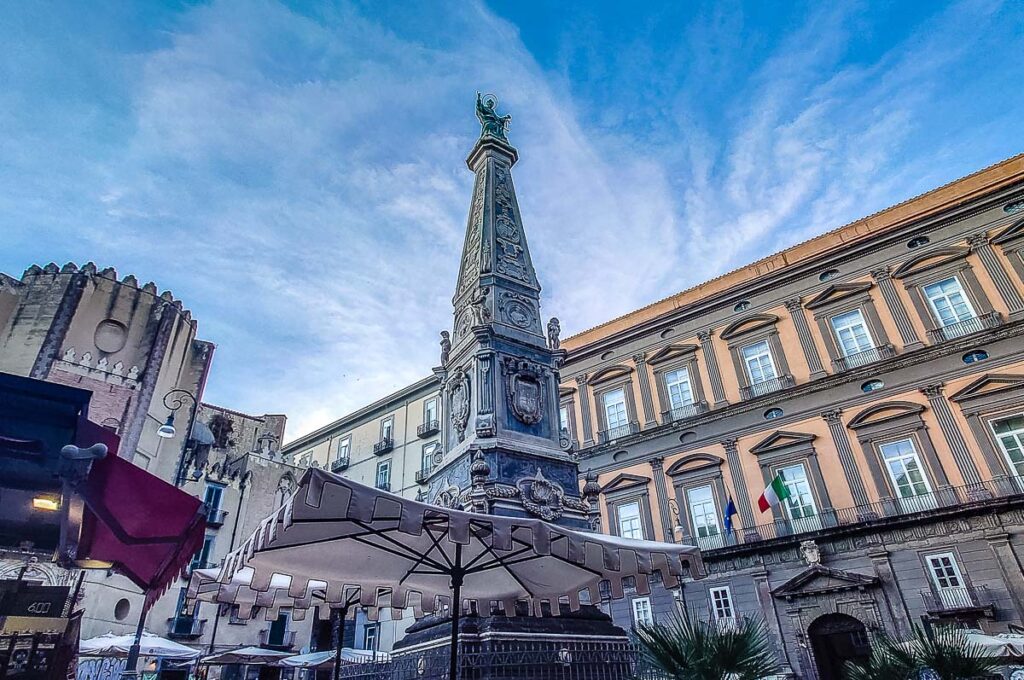
BEST AIRPORT FOR NAPLES
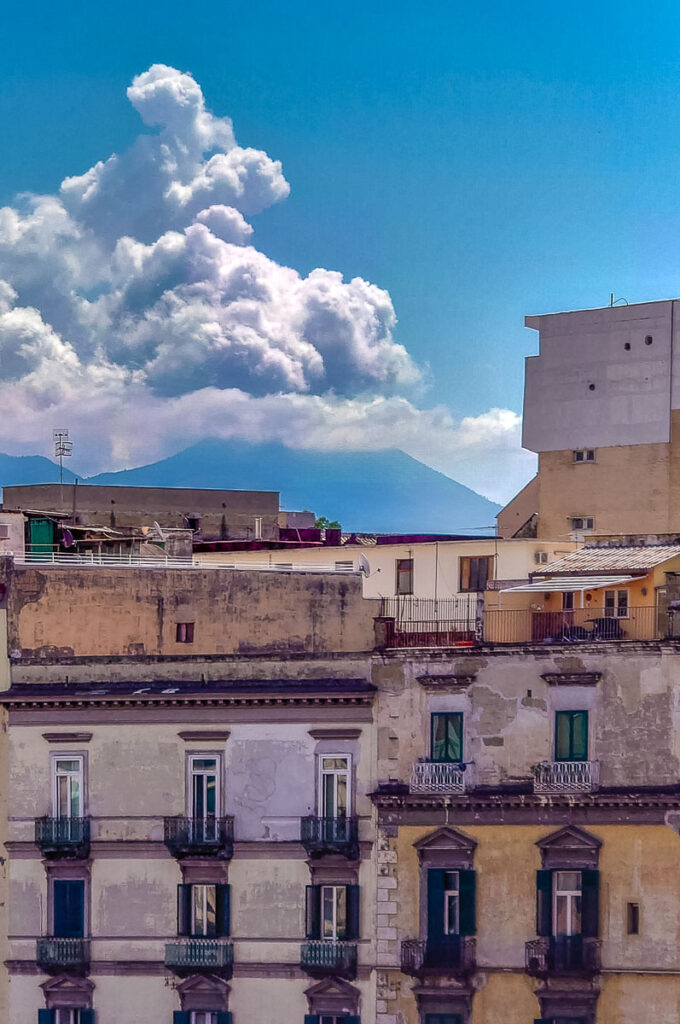
Naples has its own airport – Aeroporto Internazionale di Napoli Capodichino (IATA airport code: NAP). It is one of the busiest airports in Italy and it’s only four km away from the city centre.
It is served both by low-cost and full-service carriers, making Naples easy to reach from all corners of Europe and the world. The flight from London Gatwick, for example, is just over two and a half hours, so Naples is a great destination for a long weekend.
The official website of Naples Airport has a lot of useful information – from how to reach the airport to what shops and restaurants you will find here.
Shopping is excellent with many international chains and high fashion brands having stores here. There are also numerous eateries which is handy especially when you know that you are about to leave Naples and you want to have one last delicious pizza or sfogliatella pastry for the journey ahead.
AliBus is the coach line linking Naples Airport to the city centre. You can take it either to:
- Piazza Garibaldi – in front of the city’s main train station, Napoli Centrale ; or
- Port of Naples – a short walk away from the centrally located Piazza Municipio .
We were lucky as we were met by a friend of a friend upon our arrival in Naples. He drove us to the flat we had rented in the historic centre giving us our first taste of the famous Neapolitan driving style.
On the way back, we found getting a taxi to reach the airport from the historic centre very handy as we were lugging a heavy suitcase. The journey door to door took less than half an hour and cost us around 30 euros.
HOW TO REACH NAPLES?
Naples is very easy to reach by railway, road, and ferry from anywhere in Italy and abroad.
High-speed and regular trains connect Naples all throughout the day to many towns in the region of Campania and major cities all over Italy. You can check timetables and book your tickets on:
- Omio – which pulls up results for both state-run and private railway companies in Italy;
- TrenItalia – which covers the state-run train network of Italy.
Here are some sample travel times by high-speed train from the Italian capital and other large Italian cities to Naples’ main train station, Napoli Centrale :
- Rome to Naples – from 1 h 13 mins;
- Florence to Naples – from 3 h;
- Bologna to Naples – from 3 h 31 mins;
- Milan to Naples – from 4 h 45 mins;
- Venice to Naples – from 5 h 22 mins;
- Turin to Naples – from 6 h 3 mins.
The following ferry companies connect Naples to the nearby islands of Capri, Ischia, and Procida, the Aeolian Islands, as well as to the towns on the Amalfi Coast and further away destinations like Sicily: SNAV , Caremar , and Medmar .
You can drive to Naples from anywhere in Italy, too. Toll roads (called autostrada , sing. and autostrade , pl. in Italian) connect the city to other large Italian cities and smaller towns. Here are the autostrade you can use here:
- A1 Autostrada del Sole – Milan to Naples
- A3 – Salerno to Naples
- A16 – Canosa to Naples
- A56 Tangenziale di Napoli – this is Naples’ ring road from Arco Felice to Capodichino
This useful website will give you up-to-date information about navigating Italy’s autostrade , the current traffic conditions, as well as how to calculate and pay the toll fees (called pedaggio in Italian).
If you are planning to visit Naples by car, you need to prepare yourself mentally for the busy traffic and the assertive driving style of the city. Make sure that your car insurance covers all eventualities. Ideally, arrange for a parking space in advance. Some travellers report that in some corners of the city, you may be asked to pay an additional fee to have your car ‘looked after’.
It is also advisable to familiarise yourself with Naples’ ZTL or zones with restricted traffic which can be traversed by car only if you have a special dispensation. This website may come in useful when you look into ZTL and the respective restrictions.
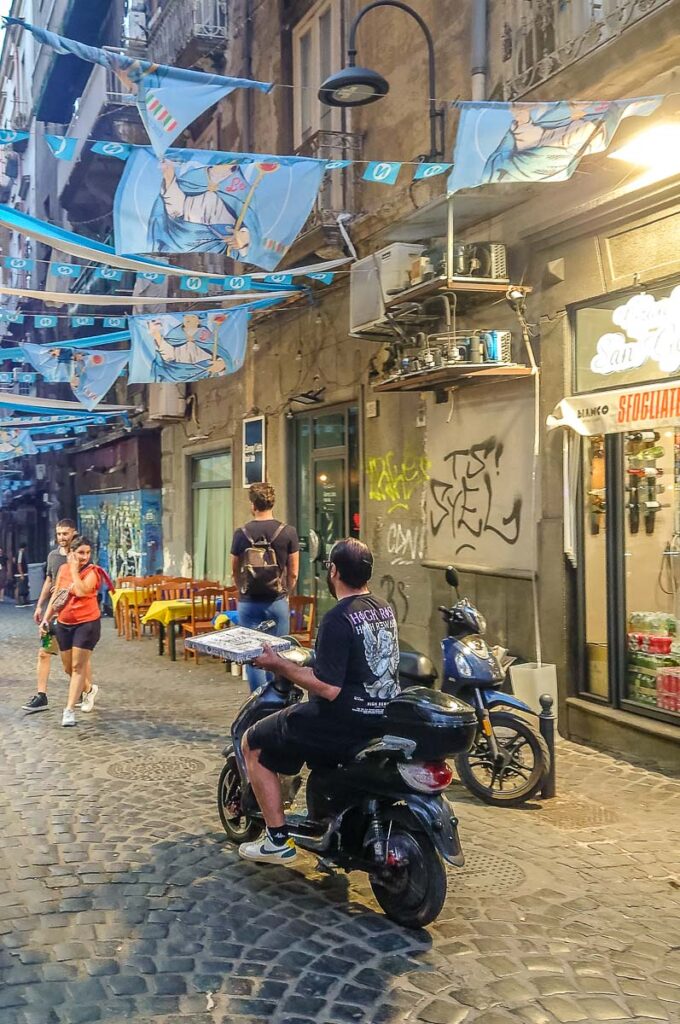
HOW TO NAVIGATE NAPLES?
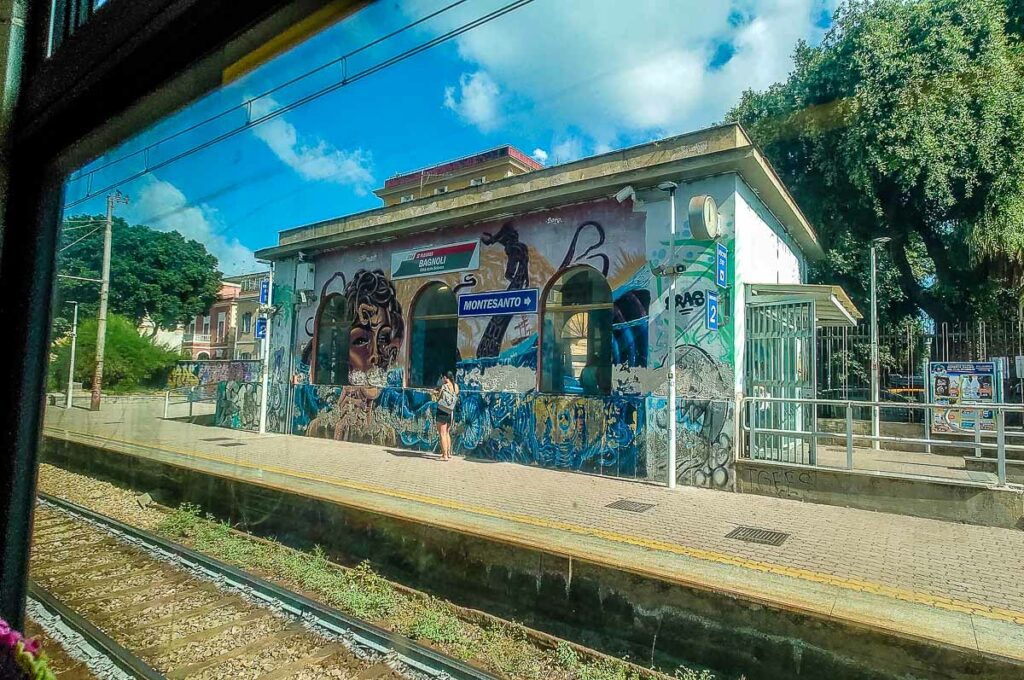
You can navigate Naples on foot as well as by bus, metro, funicular, and taxi. In some parts of the city you can get a tram and/or a trolleybus. There are also regional trains which connect Naples to several adjacent suburbs, towns, and landmarks nearby.
Naples’ historic centre and quarters are best explored on foot so that you can fully immerse yourself in their atmosphere. The narrow streets here often lack pavements and at all hours of the day experience a hectic flow of scooters, delivery vans, and cars. It pays to be vigilant at all times, especially next to turns and corners. Drivers are skilled but very impatient and expect you to move away asap. Otherwise, they keep pushing forward and whizz right past you.
Buses (as well as metro lines, trams, and trolleybuses) are very convenient if you want to save time walking from one quarter to the next. For example, we took a bus from the edge of the historic centre to the top end of Rione Sanità – a journey which took us about 15 minutes (inclusive of walking to the bus stop and time waiting for the bus) instead of the 30 minutes which walking there would have taken us.
Four funiculars connect Naples’ lower grounds to its hilly parts. They are very handy, especially on a hot day when you can’t bear to walk uphill for miles.
For up-to-date information about public transport in Naples, have a look at the official websites of Comune di Napoli and ANM – Agenzia Napoletana Mobilita . You will find exhaustive information about the different ways to travel here either by bus , funicular , metro , tram , or trolleybus , as well as about the different types of tickets and where to purchase them. At present, the websites seem to be only in Italian, so you may want to use Google Translate to get the gist of the information.
Taxis circulate through the historic quarters and can quickly take you anywhere in Naples, as well as to the nearby archaeological excavations, picturesque towns, and even Mount Vesuvius. You can download an up-to-date rate table from the official website of Comune di Napoli .
To reach the excavations of Herculaneum and Pompei by public transport, you will need to get the Circumvesuviana regional train. Use the EAV – Ente Autonomo Volturno’s website to check prices and timetables. There is a useful section in English.
To reach the towns and the archaeological parks in the Phlegraean Fields ( Campi Flegrei ), use the EAV website, too and check the timetables for the Cumana and the Circumflegrea train lines.
WHAT TO PACK FOR NAPLES?
The most important thing to pack for a visit to Naples in any season is a pair of comfortable shoes. You will be walking long distances over all types of historic surfaces many of which are uneven. You will also spend time standing up and moving at a variable pace over long periods of sightseeing.
Make sure that your feet are as comfortable as possible. Choose shoes with a good grip that cushion your heels and support your ankles at all times. Even on the hottest of days, it’s advisable to wear closed shoes or shoes that at least cover your toes, especially if you are planning to explore the historic centre, Rione Sanità , or the Quartieri Spagnoli as they are very busy and spillages next to markets and small businesses may occur.
In winter, bring warm layers to stave off the chills produced by the high levels of humidity and yet can be quickly peeled off when the sun makes an appearance. In summer, bring a hat, sunglasses, and suncream to counteract the bright sunlight that bounces off the large facades and floods the wide piazzas. Invest in fabrics that dry quickly, are crinkle-free, and let your skin breathe through them. A rainproof jacket will come in handy in autumn when rainy days are plenty.
Even when it’s very hot, make sure that your outfits are appropriate for city living and respectful sightseeing. Shoulders and knees should be covered in churches and landmarks. Swimsuits are not acceptable attire on the street.
In any case, don’t overpack as navigating Naples with heavy luggage can be difficult, especially if you are planning to use the busy public transport. Instead, select pieces that can be matched with one another, producing outfits that look different every day but rely on the same small number of core pieces.
Leave expensive and ostentatious jewellery, watches, and accessories at home. Invest in a cross-body bag with a sturdy strap. Put a bottle of hand gel in it as well as your favourite mosquito and bug repellents, albeit a spray, a roll-on or a bracelet .
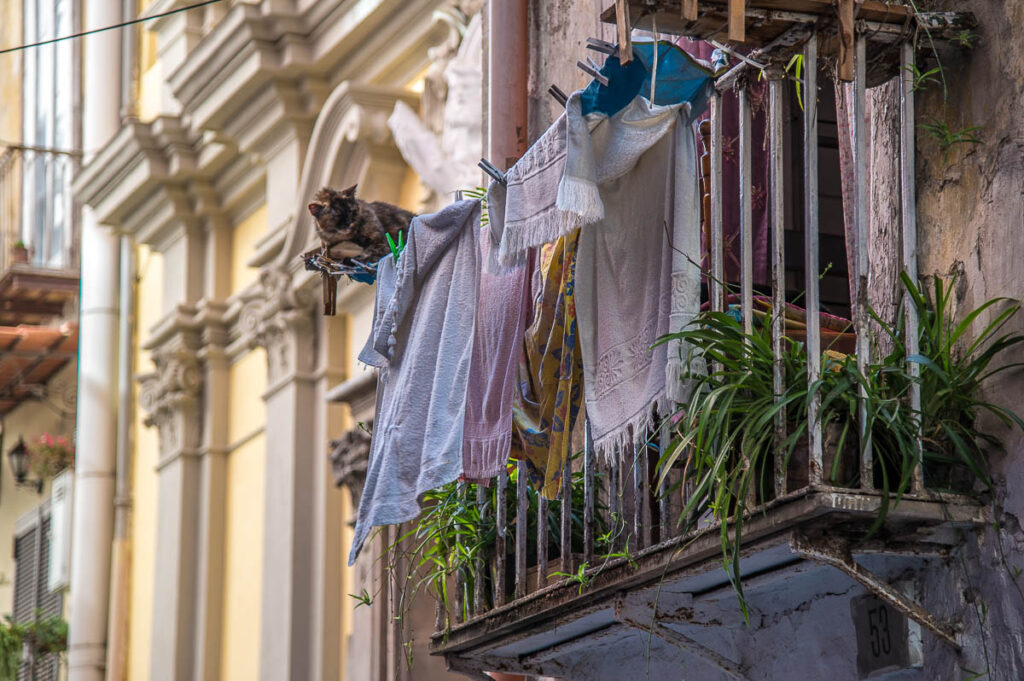
BEST TIME TO VISIT NAPLES
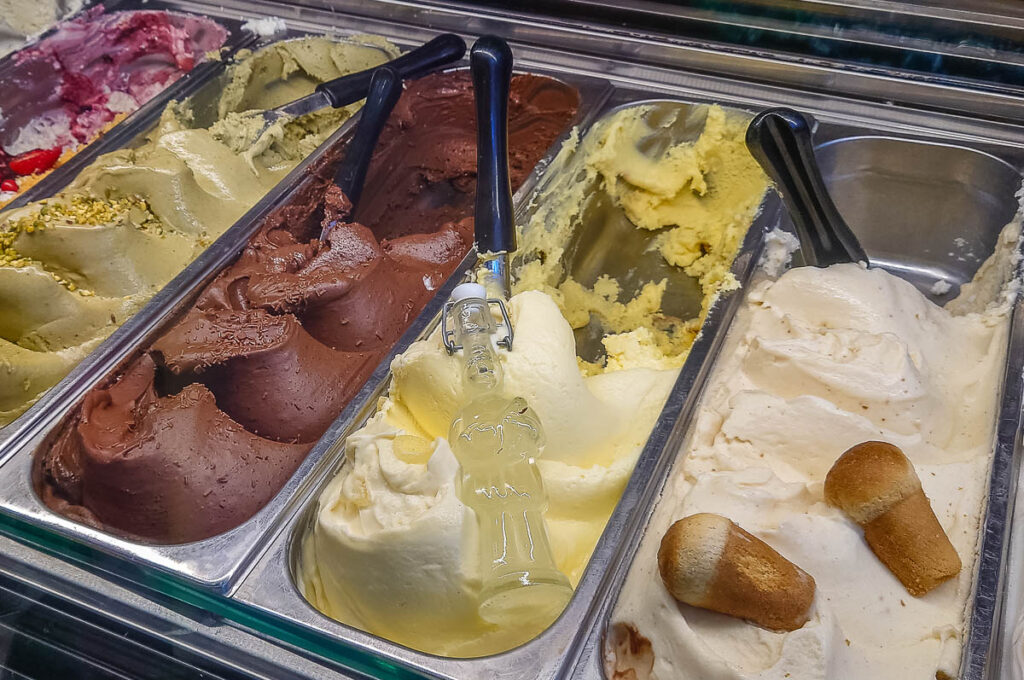
Naples is exhilarating in any season and there are lots of things to do here no matter the weather. So, visiting Naples is always a good idea – from a weekend break to a long holiday, the City of Pizza, Volcanoes, and Nativity Scenes offers an exciting immersion into the art, food, and heritage of this corner of Italy and Europe.
The shoulder season – from the end of March to May and then from the end of September to the start of November – is easily the best time of the year to visit Naples. Expect temperatures between 17 and 27 degrees Celsius and some rainy days but mainly clear skies.
Summers are hot and humid. With temperatures between 30 and 40 degrees Celsius, you will need to pace your sightseeing as being out and about in the throng of tourists and locals can quickly become tiring and overwhelming.
At the same time, summer is when Naples is full of vibrancy and life, so take long gelato breaks, linger over lunch, and commit to no more than two major sights a day (and a couple of smaller ones) to make the most of the sunny days and people-watching. If possible, return to your accommodation in the afternoon for a sweet little nap which will give you strength for a leisurely stroll (called passeggiata in Italian) in the early evening followed by a proper Neapolitan supper.
Winters in Naples are mild in comparison with most of Europe. The thermometer can go as high as 16 degrees Celsius. While this is not sunbathing weather it’s still a welcome escape from the minus temperatures in the northern European destinations. The Christmas season is especially lively. Expect lots of local events culminating in beautiful exhibitions of Nativity scenes and heartfelt celebrations.
You may also want to visit Naples for one of the city’s main festivals. Have a look at the heading Events in Naples further below to see what’s on and when. Then make your travel plans to experience quirky centuries-old traditions.
HOW LONG TO STAY IN NAPLES AND A 4-DAY ITINERARY
There is so much to see and do in Naples, that a plan to visit the city can quickly become an overwhelming jumble of ideas, intentions, and half-baked itineraries.
The best way to approach Naples is to be clear with yourself from the start that the city cannot be seen and done in a day or two and that no matter how long you spend here, there will always be sights and monuments to see on your next visit.
So, don’t overstretch yourself and don’t rush around like mad trying to squeeze in as much sightseeing as you can. Especially, if it is hot! Instead, either:
- focus on a particular period , for example, ancient ruins or Baroque art and architecture;
- pick a couple of Naples’s historic quarters to explore in detail; or
- pencil two major sights a day to see at leisure and then fill the rest of the time with culinary experiences and spontaneous visits to any church, quirky shop, and hidden gem of a landmark you walk past.
In other words, instead of treating Naples as one endless list of sights that you have to tick off, tailor your visit according to your interests, willingness to walk long distances, and your curiosity. Be open to spontaneous experiences and let the city surprise you.
For a first visit to Naples, ideally, I would suggest four full days. These can be as packed up or as relaxed as you wish. Take your pick from this busy four-day Naples itinerary below:
Day 1: Traverse Naples’ historic centre. Pop in and out of churches (Duomo, Monastery of Santa Chiara, and the Church of Gesù Nuovo are a must but there are many more), explore the city’s charming piazzas, walk along Spaccanapoli , take an underground tour , shop for Christmas decorations on Via San Gregorio Armeno , visit some of the major sights here like the Sansevero Chapel and Pio Monte della Misericordia . Later in the afternoon, head to Piazza del Plebescito with Naples’ Royal Palace , as well as Teatro di San Carlo and the elegant shopping arcade Galleria Umberto I nearby.
Day 2: Begin the day with an early morning visit to the Museum and Royal Wood of Capodimonte . Then explore Rione Sanità with the Catacombs of San Gennaro and San Gaudioso , Palazzo dello Spagnuolo , Palazzo Sanfelice, and the Fontanelle Cemetery (when it re-opens). Spend the afternoon in MANN – Naples’ outstanding archaeological museum where you can see Pompeiian frescoes and mosaics, ancient statues, and so much more. If you still have some energy left, end the day in Museo Madre – Naples’ outstanding museum of contemporary art.
Day 3: Spend the day visiting either Herculaneum or Pompeii followed by a hike up Mount Vesuvius . There are many different ways to do it either independently or with an organised tour. To reach the excavations of the two ancient Roman towns, you need to get the Circumvesuviana train. The respective stops are Ercolano Scavi and Pompeii Scavi – Villa dei Misteri . You can buy your tickets for the archaeological sites either in advance to skip the queues or in situ. Once there, if you want, you can pay an additional fee for a private guide or a guided tour or just explore the ruins independently. To reach Mount Vesuvius from the train station Ercolano Scavi , you can get the Vesuvio Express which includes roundtrip transport and a ticket for Vesuvius National Park. There is also a similar option to visit Vesuvius from Pompeii. Otherwise, you can buy tickets for the roundtrip bus and for the Vesuvius National Park separately. Alternatively, you can book a guided tour which takes all three – Herculaneum, Pompeii, and Vesuvius – in a day.
Day 4: Spend your last day in Naples by exploring some of its other quarters. Chiaia, Santa Lucia , Vomero , and the Quartieri Spagnoli offer a vibrant mosaic of sights, smells, and views. Once again, don’t expect to cover all four in a day, so pick a major sight in a couple of them or simply amble through one of them.
This four-day itinerary for Naples will give you a good introduction to everything that this exciting Southern Italian city has to offer. Any return visits to Naples then can be of any length to catch up on anything you have missed and to discover yet more sights, museums, and corners of the city.
In any case, if you don’t have four days to spare and still you really want to see Naples, just come. Even if it’s just on a day trip from Rome. Enjoy your time (however short!) in the city and before you know it you will be making plans to return again and again.
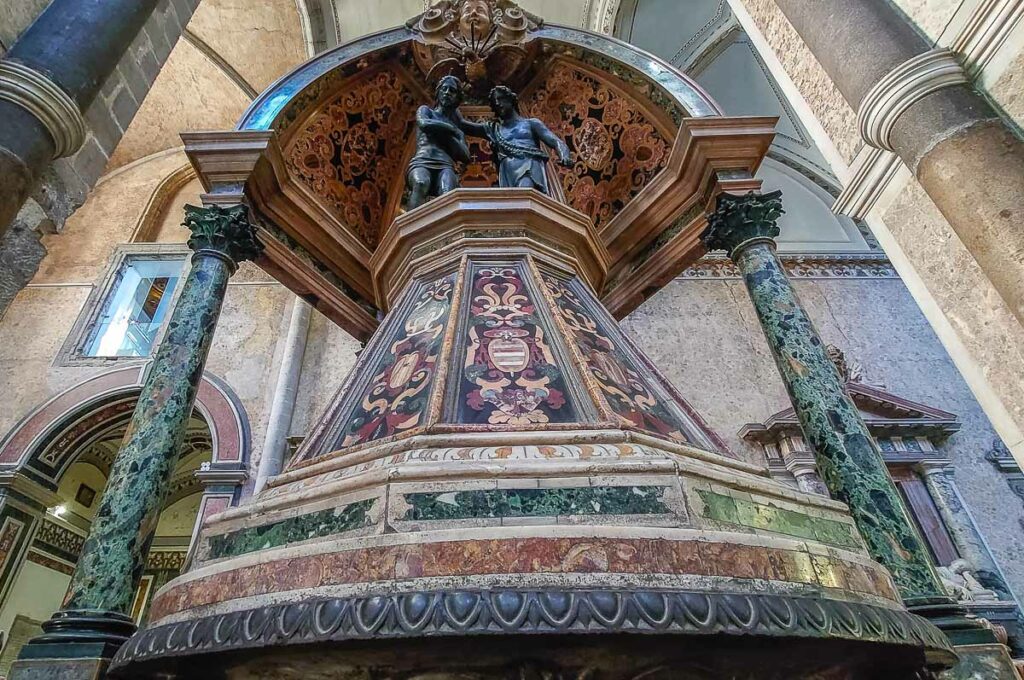
WHERE TO STAY IN NAPLES?
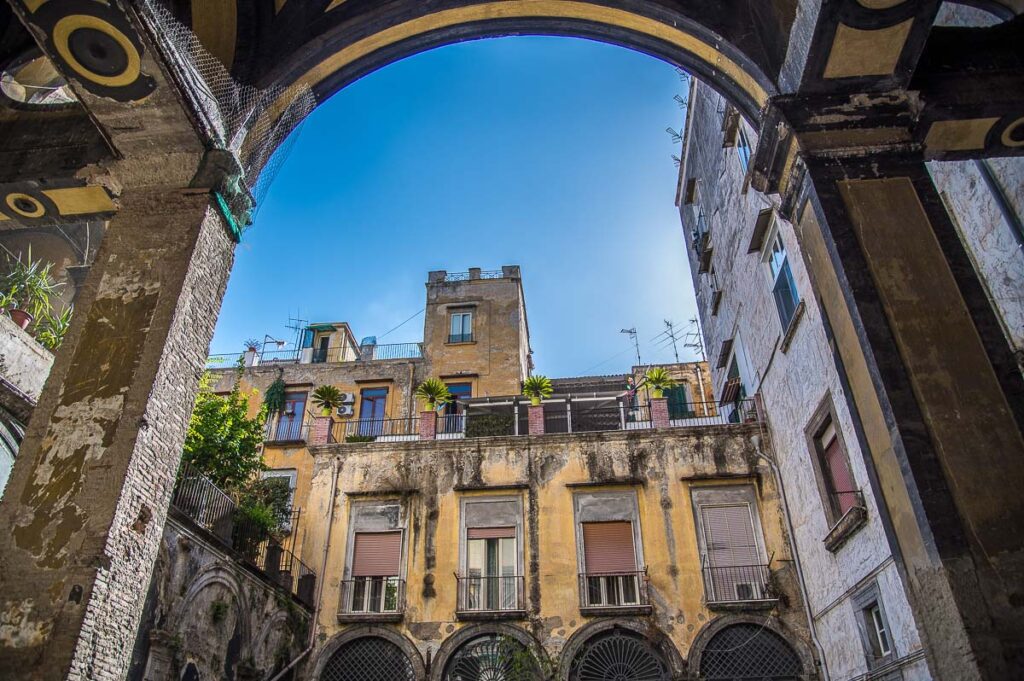
There is a huge selection of places to stay in Naples in any season and for any budget.
You can choose a historic building that nowadays functions as a luxury hotel. You can opt for a comfortable B&B . Or you may prefer an accommodation with its own kitchen to enjoy a home-from-home experience.
When picking accommodation in Naples consider carefully its location. Depending on what you want to do and see here, you may prefer to stay closer to the major landmarks, a bus or metro stop, or in a hidden corner of the city that offers peace and quiet.
If your focus is sightseeing in Naples, then it pays to stay in the historic centre. For more of an upmarket experience, look into the quarter of Chiaia . The area around Piazza Garibaldi and the main train station, Napoli Centrale , is convenient in terms of public transport but it made me feel on the edge every time we needed to walk through it.
Here are some suggestions for places to stay in Naples. All come highly recommended:
Luxury: Grand Hotel Vesuvio , Palazzo Doria Napoli , The Britannique Hotel Naples, Curio Collection by Hilton
Mid-Range: Relais della Porta , Artemisia Domus – Centro Storico , La Lepre Bovio
Budget: Ostello Bello Napoli , Leone Suites Toledo , EMME Napoli
Alternatively, use the map included here to get a quick visual idea of the available accommodation options in Naples, Italy. You can zoom in and out, type in your specific travel dates, and then click on the different price points for detailed information about the hotel you want to know more about.
In addition, have a look at this blog post which explains the different types of accommodation you can book in Italy. It will give you plenty of ideas to look into for the best and quirkiest places to spend the night at here:
- Where to Stay in Italy – 19 Types of Accommodation to Suit Any Budget
WHAT TO EAT IN NAPLES?
Neapolitan food is excellent. Eating here is a great experience that nourishes not just the body but the soul, too. Every meal in Naples has the potential to be absolutely unforgettable. So don’t waste any chances to tuck into yet another delicious local dish.
From inexpensive street food to the freshest seafood and local variations of pasta, Naples has a lot to offer even to the pickiest of eaters.
Pizza is always a good choice in Naples. Deep-fried foods taste so good after a long day of sightseeing. If you have a sweet tooth, you will be delighted with the rich displays of cakes and pastries. And you can finish it all off with a proper Neapolitan coffee prepared with a traditional flip pot called cucumella . Alternatively opt for a local liquor – from the world-famous limoncello to the herbal Strega , a distinctive digestif drink the name of which means ‘witch’ in English.
Here are some of the best Neapolitan foods and dishes to sample during your Italian holiday:
Taralli – this typical for Naples snack is circular in shape and traditionally made of lard, toasted almonds, and black pepper. Nowadays, it comes in many different flavours. Take your pick from the wide selection at Taralleria Neapolitana .
Pizza – you have to have a pizza or two when in Naples! Try as many of the traditional varieties as you can. Take your pick from pizza Margherita (tomato sauce, mozzarella, and fresh basil), pizza Marinara (tomato sauce, extra virgin olive oil, oregano and garlic), pizza fritta (a Calzone-shaped pizza stuffed with different fillings and deep-fried), pizza Montanara (open fried pizza topped with tomato sauce, mozzarella, and basil), and pizza portafoglio (a smaller pizza Margherita or pizza Marinara folded in four and eaten on the go. Or choose any other pizza with classical and innovative toppings offered in Naples’ best pizzerias. Many of them are clustered along Via dei Tribunali in the historic centre. It’s the city’s veritable pizza paradise!
Ziti alla Genovese – this is an iconic Neapolitan dish and it doesn’t have anything to do with the city of Genoa, although there are many theories as to how it got its name. Ziti is a type of extruded pasta typical for the Southern Italian region of Campania of which Naples is the capital. The genovese sauce is made of ground beef, cherry tomatoes, celery, carrots, and lots and lots of onions. It has a slightly sweet taste and it is very more-ish. Order it at La Locanda del Monacone .
Ragù – this Neapolitan meat sauce is absolutely delicious. Tomato-based, it’s made with beef and densely stuffed sausages left to simmer for hours. Try the ragù dishes of Tandem – a famous Neapolitan chain of ragù-centric restaurants. My favourite dish consists of thick slices of provola cheese served with an extra-generous helping of ragù on top.
Cuoppo Napoletano – this paper cone filled up with fried finger foods is proper Neapolitan street fodder. There are two main varieties – cuoppo di terra and cuoppo di mare . The first is a mix of battered and deep-fried chopped veggies, rice balls (known as arancini ), potato croquettes, and my favourite – zeppoline (delicious dough balls). The latter is a mix of battered and deep-fried seafood – from calamari to sardines. Try the cuoppo at Passione di Sofi .
Babà (also babà al rum ) – you will see these mushroom-shaped and rum-infused sponges all over town. Treat yourself to one when you are in the mood for something sweet and boozy. For added delight, have your babà with lots of whipped cream and strawberries, too.
Sfogliattella – this pastry is typical for Naples and comes in two varieties – riccia (made of overlapped sheets of filo pastry crisped to perfection) and frolla (made of thick shortcrust pastry). Both the sfogliatella riccia and the sfogliatell frolla are stuffed with a delicious filling of ricotta and candied citrus peel. Try the ones sold at Sfogliate e Sfogliatelle .
For an expert introduction to Neapolitan food and Naples’ best food joints, treat yourself to a specialised guided tour. This street food experience will take you around the city’s historic centre to sample traditional dishes in secret eateries frequented by the locals.
Alternatively, taste the best that Naples has to offer with this private tour . Expect ten drink and food tastings and the expert commentary of a foodie guide. If you would rather learn to cook the Neapolitan way, then get busy making your own pizza Margherita or pasta dish followed by tiramisu .
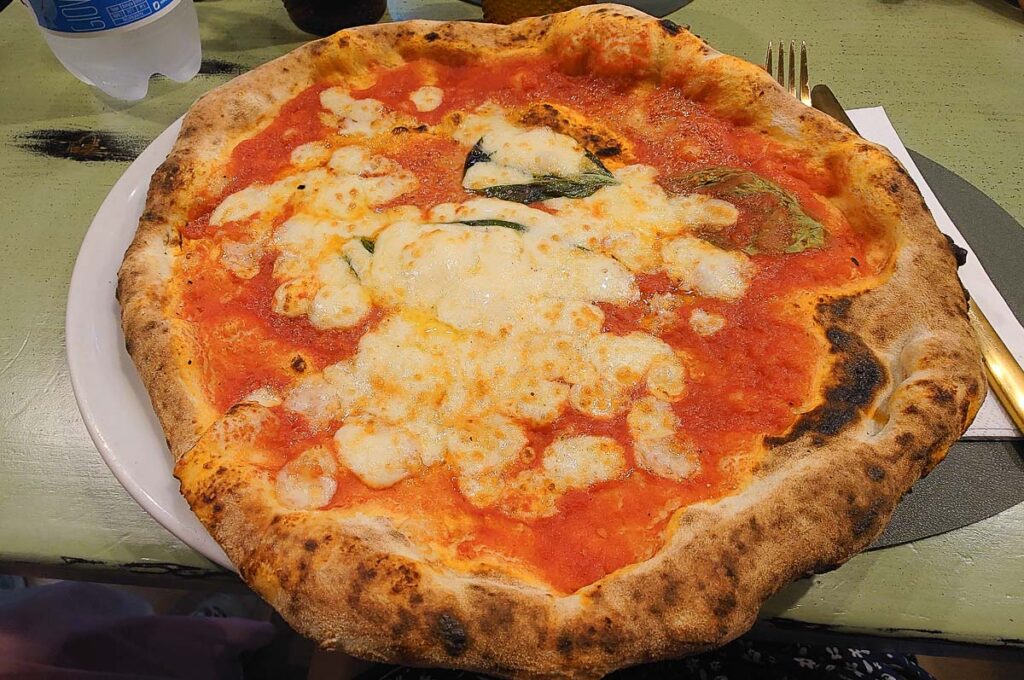
BEST THINGS TO DO IN NAPLES
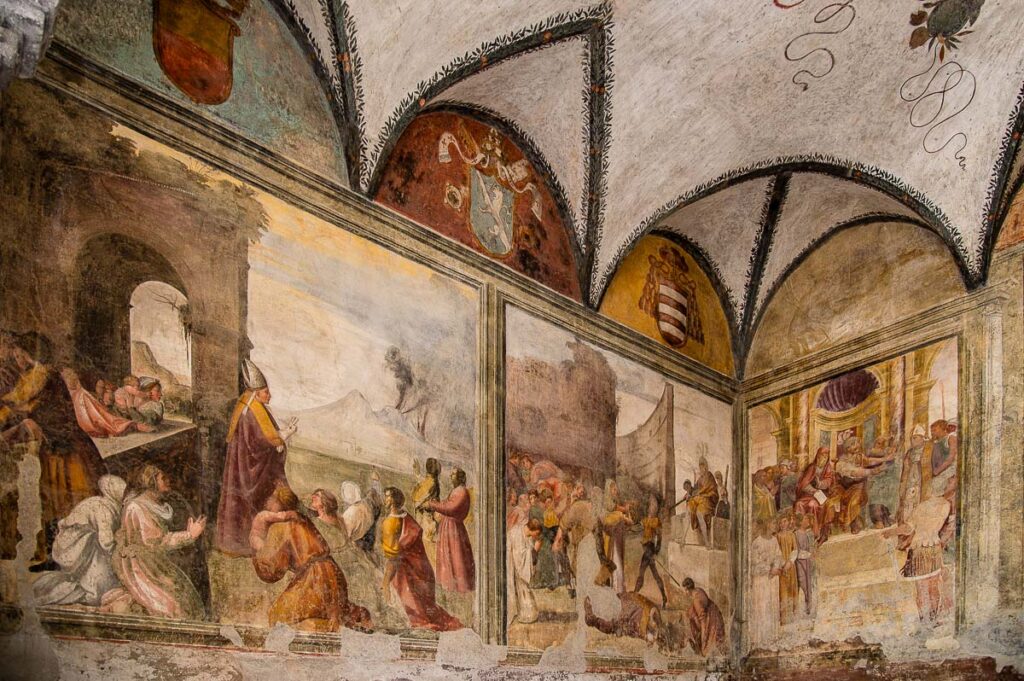
There are many wonderful and exciting things to do in Naples to suit all types of travellers and personal interests. This beautiful city has a lot to offer to the history buff, the art lover, the architecture aficionado, the foodie, the photographer, and above all the person who wants a vibrant and stimulating travel experience.
Here are the main things and activities you can enjoy in Naples. Specific examples for each one of them are provided up and down this page under the different headings of this ultimate travel guide for Napoli .
Sightseeing – Naples is studded with world-famous museums, millennia-old catacombs, and imposing churches with priceless art. With preserved outlines of its ancient Greek and Roman urban plans and plenty of historic spots to explore, this is one of the world’s best cities for sightseeing and landmark visiting.
Eating – Neapolitan cuisine has originated several of the world’s most famous foods with pizza holding the triumphal top spot. Eating here is a cultural experience. Try something new every single meal! Then take a food tour visiting historic deli shops and tiny eateries frequented by the locals. Even better, learn to make pizza the Neapolitan way yourself.
Water-Based Activities – here you are never far from the sea. You can take a ferry or a boat to the islands off the coast of Naples. Or you can enjoy a boat trip around Castel dell’Ovo and snorkelling in the gulf. If you want to combine water and history, then head to the Phlegraean Fields ( Campi Flegrei ) next door to Naples. In the Submerged Archaeological Park of Baia, you can enjoy a trip on a glass-bottomed boat and even a once-in-a-lifetime diving experience to see Roman mosaics and statues underwater.
Shopping – take advantage of exciting shopping opportunities when in Naples. Invest in a traditional Neapolitan Nativity scene (or at least in a small handmade figurine) on Via San Gregorio Armeno . Buy a selection of cornicelli (Naples’ protective amulet) to give as presents to family and friends. Get a cucumella – Naples’ traditional flip coffee pot. Splurge on handmade cameos and coral jewellery. Shopping in Naples is fun as each traditional, locally-made item has a story to tell.
Daytripping – Naples is a great base for day trips in this corner of Italy. From the world-famous Amalfi Coast to the archaeological ruins of Herculaneum , Pompeii , and Paestum , a long list of exciting destinations are only a short train ride away from Naples.
MAJOR LANDMARKS IN NAPLES
There are many must-see sights in Naples. These five major landmarks should be on top of your Neapolitan bucket list.
Spaccanapoli – one of the most iconic urban arteries in the world. This is a sequence of long straight streets which flow one into another and thus bisect Naples in two. Go for a walk along Spaccanapoli to sightsee and people-watch. Many of the city’s most interesting sights, for example, the Monastery of Santa Chiara , are on it or next door to it.
Sansevero Chapel – visit this small chapel in the heart of Naples to marvel at one of the most famous and most extraordinary statues in the world – the Veiled Christ. The chapel is a work of art in itself and was designed by the Italian soldier, alchemist, and inventor Raimondo di Sangro, Prince of Sansevero. Don’t miss the statues of the Veiled Truth and of Disillusion which are striking by themselves and were dedicated to the prince’s parents. The two 18th-century anatomical machines in the chapel’s basement are creepy yet incredibly intricate. You won’t be able to take your eyes off them!
MANN – National Archaeological Museum of Naples – a splendid museum with many excellent collections covering the ancient civilisations of Egypt, Magna Graecia, and Rome. The Pompeiian frescoes and mosaics are absolutely stunning. If you don’t blush easily, check out the Gabinetto Secreto for some ancient erotic art. To make the most of your visit, consider booking a museum tour . An expert guide will take you around the cavernous building pointing out precious artefacts and sharing the stories behind them for a truly enriching experience.
Piazza del Plebiscito – this expansive square is flanked by the imposing buildings of the Royal Palace and the Basilica of San Francesco di Paola. From Piazza del Plebiscito (a word which means ‘referendum’ or ‘vote’ in English), you can easily walk to several other must-see places in Naples. Among them is the oldest opera theatre in the world, Teatro di San Carlo , the elegant shopping arcade Galleria Umberto I , and the historic Gran Caffè Gambrinus – the oldest still in operation coffee house in the city.
Castel Nuovo (also known as Maschio Angioino ) – standing on the waterfront, this 13th-century fortress is one of Naples’ seven historic castles. Notice the large triumphal arch inserted around its main gate. It is one of the pinnacles of Italy’s Renaissance art.
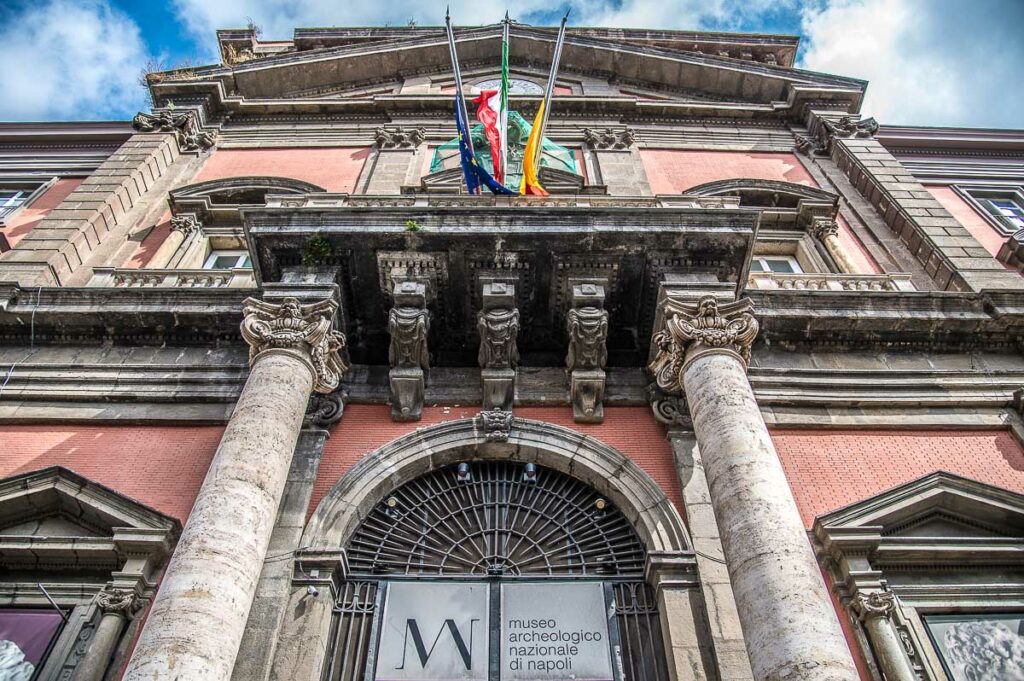
BEST MUSEUMS AND ART GALLERIES IN NAPLES

There are many exciting museums dotted all over Naples. In addition to MANN – National Archaeological Museum of Naples and the Royal Palace (see the entry above), here are five of the best among them:
Capodimonte Museum – built to house the renowned Farnese Collection of art, this former royal residence is surrounded by a lush park (originally, a hunting ground). Here you can see and enjoy an endless number of masterpieces by the likes of Botticelli, Titian, and Caravaggio as well as a number of renowned collections of art, porcelain, tapestries, and contemporary works.
Pio Monte della Misericordia Monumental Complex – run by a religious charity founded at the start of the 17th century, this is one of the must-see stops for lovers of art in Naples. It includes an octagonal chapel and a picture gallery housed in an elegant historic palace. Caravaggio’s famous painting ‘The Seven Acts of Charity’ was painted specifically for the chapel and it takes pride of place above its altar. Next door, you can browse a beautiful selection of Baroque and contemporary masterpieces and enjoy a lovely view of the Obelisk of San Gennaro and the dome of Naples’ Duomo.
Gallerie d’Italia – Napoli – I am partial to this group of art galleries which also has branches in the Italian cities of Milan , Vicenza , and Turin (you can see all their works of art on this link ). The permanent collection in Naples is eclectic and ranges from Attic and Magna Graecia pottery to works by Neapolitan, Italian, and foreign artists. This gives you a chance to explore the developments in art from ancient history to the 20th century. Caravaggio’s last painting ‘The Martyrdom of Saint Ursula’ is the crowning glory of this must-see art gallery in Naples.
N.B.: Calling all Caravaggio lovers! To learn more about the Neapolitan periods of the great Baroque master, have a look at this guided tour . It takes in the masterpieces and the places frequented in Naples by the painter of darkness and light.
Certosa e Museo di San Martino – this former Carthusian monastery nowadays functions as a museum complex with lush gardens. Here you can spend many stimulating moments looking at art used in all its forms to emphasise and decorate the impressive architecture. The charterhouse’s hilltop position opens splendid panoramic views of Naples and Mount Vesuvius. Next door, you can also explore the military fortress Castel Sant’Elmo .
Museo Madre – if by now you are feeling a bit overwhelmed by ancient ruins and Baroque splendour, a visit to Museo Madre and its excellent collection of contemporary art is just what you need to refresh your eyes and enrich even further your impressions of Naples.
BEST CHURCHES AND MONASTERIES IN NAPLES
Naples is dotted with countless churches, monasteries, and religious buildings. It’s not in vain after all that one of its monikers is the City of 500 Domes!
From the tiniest chapels to the imposing basilicas, Neapolitan churches guard priceless art repositories and unique local traditions. They are also an intrinsic part of the city’s architectural mosaic. Visiting them you can trace the development of building styles and decorative programmes from the Early Christian chapels nestled in the underground catacombs to the Gothic, Renaissance, and Baroque shrines and sanctuaries of Naples.
Here are some of the city’s must-see churches:
Duomo and Museum of the Treasure of San Gennaro – Naples’ cathedral has a millennial history and a cavernous body that incorporates two earlier churches built at the same site. One is the Church of Santa Restituta, allegedly founded in the 4th century by Constantine – the emperor who made Christianity the official religion of the Roman Empire. Nowadays, Naples’ Duomo preserves many priceless artefacts. Among them are the relics of San Gennaro or St. Januarius in English – the city’s main patron saint. It is here that the ritual of liquefying the saint’s blood takes place three times a year – an important event in the Neapoltan calendar (see the heading Events below). Next to the Duomo, don’t miss the Treasure of San Gennaro. Among the many exhibits here, you can see one of the most expensive pieces of jewellery in the world – the saint’s necklace.
Church of Ges ù Nuovo – this absolutely massive building was erected in 1470 as a princely palace. A century later it was sold to the Jesuit Order and converted into a church. Lavishly frescoed and ornamented in the Baroque style inside, its main point of interest is its unusual facade. This is made of piperno, a stone formed from volcanic magma, and fully covered by countless small pyramids. Unusual symbols are chiselled in some of these. Recently, it has been suggested that the symbols correspond to musical notes. When played, the resulting piece was, apparently, intended to attract good energy to the building.
Monastery of Santa Chiara – widely famous for its cloister decorated with lavish majolica tiles and Baroque frescoes, this monastery also has an onsite museum and guards the remnants of an ancient Roman bath. Its enormous Gothic basilica was almost completely destroyed during the Second World War (after Milan, Naples was the most bombarded Italian city) and then it was painstakingly restored to its former glory.
Museum Complex of Santa Maria delle Anime del Purgatorio ad Arco – this is one of the main centres of Naples’ curious cult of the souls in purgatory or anime pezzentelle in Italian. It consists of two churches. The decoration of the upper one explores the themes of death and salvation. The underground one is where many of Naples’ poor and destitute citizens were buried in the past. The locals, believing them to be stuck in purgatory, would come here to pray over their remains. This gave rise to the idea that the dead could serve as intermediaries between the living on Earth and the saints and God in heaven. So skulls were treated with special care and requests would be addressed to them.
N.B.: If you want to learn more about the cult of the anime pezzentelle , make sure that you also visit the Fontanelle Cemetery (due to re-open in 2024), the Monumental Complex of St. Anne of Lombardi, and the Church of Santa Luciella ai Librai.
Basilica of Santa Maria della Sanità – built over the Catacombs of San Gaudioso , this resplendent Neapolitan church is notable for its elevated altar and the double staircase that leads to it. Covered with bright majolica tiles, its large domes reflect beautifully the light, especially on a sunny day. If you book to see the catacombs (one of Naples’ best underground sights), the guide will tell you a bit about the church and the cult of San Vincenzo Ferrer – the patron saint of the quarter of Sanità and to whom the locals address prayers when they want to have a child.
Church of San Francesco di Paola – inspired by the Pantheon in Rome, this expansive Neapolitan church brims the city’s main square, Piazza del Plebescito , with its long colonnade. Built in the early 19th century in the Neoclassical style, it stands out with its portico and enormous central dome.
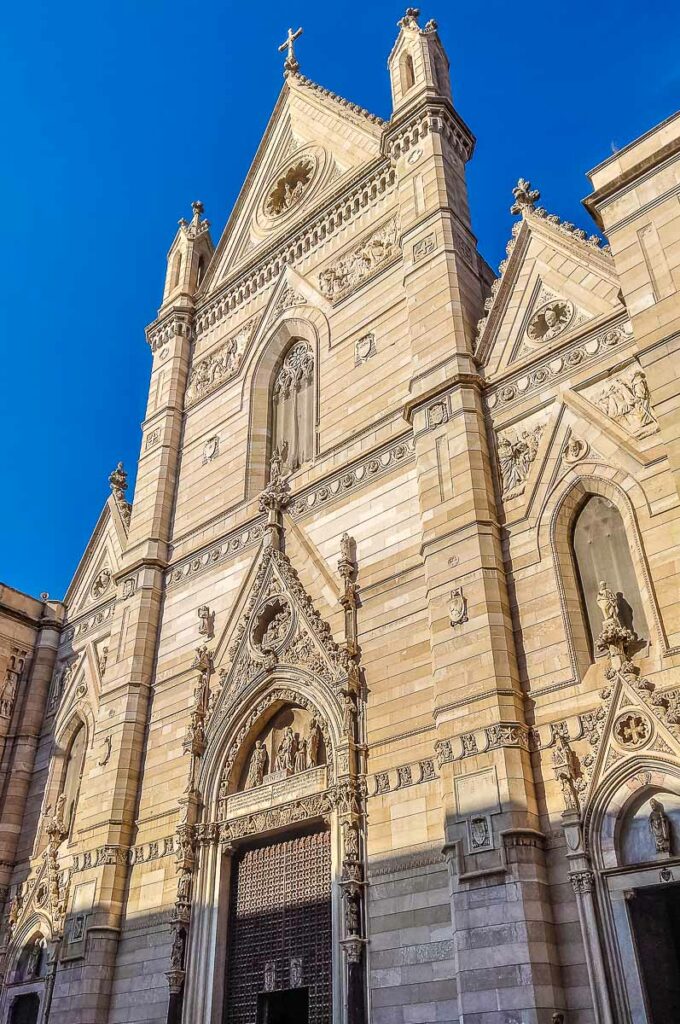
HIDDEN GEMS IN NAPLES
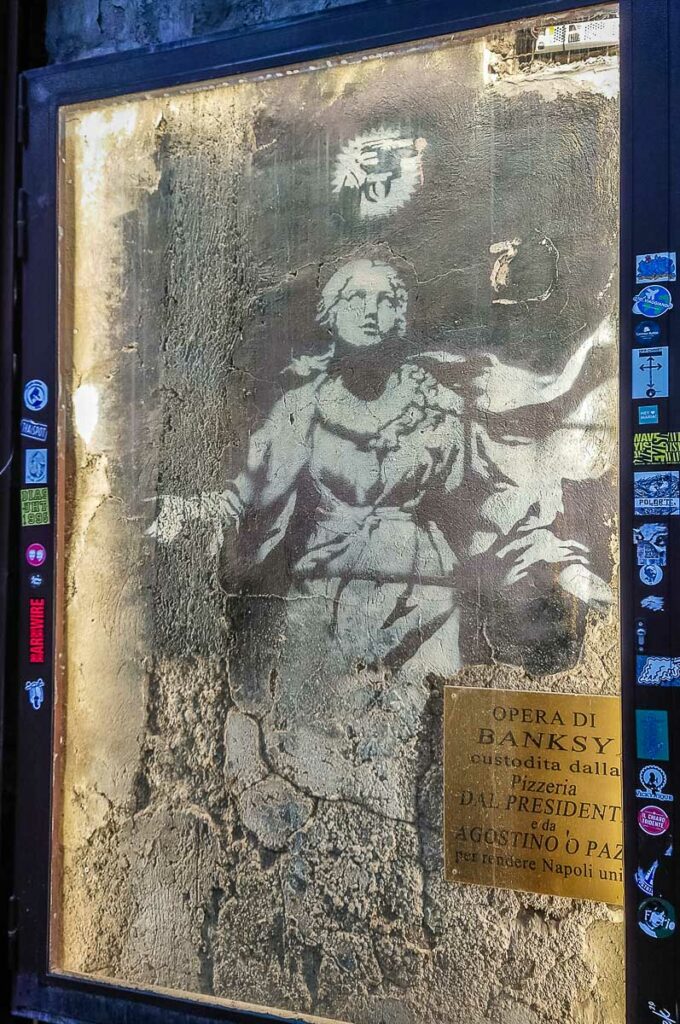
A city like Naples has a lot of secrets and hidden corners. Try to uncover as many of them as possible for a truly memorable trip. Make a note of the sights below and step off the beaten path.
Madonna con la Pistola by Banksy – up to 2019, this was the only documented mural by the artist in Italy. You can see it on Piazza dei Girolamini and it represents the Madonna with a gun where her halo should have been.
N.B.: Naples is a great place for street art. Everywhere you go, you will see murals and graffiti of differing quality adorning the facades of both historic and modern-day buildings. Keep an eye out for the graffiti of Trallalà – the moniker of the Naples-born artist Alfonso de Angelis. His fleshy ladies (known as ciaciona in Neapolitan) are particularly iconic.
Incurables’ Monumental Complex – come here to learn about the history of medicine in Naples and to visit the splendid Pharmacy of the Incurables, the Museum of the Sanitary Arts, the 16th-century cloister, and the medical garden.
Library and Monumental Complex of the Girolamini – a beautiful church with cloisters and a splendid historic library. From precious art to rare books, there is much to be seen and admired here far from the tourist crowds.
Monumental Complex of St. Anne of Lombardi – this 15th-century church preserves extraordinary works of art. In the sacristy, you can see the Sistine Chapel of Naples – an important fresco cycle by Giorgio Vasari, the Tuscan Renaissance painter and art historian. In the Crypt of the Abbots (or Hypogeum), you can learn about the Neapolitan scolatoi or draining holes where the bodies of the deceased underwent a somewhat gruesome and long procedure to liberate the bones from the flesh in an act which was believed to expiate the soul.
Naples’ Stairways – about 200 stairways and ramps connect the city’s flatter parts to its hilltop quarters. Following one of these inclined paths weaving past houses, churches, and monuments, is a great way to explore Naples and enjoy splendid panoramas of the urban sprawl and Mount Vesuvius. Among the stairways with the best views are the Pedamentina a San Martino , the Montesanto Stairs, and the Gradini del Petraio .
CATACOMBS AND UNDERGROUND SPACES IN NAPLES
Almost 3,000 years old, Naples is a city of layers. Many of these run deep under the streets and are keepers of marvellous stories that oscillate between the sacred and the macabre. Often within the same space below the surface.
Uncovering Naples’ underground secrets is a major portion of getting to know this one-of-a-kind city in Southern Italy. There is a bewildering number of underground tours and experiences for you to choose from. Here are some of the best:
Catacombs of San Gennaro and Catacombs of San Gaudioso – visiting these catacombs was my favourite experience in Naples. Both are accessible on the same ticket via guided tours. You will need to book your entry times in advance. I suggest that you head first to the Catacombs of San Gennaro on the far end of Rione Sanità (near the Capodimonte Museum and Park and next door to the imposing Basilica of the Crowned Mother of God). Here you will learn about the early Christian history of Naples and see prized frescoes and mosaics from the first millennium AD, as well as tombs chiselled directly in the volcanic tuff rocks. The focus of the guided visit to the Catacombs of San Gaudioso, on the other hand, is on the funeral ritual of scolatura . This was practised by Naples’ nobility and clergy of the 16th and 17th centuries and prescribed the draining of the bodies after death of all fluids in order to liberate the bones from the sinful flesh. Leave at least an hour between your visits to the two catacombs and explore Rione Sanità . If you can’t see both on the same day, your ticket for San Gaudioso is valid for 12 months after your visit to San Gennaro.
Napoli Sotterranea – Naples’ most popular underground tour. It takes in the city’s ancient water cisterns, the ruins of the ancient Roman theatre, stories from World War II, and even a recently planted underground garden. An exciting experience on many levels which culminates with a short walk down pitch-black narrow corridors to reach water pools with amphoras suspended above them. People suffering from claustrophobia can skip this part and wait for the rest of the group in a spacious underground chamber before continuing with the tour.
Bourbon Tunnel – built in 1853 and heavily used during the Second World War, this space below the surface of Naples has many stories to tell spanning four centuries. Especially photogenic are the abandoned cars and motorcycles that line up the tunnel. Next to them are stored statues from the fascist period.
Spanish Quarters Underground Guided Tour – winding tunnels will take you to the remains of the Neapolitan aqueduct deep beneath one of the city’s liveliest and most authentic quarters. From the ancient Greeks to the Second World War, you can trace Naples’ history as you walk along the dimly lit corridors.
San Lorenzo Maggiore and Neapolis Sotterrata – a wonderful journey through time that gives you a chance to trace Naples’ development from the 5th century BC to the 18th century AD both below and above ground. Here you can see the remains of a 1st-century AD Roman market, visit the imposing basilica where the 14th-century Renaissance humanist and writer Bocaccio met his muse Fiametta for the first time, and amble through historic halls decorated with splendid frescoes.
Basilica of Santa Maria Maggiore alla Pietrasanta and LAPIS Museum – this imposing 17th-century church stands at the spot of an early Christian basilica that was preceded by an ancient Roman temple dedicated to the goddess Diana. 35 m underneath it, you can visit Naples’ museum of water. Expect Greco-Roman cisterns and a submerged portion of the Roman Decumanus (the east-west oriented road that bisected the city in the past). Once you return to the surface, stop for a coffee in Diaz Microtorrefazione (one of Naples’ best coffee shops) in the shadow of the church’s 11th-century bell tower.
Church of Santa Luciella ai Librai – it’s easy to walk past this small church in the historic centre of Naples and not even suspect the stories and curiosities it keeps. The skull with ears takes the central place among them. They say that in the past, Neapolitan women would come to pray to it and whisper in its ears their innermost secrets and desires. The church’s crypt can be visited with a short guided tour. In the past, the funerary ritual of scolatura was practised here, too.
Underground Stations of Art – 15 stations along Line 1 and Line 6 of Naples Metro host over 200 works of art by 90 artists both from Italy and all around the world. Started in 1995, the project Stazione di Arte has produced some of the most beautiful metro stations in Europe with Stazione Toledo the receiver of many awards and accolades. Other metro stations worth a mention here are Università , Dante , Museo , Materdei , and Garibaldi . Even just travelling around the city of Naples is already an experience of art.
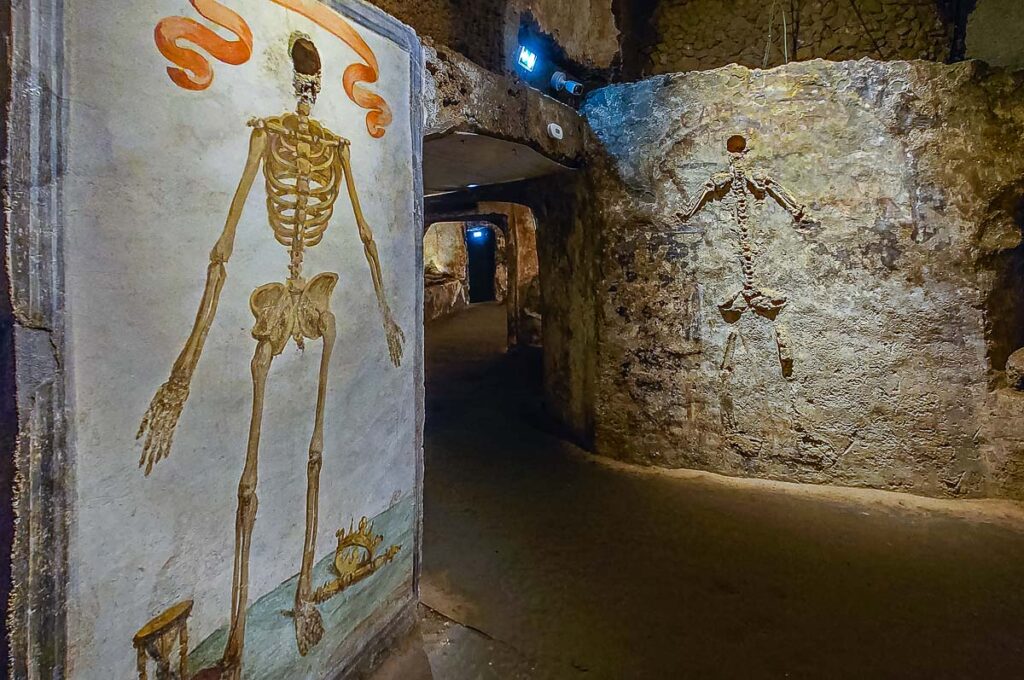
CURIOUS THINGS TO SPOT AROUND NAPLES
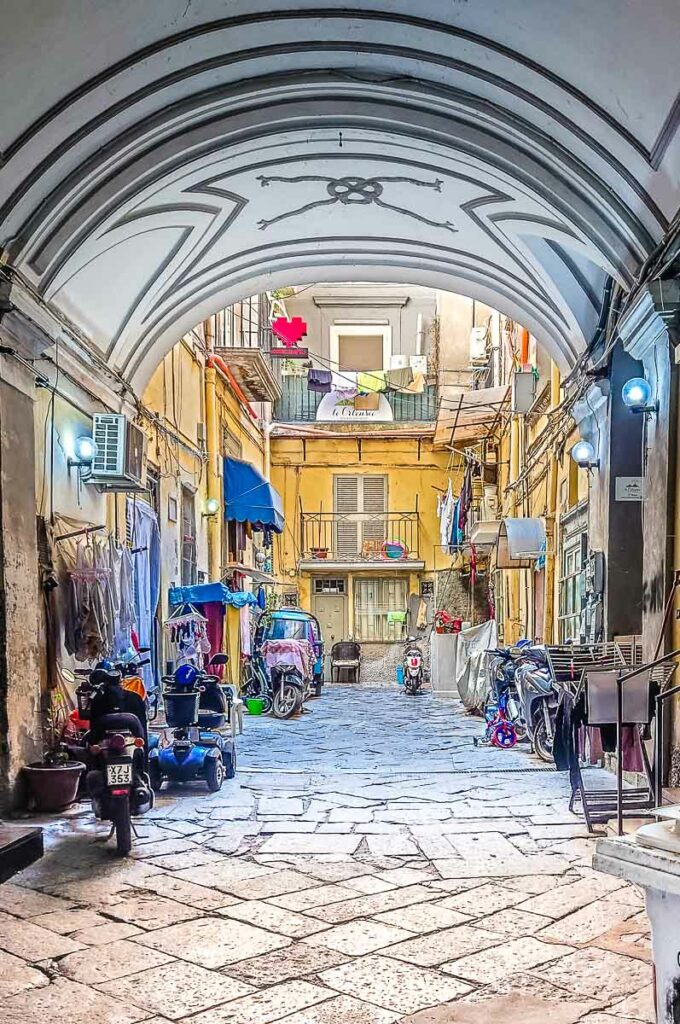
Here are five curious things that made an impression on me as I was exploring Naples with my family. You will come across them all around the city. They make it the lively, crazy, multilayered place that it is. I am mentioning them here to give you yet another angle (or angles) from which to approach Naples, experience its traditions, and capture truthfully its character.
Courtyards – a nucleus of authentic Neapolitan life, the courtyard is where you will find in no particular order parked cars and mopeds, rows of post boxes, the obligatory clotheslines, pots with plants, recycling bins with strict instructions on what to put in each, and so on. Providing an island of tranquillity in a densely built city, courtyards here are usually square or rectangular and flanked by balconies and rows of windows. Huge wooden gates block access to the courtyard from the street. These have a small door cut out in them to allow residents to walk in or out when the gates are closed.
Baskets – in a multi-storey city such as Naples, baskets come in handy when you don’t want to rush downstairs every time a delivery driver rings the bell. Instead, people drop a basket suspended by a cord from their balcony and then pull it up with the delivered item safely inside. Pure genius!
Mopeds/Scooters – these two-wheel vehicles are everywhere in the city. They are the main form of transport here, especially in the historic quarters. From teenagers to octogenarians, everyone rides them. Often, you can see a whole family with the baby and the dog on a single moped. You will quickly learn to jump out of the mopeds’ way, especially on the narrow historic streets with no pavements. Your head will be on a swivel at all times and you will subconsciously start to double up any walking time predicted by Google Maps, as by your first afternoon in Naples you will know that walking with a constant stream of mopeds right next to you is very time-consuming. Neapolitans seem to think that helmets are optional. I certainly don’t recommend not wearing one if you decide to brave the local traffic and ride around on a moped yourself.
Shrines – in Italian, they are known as edicole votive or edicole sacre . These are shrines attached to the walls of houses and buildings. You will see dozens of them as you walk around the city. A heartfelt expression of popular devotion, they vary in size and are decorated with religious images, candles, rosary beads, and plastic flowers.
Basso (pl. bassi )- also known as ‘o vascio in the Neapolitan language, these are small ground-floor flats with doors that open directly on the street. As you walk around town, your eyes will spontaneously look through the windows and the doors of many bassi giving you glimpses of real life. Some of these flats are so small that the marital bed stands right opposite the kitchen sink. In others, the occupants have reclaimed a corner of the street by fencing it off as a small verandah or placing large pots with plants to turn it into a personal garden. The family’s laundry flaps on freestanding driers placed directly on the pavement or on makeshift clotheslines. Some bassi have been turned into shops or workshops where you can buy bread or fresh fish or have your moped repaired if you need.
BEST PRESEPI IN NAPLES
A presepe (also known as presepio in Italian and a Nativity scene in English) is a figural representation of the Holy Family in the stables of Bethlehem. It is the focal point of festive decorations in Italian homes during the Christmas season. You can read more about presepi in this blog post:
- Presepe or 15 Facts about Italy’s Nativity Scenes – History, Traditions, and Meaning
Naples is Italy’s main centre of presepe -making. Handmade Neapolitan presepi are recognised for their beautifully carved and sculpted figurines, complex settings, and the introduction of folk characters, scenes of daily life, and even representations of modern-day celebrities in the Biblical Nativity scene.
A visit to Via San Gregorio Armeno is a must when you are in Naples. This is the street in the heart of the historic centre where you will find the largest concentration of presepe -making workshops. It’s Christmas all year round here.
As part of your sightseeing in Naples, don’t miss the following large-scale and very intricate presepi in the city:
Presepe Favoloso in the Basilica of Santa Maria della Sanità – this is my favourite Nativity scene in Naples. Four metres long and two metres high, it has over 100 figurines and it was made in 2021. The curious thing about it is that it incorporates figural representations of countless Neapolitan folk stories and contemporary happenings. As such, the Holy Family is surrounded by weird and wonderful characters that make you want to learn more about Naples’ myths and traditions. You can see this presepe as part of the guided tour of the Catacombs of San Gaudioso .
Cuciniello Nativity in the Museo Nazionale di San Martino – this large and complex presepe is composed of figurines of 173 people, 42 angels, and 80 animals (including two monkeys!). 450 miniature objects complete the scene.
Presepe del Banco di Napoli in the Capella Palatina of the Royal Palace – this lavish Nativity scene is composed of 354 pieces dating to the end of the 18th and the beginning of the 19th centuries. All of them were designed and handmade by famous artists of the time, for example, Giuseppe Sanmartino, the sculptor of Naples’ most famous statue – the Veiled Christ.
Presepe by Fratelli Capuano in their bottega on Via San Gregorio Armeno – this Nativity scene was made in 2006 by the artisans of one of Naples’ most renowned presepe -making workshops. In the style of an 18th-century Neapolitan presepe , it is incredibly detailed and expansive in size. There is a nominal charge of one euro to see this presepe .
Sala del Presepe in the Monastery of Santa Chiara – this large-scale Nativity scene is composed of 18th-century pieces commissioned during the reign of Ferdinand IV. The king himself was a big fan of presepi
Don’t worry if you don’t manage to see exactly these five Neapolitan presepi . Large-scale Nativity scenes are installed all over Naples, especially in the local churches. The best time of the year to see them is obviously around Christmas but they add a touch of whimsicality and wonder to your memories of this Italian city no matter the season.
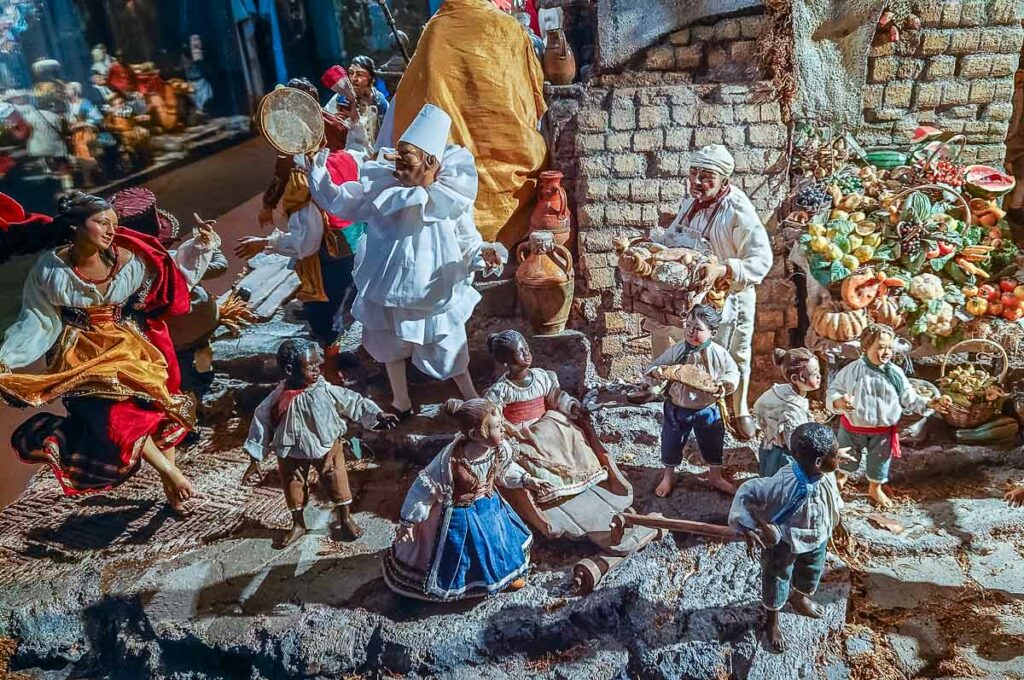
EVENTS IN NAPLES
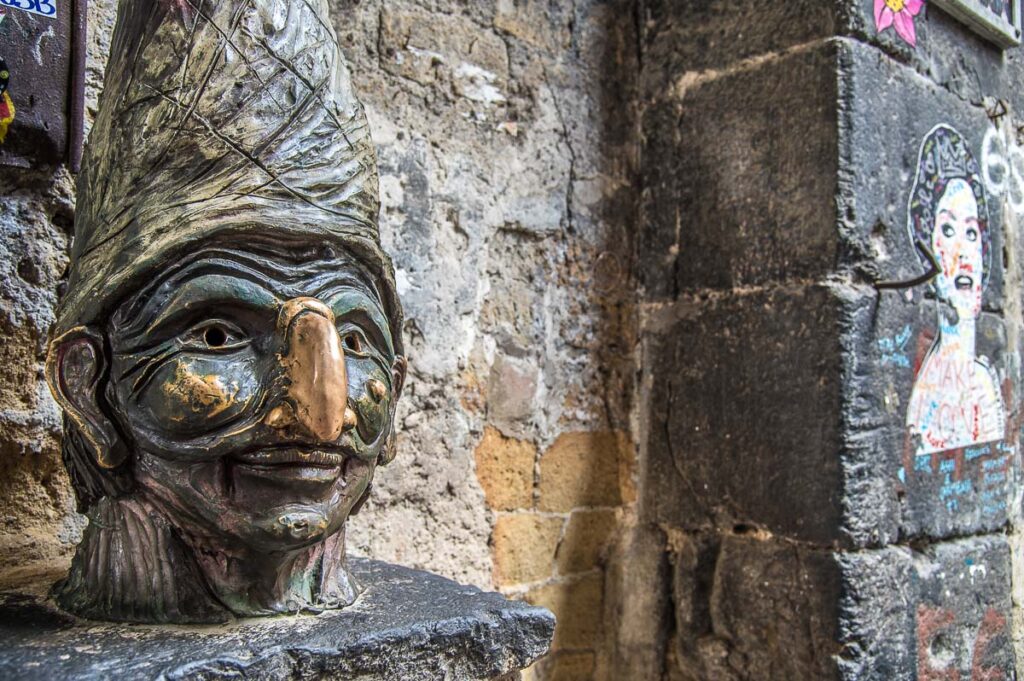
Naples has a rich calendar of events. From art exhibitions and religious festivals to culinary get-togethers (called sagra ) and street celebrations, there is always something fun and exciting to do in the largest Southern Italian city.
Here are some of the most important events in Naples to enjoy together with napoletani :
January – 6th January or Epiphany is the day of Befana, an old long-nosed lady who rides around on a broom. As one of Italy’s five Christmas gift-bearers, she brings presents to the well-behaved Italian kids. What do the naughty ones get instead? Find out here . On 17th January, Naples celebrates the day of St. Anthony the Abbot, the protector of animals, with traditional bonfires.
January/February – travel to Naples for Carnevale . This is a period of confetti, costumes, music, and fun in the city. It’s also an opportunity to spot a Pulcinella or two out and about in the historic quarters. With a black mask with a protruding nose, this is the commedia dell’arte character who hails from Naples. In English, he is also known as Punchinello and originated the British puppet character Punch (as in Punch and Judy).
N.B.: If you can’t make it to Naples specifically for Carnival, then head to Vico del Fico al Purgatorio , a dark portico right off Via dei Tribunali , at any other time of the year. Here you can see the famous bronze bust of Pulcinella by the local artist Lello Esposito. Tourists touch the bust’s nose for good luck which explains its shiny surface.
March/April – Easter is one of the major celebrations in the Neapolitan calendar. Spend the Holy Week here and immerse yourself in centuries-old religious rites and popular traditions. For example, the sepolcri and the giro delle sette chiese . The sepolcri are specially decorated altars or chapels in Naples’ churches. The giro comprises visiting seven churches to pray for benevolence. Tuck into local festive dishes such as zuppa di cozze (mussel soup eaten on Holy Thursday) and pastiera (a shortcrust pie filled with ricotta-based cream).
April – twice a year (on the 5th of April and on the first Tuesday of July) the historic quarter Rione Sanità celebrates its patron saint, the Spanish Dominican friar Vincenzo Ferrer. Known as O’Munacone – the Big Monk – it is believed that the cholera epidemics that decimated Naples in 1836 only ended after the saint’s statue was carried along the quarter’s streets.
N.B.: You can see the shrine of San Vincenzo in the Basilica of Santa Maria della Sanità. The locals pray to the saint when they want to have a child.
April/May (then Septembe r and December ) – Naples’ major celebration takes place three times per year: the Saturday preceding the first Sunday of the month of May, then the 19th of September, and the 16th of December. This is when napoletani flock to the city’s Duomo and pray for the Miracle of Liquefaction. The blood of Naples’ patron saint San Gennaro was collected in a glass vial after he had been beheaded during the persecutions of the Christians spearheaded by the Roman emperor Diocletian. Over the centuries, the blood dried and turned solid. However, on these particular dates, it becomes liquid again after a complex ceremony performed in front of the people of Naples. A successful liquefaction of the saint’s blood is a sign of forthcoming prosperity. A failure to liquefy is interpreted as misfortunes to befall Naples and the world in the months to follow.
September – visit Naples around the 8th of September for the annual Feast of the Madonna of Piedigrotta. Expect float parades, firework displays, and concerts.
December – the Christmas season is especially heartfelt in Naples. Head to Via San Gregorio Armeno to immerse yourself in the festive hubbub of shoppers seeking new pieces for their presepi . Visit the city’s churches to see their intricate Nativity scenes. Enjoy traditional Christmas desserts such as struffoli (fried balls of sweet dough covered with hot honey and colourful sprinkles) and roccocò biscuits.
NAPLES WITH KIDS
Is Naples a good place to visit with kids? This is a very valid question considering the city’s incredibly busy historic centre, the obvious social contrasts, and the large number of sights and museums where one can spend many hours walking around to full exhaustion.
My personal opinion is that Naples is a great place to visit with kids who are eager to learn new things, who love to eat, and who have vivid imaginations. Also, kids who don’t mind walking around for long stretches of time and who love exploring new places and cultures.
Here are a handful of places and sights which you may enjoy visiting particularly with your kids in Naples:
Aquarium of Naples – this is the oldest aquarium in Italy. It was opened in 1874 by the German Darwinist Anton Dohrn. Two years before that he had founded the world’s first zoological research station in Naples. The aquarium is housed in Villa Comunale – an important historic garden in the quarter of Chiaia. It has 200 animal and plant species in 19 basins and represents nine different habitats of the Mediterranean Sea. Near the aquarium, you can also visit the Museum Darwin-Dohrn .
Botanical Garden of Naples – this verdant oasis is a pleasure to visit with the family, especially on a hot day.
Ospedale delle Bambole – this Dolls’ Hospital is a very whimsical place in the heart of Naples. It first opened its doors in the 19th century and since then it has been run by four generations of the same family. It specialises in the repair of antique dolls and it has a small museum.
Città della Scienza – right next door to Naples you can visit Italy’s first interactive museum dedicated to the different branches of the sciences. A fun and educational destination for the whole family.
Below you can read my 10-year-old child’s honest opinion about visiting Naples in Italy:
Naples is a busy and lively city. With the noise, tight roads, and scooters, it gives you an air of happiness. But it is also very warm and within five days your feet can start hurting within five minutes of walking.
Children might enjoy the Napoli Sotterranea guided tour because of the dark and tight passages and the underground pools of water. One part of this tour includes something that you wouldn’t imagine being in an ordinary house but I won’t give any spoilers. (Especially as it’s underneath the bed!)
I also enjoyed seeing the Nativity scenes, especially the moving ones. Naples’ amulets – cornicelli – were everywhere.
The veiled statues made me feel a bit sad but you must visit not just the Veiled Christ in the Sansevero Chapel but also the Veiled Son (see the heading 5 Curious Facts About Naples below to find out why). In the Sansevero Chapel, you will also find a statue with an impressive fishing net around it.
I really liked Naples’ tight little streets and the way the delivery system works with baskets tied on ropes. You will find out soon enough!
Be warned! Maradona is everywhere! But I liked the fact that Naples’ colour is light blue (my favourite colour).
If you go to Herculaneum, there is a house which I liked. It has orange and red walls, which I describe as tropical. There are also some ancient Roman snack bars, but if you get hungry you can get an ice cream or a snack from the vending machines by the ruins. I liked walking around, looking into the ancient houses and naming them. Herculaneum is the perfect size to explore with kids and they even have cats who live there. I saw two of them – Ciuccio and Ercolina.
In Naples, you must go to the best ragù restaurant in the world – Tandem. And also you obviously have to taste gelato and pizza. A pizzeria to have in mind is the Pizzeria del Purgatorio. The sfogliatella riccia is quite difficult to bite, so watch it! Another thing to try are the Neapolitan taralli.
Let me tell you one thing! In Naples, they not only have granita (similar to slush puppy) but they even have watermelon and melon flavours. They are delicious!
The combination of hot, blazing sun and a full belly is not good. In this case, I suggest that you follow the Italian tradition of afternoon nap which is called riposo .
I would definitely return to Naples! I am happy that I got a Neapolitan cornicello , a fridge magnet, and some pieces for a Neapolitan Nativity scene. Naples is worth it! Especially for the food.
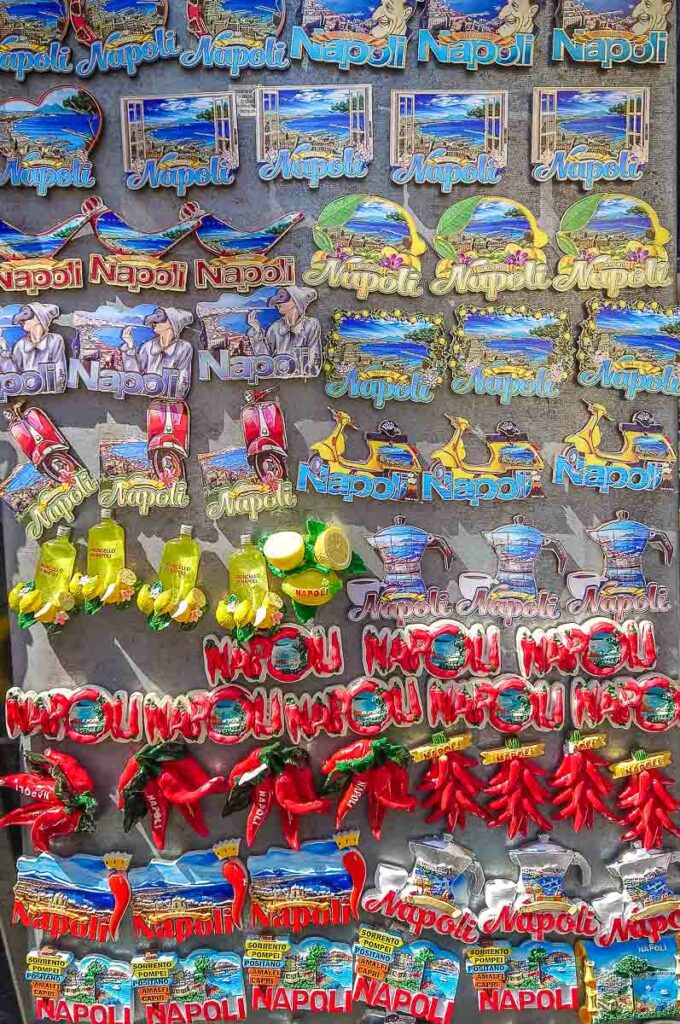
BEST ORGANISED TOURS IN NAPLES
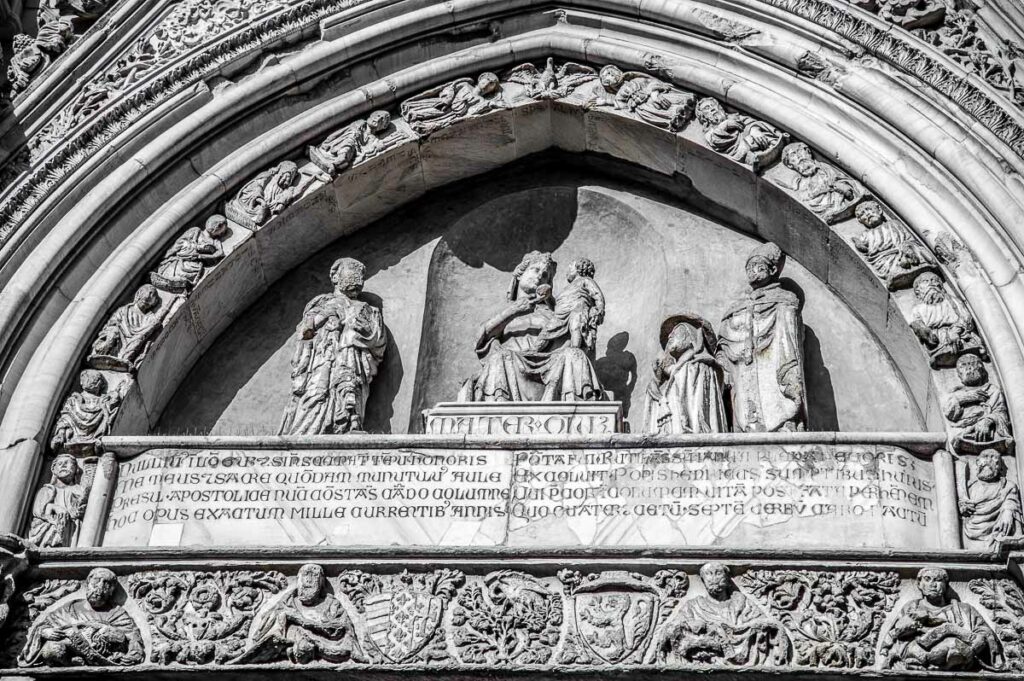
Booking an organised tour in Naples with a reputed tour guide or travel company is a shortcut to getting to know on many different levels this vibrant, stimulating, and often overwhelming city. It’s like stepping through a secret door to discover Naples’ best corners and hidden gems which otherwise may be difficult to come across one by one on your own.
With a millennial history, a rich catalogue of art, delicious local food, and many traditional crafts with outstanding output, Naples is a must-see city in Italy. This is a place that keeps many secrets that it reveals to only those in the know. No matter how many books or guidebooks you may read about Naples before coming here, the City of Pizza, Volcanoes, and Nativity Scenes can still be a shock to the system. You may find yourself ambling through its ancient streets unsure where to head to first and what to delve into next.
It is at this point that an expert local guide or a reputable tour company can be of great help. With a structured approach and offering tours covering specific fields of knowledge or tailored to your personal interests, you can see and experience the maximum of Naples within the shortest amount of time.
Here are some of the best and most highly recommended tours to take in Naples organised by category:
- Sightseeing: Hop-on Hop-off Bus ; Walking Tour with Underground Ruins ; Walking Tour with the Most Famous Monuments
- History: Pompeii with an Archaeologist ; Pompeii and Mount Vesuvius ; Pompeii and Herculaneum
- Food: Street Food Tour ; Do Eat Better Experience ; Secret Food Tour
Alternatively, select directly local tours and activities in Naples on GetYourGuide , Viator , and Tiqets .
Even if you decide against booking a tour and then you change your mind at the last moment, don’t worry! Tour guides can be hired in situ in many museums and sights in Naples. For example, when you visit Herculaneum, you will see the tour guides’ desk next to the entrance.
BEST VISITOR PASSES FOR NAPLES AND CAMPANIA
There are several visitor passes for the city of Naples and the region of Campania in Italy. In general, they cover a period of one, three, or seven days and provide free and discounted access to the best and most popular sights and museums here. Most of them also include free transport either as an included perk or as an add-on option.
The most popular visitor passes for Naples and Campania are issued by the following companies:
Campania ArteCard
Naples Pass
Both offer different options in terms of pass duration and number of free sights covered by each pass. So browsing their websites and choosing the right card for you is worth the time.
On Tiqets you can also find visitor passes just for Vesuvius and Pompeii, too.
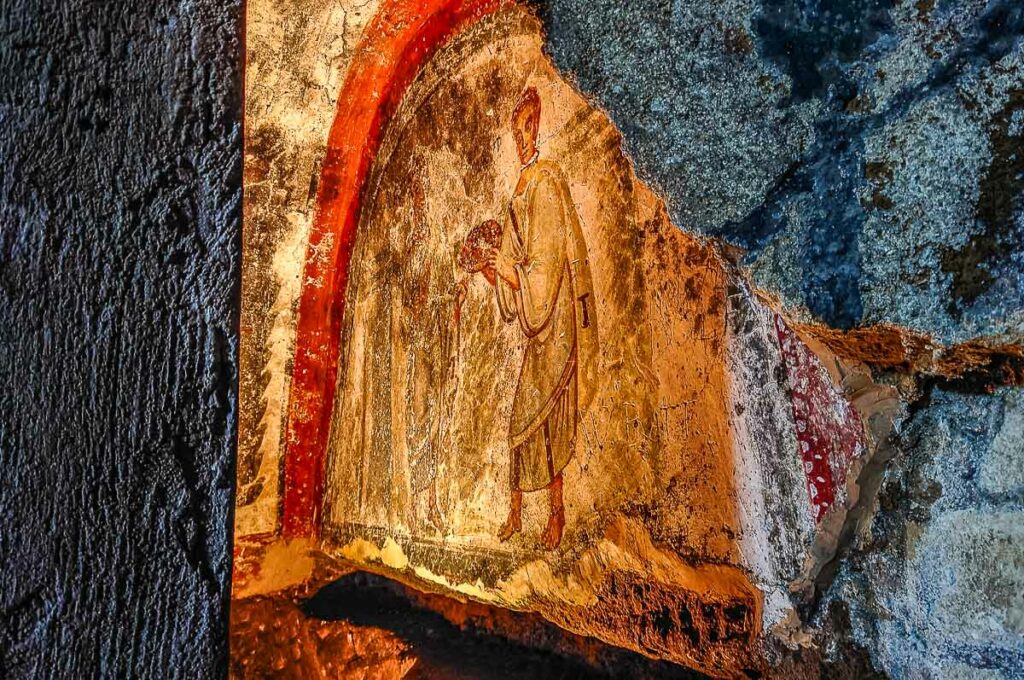
We purchased the three-day Campania Artecard as we wanted to be able to use it on our day trip to the Phlegraean Fields, too. In my personal experience, the card was useful but it had some shortcomings.
Only the seven-day card is physical. The others are virtual. You have to download an app on your phone which provides you with special QR codes to scan every time you use public transport or visit a sight. This meant that we needed to make sure that we had enough battery left at all times and that the internet was working wherever we were.
Often, the QR code wouldn’t scan easily, especially at the train stations, so we had to go find someone to let us in through the barrier. In the process, we would get approached by small-time crooks offering to open the barrier for us in exchange for a small tip.
As far as we understood, children travel for free on the parent’s card if they are under a meter tall. As our child is over a meter, we needed to go buy tickets for her with all the queuing this entailed. I would have loved to be able to pay a bit more for the card but to have my child’s travel on it or simply to have the option to buy a child’s card from the get-go.
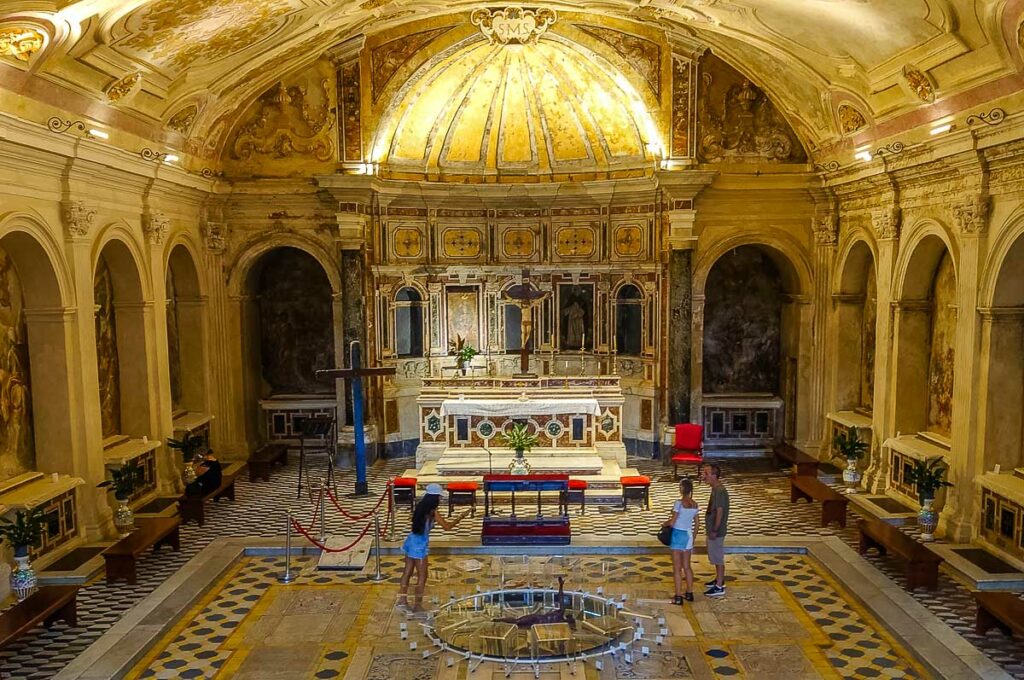
Another thing to have in mind is that the card seems to cover a specific number of days and not a specific number of hours. In other words, no matter how early or how late in the day you activate it, it counts the day of activation as a full day.
Otherwise, the card is handy as it saves you quite a lot of money. Especially, if you plan your visits in such a way that you head to the most expensive sights first. It also allows you to jump the queues at museums and sights which is a great timesaver. The app has a lot of excellent information about the sights and landmarks to see in Naples. This can give you lots of ideas for places to explore which makes your stay in Naples even more exciting.
BEST DAY TRIPS FROM NAPLES
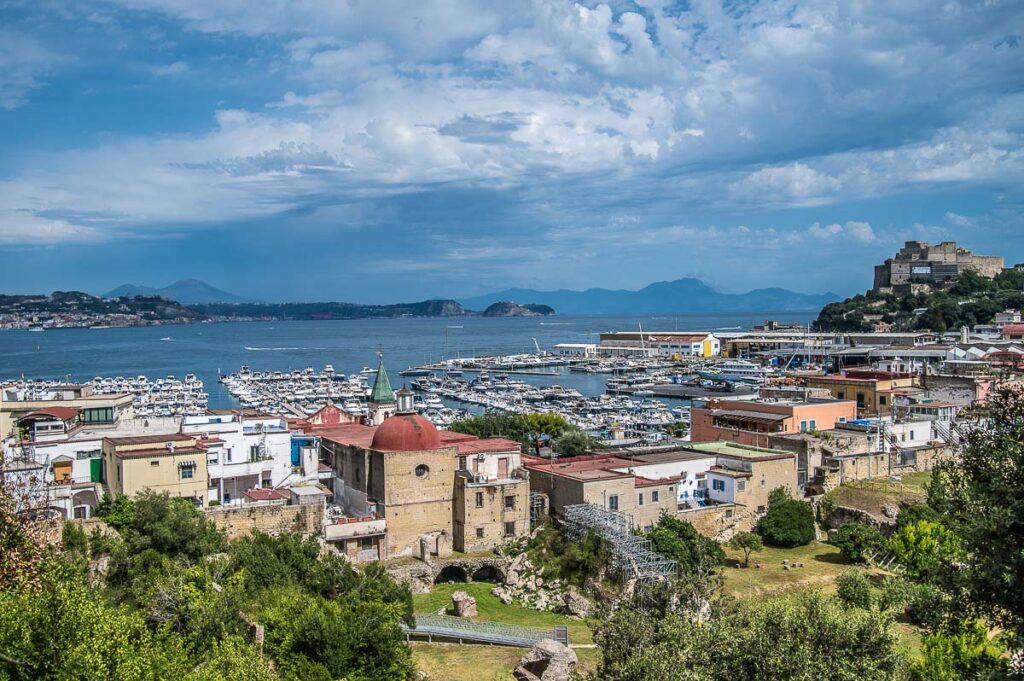
For everything that Naples has to offer, right next door to this vibrant Italian city you will also find an almost overwhelming number of must-see destinations. No matter what you are after – ancient ruins, picturesque towns, coastal villages, diving trips, natural beauty or panoramic views – take your pick from this list:
Ancient Roman Cities and Landmarks – Herculaneum and Pompeii don’t really need an introduction. Destroyed by the eruption of Mount Vesuvius in 79 AD, today the excavations of these two ancient Roman towns are a must-see if you love history and archaeology. If you have time to spare, don’t miss the Virtual Archaeological Museum of Herculaneum and Boscoreale , Oplontis , and Stabiae in the vicinity of Pompeii. Take the Circumvesuviana train and you can easily get from Naples to all of these ancient Roman hotspots by yourself. Alternatively, you can also book this highly recommended day tour which takes in Pompeii and Mount Vesuvius. If you have little time to spare, then this two-hour visit to Herculaneum in the company of an archaeologist is a great option to consider.
Phlegraean Fields ( Campi Flegrei ) – a truly exciting yet little-visited by mass tourists area right next to Naples. Here you will find small towns with fresh seafood, impressive ruins, and volcanic heritage. From the enormous Flavian Amphitheatre and the ancient Roman macellum in Pozzuoli to the Archaeological Park of Cuma and the Piscina Mirabilis in Miseno, this is the best day trip from Naples you have never heard of. I particularly loved the Roman baths in Baiae. The sea here guards the remains of once lavish Roman villas. Protected as part of the Submerged Archaeological Park of Baia, they can be seen as part of a diving or snorkelling trip.
N.B.: If little-known historic sites are your thing, then make sure that you also head to the Archaeological Site of Pausilypon halfway between Naples and the Phlegraean Fields. You can read more about it here .
Islands near Naples: a handful of beautiful islands are a short ferry ride away from Naples. The most famous one of them all is Capri but if you have the time, don’t miss Ischia and Procida. Check ferry timetables and ticket prices at the official websites of the ferry operators SNAV , Caremar , and Medmar . Don’t forget to book a boat tour of Capri in advance for maximum fun during your time on the island.
Amalfi Coast ( Costiera Amalfitana ) – this beautiful stretch of coastline along the Gulf of Salerno is dotted with small towns that are the essence of picture-perfect Italy. Amalfi, Positano and Ravello are the most famous among them and every high season suffer the effects of overtourism. Head there in the low season to avoid the crowds and for a more authentic experience. To simplify your travel arrangements, you can also book an organised day tour . Alternatively, make a plan to discover for yourself the lesser-known corners of the Costiera Amalfitana , for example, Vietri sul Mare and Atrani.
Other destinations to visit from Naples – here in no particular order but all deserving a day trip (or a longer stay) are some more must-see places for you to easily explore coming from Naples: Royal Palace of Caserta , Archaeological Park of Paestum and Velia , and the towns of Sorrento, Benevento, and Gaeta. If you have little time but you want to see the most, then you can book an organised tour taking in Sorrento and the highlights of the Amalfi Coast.
IS NAPLES SAFE?
The question ‘Is Naples safe?’ surely is one of the first things that pop into the mind of any traveller considering a visit to Naples in Italy.
For decades, books, films, and news stories have all presented this vibrant city as a beautiful yet decaying place where danger lurks around every corner. Speaking truthfully, Naples definitely is an edgy city. The consequences of limited financial means are easy to stumble upon even right next to major landmarks. Some areas here seem to experience real penury.
On the plus side, however, I felt that Naples is a friendly city where it was immensely enjoyable to walk around and talking to people felt natural and easy.
Some time ago I used to live in Northern Italy which I got to explore in depth. Yet, I always felt like an outsider and even in the city that my family called home for six years – Vicenza – there were people who refused to talk to me on account that I was a foreigner and others who kept me at arm’s length and took obvious offence to the fact that I would speak to my own child in my mother tongue instead of Italian.
In contrast to this, Naples felt easy to slot into. While I was situationally aware at all times, this didn’t interfere with my feeling relaxed, happy to explore, and at ease to talk to people. We all have been fed with cliches about Italy and some of us may have been left disappointed when some of these cliches didn’t live up to reality. Naples for me lived up to some of the best expectations people may have of Italy – friendliness, ease of communication, and the strive to create beauty in any and all circumstances. It’s a shame that this striking in so many ways city has been experiencing financial deprivation over such a long period of time. This, obviously, has left a deep imprint on its fabric!
The friend of a friend who met us at Naples Airport gave us some safety advice which I found applicable to any other large, lively city in the world. For example, no flashy jewellery, expensive watches, or branded accessories (which was easy for me as I don’t wear any jewellery when I travel), sticking together after dark (we are a family of two parents and a small child, so we tend to stick together when we walk around), and not exploring deserted areas at night (this we don’t do in principle).
Depending on where you come from and what urban environment you may be used to, what you may find unsettling in Naples at first glance are the quantities of rubbish towards the end of the day, the proliferation of graffiti (some of them are rather good), and (in some corners of the city) the obvious signs of people living rough. This is not exclusive to Naples. I live in a rather economically deprived town in England, so locally we have some of these issues affecting the community at large, too.
Before travelling to Naples, I didn’t know what to expect and I had seen all the negative reviews online. I am glad to report that I found Naples a joy to explore. It was stimulating on so many levels and offered such a rich list of things to do that I felt I could return to this city time and time again to get to know it better. Naples is full of life and this was such a wondrous thing to see and experience.
Safety is always a concern when travelling. I am speaking as the almost victim of a violent mugging in a public place in a large European city (not in Italy!), so you can be sure that when I am in a new place, especially with my child and my camera around my neck, I have my head on a swivel.
Naples is a city of great contrasts. Poverty is not conveniently hidden away here. You can see that survival is tough for many people. Beauty and decay occupy the same spaces. So, if you want to spend your holidays in a highly presentable and polished environment, then maybe Naples is not your destination. If, on the contrary, you are looking to see a place that has nurtured life in all its manifestations – from the creative to the destructive – for close to three millennia, then Naples is an excellent choice to consider.
As in all other places, be travel-smart. Keep your belongings close to you, be aware of your surroundings, in control of your abilities, and don’t engage in conversations with overly friendly people who approach you first. They are running a small-time scam where they give you some information and then ask for a tip. And, if you need a good list with lots of common-sense safety tips applicable to all destinations, have a look at this article on my blog.
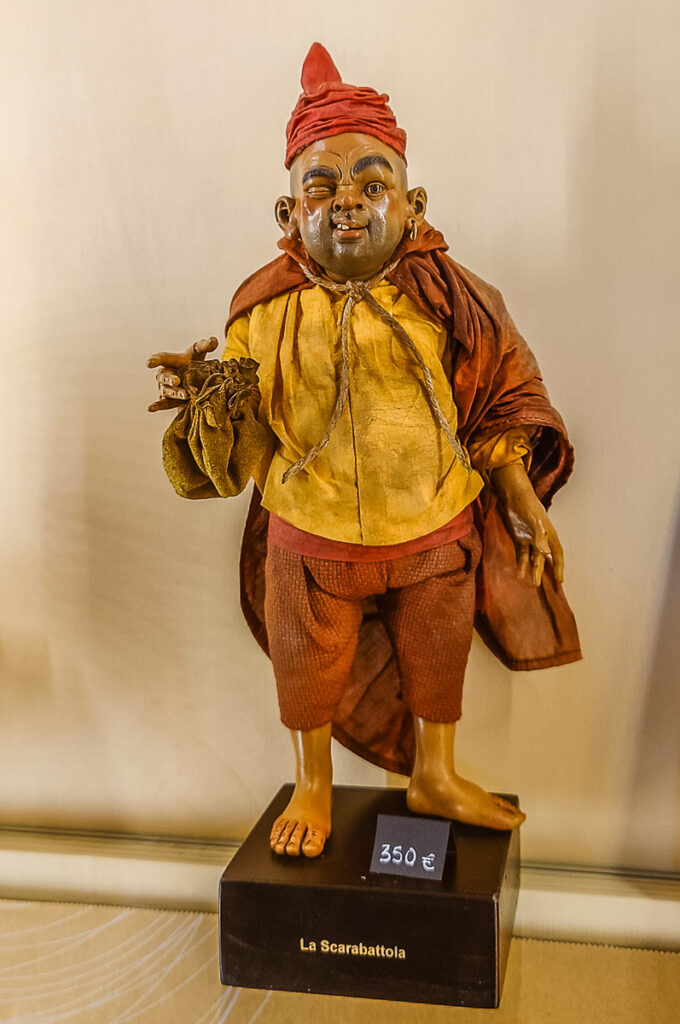
BEST TRAVEL GUIDES FOR NAPLES

WHAT TO BUY FOR NAPLES

WHAT TO BUY IN NAPLES
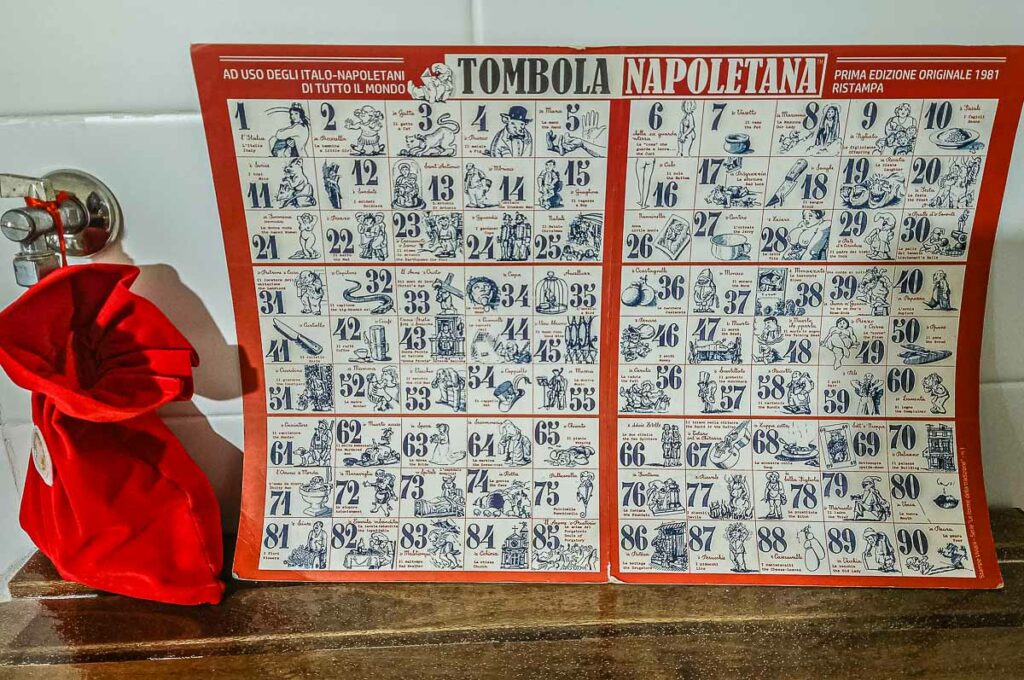
Shopping in Naples is an exciting experience on many levels. From artisan products and luxury goods to treat yourself to heaps of imaginative and colourful souvenirs to take home for family and friends, you will be tempted to spend, spend, spend time and time again.
Artfully arranged shelves and windows tempt you with handmade Nativity scenes , hand-painted Neapolitan tambourines, beautiful ceramics, hand-carved cameos , antique books, and so many more weird and wonderful, unusual and eclectic, rare and irresistible things.
Prices accommodate every budget! So, here are some cool things to buy in Naples and some of the best local makers to purchase them from:
Handmade Neapolitan Nativity scenes from Fratelli Capuano , La Scarabatola , and the shops along Via San Gregorio Armeno . Handmade Nativity scenes (known as presepe or presepio in Italian) are an intrinsic part of Naples’ artisan heritage.
Corno portafortuna (also known as cornicell o ) – you will see these chilly-like horns all around Naples. Traditionally red, nowadays they come in all sizes, colours, and variations. The locals believe that this Neapolitan amulet protects you and brings you good luck. For it to work, however, it needs to be handmade and given to you as a present. Apparently, you can’t just buy your own! D’Auria Artigiani make a large selection of cornicelli . Otherwise, you will find these amulets all over Naples.
Cameos by Gerolomini Gallery – this elegant shop has a wide selection of beautiful handmade cameos and coral jewellery. It also has a small museum dedicated to the delicate art of cameo-carving which is typical for the area around Naples.
Handmade bags and purses by Jiji Lovemade – I fell in love with Jiji’s colourful, vibrant bags during my week in Naples this summer. With beautiful patterns, they are both practical and elegant, perfect for city living and weekend travel.
Neapolitan tombola – a cheeky lotto-like game that Neapolitan families play together, especially at Christmas. Many small shops along Spaccanapoli and Via San Gregorio Armeno sell it.
Artisanal chocolate by Gay-Odin – this over a century-old Neapolitan company makes high-quality chocolates and chocolate-based products.
Cucumella – this traditional Neapolitan flip pot produces smooth and strong coffee. With its elongated design, it is a great conversation starter and is a great gift for the coffee lover in your life.
BEST BOOKS ABOUT NAPLES

5 CURIOUS FACTS ABOUT NAPLES
1. Naples has 52 patron saints – one for each week of the year. The city’s main patron saint is San Gennaro with whom napoletani signed a notarised contract on 13th January 1527 stipulating that the saint was to protect them from plagues and eruptions of Vesuvius.
2. In Naples, you can see not just the worldwide famous sculpture of the Veiled Christ , but also the sculpture of the Veiled Son. Both are carved from a single block of marble and the latter is the work of Jago – an Italian sculptor currently residing in New York. The Veiled Christ is in the Sansevero Chapel. The Veiled Son is in the Basilica of San Severo fuori le Mura. Both are a must-see!
3. Via di San Gregorio Armeno (also known as Via dei Presepi ) is Naples’ famous street that houses the workshops of the artisans who make the famous Neapolitan presepi . These intricate Nativity scenes include dozens of figurines and represent the Holy Family in the stables often surrounded by purely Neapolitan characters and settings. Curiously, millennia ago, this same street was lined with workshops producing terracotta figurines which people bought and left as votive offerings at the adjacent temple of Ceres – the Roman goddess of agriculture.
4. Naples’ historic city centre is one of the largest in Europe. Its many layers – from the deepest catacombs and underground water cisterns to its tall obelisks and church domes covered with majolica tiles – are the result of 27 centuries of history. Its surface encloses 1,700 hectares, 1,021 of which were declared a UNESCO World Heritage Site in 1995!
5. Napoletani are football-mad and are particularly obsessed with Maradona. Hailing from Argentina, the legendary footballer played for S.S.C. Napoli from 1984 to 1991 and took the Neapolitan team to the top of the game. To this day, Maradona has a god-like status in the city. Everywhere you go you will see his face on flags, murals, and even packets of crisps.
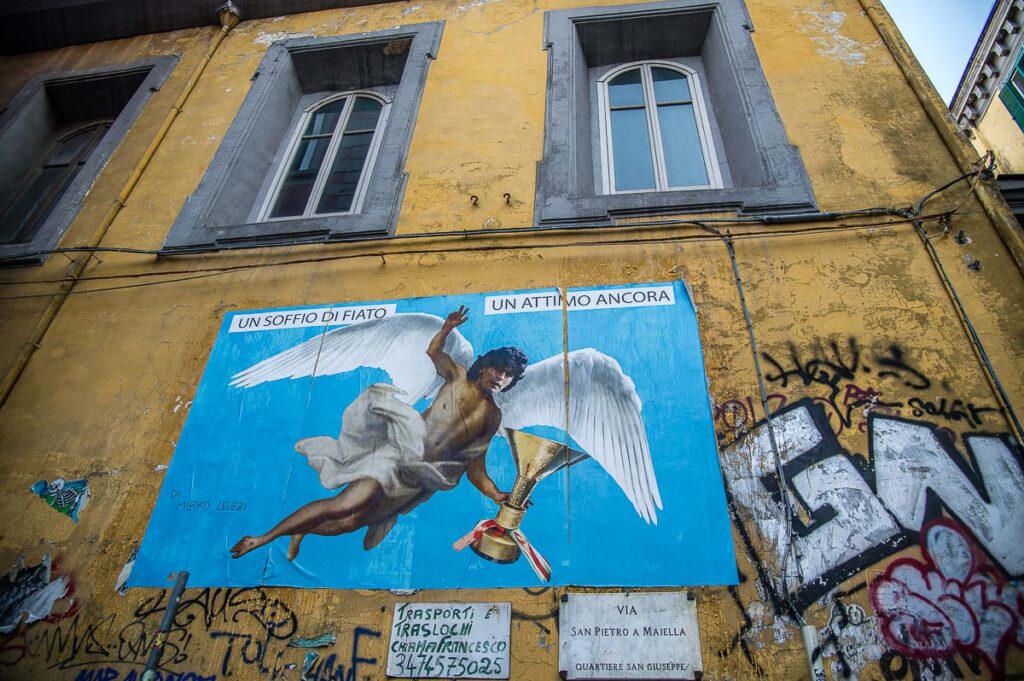
MY TOP 5 TIPS FOR NAPLES
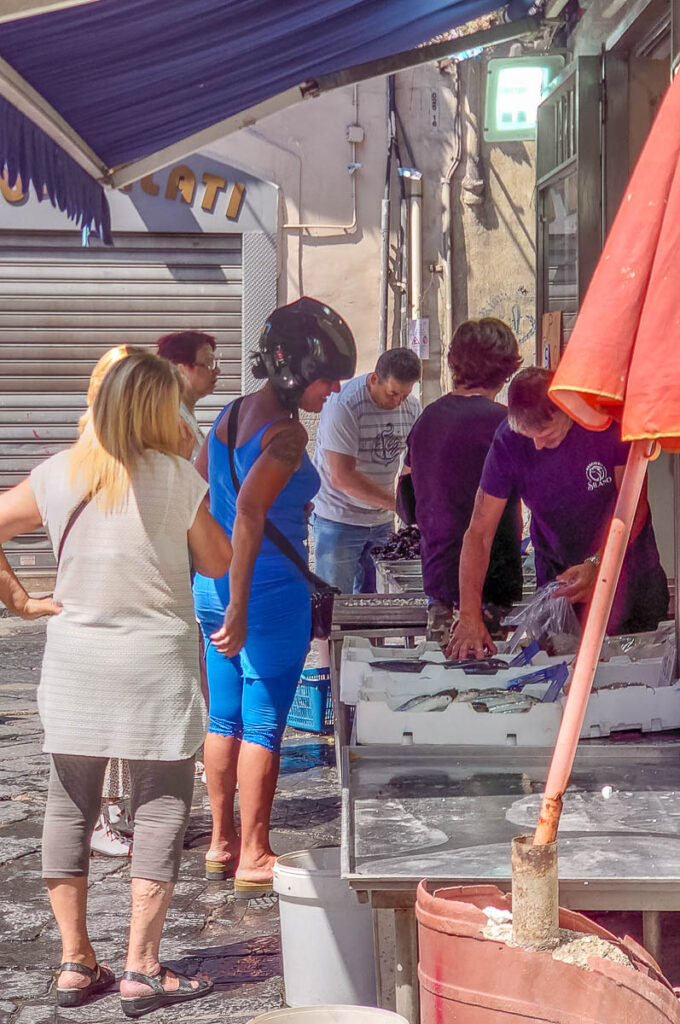
- Explore Naples area by area. This is a large and exciting city with lots to see and do. Group the sights you want to visit based on their proximity to one another instead of exhausting yourself by running all over town every day of your stay.
- Where possible, book entry tickets and tours in advance. This will minimise waiting times and will allow you to make the most of your day. Tiqets is a great resource for tickets for Naples’ best museums and landmarks. Viator is my favourite tool for booking guided tours.
- Bring your appetite. Naples is a city where eating is akin to an elevated cultural experience. From bakeries and family-run trattorias to restaurants with sea views and unmissable gelaterias, Naples runs on excellent food. Don’t skip a meal!
- Embrace Naples’ joy of life! This is a vibrant city that stimulates the senses on many different levels. Let it get under your skin!
- Indulge in people-watching. Naples is as much about its historic and artistic heritage as it is about its people. Take time every day to just stop and take in little scenes of daily life. Many napoletani are worthy of a book and you can read their story on their faces, in their gestures, and in a conversation with them.
5 THINGS NOT TO DO IN NAPLES
- Don’t expect to see the whole of Naples in a day or two. This is a large city with lots of major sights and plenty of hidden gems.
- Don’t hire a car. Traffic in Naples is intense, the driving style is incredibly assertive, and the historic quarters are akin to mazes of narrow streets. Free parking spaces can be very difficult to come across, so parking needs to be organised in advance. Most importantly, Naples has several ZTL’s (limited traffic zones) which are accessible only with special dispensations (for example, local residents and hotel guests) and more or less cover the areas with the biggest concentrations of landmarks and sights.
- Don’t buy counterfeit luxury and designer goods . Heavy fines are in place for tourists tempted to buy knock-offs which you may see being sold from sheets spread directly on the ground around town.
- Don’t be negative about Naples and/or its icons. As with every large city with a millennial history, Naples has its own specific problems which are easy to spot. The least a visitor to the city can do is to show respect to the people who have to deal with them on a day-to-day basis. Neapolitans have also elevated certain personalities to a god-like status. Disrespect is not tolerated no matter how well-based your opinion about them may be.
- Don’t accept unsolicited offers for help. Most often than not they will be followed by a request for a tip. At busy spots around town, for example, train or metro stations, you may be approached by a smiley person eager to explain how to get from point A to point B. Don’t engage! If you really need directions, it’s best to ask at the ticket office or a uniformed employee.
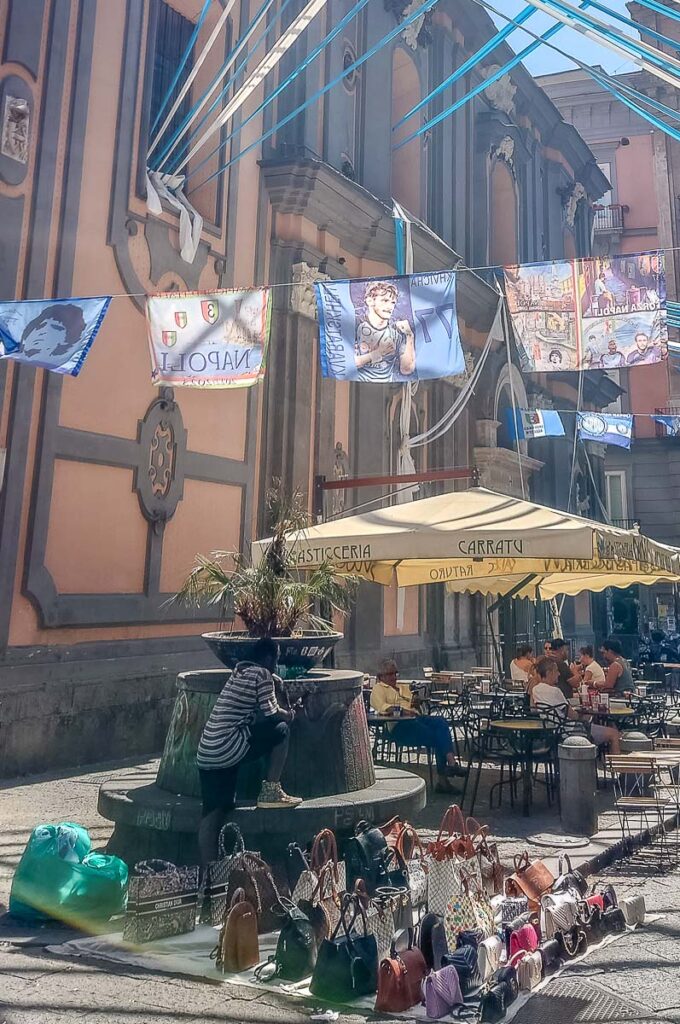
MORE INFORMATION ABOUT ITALY
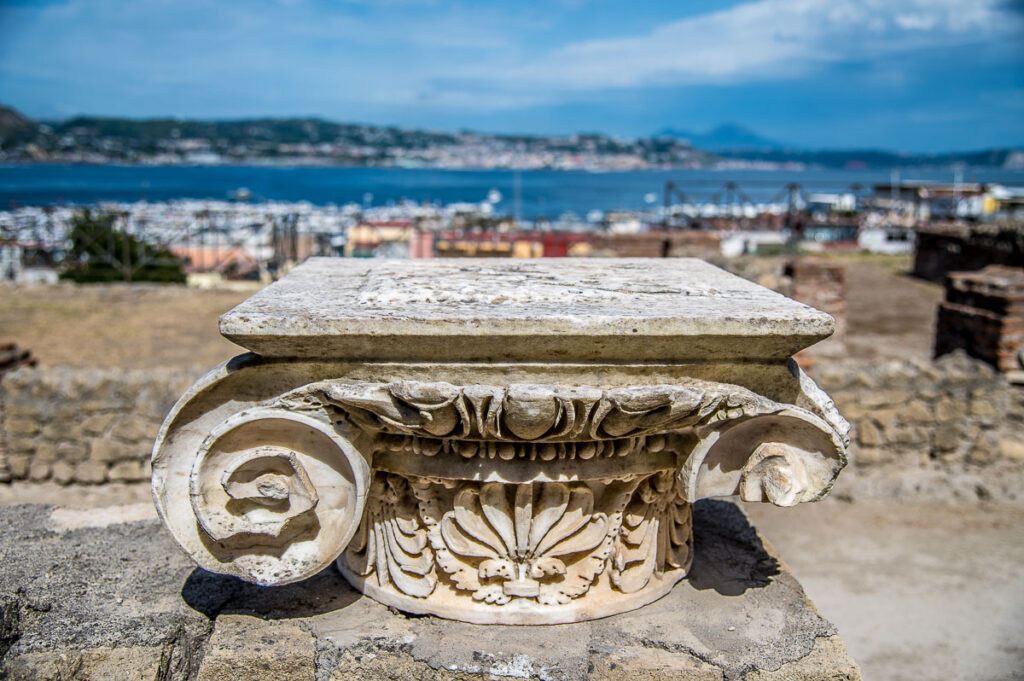
I have been blogging about travel in Italy for almost ten years now providing detailed and first-hand tried and tested information about the best things to do in this beautiful country. It’s all based on my close to twenty years of visiting Italy solo and with my family. Six of them, we actually spent living in Vicenza in the north of the country .
If you are after in-depth researched and illustrated with dozens of original photos articles about Italy, have a look at the following categories and blog posts:
- Italy – a full list of all my blog posts about Italy
- 10 Reasons to Visit Northern Italy
- Veneto , Trentino , Emilia Romagna , Umbria – full lists of all my blog posts about these Italian regions
- Venice , Padua , Lake Garda , Lake Como , Milan – full lists of all my blog posts about these must-see destinations in Italy.
In addition, right at the end of this page, you will find a list with links to some of my most popular blog posts about many beautiful and exciting cities, towns, and regions to visit in Italy. So, just scroll down and then click on the ones you want to know more about.
Finally, Italy’s official tourism website is a great source of the latest news about travel in Italy. Otherwise, this is one of the best guidebooks about Italy.
THANK YOU FOR READING
Have a look also at my ultimate travel guides for Venice , Lake Como , and Lake Garda .
For more useful information like this, please, like my blog’s page on Facebook and Instagram and subscribe to my strictly no-spam newsletter.
Email address:
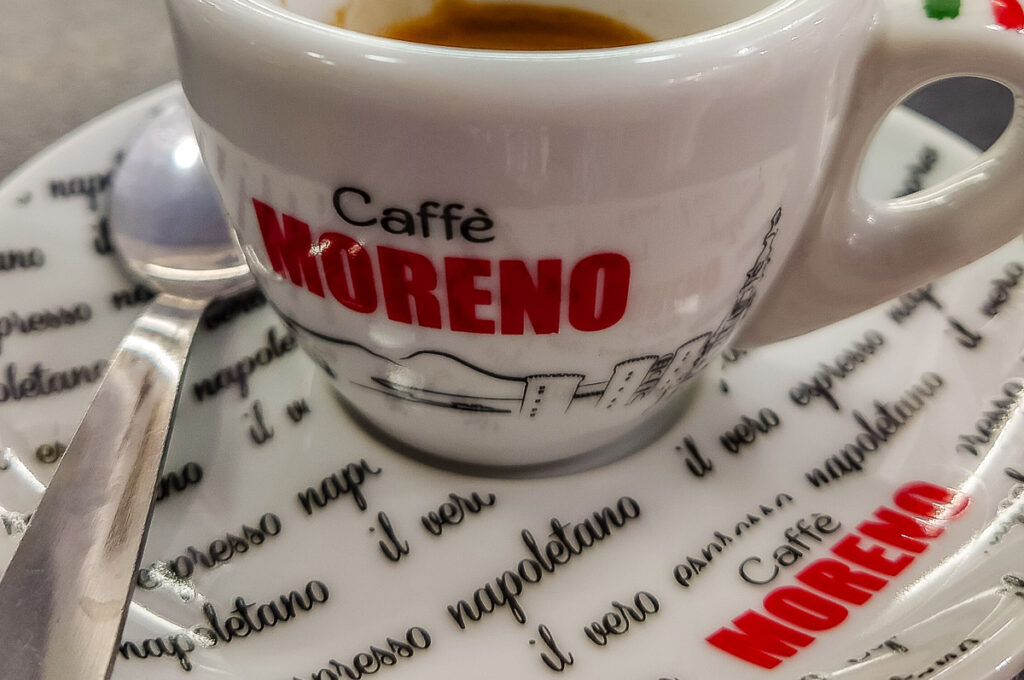
TRAVEL TOOLS
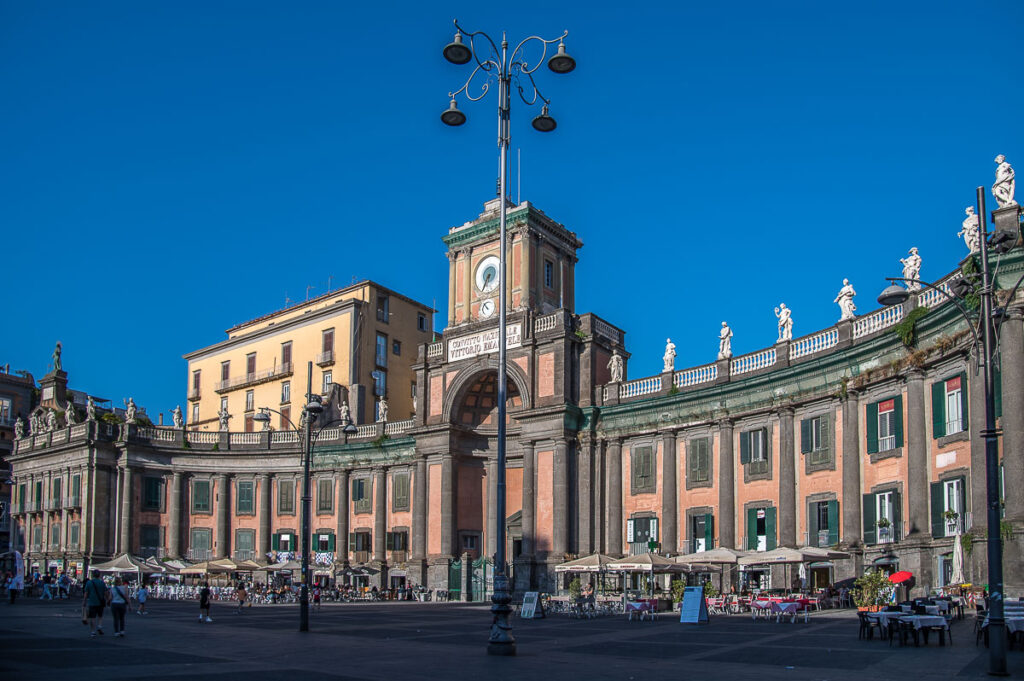
Get Ready for Your Trip to Naples in Italy
Get a guidebook from Amazon. Buy plane tickets , train tickets , and bus tickets through Omio. Research accommodation on Booking.com. Select local tours and activities on GetYourGuide , Viator , and Tiqets .
EVEN MORE HELPFUL INFO ABOUT ITALY FOR YOU
Best of Italy: Italian Piazzas , Italian Markets , Accommodation for Every Budget , Best Times to Visit Italy , Italy in Summer , Italy with Kids Italian Food: Best Italian Food Gifts , Cheap Italian Food , Rules of Italian Breakfast , Italian Breakfast Foods Italian Coffee: Italian Coffee Culture , Italian Coffee Drinks , History of Coffee in Italy Christmas in Italy: Fun Facts , Things to Do , Italian Nativity Scenes , Panettone , Christmas Guide Northern Italy: Best Cities to Visit , Major Airports , Reasons to Visit Lake Como: Ultimate Travel Guide , Best Towns , Best Things to Do , How to Get to Lake Como , Milan to Lake Como , Best Airports , Photos of Lake Como Lake Garda: Ultimate Travel Guide , Best Towns , Desenzano del Garda , Lazise , Riva del Garda , Malcesine , Torri del Benaco , Punta di San Vigilio , Campo di Brenzone , Borghetto and Valeggio sul Mincio , Map of Lake Garda , Getting Around Lake Garda , Lake Garda with Kids , 8 Best Airports , Venice to Lake Garda , Verona to Lake Garda , Milan to Lake Garda , Bologna to Lake Garda Venice: Ultimate Travel Guide , Essential Tips , Things to Do , Major Landmarks , Hidden Gems , How to Navigate Venice , Venice in a Day for Art Lovers , Train Stations , Nearest Airports , Best Tours , Beaches of Venice , Quotes about Venice , Boats in Venice , Haunted Venice , Day Trips from Venice , Arco del Paradiso Verona: Things to Do in One Day , Verona Opera Festival , Day Trips from Verona , Romeo and Juliet Itinerary , Verona to Venice , Verona to Milan Padua: Things to Do in One Day , 101 Facts About Padua , 10 Reasons to Visit Padua , Day Trips from Padua Vicenza: Things to Do , Day Trips from Vicenza , Best Museums , The Beauty of Vicenza Veneto: Top Places to Visit , Unique Adventures , Most Colourful Places , Mysterious Places , Most Beautiful Lakes , Reasons to Visit , Main Cities , Prettiest Small Towns , Most Beautiful Villages Lombardy: Best Cities and Towns , Reasons to Visit , Brescia Friuli Venezia Giulia: Venzone , Most Beautiful Villages Emilia Romagna: Bologna , Ravenna , Comacchio , Most Beautiful Villages Marche: Reasons to Visit , Gradara , Frasassi Caves , Temple of Valadier Umbria: Reasons to Visit Perugia
The Top 18 Things To Do In Naples, Italy: The Naples Travel Guide
Updated June 2024, The Top 18 Things To Do In Naples, Italy: The Naples Travel Guide was originally published in August 2020
My fascination with Napoli is multi-faceted. My Mom’s family spent some time living there before boarding a ship bound for New York in the earlier part of the 20th century.
In my early 20s when I finally made it to Italy I was more fascinated by Sicilia and the Ionian Sea coast of Calabria where my family had hailed from originally, so Naples hadn’t landed on my must-visit list- but a woman I met on an overnight train to Syracusa (who was on her way home from a weekend in dirty Napoli) whipped out a switchblade and told me and my friend that she never travels to Naples unarmed piqued my interest.
Naples has a bad reputation for being polluted, piled with trash, riddled with crime, and infested by the Camorra for several decades. Despite all that, Naples has experienced a bit of a renaissance in recent years with a movement that has sought to clean the city up starting with the trash and pollution. Of course, things aren’t perfect in Naples, but is it really anywhere?
Personally, I have a soft spot for Naples as it is my favorite place to eat in Italy without a doubt, and a perfect little weekend escape. In this guide, I’ll include the best things to do in Naples and more.
Start planning your trip around the South of Italy
Need Travel Insurance and Evacuation Services for Italy?
Start shopping for travel insurance plans over at IATI Insurance . Readers of the Adventures of Nicole get a 5% discount off your plan.
The Adventures of Nicole partners with Global Rescue to offer the world’s leading medical evacuation and security advisory services. To travel with peace of mind, shop evacuation coverage at Global Rescue .
A Quick History Of Naples, Italy
Settled in the second millennium BC by the Greeks, on to become a colony known as Parthenope in the 9th century BC, and then founded as the city of Neapolis in the 9th century BC, Napoli has quite the long history.
An important center of the Magna Graecia, a capital of the Duchy of Naples, the Kingdom of Naples, and finally of the Two Sicilies before the Unification of Italy in 1861 Naples has been a center of culture, the arts, and politics.
Naples wasn’t always so prosperous though. The 19th and 20th centuries saw droves of Neopolitians emigrate to the US, Argentina, and Australia citing poverty and fading opportunity (a common theme throughout Southern Italy in general at the time). During WWII Naples was badly damaged in bombing campaigns by the Allied Forces.

Things To Do In Naples, Italy
Order a pizza at gino sorbillo’s.
Before I headed down to Naples for a weekend after my arrival at my temporary home in Terracina back in 2018 I asked my friend Igor who grew up between Itri and Naples where to grab a pizza and instantly he whipped back “Gino Sorbillo’s of course!”
This place is well known, and you’ll likely have to wait in line for quite some time, but in all honestly, it’s totally worth it- this is the pizza you’ve been dreaming of (I still dream about to this day now that I’m far far from Italy). Gino is a third-generation pizzaiolo, who is widely regarded (arguably) as the best in all of Italy. His ethos behind the perfect pie is the art of keeping it simple.
The family’s original restaurant opened in 1935 along Via dei Tribunali in the historic center of Naples and is still there to this day.
Metro stop: Dante
Santa Chiara Complex
The Santa Chiara Complex is a religious complex centered around the Santa Chiara Basilica and features a monastery, the tombs of the King Robert of Naples and Queen Sancha of Majorca, and an archeological museum. The church was badly damaged during WWII, but has since been renovated.
Entrance to the Santa Chiara Complex: €6
Visit Castel St. Elmo
Castel St. Elmo is now appreciated for its amazing panoramic views of Naples and for its Museo del Novecento housing numerous 20th century Neopolitian pieces, but it was originally a church built in honor of Saint Erasmus. in the 14th century the church as converted into a castle and fortified.
Entrance to Castel St. Elmo: €5
Metro stop: Vanvitelli
Wanna see Italy’s lesser-known side? Check out my favorite off the beaten path destinations in Italy
Explore The Quartieri Spagnoli
The Quartieri Spagnoli (Spanish Quarter) is a colorful and the most densely populated neighborhood of Naples. The Spanish Quarter came to be as a garrison for Spanish troops in the 17th century when the Kingdom of Naples was ruled over by the Spanish.
Now it’s a maze of colorful, crumbling and peeling buildings crisscrossed by alleys so narrow some pavement never sees the sunlight.
Metro stop: Toledo

Take A Break At Piazza del Plebiscito
Piazza del Plebiscito is the grandest and largest public square in Naples, home to the Basilica of San Francesco da Paola, Palazzo Reale, Palazzo della Prefettura, Palazzo Salerno, statues of Charles III of Spain and Ferdinand I, and the Gran Caffe Gambrinus. The Piazza del Plebiscito is one of the best places in Naples to just sits and watch.
The Palazzo Reale is Naples’ royal palace, attached to the Teatro di San Carlo. The palace served as one of the four residences of royalty during the Kingdom of Naples and the Kindom of the Two Sicilies. It now houses the Museo del Palazzo Reale.
Entrance to the Palazzo Reale: €6
Metro stop: Municipio
Catch An Opera At Teatro di San Carlo
Located next to Piazza del Plebiscito, Teatro di San Carlo is Naple’s opera house and the longest continuously opera house in the world.
Teatro di San Carlo Tickets: Prices range from €30-250 depending on the show and seating choice
Get Underground At The Napoli Sotterranea
Explore Naples underbelly by getting underground and diving into the Napoli Sotterranea. The Napoli Sotterranea is a labyrinth of passageway, aqueducts, and cisterns originally laid out by the Greeks to mine tufa stone and channel water from Mount Vesuvius, but later expanded by the Romans, and then on to serve as air-raid shelters during WWII.
Tours are mandatory and are offered in English every two hours starting at 10 am, 12 pm, 2 pm, 4 pm, and 6 pm. Tours in Italian run every hour on the hour between 10 am-6 pm.
Napoli Sotterranea Tickets: €10
Castel dell’Ovo
Meaning ‘castle of the egg’ Castel dell’Ovo is Naples’s oldest castle, built by the Normans in the 12th century. The site of Castel dell’Ovo is also where the Greeks first settled the city in the 7th century BC naming the island the castle now sits upon Megaris.
Entrance to the Palazzo Reale: Free
Shop At Mercato di Porta Nolana
Located right outside the Piazza Giuseppe Garibaldi Metro Station/Napoli Centrale, the Mercato di Porta Nolana is one of the best places to begin your walking tour of Naples from. You can find almost anything along here, from greengrocers fishmongers, bootleg movies to fast-food snacks.
Metro stop: Piazza Giuseppe Garibaldi
Continuing on the Basilicata? Don’t miss Castelmezzano & Pietrapertosa
Check Out The Museums
Museo archeologico nazionale.
- Museo Archeologico Nazionale entrance: €12
- Metro stop: Museo or Piazza Cavour
- Madre entrance: €7
- Metro stop: Piazza Cavour
San Lorenzo Maggiore
- San Lorenzo Maggiore Archeological site and museum entrance: €9 (entrance to the church is free)
- Metro stop: Museo
Pio Monte della Misericordia
- Pio Monte della Misericordia entrance: €7 (entrance to the church is free)
Certosa e Museo di San Martino
- Certosa e Museo di San Martino entrance: €6
- Metro strop: Vanvitelli
Galleria di Palazzo Zevallos Stigliano
- Galleria di Palazzo Zevallos Stigliano entrance: €5
- Metro stop: Municipio
Palazzo Reale di Capodimonte
- Palazzo Reale di Capodimonte entrance: €8
- Metro stop: Materdei
Castel Nuovo
Built by Charles I of Anjou in 1279, Castel Nuovo served as a royal residence. Now it houses the city council and two museums.
Castel Nuovo entrance: €6
Metro stop: Municipio
Where To Sleep In Naples
Hotel Zara Napoli | Booking.com | Hotels.com |
Hotel Piazza Bellini | Booking.com | Hotels.com |
Romeo Hotel | Booking.com | Hotels.com |
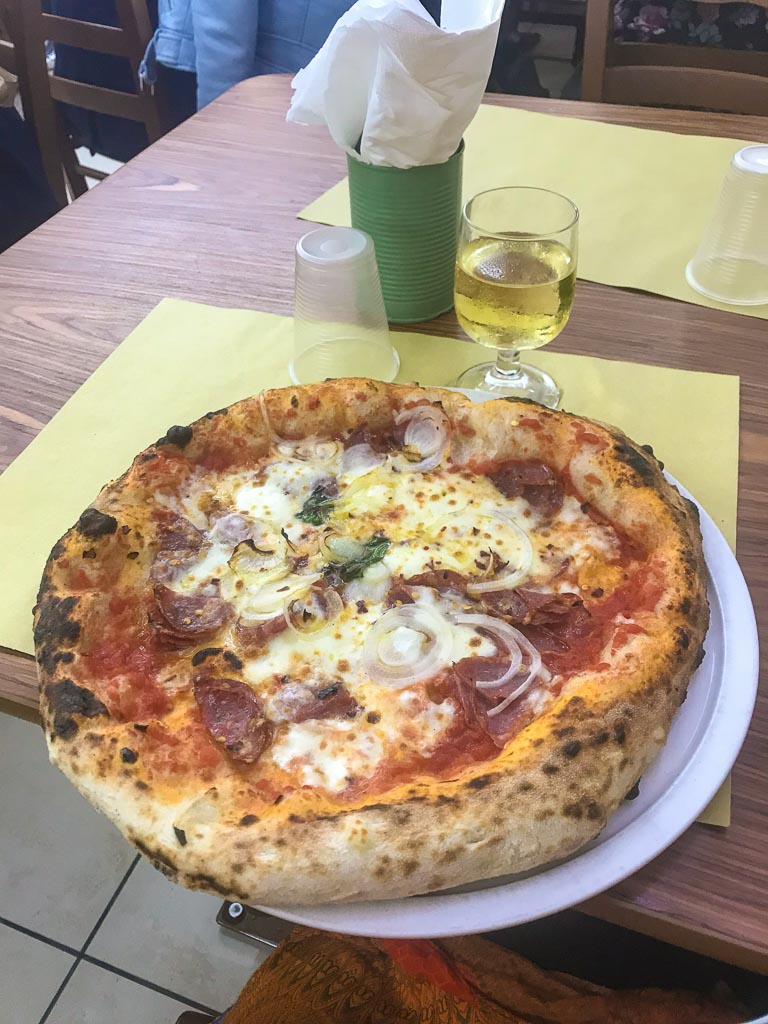
Where To Eat In Naples
Naples is one of my favorite cities to eat my way across in all of Italy. Here are just a handful of restaurants I loved and dishes you should try in Naples.
Gino e Toto Sorbillo
Naples is famed for its pizza, and Gino Sorbillo is likely the most famous pizzaiolo in Naples.
If you missed it in the earlier part of this post with Gino Sorbillo’s pizzeria being listed as one of the best things to do in Naples, here it is again! The pizzas are wood-fired perfection.
Best Arancini
La Sicilia Di Serafino Napoli
Arancini hail from Sicily of course, created in 10th century Sicily when the island was under Arab rule. These little fried balls of heaven are traditionally stuffed with a ragu consisting of a tomato-based meat sauce, mozzarella, and rice, though there are countless variations (I’ll admit the traditional arancini al ragu are my favorite).
I’ve stopped by and grabbed an arancini (or three) at La Sicilia Di Serafino Napoli when I was passing by (typically to go wait in line at Gino e Toto Sorbillo down the street), however, you can find plenty of delicious arancini at many streetside vendors all over the city.
Best Sfogliatelle
Sfogliatelle Attanasio
These popular little pastries, shaped like a seashell are an easy breakfast favorite. Sfogliatelle translates to little leaves- pointing to its appearance of little leaves stacked together.
The origins of Sfogliatelle actually trace back to nearby Conca dei Marini along the Amalfi Coast. Sfogliatelle Attanasio is regarded as one of the best purveyors of the flaky sfogliatelle in Napoli, but you can easily find them in patisseries all over Naples as well as the rest of Italy.
Pizza Fritta
La Masardona
Pizza Fritta is an essential street food and quintessentially Neopolitan. Did you know that deep-fried pizza predates the oven-baked pizza known the world over? La Masardona is a longstanding Napoli landmark, still family owned and operated, and is regarded among the best fried pizzerias in Naples.
Things To Do Near Naples
Visit pompeii.
Pompeii is among the most important archeological sites in all of Europe. The bustling Roman city was wiped off the map in 79 AD when Mount Vesuvius blew, though luckily for its residents most had already evacuated 17 years prior due to a massive earthquake that struck the ancient city.
You can easily reach Pompeii by grabbing a train from Naples and getting off at the Pompeii-Scavi Train Station
Pompeii entrance: €13
Explore Herculaneum
Smaller and easier to navigate than Pompeii, the Herculaneum ruins are still very much worthy of a visit. Numerous archeological finds have been discovered here. From the Ercolano-Scavi Train Station, the Herculaneum ruins can easily be reached on foot.
Herculaneum entrance: €6
Climb Mount Vesuvius
Mount Vesuvius is famous for blowing its top over 30 times since its major explosion in 79 AD. You can view the volcano from just about anywhere along the shores of the Bay of Naples, but the view from the top looking down is outstanding.
The cheapest way to get to Mount Vesuvius is by using the public EAV bus.
Mount Vesuvius entrance: €6

Explore The Gorgeous Amalfi Coast
The Amalfi Coast is something of legend. This gorgeous stretch of Campania extends south from the southern edge of the Bay of Naples, encompassing a promontory jutting out into the sea.
After traveling the Amalfi Coast back in 2018, I thoroughly recommend renting a car from Naples and making your own itinerary if you’re not visiting in high season. But if you are taking on the Amalfi Coast in the height of summer I would recommend utilizing the ferry system between the gorgeous towns that dot the coast.
Read more about the Amalfi Coast and start planning your trip here .
Check out my quick guide to the Amalfi Coast
See Why All The Celebrities Go To Capri
The natural beauty of Capri has drawn in crowds for centuries, from the Romans to modern-day celebrities. Sapphire blue grottos, sky-high cliffside views, crazy rock formations, and more seem to elicit a visit (except me, because we couldn’t get there when I was in Naples due to bad weather!).
You visit Capri for a few days, staying on the island, or you can take a ferry across the bay from Naples and make it a day trip. Shop Capri accommodations here .
Get Off The Beaten Path In Procida
Procida honestly was the island I was most sad not to visit when I traveled around Campania, Basilicata, Puglia, and Calabria with my friends in 2018. We had our crosshairs set on Procida, but because of the horrible weather and rough seas, the ferries were canceled.
A couple of friends that have made it to Procida have described it as the ultimately perfect Mediterranean island with colorful buildings and charming beaches.
One thing that I was told by Italian friends is that Procida can be quite crowded in July and August because it’s no secret among the Italians (Italians are privy to the best secret spots that foreign tourists don’t seem to know about). So if planning to visit Procida in July-August, I’d suggest locking in your plans well in advance. Shop Procida accommodations here .
Check Out Big Little Ischia
Ischia is the largest and most developed of the islands in the Bay of Naples.
I noticed most of the friends I made in Terracina , Sperlonga , and Itri while I was based up that way would say that Ischia was their favorite of the Bay of Naples Islands, over Capri because of the affordability and lower tourist numbers. Shop Ischia accommodations here .
Have Any Questions About Visiting Naples?
Ask in the comments section below.
More Posts from Italy:

Two Week Classic Italy Itinerary
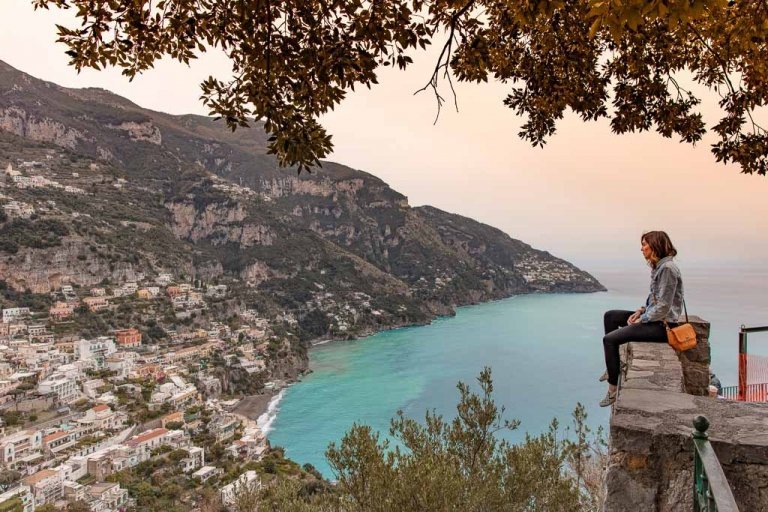
A Quick Amalfi Coast Travel Guide
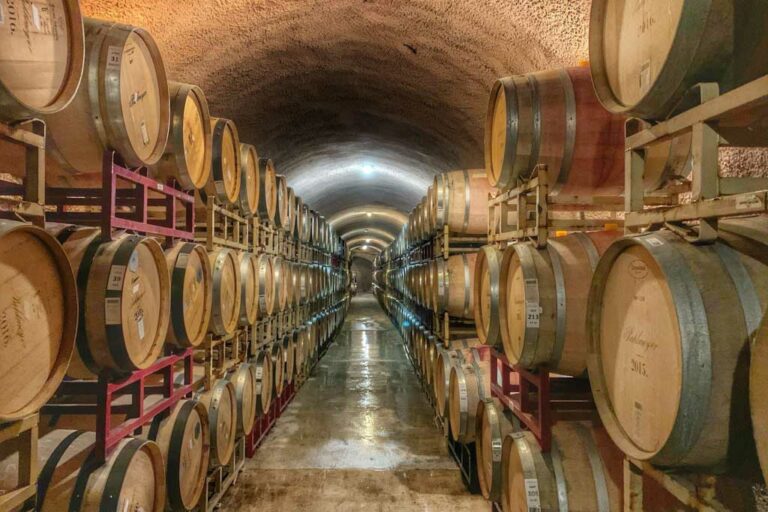
Discover The Best Wine Routes Across The Globe

A Quick Guide To Syracuse & Ortygia Island, Sicily
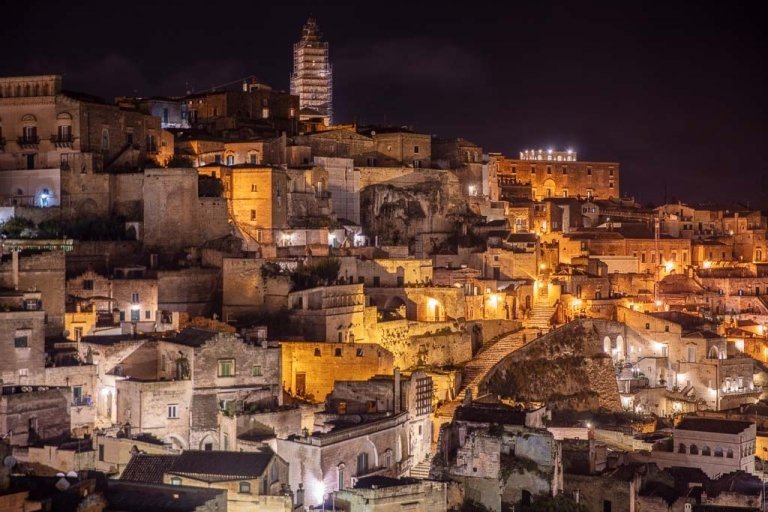
A Quick Guide To Italy’s Cave City Of Matera
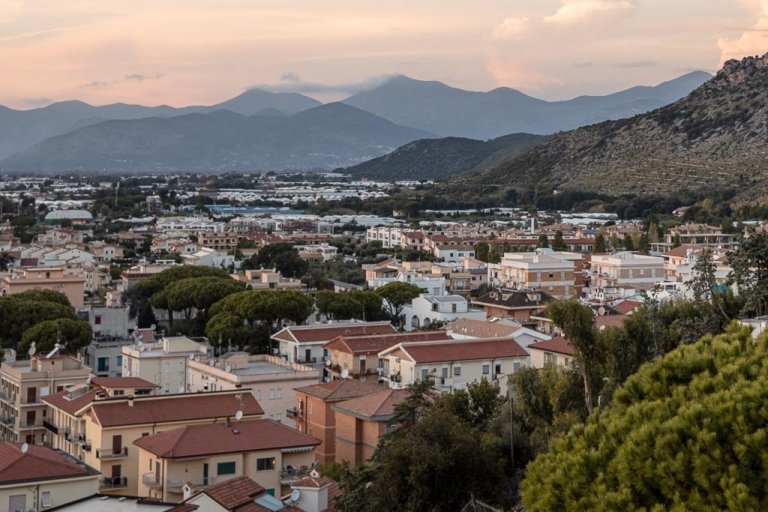
20 Off The Beaten Path Destinations In Italy
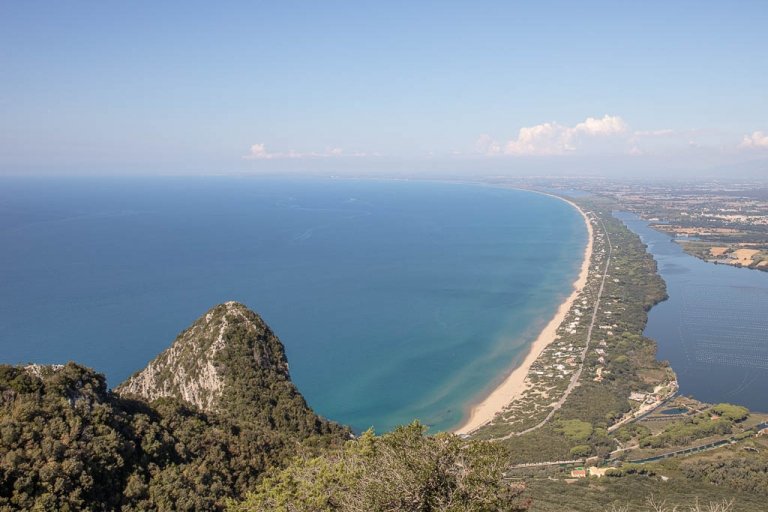
Hiking Mount Circeo In Italy’s Lazio Region
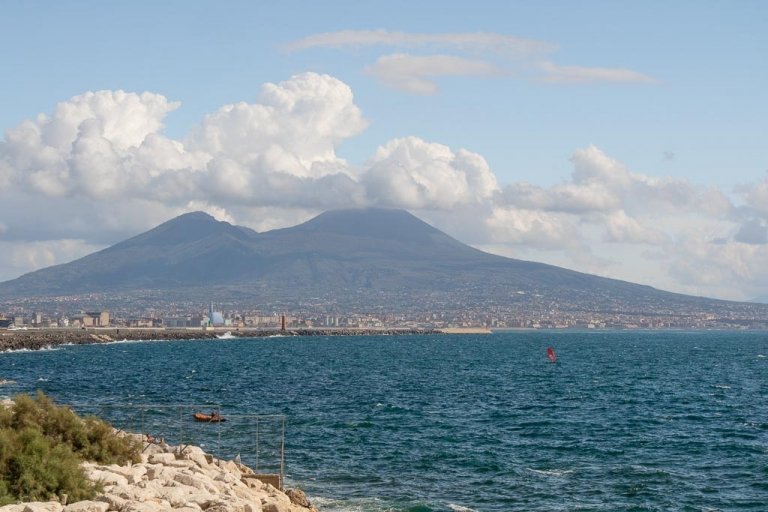
A Quick Guide To Alberobello + 5 Things To Do In Alberobello
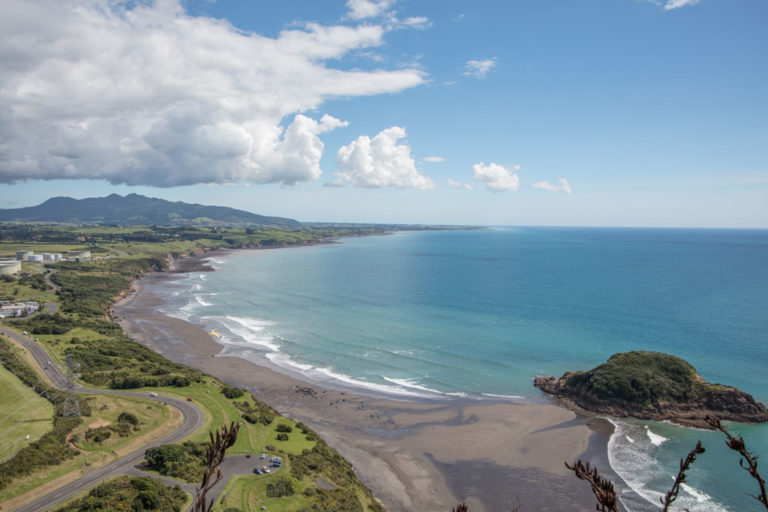
The Best Road Trips In The World
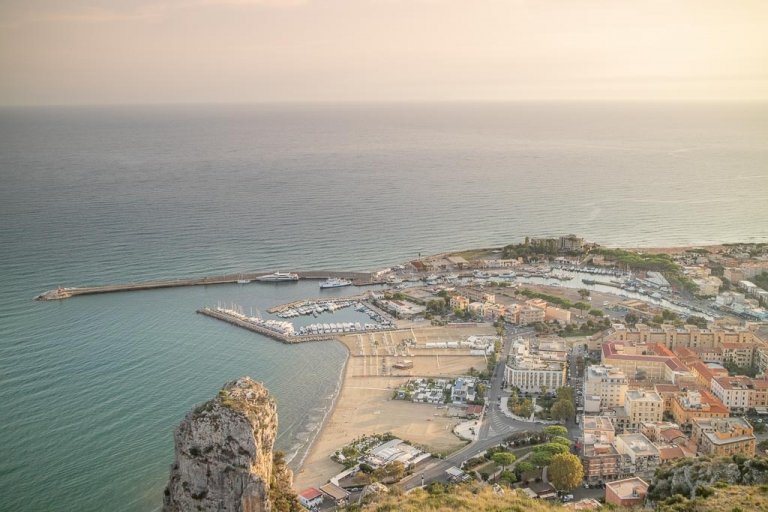
Terracina Travel Guide + Things To Do In Terracina
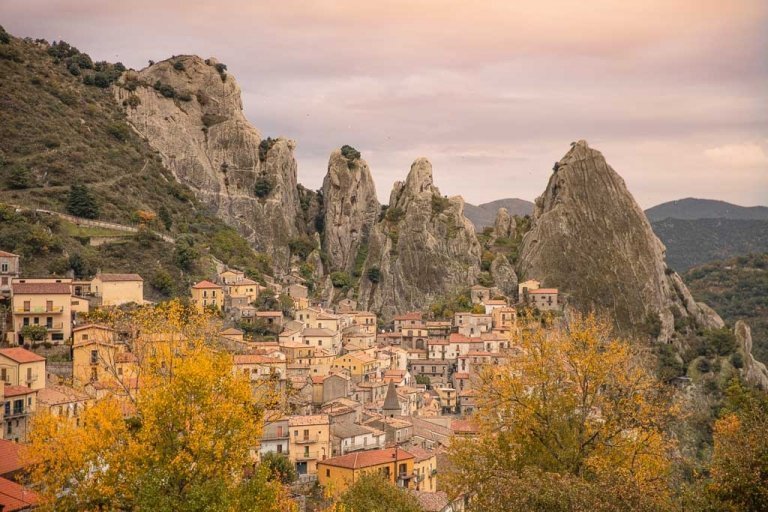
A Quick Guide To Castelmezzano & Pietrapertosa, Italy
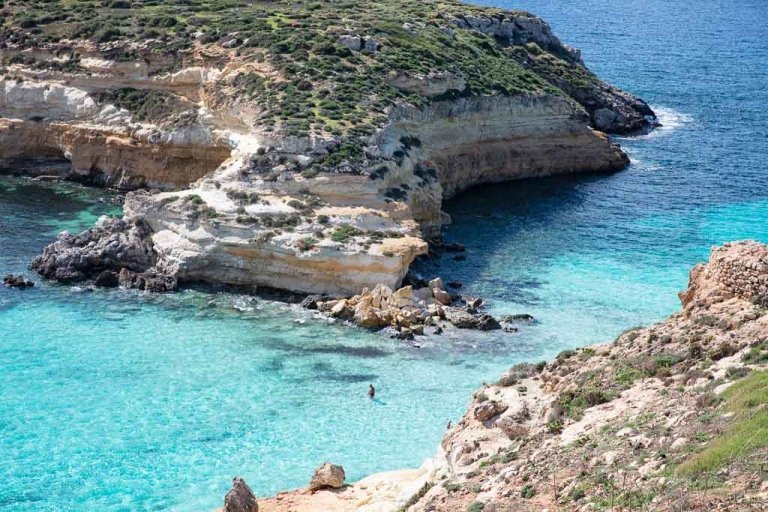
Lampedusa Travel Guide: Italy’s Southernmost Island
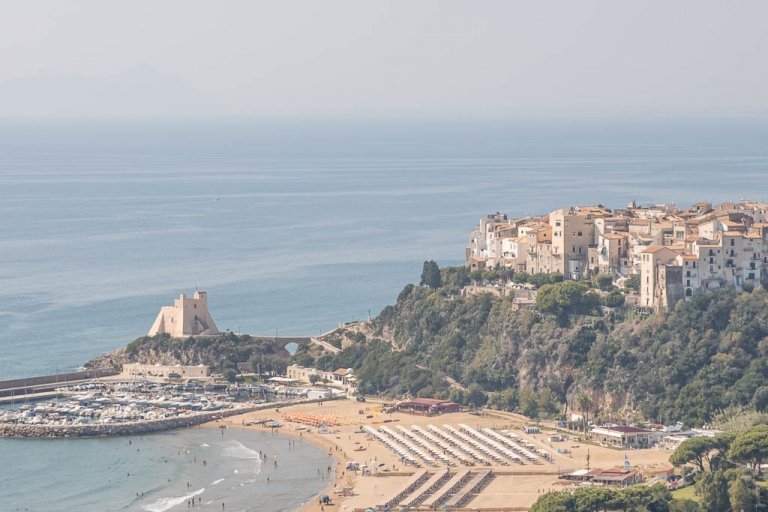
Sperlonga: Lazio Region’s Best Kept Italian Secret

Southern Italy Road Trip: From Heel To The Toe

One Day In Rome: It Wasn’t Built In A Day, But You Can See It In One
Two tornados, a road trip, & italian citizenship.
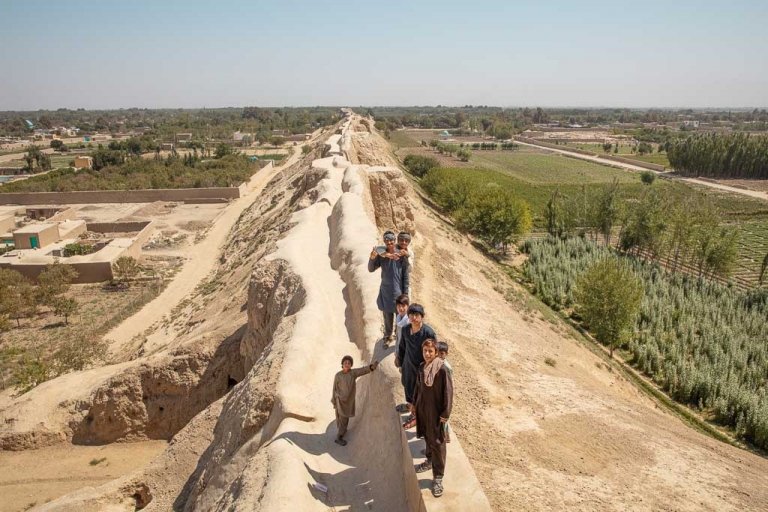
Marco Poloing Around: The Long Way to Italy, Via Afghanistan
Leave a comment cancel reply.
Your email address will not be published. Required fields are marked *
Notify me of followup comments via e-mail. You can also subscribe without commenting.
This site uses Akismet to reduce spam. Learn how your comment data is processed .

- Meet the Team
- Work With Us
- Itineraries
- Italy Travel Guide
- Hawaii Travel Guide
- Travel Tips
Things to do
Top 20 things to do in naples, italy: must-see attractions.
Are you planning a trip to Naples, Italy? Whether it’s your first time or fourth, there is so much to explore and experience in this beautiful city. From its stunning beaches and historical monuments to the delicious cuisine and vibrant nightlife, Naples is such a unique destination that will immerse you fully into southern Italian culture.
If you’re looking for things to do in Naples on your first visit, we have compiled a list of 20 activities that will help make your trip unforgettable, from exploring ancient ruins and sampling local delicacies to discovering hidden gems off the beaten path.
Planning your trip to Naples?
- Book a transfer from the airport to Naples city center
- Rent a car from the Naples airport through Discover Cars .
Where to Stay in Naples See all hotel options
Naples is a city where boutique hotels are the norm, rather than hotel chains. We’ve stayed at loved these small independent hotels:
- Toledo 16 Luxury Suites (Express check-in/out; elevator)
- Domo20 Hotel & Sky Bar (free full breakfast, a roundtrip airport shuttle, and a rooftop terrace)
Best Tours and Experiences in Naples:
- Full-day Sorrento, Amalfi Coast, and Pompeii Day Tour from Naples (two of Italy’s UNESCO World Heritage-listed attractions!)
- Naples Food Tour With Eating Europe ( read our full review here )
- Naples Walking Tour with Underground Ruins (4-hr walking tour of historic center)
The reason we love visiting Naples is because it practically oozes with renaissance and culture, with its narrow cobblestone streets, impressive architecture, and vast amounts of history.
You can get lost in the sights and monuments, or you can dig deeper into one small area and fall in love with the romanticism of the neighborhood. Trust me, it’s real.
This city has no shortage of beautiful scenery to capture. You’ll also find yourself spoilt for choice with pizza. Seriously, we eat like 10 pizzas every time we go.
» Here is our 2-week Italy itinerary to help you plan your trip around Italy’s top cities . We also have a travel guide for Venice , a 3-day Rome itinerary , things to see in Florence , foodie things to do in Bologna , and a guide to the top landmarks in Italy . Learn about renting a car in Italy . Be sure to check out our 2-week Europe Itinerary .
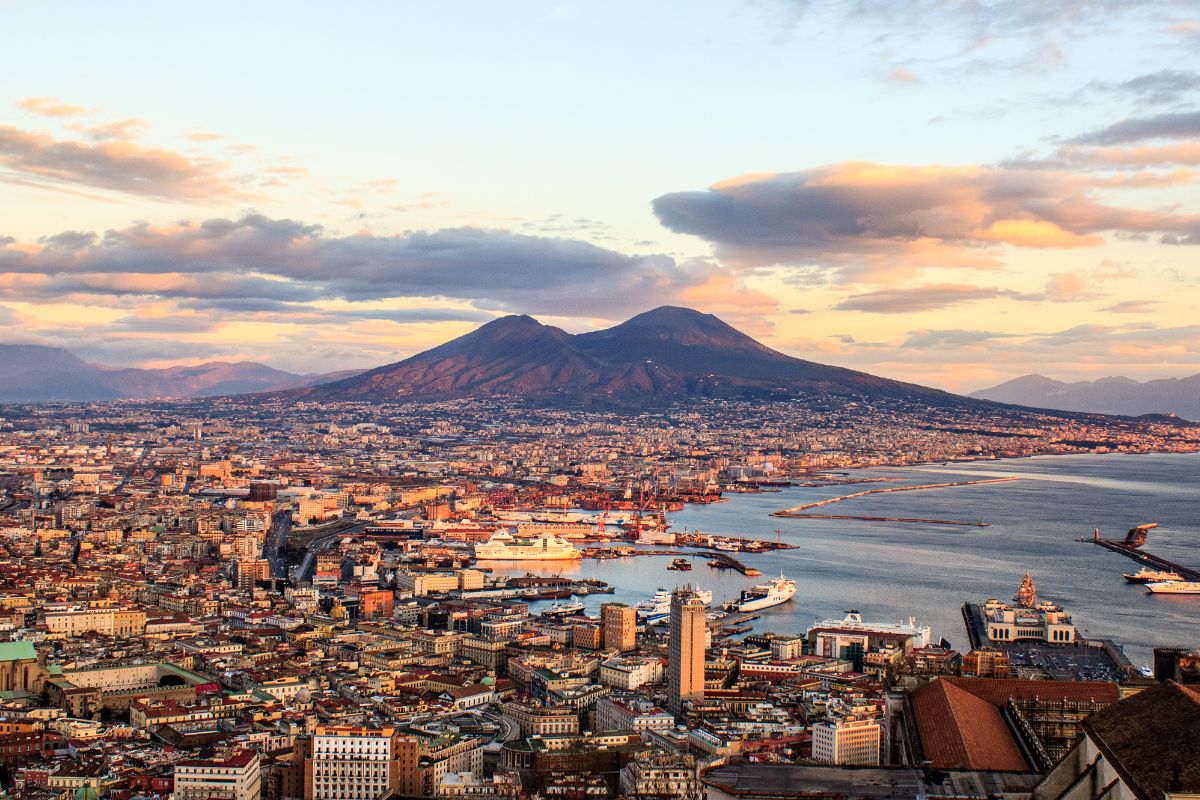
Be Prepared For Travel Planning is the most important part of any successful trip. Do it the easy way:
🧳 Travel Packing List | ✔️ Why You Need Travel Insurance | ✈️ What to Do Before You Leave Home
- Find and book the best hotel (our favorite booking site is Expedia)
- Research flight options (our favorite tool is Skyscanner )
- Book a tour (we always use Viator to find the best tours)
- Rent a car through Discover Cars (they search the best deals for you!)
Table of Contents
20 Best Things to Do in Naples, Italy
1. visit the naples national archaeological museum.
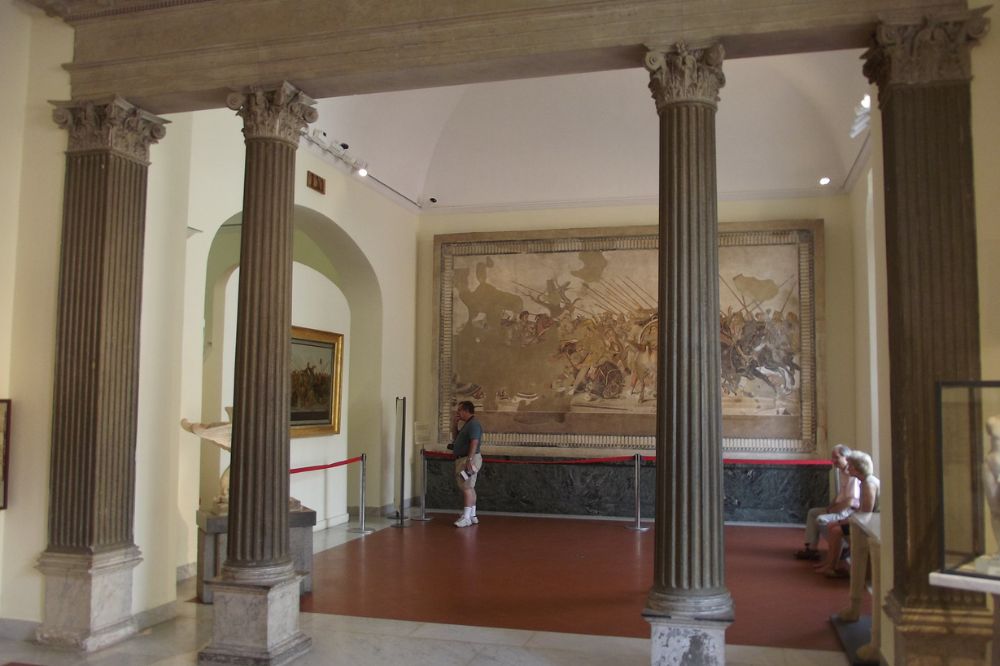
History buffs will enjoy geeking out at the Naples National Archaeological Museum. This world-famous museum boasts an extensive collection of objects from antiquity, including frescoes and mosaics.
The first two floors are an ode to Pompeii and Herculaneum, paying homage to the destruction caused by the volcanic eruption of Vesuvius in AD 79. You get a glimpse of this devastating event through film, photos, and even casts of people who tried to save their belongings.
2. Discover the Top Pizzerias
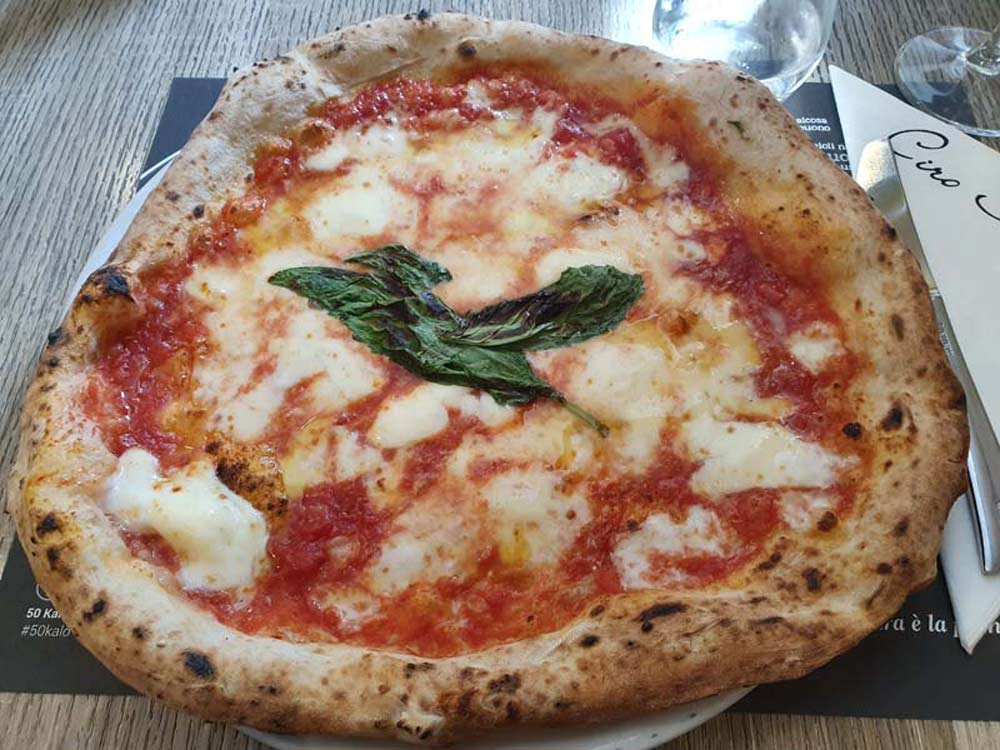
There’s no way we’d give you a list of the best things to do in Napoli without including some must-visit pizzerias. Napoli is the birthplace of the first pizza , the Margherita. If there’s one thing to learn from Neapolitans, it’s to appreciate the simplistic beauty of a freshly made Margherita pizza.
A Mexicana pizza—what’s that? Hawaiian pizza? Too many toppings. Nothing can beat the homemade dough topped with stretchy mozzarella cheese, fresh basil, San Marzano tomatoes, and extra-virgin olive oil. You can find just that and more at Sorbillo, Gorizia, Carminiello, and Starita, to name a few.
Naples claims to have the best pizza in Italy , so indulge in this delicious classic staple and see if you agree. You really must spend some time eating your way through Naples to fully discover the city and all its charms.
Note: These pizzerias fill up quickly, and you’ll often have to wait an hour just to get in, so reserve your table if you can.
» Enjoy this Naples Street Food Tour With Local Expert.
3. Walk Around Mount Vesuvius

After learning much about Mount Vesuvius at the Archaeology Museum, why not see it close-up? This stratovolcano is accepting visitors to walk or hike around its moonlike landscape. Not everyone can say that they’ve climbed an active volcano—don’t worry, Vesuvius only releases sulfur-rich steam.
Apart from the bragging rights, you also get a stellar view of Naples from the top of the mountain. Note that you can only visit the crater with pre-booked tickets. So book well in advance if you include this in your daily activities.
Tip: Here’s an exciting guided tour from Naples to the top of Mount Vesuvius.
4. Roam the Naples Underground

Maybe not as scary and famous as the Paris Catacombs, the Naples Underground is impressive and a must-visit for its own reasons. Some of them are the extensive caves, passages, and catacombs hiding history and insights that one simply must see.
When you enter this underworld, you’ll walk through dimly lit passages and tunnels, exploring caves and underground temples. Sound spooky? Luckily, you can join this guided tour that takes you to discover the well-known areas of this vast underground network.
Tip: It’s essential that you book your tour in advance. Otherwise, you’ll miss out on this gloomy excursion.
5. Take a Stroll Through Quartieri Spagnoli

Quartieri Spagnoli has a unique charm that’s hard to resist and is one of the best things you can do in Naples to truly embrace the local culture. If you listen to tour guides, you’ll never see this place in person, as they warn of the dangers rampaging through this neighborhood.
Quartieri Spagnoli once had a violent inception, but it has since shed this bad reputation and is now known as one of the nicest neighborhoods in the city. Vibrant, cozy, and home to one of the largest shopping streets in Napoli, you can see why people find it alluring.
Walking through its lively streets, you’ll notice clothing lines hanging from one building to the next. And if that’s not endearing enough, the friendly atmosphere emanating from buzzing bars and pizzerias will convince you.
» Try this Off the Beaten Track in Naples: Private City Tour .
6. Take in the Napoli Coast Scenery

Look no further than this Italian coastal jewel for a refreshing moment filled with gorgeous scenery. The Lungomare Caracciolo promenade is a visually pleasing stretch of coastline that sits in a perfect spot to showcase the beautiful bay and Mount Vesuvius.
You’re treated to breathtaking views over the city from Castel dell’Ovo (more on this later), which calls this promenade home. While taking a quiet stroll, you’ll have much to see and even have an opportunity to mingle with locals. If you’re seeking a cultural exchange, you can continue to an area called “Riviera di Chiaia,” where booming nightlife is present.
7. Sightseeing in Old Town

The old center of Naples is a historical district split by a long, narrow street, Spaccanapoli. Here’s where you’ll find the beating heart of the city and a place where tourists flock. You’ll see famous sights along this lively street, such as the Gesù Nuovo and San Domenico Maggiore churches.
To take in as much of the Neapolitan life as possible, you can veer off on the narrow side streets, which offer even more scenery. One in particular, Via San Gregorio Armeno, is famous for its miniature figurines. Much of Old Town is riddled with tourists, so perhaps choose a different activity if you’re not big on crowds.
8. Explore Fontanelle Cemetery

If wandering through the dingy Napoli Underground wasn’t scary enough for you, this place will surely give you the heebie-jeebies. Fontanelle Cemetery is an underground burial site featuring a spooky display of bones and skulls.
This ancient burial is home to a specific ritual of the “souls” resulting in its haunting appearance. While this cemetery contains only a handful of what’s in the Paris Catacombs, the story behind its existence is what makes it special. You’ll have to hear these stories when you visit, though.
9. Watch an Opera Performance at Teatro di San Carlo

Opera originated in Italy in the 17th century, so it is no surprise that an opera theater has made it onto this list. Visiting one also shows a keen interest in Italian culture, as opera is a massive part of it. Not only that, this country boasts some of the best theaters in the world.
And at Teatro di San Carlo , you get a chance to splendor the angelic sounds of an opera performance while in Naples. To impress you even more, this beautiful theater is the oldest in Europe .
10. View Art at Capodimonte Museum
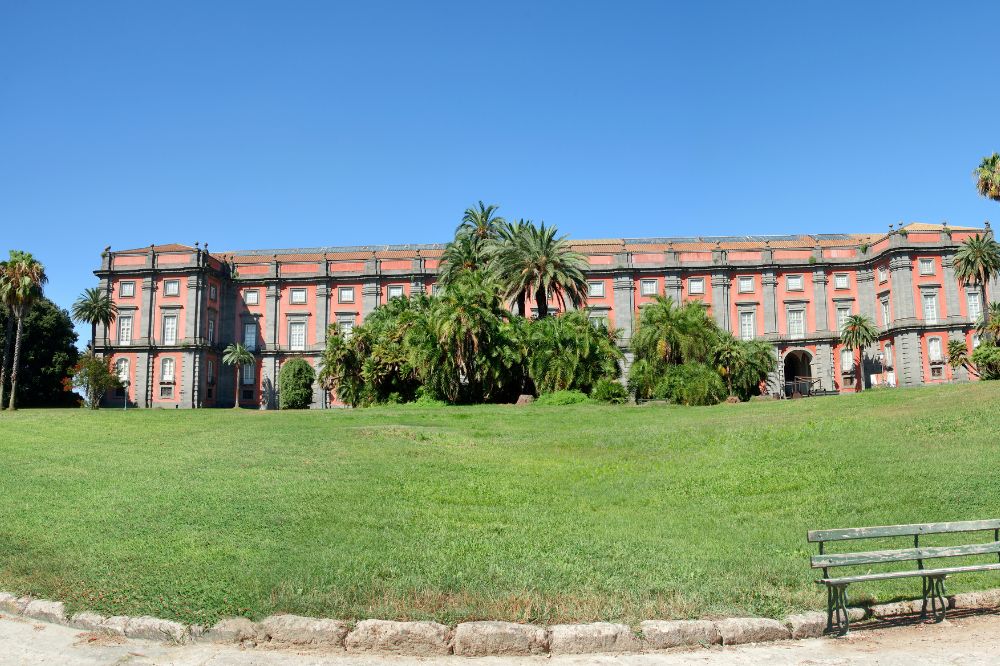
Sitting on the grounds of the Real Bosco di Capodimonte public park is the Capodimonte Museum, and your next destination if you’re an art connoisseur. This is a go-to spot if you’re keen on admiring the works of Italian masters such as Michelangelo, Raphael, and Titian.
The museum is home to stunning exhibitions, exotic trees, statues, and fountains. Some rooms appear to be straight out of a postcard from another century. It is truly a place where Italian art and history intertwine, and you get to witness it.
» Purchase your skip the line tickets here.
11. Take the Toledo Metro Station Express
It’s not what you think—you’re not actually taking a train in Naples. But you are going to visit the most beautiful metro stations in Europe . This is one of those times when it’s actually about the destination, not the journey.
Naples has sought to make its metro stations memorable and a treat for the eyes. And wearing the first-place banner for the prettiest station is the Toledo Metro. Its theme is water and light, represented by silver and blue mosaics covering the walls and ceiling.
12. Shop for Trinkets at Galleria Umberto I

Browse through fashion boutiques, restaurants, and cafes at one of Italy’s most stunning shopping arcades. This 19th-century arcade has a massive glass ceiling, allowing ample light into the space, unlike most shopping centers that feel confined.
Even if you don’t plan to splurge on a shopping spree, it can be an ideal base to stock up on coffee and eateries before touring through the city.
13. Take a Day Trip to the Amalfi Coast

If you want to exchange a bustling city for a serene and quiet coastline, you can do so with a day trip to the Amalfi Coast . This is one of the most beautiful coasts in all of Europe. Its lush hills are decorated with colorful and charming villages overlooking the Tyrrhenian Sea.
Post-card and Instagram-worthy, you can’t go wrong with visiting the Amalfi Coast. You can see small islands such as Capri and Ischia by ferry, where you can find many relaxing activities. How about a rejuvenating mud bath on the tiny volcanic island of Ischia?
14. Snap Some Pictures at Castel Sant’Elmo

Sitting atop Vomero Hill is the majestic Castel Sant’Elmo. This castle is the star of Napoli sites, with the best views. No, literally, it has a large moat in the shape of a hexagonal star. You really want to come here for the views.
You can see the heart of Naples, the azure water of the Sorrento peninsula, and Mount Vesuvius standing proudly in the distance. Don’t discount the castle, though, as its walls hold centuries-old history and it’s neatly located in the stylish district of Vomero.
15. Appreciate Sculptures at Cappella Sansevero
At this chapel in the heart of Naples, you can expect to be in awe of 18th-century statues.. The Cappella Sansevero houses beautiful marble structures crafted by renowned artists Corradini and San Martino.
It’s genuinely one of the highlights of the historic center and features paintings and 28 masterpieces. It’s your chance to see the works of highly-skilled sculptors and to get more insights into Italy’s religious past.
16. Plebiscite Square and the Royal Palace

Plebiscite Square, centrally located in Naples, is a beautiful public square that was once the site of a major event in Italy’s unification process. On October 2, 1860, King Francis II of the Kingdom of the Two Sicilies abdicated his throne after hundreds of thousands of Neapolitans gathered in the square to celebrate the birth of a new nation.
Visiting the square is like taking a step back in time, as it is filled with historic monuments and sculptures that pay homage to this pivotal moment in Italy’s history. The beautiful Royal Palace surrounds the square.
Must-See Attractions in Naples, Italy
Take in some of the top sights of Naples with these must-see attractions:
17. See the Ruins of Pompeii

You cannot leave Naples without seeing its most famous historic attraction: Pompeii city . Sitting at the foot of Mount Vesuvius, this archaeological site is a feast for retrospective eyes. Visitors can see and freely explore the excavated ruins of what was once a thriving, sophisticated Roman city.
Pompeii is huge, and the uneven cobblestone street presents quite an uncomfortable walk if you’re not wearing the right shoes. Also, keep your camera charged and ready, as the wonderfully preserved artifacts, structures, mesmerizing mosaics, and artwork certainly deserve a spot in your phone’s gallery.
» Try this Pompeii Small Group tour with an Archaeologist .
18. See the Excavation Efforts at Herculaneum

On the other side of Mount Vesuvius is the lesser-known city of Herculaneum. While in the shadows of the famous Pompeii, this historic site has its own story to tell. Herculaneum saw itself drenched in 20-meter-thick lava, unlike Pompeii, which was covered in a thick layer of ash.
This meant that Herculaneum’s houses and structures were much better preserved. The city is pretty intact, with many paintings and pieces of furniture still in place as if frozen in time. Much of the city is still underground, allowing you a peak at the excavation efforts still practiced by archeologists today.
After visiting here you will see why we named Herculaneum one of Italy’s must-see landmarks to visit.
» Take this Herculaneum small group tour with an archaeologist .
19. Admire the Lavish Baroque Style of Gesù Nuovo
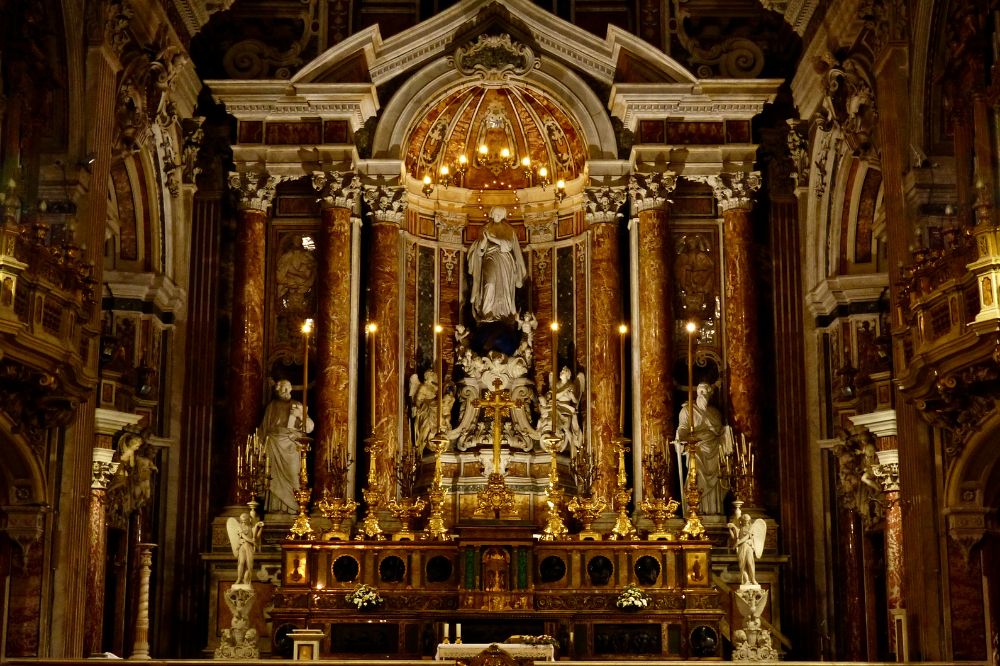
It’s time to whip out your camera; you don’t want to miss capturing this stunner of a church. The Gesù Nuovo church in Naples is widely known for its beautiful interior. And that’s saying it lightly—think grand marble doors, mesmerizing frescoes, and a charming garden.
No words can justify its beauty, so seeing it in person is an absolute must. Not just a beauty, this church (also known as “New Jesus”) has an enchanting story behind it, from its origins as a Neapolitan Renaissance and Baroque symbol to its rebuilding by the Jesuits in the 16th century.
That’s not all; an aerial bomb from World War Two struck the church without detonating, causing immense damage. That same bomb still sits in the church today.
Tip: This city sightseeing tour includes a stop at Gesù Nuovo Church.
20. View Naples City From Castel dell’Ovo

Loosely translated to “Egg Palace,” Castel dell’Ovo is one of those places with an intriguing backstory that compels you to visit.
Legend says that the Roman poet Virgil placed an egg in the castle’s foundation, declaring that if the egg broke, so would the castle and the whole of Naples City. Here’s to hoping that the egg never breaks (fingers crossed).
The striking Castel dell’Ovo is one of the oldest buildings in Naples, making it a staple destination for your trip. While here, you can relish captivating sea views and find a restaurant at the foot when hunger sets in.
21. Let the Santa Chiara Monastery Enchant You
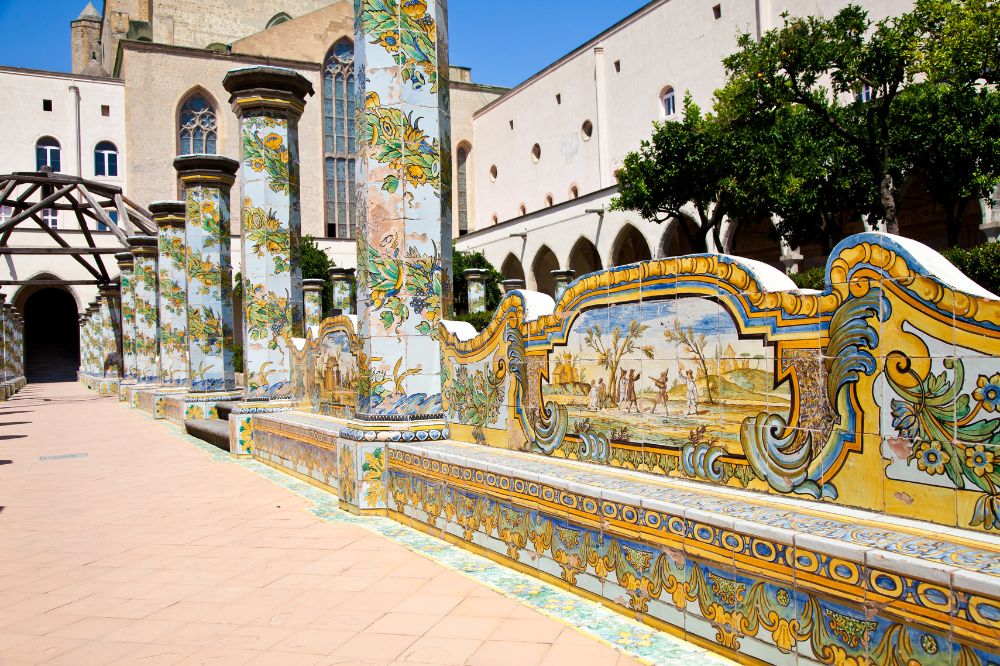
Need new inspiration for your photography? See the Monastery of Santa Chiara. Not only will this site draw in photographers, but anyone who loves Renaissance architecture would appreciate it.
This church is somewhat of an anomaly with its Gothic-style structure and delicate, romantic decoration. The church’s pillars and walls have beautiful floral patterns spread all over them. And you’ll see mesmerizing depictions of scenes from the Old Testament painted on the walls and ceiling in one section.
As a religious complex, you’ll find tombs and an archeological museum harboring treasures from Roman times here.
Naples, Italy: Things to Do Wrapped Up
There you have the top tourist attractions in Naples. This city is full of surprises, and there’s something spectacular to see around every corner. Which activities and attractions are you looking forward to the most? Let us know below.
One more thing: when you’re ready to see more of Italy , this post can guide you there.
YOU MIGHT ALSO LIKE

Guide to the Best Wine Regions in Italy
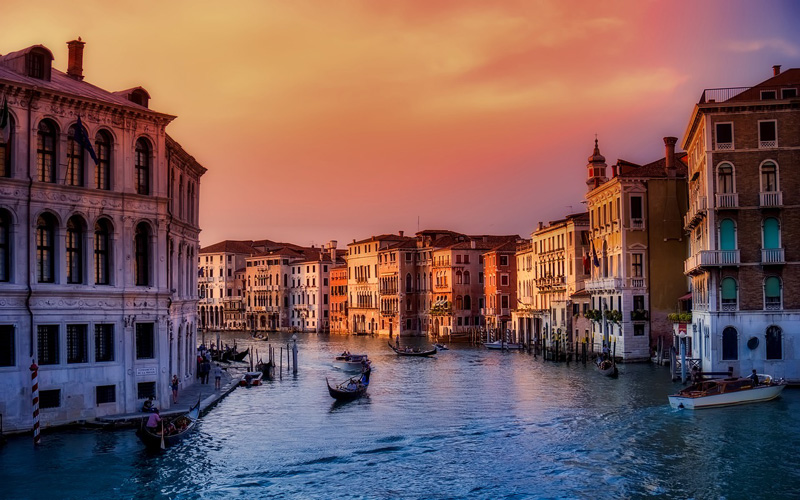
12 Best Cities in Italy: Popular Attractions and Must-See Sights

47 Famous Foods in Italy You Must Try

12 Beautiful Medieval Towns In Italy To Visit
Like this post? Why not save it to Pinterest? FOLLOW US on Pinterest , Instagram , Facebook for more great travel inspiration and tips.
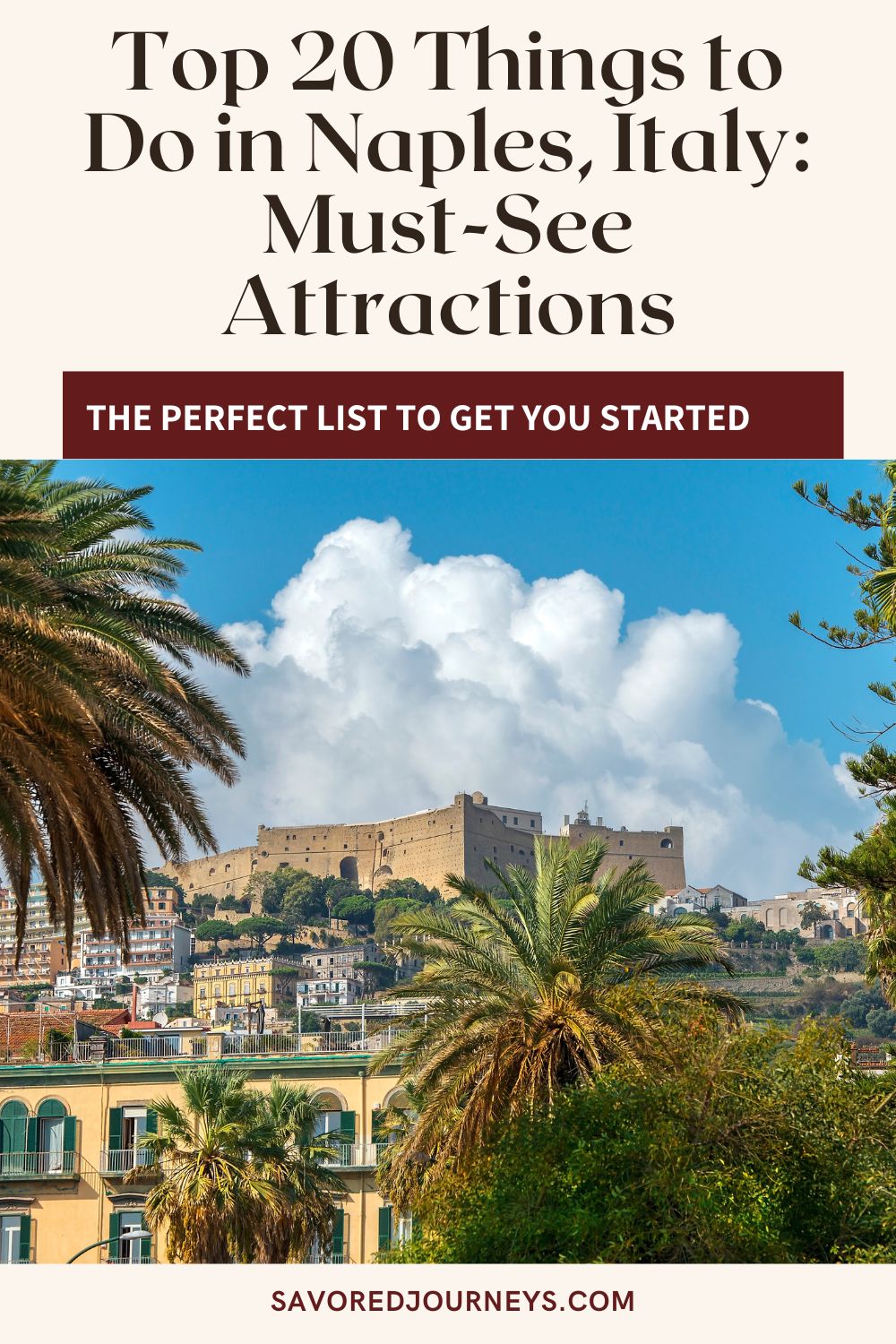
Laura Lynch, creator and writer of Savored Journeys, is an avid world traveler, certified wine expert, and international food specialist. She has written about travel and food for over 20 years and has visited over 75 countries. Her work has been published in numerous guidebooks, websites, and magazines.
Leave a Reply Cancel reply
Your email address will not be published. Required fields are marked *
Save my name, email, and website in this browser for the next time I comment.
- Travel Resources

29 Best Things To Do in Napoli (Naples, Italy 2024) By A Frequent Visitor
How to describe Napoli? Perhaps controlled chaos is a start.
I have been to Napoli numerous times, and I have to say that this last visit was different. Napoli has cleaned up its act which has greatly impressed me. Yes, there is still plenty of graffiti on the walls and some trash around the town, but it feels safer and happier.
This is a city of great contrast – religious devotion yet at times violent. During our visit, we had only positive experiences and enjoyed wandering through the Centro Storico (Historic Center) and the Quartieri Spagnoli (Spanish Quarter).
Napoli is vibrant and captivating, with a rich history, stunning architecture, and delicious cuisine. It is on the Bay of Naples with great views of Mount Vesuvius in the background. The city has a lot to offer, and we want to share our recommendations with you.
Below are plenty of Napoli things to do , so prepare to walk and let’s explore together.
Disclosure: Some of the links below are affiliate links. If you make a purchase using one of the links, we may earn a commission, at no additional cost to you. Please see our Disclaimer for additional information .
Best Things To Do in Napoli
Many of the attractions and things to do and see are in the Centro Storico and the Quartieri Spagnoli. Both areas are walkable, which is really the only option since most of the streets and alleys are very narrow and pedestrian-only.
1. Chiesa del Gesù Nuovo
This church has a unique façade made from lava stone. Some of the diamond-shaped stones have engraved markings. There are lots of theories about the markings. The most recent is that the markings are Aramaic characters, notes of a musical score engraved on the façade of the church.

Gesù Nuovo (New Jesus) is a prominent example of Neapolitan Baroque architecture. The grand interiors, bronze bas-reliefs, wooden crucifix, frescoes, and chapels are something to behold.

During World War II, the church was damaged in the airstrikes. One of the bombs that came across the ceiling did not explode. This bomb is on display inside the church.
➡️ Google Map / Hours: Open 7am to 1pm and 4pm to 8pm Sunday to Saturday / Free to the Public
2. Chiostri di Santa Chiara in Centro Historico Napoli
The Santa Chiara Church and Cloister is worth spending the time to explore. Built in 1310, the church is gothic. It has a simple façade with a rose stained-glass window.

The interior of the church has ornate altars, sculptures, and ceilings with frescoes depicting stories from the Bible.
Stop to see the nativity scene depicting life from the 18 th and 19 th centuries.

The true jewel of the complex is the Cloister of Santa Chiara. The Cloister is a blend of Italian Renaissance and Spanish influence, featuring arches, gardens, and majolica tiles. It is stunning and a pleasant respite from the busy streets of Naples.

The Cloister is open Monday to Saturday from 9:30am to 5:30pm and Sunday 10:00am to 2:30pm. The cost is €6. An audio guide is available by scanning a QR code while at the complex.
The Church is open Monday to Saturday from 8:00am to 12:45pm then 2:30pm to 8:00pm. On Sunday, the hours are 9:00am to 12:45pm then 4:30pm to 8:00pm. The Church is free to the public.
➡️ Google Map
3. Piazza Bellini in Napoli
The piazza is located on top of the ancient Greek settlement of Neapolis. Here you can see the remnants of the Greek city walls and structures in and around the square.

The Greek walls were built using tuff which is a local volcanic stone. It has a light, yellow color and porous nature compared to the black tuff stone used to construct the Napoli historic center.
This piazza is very popular with students in the evening since the university is nearby.
4. Basilica di Santa Maria Maggiore alla Pietrasanta e Lapis Museo
The Basilica of Santa Maria Maggiore is a blend of Gothic, Renaissance, and Baroque architectural styles. Built in the 11th century, the Basilica is on top of a Roman temple.
With side chapels and a central dome, the Basilica is Greek in design. Beautiful majolica flooring was added in the 18th century. Adjacent to the basilica rises the elegant bell tower.

Amazingly underneath the basilica lies an ancient aqueduct, now known as the LAPIS Museum (Museo dell’Acqua – water museum). Opened in 2021, this hidden treasure reveals the ingenuity of the Roman civilization that thrived in this area.

The aqueduct served as a vital water supply system, transporting water from distant sources to the city. Walking through the dimly light tunnels transports you back in time. Guided tours of the aqueduct are available daily through the museum.
➡️ Google Map / Lapis Museum Open Monday to Sunday 10:00 to 20:00 / Advance Ticket Purchase
5. Busto di Pulcinella in Centro Storico Napoli
The bronze bust of Pulcinella is an interesting sculpture that pays homage to the iconic and beloved character. This bust captures the essence of Pulcinella’s playful personality and theatrical charm.

With its expressive features and intricate details, the sculpture brings to life the mischievous spirit and distinctive appearance of this legendary figure. Make sure you rub his nose for good fortune!
6. Napoli Sotterranea
The Underground Naples lies beneath the old town. The vast network of tunnels, passageways, and chambers unveil layers of history spanning centuries.

Exploring Napoli Sotterranea is like stepping into a hidden world, where Greek and Roman aqueducts, catacombs, and even World War II air-raid shelters coexist. The tunnels wind through tuff stone, revealing archaeological remains and providing insights into the city’s past.
Guided tours will take you on a journey through the underground, shedding light on the daily life, customs, and challenges faced by the people of Naples through history.
➡️ Google Map / Book a Tour and Skip the Line
7. Complesso Monumentale San Lorenzo Maggiore e La Neapolis Sotterrata
This monumental complex consists of a basilica and an archaeological area that preserves the remains of ancient Greek and Roman structures. The Basilica San Lorenzo Maggiore, dating back to the 13 th century, showcases a blend of Gothic and Renaissance styles, with its majestic façade and intricate interior with beautiful frescoes and sculptures.

La Neapolis Sotterrata (Naples Underground) is below the Basilica. Taking a step back in time, you will walk along the preserved streets of the ancient Greek-Roman city of Neapolis. The ruins reveal insights into daily life during different eras, with highlights including a Roman market and thermal baths.
8. Madonna con la Pistola
The Madonna with Gun is the work of British street artist, Banksy. It is believed that this is the only surviving Banksy left in Italy. The street art has a protective covering, and the restaurant next door is responsible for its safekeeping.

This is a captivating visual of the Madonna with a gun above her head instead of a halo. It depicts a thought-provoking scene that shows the societal contrast between religion and gun violence.
9. Duomo di Napoli
This Naples Cathedral has several names including the Cattedrale di San Gennaro. Naples has over 500 churches within the city. The Duomo is the dominate church in Naples. San Gennaro is the patron saint.

Its construction dates to the 13 th century, with additions and renovations added over the centuries resulting in a unique blend of architectural style. The exterior façade is a mix of Gothic, Renaissance, and Baroque elements. The interior has intricate marble work, stunning frescoes, and ornate chapels.

The highlight of the cathedral is the Chapel of the Treasure of San Gennaro, which houses the relics of Naples’ patron saint.
10. Murale di San Gennaro in Napoli
The 50-foot Mural of San Gennaro painted on a building in the Forcella district in Napoli, is a noteworthy piece of artwork paying homage to the patron saint of Naples. In 2015, street artist Jorit Agoch painted the mural.

In this mural, San Gennaro looks like a 30-year-old Neapolitan factory worker. The theory is that the artist was sending a message to the citizens of Naples. The people should not wait for a miracle to happen but, instead, take the lead and be proactive in defending and protecting the city of Naples.
11. Spaccanapoli
Spaccanapoli is a famous area in Naples. The name translates to Naples’s splitter. It is a long, narrow street that cuts through the heart of the historic center.

Walking along Spaccanapoli, you can experience the authentic atmosphere of Napoli. There are shops, local markets, pizzerias, churches and important buildings along the way. It passes more important landmarks such as the Church of Santa Chiara, San Domenico Maggiore, and the Duomo di Napoli.
12. Via San Gregorio Armeno
A walk along Via San Gregorio Armeno reminds me of Christmas. In Naples, it is known as “Christmas Alley” or the “Street of the Nativity Scene”.

Located in the heart of the historical center off of the Spaccanapoli, this charming street marks the place of creativity and craftsmanship. As you walk along Via San Gregorio Armeno, you will find numerous shops and workshops dedicated to the creation of intricate nativity scenes, known as “Presepe” in Italian.
Via Gregorio Armeno is perfect for gift shopping!
13. Museo Doma Chiesa di San Domenico Maggiore
Here is another Gothic-style church and monastery built in the 13th century. It is now known as the Doma Museum. The exterior looks pieced together and faces a piazza with cafes and seating.

But the interior is ornate and adorned with frescoes painted by Pietro Cavallini, Francesco Solimena, and others. The sarcophagi of 46 Aragon princes and other people of importance are well worth seeing.
Tickets are available for purchase online through the museum which includes a guided tour and a visit to the Cell of St. Thomas Aquinas, the Sacristy, Treasure Room, and the Crypt of the Carafa di Roccella.
➡️ Google Map / Book A Tour to See the Doma Museum
14. Museo Cappella Sansevero
The Sansevero Chapel Museum combines art, history, and mystery. Originally it was a private chapel, then transformed into a museum in the 19 th century to showcase the remarkable artworks and sculptures.
The main highlight of the museum is undoubtedly the stunning masterpiece, “The Veiled Christ” by Giuseppe Sanmartino. This astonishing sculpture depicts the body of Christ covered in a transparent marble veil, a true marvel that seems to defy the law of physics.

The veil looks so real, and you get a sense of movement while admiring this sculpture. But the museum also features other works of art, including the anatomical models known as anatomical machines, created by the alchemist and artist Raimondo di Sangro, Prince of Sansevero.
This is a very popular attraction, and it is necessary to buy a ticket in advance. Also, photography is not allowed in the museum.
➡️ Google Map / Book A Tour and Skip the Line
15. Museo Archeologico Nazionale
The National Archaeological Museum in Naples is truly a treasure trove of ancient artifacts. The museum has an extensive collection that spans over 2,500 years of history, showcasing works from ancient Rome, Greece, and Egypt.

There is a significant collection from Pompeii and Herculaneum. Some of the pieces include mosaics, frescoes, and pottery.

One of the highlights of the museum is the Farnese Collection, which includes the Farnese Hercules and the Farnese Bull. Two iconic marble sculptures that are bigger than life.

Another special section is The Secret Cabinet. This is dedicated to the erotic and explicit Roman artworks found during the excavations at Pompeii and Herculaneum. It is controversial and it took a very long time to finally open to the public in 2000. Children under 14 must be accompanied by an adult to view this exhibit.

Tickets to tour the exhibits are available directly through the museum.
16. Castel Nuovo in Napoli
Castel Nuovo, also known as Maschio Angioino, is a medieval fortress built in the 13 th century by the Angevin dynasty. With stone walls and 5 towers, the castle was a symbol of power and resilience for centuries.

As you approach the castle, you will see the grand Renaissance arch with sculptures and the bronze equestrian statue of Charles I of Anjou. Inside is a blend of medieval and Renaissance architecture with halls, chapels, and courtyards.
Today, Castel Nuovo houses the Museo Civico, a civic museum displaying paintings, sculptures, and decorative art from different periods. From the rooftop, there is a beautiful view of the city and the Bay of Naples.
The Fortress is open Monday through Saturday from 8:30am to 6:30pm. Tickets can be purchased online.
17. Teatro di San Carlo
The San Carlo Theater is a world-renowned opera house. Established in 1737, it holds the distinction of being the oldest continuously active opera house in Europe. The opulent foyer transports you to a world of elegance and grandeur.

The theater’s lavish interior has magnificent chandeliers, plush velvet seats. and intricate gilded decorations throughout.
A 30-minute guided tour is available Monday through Sunday. Schedule the tour directly with the theater.
➡️ Google Map / Book A Tour
18. Galleria Umberto I in Napoli
The Galleria Umberto I is a stunning architectural masterpiece constructed in the late 19 th century. This shopping gallery combines neoclassical and Art Nouveau elements, creating an atmosphere of grandeur and elegance.

When you enter the Galleria, you will see the soaring glass dome that bathes the space in natural light. Thus, illuminating the ornate mosaics, ironwork, and marble floors below.
The Galleria is a good place to take a break and explore the shops, boutiques, cafes, and restaurants.
➡️ Google Map
19. Chiesa di San Ferdinando
The Church of San Ferdinando began construction in the late 17 th century. It is located on the Piazza Trieste e Trento near the Piazza del Plebiscito, in the Quartieri Spagnoli (Spanish Quarter).

The church is dedicated to King Ferdinand IV of Napoli. It is known as the Artists Church since funerals of famous artists and actors are celebrated here.

For art lovers, Baroque frescoes by Paolo de Matteis from the late 17 th century are inside the church. A Presepe (nativity) is on display throughout the year depicting a village scene from the 19 th century.
20. Gran Caffé Gambrinus
Gran Caffé Gambrinus is located near the Piazza del Plebiscito and is a perfect spot to take a break from touring. It is an iconic and historic café that has been a cultural institution in Napoli for over 150 years. Stepping into the café is like stepping back in time to the Belle Epoque era, with its ornate décor, high ceilings, chandeliers, and beautiful furnishings.

The legendary café has welcomed intellectuals, artists, and prominent figures throughout history. This is a place to stop for a Neapolitan coffee and a delectable pastry. Making a decision is quite difficult here – all of the pastries look amazing!

21. Piazza del Plebiscito
Piazza del Plebiscito is a grand and majestic square that serves as a focal point of the city’s social and cultural life. Named after the plebiscite (vote by the entire population) held in 1860, marking the annexation of Naples to the Kingdom of Italy, the square has a historical significance.

The centerpiece of the square is the San Francesco di Paolo Church. On the other side of the square stands the Royal Palace of Naples.

In the center of the square, there are two equestrian statues. The first statue depicts Charles III of Bourbon, who was the King of Naples and Sicily from 1743 to 1759. The second statue represents Ferdinand I of Bourbon, Charles III’s son and successor, who was the King of the Two Sicilies from 1759 to 1825.

Piazza del Plebiscito is often full of activity, from cultural events and concerts to political gatherings and public celebrations.
22. Chiesa di San Francesco di Paola
The Church of San Francesco of Paola is on the Piazza del Plebiscito. Construction was completed in 1846. It has a neoclassical design inspired by the Pantheon in Rome. The exterior of the church features a colonnade with majestic Corinthian columns, like St. Peter’s Basilica in Rome, that create a sense of elegance and grandeur.

The interior is equally impressive, with two side domes. The main dome is 174 feet high (53 meters). During our last visit, there was a wedding at the main altar.

The Church is free to the public.
23. Palazzo Reale di Napoli
The Royal Palace of Naples is on the Piazza del Plebiscito across from the Chiesa di San Francesco di Paola. It was built in the 17 th century and served as one of the four royal residences for the House of Bourbon.

On the western exterior façade of the palace, statues of the prominent rulers are displayed in order of reign starting with Roger the Norman and ending with Vittorio Emanuele II.
Tours of the palace are available and can be booked online. Some of the notable rooms to visit are the Royal Apartments, the Throne Room, the Court Theater, the Royal Chapel, and the Gallery of Paintings.
24. Lungomare di Napoli
The Lungomare in Naples is a waterfront promenade that stretches along the city’s coastline. The promenade is 3km long starting south of the Piazza del Plebiscito, in the Santa Lucia district, and ending in Mergellina.

As you walk along the Lungomare, you will see the Bay of Naples with Mount Vesuvius in the background. There are cafes, gelaterias, and restaurants as well as some statues and the Castel Dell’Ovo along the way.

This is a great place to take a leisurely stroll and enjoy the beautiful views.
25. Castel Dell’Ovo
The Castel Dell”Ovo (Egg Castle) is along the Lungomare on the former island of Megaride (now a peninsula) in the Bay of Naples. Its name, “Egg Castle”, comes from a legend that an egg is hidden within its foundations, serving as a protective charm.

This is the oldest castle in Naples, built in 1128. It has been a fortress, a monastery, a prison, and a royal residence. Entry to the castle is free but guided tours are available for a fee.
At the base of the castle, is a small port named Borgo Marinari. This area has a marina and restaurants specializing in fresh fish and seafood.

Special Note – as of winter 2024, the castle is temporarily closed due to renovation work.
26. Murales di Diego Armando Maradona
The Maradona mural is a tribute to Diego Maradona, considered in Naples to be one of the greatest football (soccer in U.S.A.) players of all time. The mural is in the Quartieri Spagnoli, painted on the side of a building by Italian street artist, Jorit Agoch.

Maradona played for Napoli in the 1980s and he led them to unprecedented success. The mural depicts Maradona in his Napoli jersey, displaying his famous number 10.
Below the mural, there are stalls selling football souvenirs and pictures. This area is packed with people so be on the lookout for pickpockets.
27. Ercolano Scavi (Herculaneum)
Herculaneum is in Ercolano, about 25 minutes from the city of Naples. This remarkably preserved archaeological site offers a glimpse into the daily life of its inhabitants before the devastating eruption of Mount Vesuvius in 79 AD.
Unlike the destruction of Pompeii, Herculaneum was engulfed by a pyroclastic flow – a fast- moving mixture of hot gas, ash, and volcanic debris. The flow overwhelmed the city, killing the inhabitants yet preserving the structures and their contents.

I was surprised at how well-preserved the structures, artifacts, and artwork are from the ancient Roman times at Herculaneum. Some of the highlights include preserved houses with frescoes and mosaics, as well as the Villa dei Papyri, believed to be the home of Julius Caesar’s father-in-law.
What else is amazing, are the Boat Sheds. Herculaneum was on the Bay of Naples, but the bay has receded over time. It is very eerie looking at the sheds knowing that inside are the remains of the inhabitants trying to flee the explosion via boat.

Herculaneum is smaller than Pompeii, thus less crowded. It is easy to spend at least a half day there. I would recommend having a guide when visiting Herculaneum.
If choosing to visit this site on your own, it can be reached via the Circumvesuviana train departing from the Napoli Piazza Garibaldi Station to the Ercolano Scavi stop. The ride is about 25 minutes. From the Ercolano Station, it is a 10-minute walk downhill to the Herculaneum ticket office.
Tickets can be purchased at the office or online. The site is open 7 days a week from 8:30am to 7:30pm during the summer, closing at 5:30pm during the fall through the spring.
➡️ Google Map / Book A Tour with a Guide at Herculaneum
28. Parco Archeologico di Pompeii
The Pompeii Archaeological Park is a UNESCO World Heritage Site. It is 15 miles southeast of the city of Naples and 5 miles from Mount Vesuvius. This is one of the most visited archaeological sites in Italy.
Like its neighbor, Herculaneum, Pompeii was devastated by the eruption of Mount Vesuvius in 79 AD. The flow of rocks, ash, and pumice buried Pompeii and its inhabitants. As it solidified over time, a protective layer was created, preserving the Roman city below it.

There is a lot to see at Pompeii including well-preserved homes, the Forum, the Amphitheater, Temples, the Theaters, and the Street of Tombs. You should plan for a full day to see this site.

If staying in Naples, the easiest way to reach Pompeii is via the Circumvesuviana train. It departs from the Napoli Piazza Garibaldi train station to the Pompei Villa dei Misteri station. The entrance to the site is directly in front of the station. The trip takes about 45 minutes.
The archaeological site is open 7 days a week from 9:00am to 7:00pm during the summer, and 5:00pm from fall to spring. During the high season (summer), I would recommend purchasing a ticket and timeslot online. The best way to truly appreciate the visit is to have a guided tour.
➡️ Google Map / Book a Tour with a Guide at Pompeii
29. Mount Vesuvius
Mount Vesuvius is the only active volcano in mainland Europe. It is located within the Vesuvius National Park (Parco Nazionale del Vesuvio).
The Park provides opportunities to explore the volcanic landscape, enjoy the hiking trails, and learn about the region’s history and biodiversity. It is home to a variety of plant and animal species that have adapted to the volcanic environment.

The park offers visitor facilities, including information centers, walking paths, and guided tours to the crater. If visiting the crater on your own (without a tour group), a ticket must be purchased online prior to the visit. The entrance fee is €10.
The park is open daily unless there is bad weather or volcanic activity. Plan for at least a half day to visit the park.
➡️ Google Map / Book A Tour to Visit Mt. Vesuvius
Top Tours in Napoli
✅ walking tours of the historic center.
The best way to explore Naples is on foot. You will discover the hidden treasures that lie within its narrow, winding streets. A knowledgeable guide will provide insights and stories about the history and culture not found in tour books.
✅ Tours of Pompeii, Herculaneum, and Mount Vesuvius
Leave the transportation to these sites outside of the main city of Naples to a private tour group. There are a variety of half-day or full-day tours available to visit these attractions.
✅ FREE Walking Tours of Napoli
This is a great way to get to know the city with a local guide who lives there. I always take the tour to get a better understanding of the area and then return to the sites that I want to spend more time seeing. Even though the walking tour is free, tipping the guide is highly recommended.
Where to Stay in Naples, Italy
Most of the major sites to visit are in the old town (Centro Storico) and the Spanish Quarter (Quartieri Spagnoli). The following hotels are in areas that are easily accessible to the main part of Naples.
📍 Best Budget Spot – Hotel Meublé Santa Chiara Suite
Located in the heart of the Centro Storico, Hotel Meuble is walking distance to all the major sites. The rooms are simple and include a complimentary Italian breakfast.
📍 Best Mid-Range Spot – Napolit’amo Hotel Medina
This moderate hotel is located inside an office building on the 3 rd floor. The location is ideal – in between the Centro Storico and the Quartieri Spagnoli. It is an easy walk to the Piazza Plebiscito or the Gesù Nuovo Church. The rooms are comfortable and include a complimentary breakfast.
📍 Best Luxury Spot – Palazzo Doria Napoli
This is a luxurious hotel on Via Toledo at the Piazza Sette Settembre. It is within walking distance of the attractions in the Centro Storico. The rooms are big and ornate – you feel like you are staying in a palace. An Italian breakfast is included.
My Trip Planning Resources These are the companies that I use when planning our trips: – Flights: WayAway – Hotel Reservations: Booking.com & Hotels.com – Vacation Rentals: VRBO – Portable Wi-Fi: Ryoko Pro – Rental Cars: DiscoverCars.com – Train Tickets: Rail Europe – Tours: Viator , Get Your Guide and GuruWalk – Travel Insurance: VisitorsCoverage – Airport Lounge Access Program: Priority Pass If you choose to buy through any of the provided links, we may receive a commission without any extra charges to you. Explore our Travel Resources page for additional service suggestions.
FAQ: Napoli Travel Tips
When visiting Naples, it is important to always be aware of your surroundings and use common sense.
Heavily crowded areas can attract pickpockets and thieves. Keep jewelry to a minimum, be discreet when pulling out your money, and keep track of your handbag, backpacks, and wallet.
The following are some answers to frequently asked questions about Napoli.
What is Naples, Italy famous for?
Naples’ claim to fame is pizza. The renowned Margherita Pizza was born here. The pizza was named after Queen Margherita in 1889. The typical Neapolitan pizza is made from San Marzano tomatoes, mozzarella cheese, fresh basil, salt, and olive oil. The crust is soft and pillowy.
How many days is enough in Naples?
This depends on what you want to do. If you like to spend time visiting museums and want to see Pompeii and Herculaneum, then 4 or 5 days would be recommended. If you want to take a walking tour and get an overview of the city, then 2 days would be possible.
What is the best month to visit Napoli?
May is a good month to visit Napoli. The weather is pleasant, and the tourist crowds are less compared to the summer months.
Is Naples, Italy worth visiting?
Absolutely! Naples offers a unique blend of ancient ruins above and below ground, bustling streets like Spaccanapoli, and delicious pizza, pastries, and coffee. Where else can you see an active volcano looming in the background with beautiful views of the Mediterranean Sea.
Final Thoughts: Things To Do In Napoli
As I stated at the beginning, Naples has changed for the better. It is more manageable now even though it is still chaotic. Maybe that is part of the charm and reflects the lifestyle of the Neapolitans.
When visiting the city, it is most important to plan where you want to go and what you want to see. The main sightseeing areas are the Historic Center and the Spanish Quarter. I would recommend doing a walking tour. This will help in learning the layout of the city.
Whether you are an art enthusiast, a history buff, a food lover or simply a traveler seeking to immerse yourself in the authentic Italian way of life, Naples has something to offer everyone. A visit to Naples is a truly unforgettable experience.
If you would like assistance in planning your trip to Naples, Italy, we would be happy to help. Please refer to our Travel Planning services for further information or send us an email .
If you want to explore more in Southern Italy , check out our following posts:
Day Trip to Paestum Italy 2024 – Ancient Greek Temples
Is San Nicola Arcella in Calabria Italy Worth Visiting? (By A Local)
Is Tropea in Calabria Italy Worth Visiting? (By A Frequent Visitor)
Is Maratea Italy Worth Visiting? (By a Local)
10 Beautiful Towns to Visit in Calabria in 2024 (By A Local)
Hello, I’m Janet, the owner and writer behind Practical Travel Concepts. With over 40 years in various corporate leadership roles and owning multiple businesses, I’ve now shifted gears to pursue my passion for travel. My focus is on writing straightforward blog posts about my travels and helping clients plan their trip itineraries. I aim to share practical travel insights and tips to enhance your adventures based on my firsthand experiences exploring the world with my husband and family.

- NORTHERN IRELAND
- CUSTOM ITINERARY SERVICES
12 Travel Tips for Visiting Naples in Italy You Need To Know
Are you thinking of visiting Naples in Italy and wondering what you should know before you do?
This article will be perfect for you!
Naples is one of my favourite cities in Italy. I’ve visited several times and can simply not get enough. But it’s also important to mention that it’s a very chaotic and a bit overwhelming city.
Some people love it, others hate it. I love it but I do think you need to be prepared and know a bit what you’re getting yourself into if you want to make the best of your time.
Disclosure: This post may contain affiliate links, meaning I get a commission if you decide to make a purchase through my links, at no extra cost for you!
🔎 Table of Contents
1. Avoid visiting in July and August

It’s incredibly hot in Italy in July and August and even more so in Naples. Southern Italy is blessed with beautiful weather but the summer months are really tough in the city since the buildings make it feel even hotter.
While it’s not impossible to visit in July or August (I mean, I’ve done it so you can!), it’s just not comfortable. It’s so hot that you have to stop a lot to drink and it makes your legs and feet swell which is not great.
Also, since it’s the summer holidays, Naples is super busy and everything tends to be more expensive.
If you can visit in May, June or September, you’ll get a much better experience.
2. Get used to the chaos

Naples is a chaotic city. It might very well be the most chaotic city in Europe to be honest. That’s something you need to get used to and embrace.
Yes, people don’t respect the rules, cars don’t stop for pedestrians, people drive scooters without helmets… that’s just the way it is and you need to get on with it.
I know this can feel quite weird when you’re not used to it but the more you try to fight the system (or lack of system) the harder you’ll make it for yourself.
Just accept the chaos.
3. Wear a money belt
There are quite a lot of pickpockets in Naples and theft is quite common. For this reason, it’s better to avoid putting your money in your backpack or in a handbag that doesn’t have a zip.
To keep your money and passport safe, I recommend using a money belt . I know it’s not the most stylish piece of clothing but it’s incredibly practical.
4. Use public transport and walk

Public transport in Naples is honestly quite good. There are only 2 metro lines which means it’s easy to navigate. The metro itself is also very clean and there is AC (which is a huge plus if you are visiting in summer).
Ultimately, you can walk to most places in Naples but if you need to cover more distance, public transport is great.
Also, the tickets are pretty cheap.
I also highly recommend using public transport to go to Pompeii, Herculaneum and Sorrento. From Garibaldi station, you can take the circumvesuviana train which is both very practical and cheap.
5. Don’t rent a car in Naples

There are two reasons why you shouldn’t rent a car in Naples. Firstly, driving in Naples is very chaotic which makes it very hard if you’re not from Naples. You need to get used to the madness and it can be very stressful.
Secondly, there is simply no point in having a car in Naples since you can use public transport and everything is very easy to access. Even if you want to go to Pompeii or Sorrento, it’s much easier with the train.
The only reason why you should rent a car in Naples is if you want to go a bit off the beaten track and outside of Naples.
6. Learn some italian

While a lot of people in the old centre speak some English, it’s always quite handy to know some Italian.
In the Spanish Quarters for example, most people don’t speak English. A lot of them don’t even actually speak Italian much since they only speak Napolitan but knowing some Italian will be useful.
I recommend learning the common words such as hello, thank you, please, coffee, water, toilet…
Also, locals love it when you try to make an effort even if it’s in broken italian.
7. Eat street food

Naples is one of the best places in Italy when it comes to food. Some would even say that it’s the best place, full stop.
It’s the birthplace of pizza as well as many Italian specialties. But the thing that Naples does better than any other city in Italy, it’s street food.
From the fried pizza to the frittata di spaghetti, you’ll find loads of things you can buy from local stands (especially in the Spanish Quarters) and eat on the go.
Also, it’s very cheap so there is no reason to not try it!
8. Do a walking tour in the Spanish Quarters

The Spanish Quarters are the most unique district in Naples. They are colourful, authentic, full of good food shops and where you can find the famous Maradona mural.
They used to be the most dangerous place in Naples and are now a lot more visited by tourists.
Walking around the Spanish Quarters is a unique experience that words can’t really describe. There is nothing like it.

Most of the locals here speak Napolitan, a lot of them don’t even speak Italian so that’s to say how authentic it is.
While it’s not unsafe anymore to visit the Spanish Quarters, you should still be careful. The best way to visit this area is with a walking tour. Being with a guide will give you the chance to truly understand this part of Naples and learn plenty about the football culture and food.
9. Withdraw cash
Cash is king in Naples. A lot of places don’t accept cards and even if they do, they definitely prefer cash.
If you buy street food, you will need cash, for coffees as well. For restaurants, some of them do take cards but it’s better to have some cash at all times.
10. Avoid exploring on your own at night

Technically, Naples is not overly unsafe however it can feel a bit overwhelming and even more at night.
I would recommend avoiding going out by yourself too much at night, especially in the Spanish Quarters.
11. Download Google Translate and the Italian language
People working in tourist attractions usually speak English, so do the waiters in the Old Centre but outside of that, most people don’t speak English.
For this reason, I recommend downloading Google Translate and the Italian language (so you can use it offline) beforehand. That way, language will never be too much of a barrier.
12. Don’t buy a Neapolitan horn for yourself

As you walk around Naples, you will notice there are a lot of Neapolitan horns. This is a good luck charm for the Neapolitans and you can find them everywhere as key rings.
They make for the perfect souvenir however, you shouldn’t buy it for yourself. The horn only brings luck when it’s gifted so you can buy it for your friends and family but shouldn’t buy it for yourself. Someone else should buy it for you.
I hope this article has helped you and you have a better idea of what to expect in Naples.
You may also be interested in:
- 6+ Best Pizza Tours in Naples To Go On
- Day trip from Naples to Pompeii: How to visit Pompeii in one day from Naples, Italy
- 12 Best Food Tours in Naples
Founder of Beeloved City, I am originally from France and have been living in the UK since 2016. I've travelled to 25 countries as a backpacker, travel coordinator and for holidays. I spent a year in Australia before eventually settling down in Manchester, England
National Geographic content straight to your inbox—sign up for our popular newsletters here
Where to find the best pizza and street food in Naples
The gateway to the Amalfi Coast is the place for gourmet pizza, reimaginings of classic pastas and a wide range of street food.

According to the Neapolitan proverb ‘ meglio murì sazzio ca campà diùno ’, it’s better to die full than live hungry. Eating and drinking here is a ritual that’s been linking the city’s neighbourhoods for centuries — in the streets in the form of pizza al portafoglio, on the tables of trattorias as a plate of pasta, potatoes and provola cheese and at the counter of bars serving espresso all day long. Neapolitan food is part of the vitality of the city, and one of its defining aspects.
Naples is also the Italian city that’s evolved most in recent decades, notably when it comes to its food and drink. Diners enjoy an endless array of options, including fusion food, fine dining and Neapolitan street food — the latter a smorgasbord spanning such delicacies as the panino napoletano (a soft-bread sandwich filled with cured meats and cheeses), parigina (stuffed pizza) and fried pizza from restaurants such as of La Masardona on Piazza Vittoria.

Neapolitan chefs who flexed their muscles overseas are returning. Among them are Marco Ambrosino, whose Mediterranean restaurant, Sustanza, opened last May, and Gianluca D’Agostino — previously of London’s Locanda Locatelli — with his fun new restaurant and tapas bar, Joca.
Nothing, of course, will usurp pizza as the traditional soul of Naples, but new chefs are doing their best to aid its evolution. At Bro Pizzeria, a family of pizzaioli (pizza makers) has spent five generations perfecting the crispest crust. Standout varieties include cosacca (topped with tomato sauce and pecorino) and seasonal pizzas such as the assoluto di zucca, topped with pumpkin cooked four ways.
Neapolitan cuisine began as a blend of ideas and ingredients, the result of centuries of interchange between people coming and going from this once-powerful port city. It was here that the South American tomato became the most Italian of fruits. Today, Chinese and Japanese cuisines are being grafted with Neapolitan dishes to produce, perhaps surprisingly, perfect fusion food. For example, Mimì Alla Ferrovia, one of Naples’ historic trattorias, serves ragù alla Genovese in a bao bun filled with five-hour-stewed beef, topped with a mustard- and basil-infused caesar sauce.
Yes, this is the gateway to the Amalfi Coast and the archeological site of Pompeii, but Naples is also a city that’s fast transforming into one of the world’s most intriguing gastronomic destinations, a place to be discovered bite by bite while orderly chaos and baroque wonders unfold around you.
How to spend a day in Sanità and the historic centre
On the northern fringes of the city’s historic centre, Sanità — once a run-down district — has experienced a renaissance through food. Over the past 10 years, new restaurants, such as Ciro Oliva’s Pasticceria Poppella pizzeria and Isabella De Cham Pizza Fritta, have started to bring in Neapolitans and tourists, reshaping Sanità’s character, while pizza place Concettina ai Tre Santi began a policy of only employing from the immediate area and funding cookery classes for underprivileged local children.
Breakfast is a must at Pasticceria Poppella , which sells a modern classic of Neapolitan pastries, the fiocco di neve (‘snowflake’), icing sugar-dusted dough balls filled with ricotta.

Explore busy streets and alleys including Via San Gregorio Armeno, where you can buy a cornetto, the Neapolitan chilli-shaped good luck charm which adorns everything from keyrings to jewellery. Walk towards the Duomo di Napoli , which houses the revered relic of San Gennaro. Across the street you’ll find Januarius , a trattoria that recently earned its first Michelin star. It’s noted for its traditional Campania-style cuisine, including zito spezzato alla genovese (pasta in a rich beef and onion ragu) and baccalà con scarola (salt cod with Neapolitan-style chicory). Before you leave, stock up on charcuterie and cheese at the restaurant’s delicatessen.
On Spaccanapoli, the street that cuts the city in two, Cornogelato sells excellent gelato. Or head for an aperitif at Hotel Piazza Bellini’s pretty courtyard bar; nearby La Fesseria Street Bar does a great pummarola (a bloody mary made with tequila and mezcal instead of vodka). On buzzy Piazza San Domenico, Palazzo Petrucci Pizzeria sells small fried pizzas, including a perfect marinara with organic tomato, basil, oregano and garlic.
How to spend a day on the stairs and the subway
Naples is woven with more than 200 staircases and stairways, linking various areas of this hilly city. Fuel up for a day exploring them at Ventimetriquadri , which, as its name suggests, is an intimate, 20-by-four-metre space. Order one of its excellent speciality espresso or pour-over coffees, and linger here in the affluent hilltop district of Vomero where you can gaze across the city, as far as the Bay of Naples and Mount Vesuvius, then explore the medieval fortress Castel Sant’Elmo .
From here, it takes 20 minutes to descend — via the Pedamentina, a system of 414 steps — to Corso Vittorio Emanuele to visit its high-end boutiques and specialist shops, including bakery Antica Forneria Molettier i , whose puff pastry prussiane biscuits are the standout. Ride the funicular back up to Vomero to wander through the parkland surrounding Villa Floridiana , one of Naples’ few remaining neo-classical residences. Then order pasta with lentils at nearby Trattoria Buatta , which also has a great wine list and a cosy setting in an authentic Neapolitan basso (a small, ground-floor apartment).

Take the metro from nearby Piazza Vanvitelli directly to Toledo: one of the world’s most theatrical underground stations, whose psychedelic walls and ceilings mean it resembles a giant, ethereal swimming pool. This is the jumping-off point for Pignasecca , the city’s largest market, whose Neapolitan smells and colours unfold through narrow alleys full of locals shopping for fish, fruit and vegetables (don’t miss the Amalfi Coast lemons). At Friggitoria Fiorenzano , sample fritto misto (fried seafood) and offal dishes such as o per e o musso, a salad of pig’s feet, calf’s snout and tripe seasoned with plenty of salt and lemon — one of Italy’s oldest dishes.
For dinner, opt for fine dining at Michelasso , near the Galleria Umberto I shopping arcade. The restaurant reinterprets classics like ziti spezzati alla genovese, done here with a touch of cinnamon. Or hop in a taxi to another pizza pilgrimage spot, Diego Vitagliano , next to the port, where the so-called ‘king of dough’ perfects pizzas, including specials topped with ragu.
Where to find the best pizza in Naples

Arguably the world’s best-known pizza, the margherita has been made in Naples since the first half of the 19th century. The mastunicola, which is topped with oregano, lard and basil, dates back even further, as far as 1600. Innovations made over time are more tweaks than reinventions, and pizza represents the city’s culinary past, present and future. Masters of the art dedicate years to working out just how much water works best, changing flour types and cooking times to create different doughs. Current innovators, the Salvo brothers, make classic varieties at Pizzeria Salvo in the Chiaia district, but use two types of flour and seasonal ingredients. Six different varieties of regional tomato top its Pizza ai 6 Pomodori, while the Dream Meat has fior di latte d’Agerola cheese, baby onion, minced Angus beef, grated lemon peel, Sarawak pepper and basil.
Ciro Oliva’s pizzeria, Concettina ai Tre Santi , uses dough made with wheats and grains selected for their more digestible qualities. And Ciro’s deep dive into dough specifics has resulted in no fewer than five different types of margherita on the menu. Another meeting of science and art is found at Ciro Salvo’s 50 Kalò , whose generous use of water in the dough makes for an extremely light crust.
Related Topics
- STREET FOODS
- CITY GUIDES
- RESTAURANTS
- FOOD TOURISM
You May Also Like

Does Castle Douglas, Scotland's self-appointed 'Food Town', live up to the hype?

A culinary guide to Amman—the historic capital shaking up its food scene
Become a subscriber and support our award-winning editorial features, videos, photography, and much more..
For as little as $2/mo.

A food guide to Barcelona, from historic markets to atmospheric vermouth bars

5 of the best places to eat in the Trastevere neighbourhood of Rome

Where to find the best Nashville hot chicken

A guide to plant-based dining in Birmingham

4 of the best food experiences in Savoy, France
- Environment
- Paid Content
History & Culture
- History & Culture
- Terms of Use
- Privacy Policy
- Your US State Privacy Rights
- Children's Online Privacy Policy
- Interest-Based Ads
- About Nielsen Measurement
- Do Not Sell or Share My Personal Information
- Nat Geo Home
- Attend a Live Event
- Book a Trip
- Inspire Your Kids
- Shop Nat Geo
- Visit the D.C. Museum
- Learn About Our Impact
- Support Our Mission
- Advertise With Us
- Customer Service
- Renew Subscription
- Manage Your Subscription
- Work at Nat Geo
- Sign Up for Our Newsletters
- Contribute to Protect the Planet
Copyright © 1996-2015 National Geographic Society Copyright © 2015-2024 National Geographic Partners, LLC. All rights reserved

From Naples:Guided Day Trip of Amalfi Cost, Nerano Positano
Exploring the enchanting Amalfi Coast from Naples is an opportunity not to be missed. This guided day trip promises an unforgettable adventure, taking visitors on a journey through the picturesque towns of Amalfi, Nerano, and Positano. With seamless transportation, local cuisine tastings, and stunning sunset views , the excursion offers a comprehensive experience. Whether strolling through Positano’s charming streets or uncovering the Emerald Grotto’s jewel-toned waters, travelers can expect an informative and captivating exploration of this breathtaking region. With flexible booking options and a free cancellation policy , this day trip sets the stage for an unforgettable Amalfi Coast discovery.
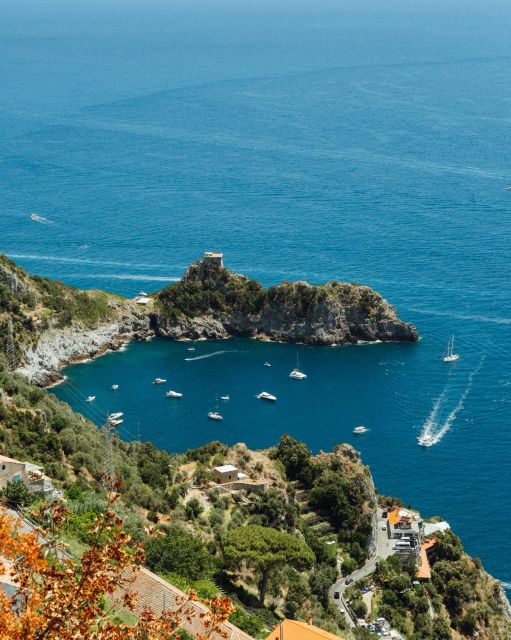
- A guided day trip from Naples to the Amalfi Coast, visiting the picturesque towns of Amalfi, Nerano, and Positano.
- Opportunity to explore the narrow streets of Positano, browse artisan shops, and sample local cuisine.
- Inclusion of a visit to the Emerald Grotto, where participants can swim in the crystal-clear waters.
- Scenic coastal views and stunning sunset vistas during the return journey to Naples.
- Comprehensive tour package with hotel pickup, live commentary, and personalized service for a memorable experience.
More tours and experiences nearby.
- Sorrento, Positano, and Amalfi Day Trip From Naples With Pick up
- Manatee Sightseeing and Wildlife Boat Tour
- Galleria Borbonica Standard Route Entrance Ticket
- Authentic Pizza Class With Drink Included in the Center of Naples
Trip Overview and Pricing
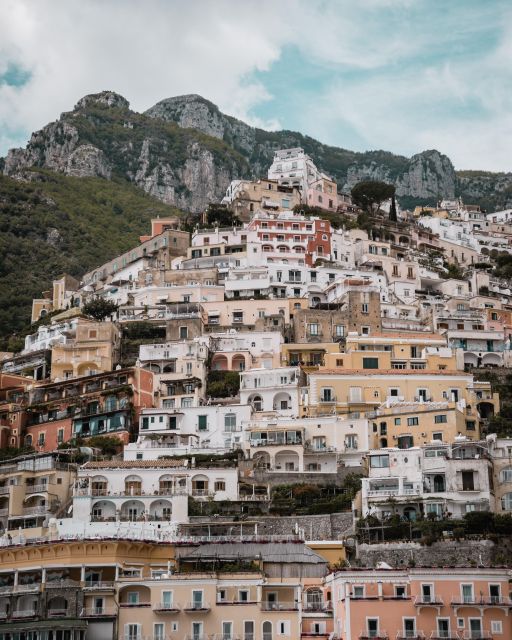
This guided day trip from Naples offers a comprehensive exploration of the picturesque Amalfi Coast , including visits to the charming towns of Amalfi, Nerano, and Positano.
Priced at £1,259.80 per group of up to 8 participants, the 9-hour excursion promises a memorable experience. Guests can take advantage of the free cancellation policy up to 24 hours in advance for a full refund, or opt for the reserve now, pay later option.
The itinerary highlights include scenic coastal vistas , strolling through Positano’s narrow streets, and the opportunity to see dolphins during the boat ride.
With hotel pickup, local cuisine , and sunset views on the return journey, this day trip is an excellent way to take in the beauty of the Amalfi region.
Itinerary Highlights
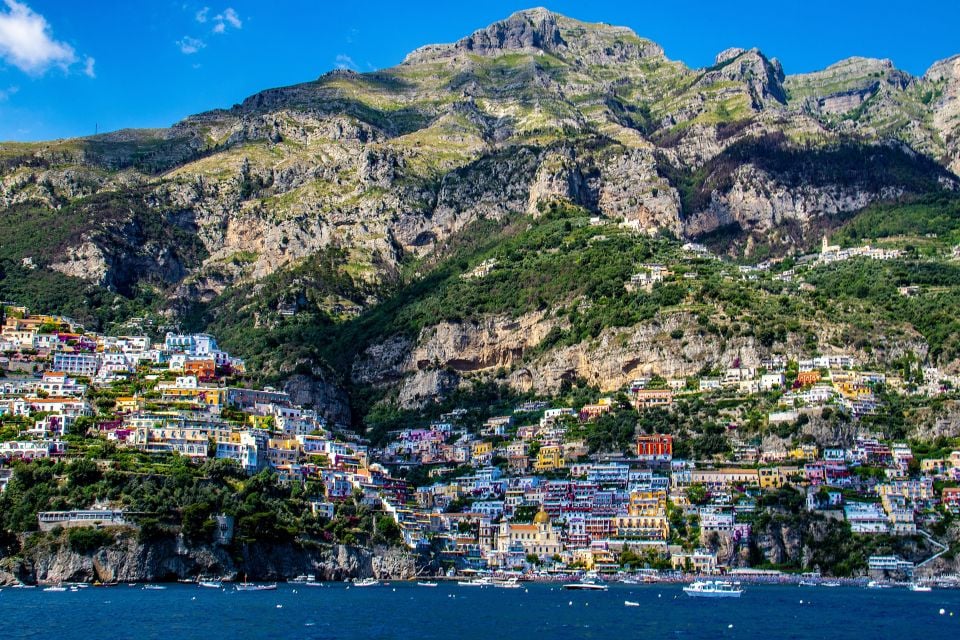
The guided day trip from Naples takes visitors on an enchanting exploration of the Amalfi Coast , with stops at the picturesque towns of Positano and Nerano.
First, you’ll enjoy scenic coastal views as you journey along the winding roads. In Positano, you’ll stroll through the narrow streets and admire the panoramic bay vistas.
The optional stop in Nerano provides an opportunity to savor local cuisine.
The highlight of the tour is the visit to the Emerald Grotto , where you can swim in the crystal-clear waters. You may even spot dolphins during the boat ride.
As the day winds down, you’ll witness the stunning sunset on the return journey to Naples.
Inclusions and Services
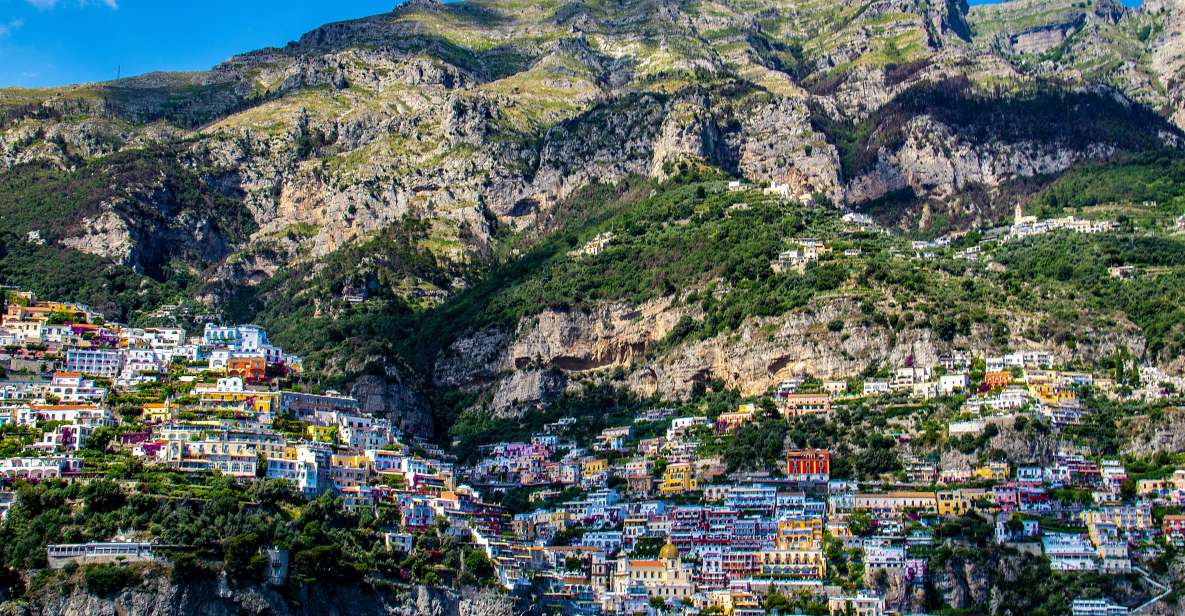
The guided day trip from Naples includes a pick-up service from your hotel, ensuring a seamless start to your Amalfi Coast adventure.
During the tour, a live guide provides informative commentary in Italian, sharing insights about the local culture and history.
Plus, the trip offers the opportunity to experience the region’s renowned cuisine and browse artisan shops, immersing you in the authentic local lifestyle.
As you return, you’ll be treated to stunning sunset views , creating a perfect end to your day exploring the picturesque Amalfi Coast.
The comprehensive inclusions and personalized service aim to provide a truly memorable and hassle-free experience for all participants.
What to Bring
Packing the right essentials is crucial for a seamless and comfortable Amalfi Coast day trip. Visitors should bring comfortable shoes and clothing suitable for walking, as the itinerary involves strolling through the region’s narrow streets and exploring scenic vistas. Plus, a change of clothes and beachwear is recommended, as you will have the opportunity to swim in the crystal-clear waters of the Emerald Grotto.
To ensure a well-prepared experience, the following items are suggested:
Important Considerations
Travelers should be aware that this guided day trip may not be suitable for individuals with mobility impairments , as the itinerary involves navigating uneven terrain and stairs.
The tour isn’t accessible for those with physical limitations , and participants should ensure they can comfortably walk and explore the sites.
Visitors are advised to check availability for desired starting times during the booking process and select the appropriate number of participants.
Plus, the tour provider recommends bringing comfortable shoes and clothing to fully enjoy the day’s activities.
Departure From Naples
The guided day trip departs from Naples, offering visitors scenic views of the Amalfi Coast as they embark on their adventure.
The journey to the famous coastal region includes:
A comfortable pick-up service from your hotel in Naples, ensuring a hassle-free start to the day.
A live tour guide providing informative commentary in Italian, sharing insights and historical stories about the region.
The opportunity to enjoy the sunset views on the return journey, capping off a day of exploration and discovery.
With the convenience of a pre-arranged tour and the expertise of a knowledgeable guide, the day trip from Naples to the Amalfi Coast, Nerano, and Positano promises an unforgettable experience.
Visiting Positano
Upon arrival at the Amalfi Coast , the group heads to the picturesque town of Positano , where they can stroll the narrow streets and admire the panoramic views of the sparkling bay.
Charming pastel-colored houses cling to the cliffs, creating a stunning visual display. Visitors can browse the artisan shops , sampling local delicacies and purchasing handmade crafts.
The town’s picturesque harbor offers a peaceful respite, with fishing boats bobbing on the crystal-clear waters. The group has ample time to explore Positano at their own pace, taking in the unique atmosphere and breathtaking scenery that have made this coastal town a beloved destination for travelers.
The guide provides insightful commentary, ensuring the group makes the most of their time in this enchanting locale.
Exploring Emerald Grotto
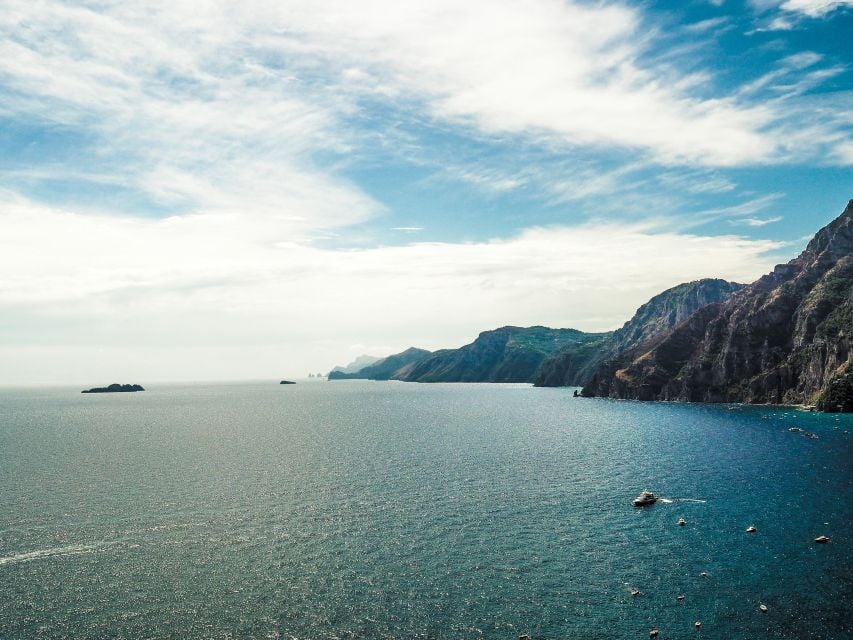
After exploring the charming town of Positano, the group continues their journey to the Emerald Grotto, a natural wonder along the Amalfi Coast.
Situated in the town of Conca dei Marini, the Emerald Grotto is renowned for its striking, jewel-toned waters and impressive geological formations.
Once inside, visitors are greeted by:
Dramatic stalactites and stalagmites that line the cave walls, creating a mesmerizing display.
The emerald-hued waters that reflect the sunlight, casting an ethereal glow throughout the grotto.
The opportunity to swim in the crystal-clear waters, providing a refreshing experience amidst the natural wonder.
After this unforgettable stop, the group continues their journey, eager to uncover more of the Amalfi Coast’s enchanting destinations.
Here's a few more nearby tours and experiences we think you'll like.
- Naples Street Food Tour With Local Expert
- Underground Naples Spanish Quarters
- Pompeii Vesuvius Day Trip From Naples+Italian Light Lunch
- From Naples: Pompeii Entrance & Amalfi Coast Tour With Lunch
- Day Trip From Naples: Amalfi Coast Tour Including Ravello
- Ten Thousand Islands Boat Tour up to 12 People
Frequently Asked Questions
Is there a minimum number of participants required.
The guided day trip has a minimum group size of 1 person. The price is per group, which can accommodate up to 8 participants, so there is no minimum number of participants required to book the tour.
Can I Customize the Itinerary to Suit My Preferences?
Yes, the tour can be customized to suit your preferences. The provider offers flexibility to adjust the itinerary based on your interests, such as spending more time in certain locations or adding/removing stops. Just discuss your preferences with the guide.
Is Transportation Back to Naples Included in the Price?
Yes, transportation back to Naples is included in the price. The guided day trip from Naples to the Amalfi Coast, Nerano, and Positano includes pick-up service and return journey to Naples.
Are There Any Discounts Available for Children or Seniors?
The tour does not offer any discounts for children or seniors. The price of £1,259.80 per group (up to 8 participants) remains the same regardless of age. Additional services or modifications may be available upon request.
Can I Bring My Own Food and Drinks on the Tour?
Participants can bring their own food and drinks on the tour. However, the tour includes the opportunity to experience local cuisine and visit artisan shops, so guests may prefer to enjoy the included dining experiences.
Not for you? Here's more of our most recent tour reviews happening neaby
- From Naples: Private Tour of Pompeii
- NAPLES: WHERE MYTH AND HISTORY MEET
- Caserta Royal Palace: Day Trip From Naples
- Rome to Positano and Napoli
- Pompeii, Sorrento, Positano Tour With Guide in Pompeii
- Vesuvio: 3h Trekking Tour With Volcanological Guide
- Naples: Pompeii, Herculaneum and Mt. Vesuvius Private Tour
- Amalfi Cost Private Drive
- Private Transfer From Rome to Naples or Vice Versa.
- Naples Pizza and More Food Tour – Do Eat Better Experience
- From Naples: Transfer to Amalfi-Ravello With Tour of Pompeii
- From Napoli: Guided Private Tour to Capri
- Capri Private Yacht Transfer
- Carmines Amalfi Coast Secret Tour
- From Naples: Private Tour of Pompei, Sorrento & Positano
This guided day trip from Naples offers a chance to take in the breathtaking beauty of the Amalfi Coast .
Travelers can stroll through the charming streets of Positano, explore the Emerald Grotto , and enjoy local cuisine , all while taking in stunning sunset views on the return journey.
With flexible booking options and informative commentary, this excursion promises an unforgettable adventure along the picturesque Italian coastline.
Similar Posts

Wine and Chocolate Bonbon Tasting in Margaret River
Greenwich village night life walking tour +21.
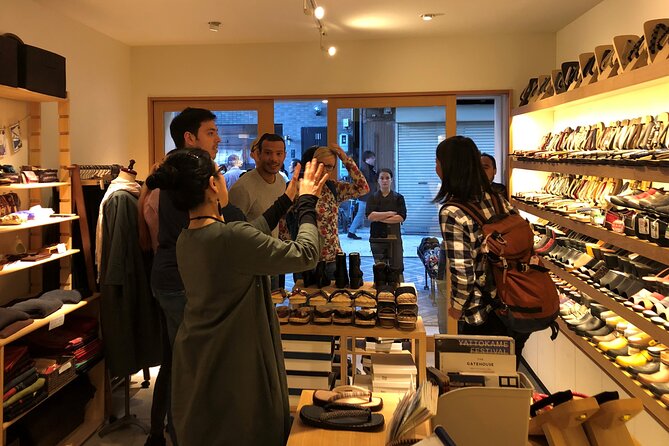
Nagoya Endoji Food and Cultural Tour
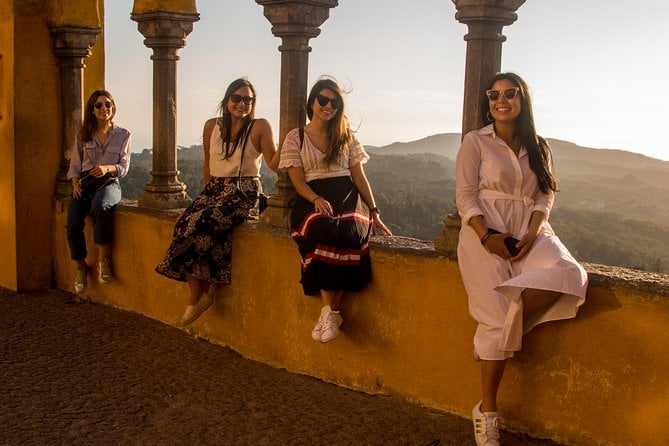
Sintra & Cascais Private Tour a Dreamlike Experience
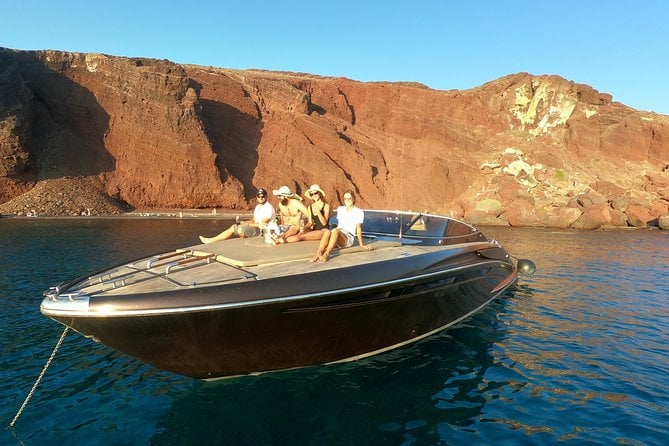
Santorini Caldera: The Riva Luxury Cruising Experience

Most Affordable 5 Nights Kullu Manali Package

IMAGES
VIDEO
COMMENTS
Things to Do in Naples, Italy - Naples Attractions. Things to Do in Naples. This city is known as the birthplace of pizza, ... Sorrento, Positano, and Amalfi Day Trip from Naples with Pick Up. 3,278. Full-day Tours. from . $136. $109. per adult. SPECIAL OFFER. Day Trip to Capri and Blue Grotto From Naples & Sorrento. 259. Full-day Tours. from .
526,998. Naples, Italy. As Southern Italy's largest city, Naples isn't quite as postcard-perfect as its more photogenic neighbors—it's got more of a bustling, lived-in sensibility. But there's no shortage of beauty. It's the kind of place where ancient sculptures, lush courtyards, and unexpected ocean views pop up alongside parking lots and ...
Things to Do. Visitors come to Naples for its Greek and Roman underground, its numerous mosaic- and relic-filled churches and its museums stuffed with art and archaeological treasures. Then there's the food—Naples is famous for pizza, seafood, fried everything, and decadent pastries. And as much as anything, visitors come to Naples just to be ...
Make a Pilgrimage to the Naples Cathedral. Visit the Naples Cathedral. Marvel at the stunning Gothic and Baroque architecture. 7. Walk Along Spaccanapoli. Stroll down Spaccanapoli. Enjoy shops, cafes, and churches in this bustling street. 8. Stroll Through Piazza del Plebiscito.
In Naples, as in any major city's central station, there's a heightened risk of petty crime. The key is not paranoia, but preparedness. Keep your belongings close, your backpack in front and your valuables securely tucked away. In crowded areas, maintain a firm grip on your luggage and stay alert to your surroundings.
Start your day with a coffee and sfogliatella. 3.2. Stroll around the historic centre. 3.3. Visit Il Duomo (The Cathedral) 3.4. Discover the hidden world of Napoli Sotterranea (Naples Underground) 3.5. Stop at Sorbillo's to eat the original Napoli pizza.
Naples, Italy's third-largest city, thrives on contradictions. As one of the oldest continuously inhabited urban areas in the world, Naples is both chaotic and cultured, opulent and gritty, exuberant and understated, with architectural gems to discover around every corner. Founded by Greeks in the first millennium BCE, Naples has witnessed over 2500 years of history unfold from its magnificent ...
Naples Travel Costs. Hostel prices - A dorm bed in a hostel with 4-6 beds costs 22-46 EUR per night, while a bed in a room with 8-12 beds costs 20-33 EUR per night during shoulder seasons. Private rooms range from 80-100 EUR per night. During busy summer months prices can be double or more.
Europe. Naples is raw, high-octane energy, a place of soul-stirring art and panoramas, spontaneous conversations and unexpected, inimitable elegance - welcome to Italy's most unlikely masterpiece. Best Time to Visit. Best Things to Do. Attractions.
Italy intensifies as you plunge deeper. Naples is Italy in the extreme — its best (birthplace of pizza) and its worst (petty and organized crime). The city has a brash and vibrant street life — "Italy in your face" in ways both good and bad. Walking through its colorful old town is one of the most memorable experiences anywhere in Europe. Naples surprises the observant traveler with its ...
Via Eldorado, 3, 80132 Napoli NA, Italy. Get directions. Phone +39 081 795 6180. Visit website. Sitting in a prominent position on the harbor, Castel dell'Ovo is the oldest fortification in Naples. Built in 1154, the fortification occupies a small island facing the Santa Lucia district.
Zach Watson December 28, 2023. Ranking of the top 9 things to do in Naples, Italy. Travelers favorites include #1 Via Caracciolo e Lungomare di Napoli, #2 Museo Cappella Sansevero (Sansevero ...
Best of Naples in One Day: Easy 1-Day Naples Itinerary. Based on my experience of visiting Napoli several times, I set out quite intense just as a city itself, yet unforgettable and rewarding Naples in 1 day itinerary.It is packed with the best attractions in Naples and sights not to be missed (including places where to eat the best pizza in Napoli).. To make the most of the city, I included ...
Naples is a vast city located on the western coast of Italy facing the Tyrrhenian Sea. This colossal metropolis is the third largest city in Italy behind Rome and Milan with a population of 975,000 and a greater metropolitan population of over 3.1 million. Naples and the surrounding region has been inhabited since the Neolithic period and it has seen some form of continuous human activity ...
Morning. Breakfast. 08:10 AM - 08:50 AM. Start your one day in Naples with some Neapolitan pastries and a shot of espresso. Sfogliatella and baba are the two most popular pastries in the region of Campania. Sfogliatella is a shell-shaped Italian pastry, filled with almond paste and sweet ricotta.
Visit Naples will help you plan your trip to Naples giving you useful information and advice on how to visit Naples in the best possible way. English Italiano. English. Visit Italy Srl Via Filippo Argelati, 10, 20143 Milano | P.IVA 08368951219 Capitale Sociale 50.000€ Lavora con noi ...
The final two days of this Naples itinerary include one full day trip to Pompeii and Mt. Vesuvius and another full day trip exploring the Amalfi Coast area. Unless you plan on spending several days along the Amalfi Coast later in your itinerary (in which case, I suggest you read this guide to spending 5 days on the Amalfi Coast ), then you ...
There's a saying that Rome is the heart of Italy, but Naples is its soul. Naples is gritty and chaotic, yet beautiful and authentic at the same time. After two years of living a long metro line away from downtown Napoli, I've yet to write a guide to Naples. Maybe it's because it's a beautiful mess that's hard to grasp in the usual ...
This post is also available in: French Naples, on the southwestern coast of Italy, is one of Italy's vibrant urban centres. Known for Pompeii and pizza, Naples gets overlooked by many who travel to Italy, but it - and its neighbouring islands and regions - is well worth a visit. 3 days in Naples is plenty of time to see the major attractions, take a day trip to an island, and eat as much ...
Città della Scienza - right next door to Naples you can visit Italy's first interactive museum dedicated to the different branches of the sciences. A fun and educational destination for the whole family. Below you can read my 10-year-old child's honest opinion about visiting Naples in Italy: Naples is a busy and lively city.
The Top 18 Things To Do In Naples, Italy: The Naples Travel Guide. Updated June 2024, The Top 18 Things To Do In Naples, Italy: The Naples Travel Guide was originally published in August 2020 My fascination with Napoli is multi-faceted. My Mom's family spent some time living there before boarding a ship bound for New York in the earlier part of the 20th century.
» Here is our 2-week Italy itinerary to help you plan your trip around Italy's top cities. We also have a travel guide for Venice, a 3-day Rome itinerary, things to see in Florence, foodie things to do in Bologna, and a guide to the top landmarks in Italy. Learn about renting a car in Italy. Be sure to check out our 2-week Europe Itinerary.
If you would like assistance in planning your trip to Naples, Italy, we would be happy to help. Please refer to our Travel Planning services for further information or send us an email. If you want to explore more in Southern Italy, check out our following posts: Day Trip to Paestum Italy 2024 - Ancient Greek Temples
Naples is one of the best places in Italy when it comes to food. Some would even say that it's the best place, full stop. It's the birthplace of pizza as well as many Italian specialties. But the thing that Naples does better than any other city in Italy, it's street food.
Made in Naples since the first half of the 19th century, the margherita pizza represents the city's culinary past, present and future.
Italy ; Italy Travel Forum; Search. Browse all 563,257 Italy topics » Detailed local train route map for Naples to Reggio Calabria Watch this Topic. Browse forums; All. ... We are thinking about taking the train south of naples down towards policastro, maybe further to reggio calabria. But I am having trouble locating a map of which towns ...
Trip Overview and Pricing. This guided day trip from Naples offers a comprehensive exploration of the picturesque Amalfi Coast, including visits to the charming towns of Amalfi, Nerano, and Positano.. Priced at £1,259.80 per group of up to 8 participants, the 9-hour excursion promises a memorable experience.
Answer 1 of 6: We are thinking about taking the train south of naples down towards policastro, maybe further to reggio calabria. ... Italy ; Italy Travel Forum; Search. Browse all 563,232 Italy topics » Detailed local train route map for Naples to Reggio Calabria Watch this Topic. Browse forums; All. Browse by destination.